15 things to know before going to Japan

Mar 31, 2024 • 7 min read

Be ready for a visit to Japan with these tips on health, safety and etiquette © pat138241 / Getty Images
Japan has a reputation as an etiquette-bound place that can be intimidating for first-time visitors.
The truth is, though, that the traditions here are no more formal or constricting than in many other destinations around the world. Moreover, most locals are more than willing to help out or give foreign travelers a pass for any perceived faux pas.
As with just about anything in life, expectation management is key. Put your mind at ease with our top tips for smooth traveling in Japan .

1. Book accommodation in advance (and arrive at the right time)
You can probably get a room at a basic business hotel without a reservation in a pinch, but why risk it? Top accommodations can book up weeks or even months in advance, so it's best to plan ahead.
Particularly busy travel periods include the first week of January, cherry blossom season (late March through April, depending on the destination), “Golden Week” (April 29 to May 5) and August.
You should also keep in mind that smaller inns or ryokan (traditional Japanese inns) often have fixed check-in times outside of which staff won’t be present, and rooms won’t be made up. Coordinate your arrival time in advance.

2. Pack light for a visit to Japan
Since hotel rooms in Japan tend to be small, especially in cities, there is little room for large suitcases – which can also be a pain to wrangle on public transport . Packing on the lighter side is always a good idea, but especially advisable for Japan.
Note that religious sites such as Buddhist temples and Shintō shrines don’t have dress codes. High-end restaurants, bars and clubs sometimes do, but that usually just means no sleeveless shirts or sandals on men.
Keep in mind that you might find yourself sitting on the floor when dining out, which can be uncomfortable in short (or tight) clothing.
3. Buy a data-heavy SIM card at the airport
Finding your way around in Japan can be tricky. The address system is notoriously difficult to navigate – even for locals – so smartphones with navigation apps have been a real boon for travelers.
This means you're likely to be using a substantial amount of data getting from place to place, so buy a data-heavy SIM card at the airport upon arrival.
Ready to go to Japan? Here are 24 of the best things to do when you get there

4. Bring shoes you can easily slip on and off
Comfortable walking shoes are a must. You’ll also likely have to take your shoes off frequently at religious sites, traditional inns and some restaurants – you’ll thank yourself later if you pack shoes that are easy to slip on and off.
Since you’ll be slipping into a pair of communal slippers when you take your own shoes off, many visitors prefer to wear socks.
5. Learn how to use a bidet toilet
Called “washlets,” Japan’s high-tech, electronic bidet toilets will wash and dry your delicate parts with the touch of a button. (Don’t worry about any language barrier; the pictograms on the buttons are easy to understand).
Other toilet customs in Japan might throw you for a loop. Motion-sensor-activated sound machines are intended to conceal, um, sensitive noises. Also expect dedicated toilet slippers in shoes-off establishments.
Note that there is frequently a lack of towels and hand dryers (locals carry small cloths with them for this reason).

6. Come prepared for the weather
Summers in Japan are hot and humid, which can mean a real risk of heatstroke. Carry water with you, and a folding umbrella with UV blocking is useful – and does double duty in case of a sudden shower.
Late June is the start of the annual rainy season, when it can rain without end for days; this can last a few weeks or through most of July.
Rains, as well as punishing winds, are likely again during typhoon season , which runs from September through October (earlier in Okinawa ).
Typhoons can cause serious travel disruption; monitor the situation with the Japan Meteorological Agency ’s storm and other weather warnings, which are available in English. Winters can get chilly, and Tōhoku and Hokkaidō up north can get huge dumps of snow.
Japan’s ubiquitous convenience stores are handy for weather-related necessities like umbrellas, hats, cooling wipes and pocket warmers.
7. Make sure to carry cash...
In rural Japan and at older family-run businesses in cities, credit cards may not be accepted. It’s wise to assume you’ll need to pay cash at country ryokan and smaller restaurants and shops; stock up when you’re in a town with an ATM (cashpoint).
To pay as the Japanese do, place your cash or card in the small tray at the register rather than handing either to the cashier.
8. ...But don’t worry about tipping
Though tour guides who regularly take foreign tourists around might expect extra, Japan has no custom of tipping, and an attempt to add to your bill will more often than not fluster or embarrass staff.
In lieu of tipping, some bars and restaurants will charge a flat-rate service fee, usually around ¥300–500 per person; others, typically fancy ones, will automatically add a 10% service charge to the bill.

9. Learn the art of queueing in Japan
The Japanese are big on queues, forming neat lines everywhere from check-out counters to train platforms. (Regarding the latter: after the train doors open, it’s everyone for themselves when it comes to scoring a seat.)
10. Stand to the left (or to the right)
Always ride on one side of the escalator – but which side depends on where you are. In Kanto and eastwards, it’s to the left; in Kansai and westwards, it’s to the right. (The dividing point is somewhere just west of Nagoya ).
Incidentally, train operators want passengers to stand on both sides of the escalator and refrain from walking altogether, even if commuters have so far shrugged at these guidelines.
11. Note when the last train leaves
City subways run until 1am at the very latest. If you miss the last train for the night, the alternative is to catch a taxi, which can be expensive.

12. Avoid the morning commute in Tokyo
For Tokyoites , the morning commute is a contact sport. On weekdays from 7:30am to 9am, millions squeeze into trains across the city, sometimes helped along by station staff who make sure everyone’s packed in.
Shinjuku Station, the busiest in the world, sees an average of over 3.5 million commuters daily; there are more than 200 exits leading in and out of the complex.
13. Eating in public is generally a no-no in Japan
It’s considered bad form to eat in public, especially while walking. Exceptions include the shinkansen (bullet train) and other reserved-seat limited-express trains, where it is customary to eat a bentō (boxed meal) on board; plus at festivals or market streets with food vendors; on a picnic; and of course if you're eating ice cream.
It’s also okay to take sips from a resealable beverage container, like a water bottle.
14. Know what to do in an earthquake or tsunami
Japan is one of the most seismically active places on the planet. While strong earthquakes are rare, minor temblors happen all the time. If this occurs during your time here, stay calm and take your cue from those around you.
Head under a table or stand in a doorway if the shaking picks up; strict building codes generally keep harm to a minimum.
Rarer but more dangerous tsunami can follow a significant quake. Should this occur, listen for tsunami warnings and get to higher ground fast if you are near the coast.
15. Learn some Japanese lingo
English is widely spoken in cities and around major tourist attractions; in rural areas, though, it can be hit or miss. Some Japanese words that will come in handy when dining out:
• omori (large portion, often free at ramen stalls) • okawari (refill) • mochikaeri (takeaway) • tennai de (eat-in) • onegai shimasu (please). Follow up any of your orders or requests with this; for example, if you want tea, say, “O-cha onegai shimasu.” • sumimasen (excuse me) • arigato gozaimasu (thank you). Because it’s a bit of a mouthful, it’s tempting to shorten it to simply arigato . Think of it as the difference between “thank you” and “thanks” and go for the politer “arigato gozaimasu.” • toire (toilet; pronounced “to-ee-rey”)
This article was first published Apr 6, 2022 and updated Mar 31, 2024.
Explore related stories

Aug 23, 2024 • 7 min read
There’s nothing like hitting the road in an RV or camper van – these are the best destinations around the world for an RV road trip.

Aug 8, 2024 • 13 min read

Aug 5, 2024 • 6 min read

Jul 12, 2024 • 6 min read

Jun 12, 2024 • 8 min read

May 3, 2024 • 13 min read

May 1, 2024 • 9 min read

Apr 14, 2024 • 6 min read

Apr 3, 2024 • 17 min read

Mar 28, 2024 • 6 min read

Planning a Trip to Japan: DOs & DON’Ts (2024)
This page contains affiliate links. Please read our disclosure for more info.
This post is based on an amazing guide our friend Amy Dunn-Cham compiled us full of her Japan tips on how to plan a trip to Japan years ago. We have since visited Japan five times and update this post regularly with what we’ve learnt.
Ah Japan, irasshaimase! Welcome to the land where everything just works. The land of convenience, the land of delicious food, paradox, naked strangers, and where respect permeates through every part of society and culture.
In Japan the food can be described as clean and minimalist, but never simple, which probably sums up Japan as a whole. It’s a place that both lives up to, and out does, any expectation you have upon arrival.
Uh-huh, they have the fastest, sleekest, most efficient trains (ever!), but they still have paper posters pegged up on their Tokyo subway. Yeah, they have amazing futuristic architecture, but they also have countless traditional wooden buildings in amongst it all.
Yes, they have the busiest people crossing in the world (Shibuya), but at no point is it ever chaotic, no need for anyone to bang on a cab screaming, “Hey, I’m walking here!”.
Yes, they have scores of scarily trendy, funkily clad young people who like to cosplay on weekends, but they also have evening family outings to sentos (public bathhouses).
In this Japan travel guide, we’ll help you make sense of it all and share our best tips for planning a trip to Japan.

2024 Update: No Japan Travel Restrictions
When to visit japan, how long to spend in japan, video: best japan destinations, before your japan trip, general dos and don’ts in japan, what to book in advance for a japan trip, top japan destinations, more japan tips.
Japan reopened to independent international tourists on 11 October 2022.
Remaining restrictions were dropped on 29 April 2023, so visitors no longer need to show proof of vaccination or a negative Covid test.
The government also dropped the indoor masking recommendation. Many Japanese people still wear masks (on our late 2023 trip, I’d say about 30-40% of people wore them), but you are unlikely to be required to.
With the yen at the lowest it has been for decades, now is a great time to travel to Japan.
Health care is expensive in Japan, so I highly recommend purchasing travel insurance that covers Covid-19 medical expenses. SafetyWing Insurance is an excellent budget option, especially for travellers on longer trips and families (as children under 10 are free). It’s available worldwide.
If you want a more comprehensive policy with cancellation cover, check out Heymondo travel insurance , which we used on our last Japan trip (it came in handy when Simon broke his foot!). It’s also available worldwide and offers 5% off for our readers.

Back to Contents
We’ve visited Japan in all four seasons and don’t think there’s a bad time to go.
In winter , it’s chilly and gardens are a bit bare, but crowds are lower, you’ll find great deals on accommodation, and you’ll really appreciate those onsens (hot springs). You can also go skiing or snowboarding and have the best chance of seeing snow-capped Mount Fuji.
In summer , it is steaming hot and humid (and June is the rainiest month), but there are fewer foreign tourists around and lots of local festivals to enjoy. It’s also the best time to visit the many beaches and the only time you can climb Mount Fuji.
The most popular and best overall times to visit Japan are spring (March-April) and autumn (October – early December). This is when you can enjoy the gorgeous cherry blossoms (sakura) or autumn leaves (koyo). It’s more crowded and expensive, but the weather can be ideal and it is just stunning.
See our guide to visiting the Kyoto cherry blossoms for more information on the popular sakura season.
On our recent autumn trip, we had warm weather (up to 77ºF/25ºC) with very little rain from October until mid-November, when the temperature in Kyoto suddenly plummeted ahead of the leaves turning colour.

Shoulder seasons May and late-September/early October are also good times to visit with warm weather and lower crowds.
Two times of year I would avoid for a vacation to Japan are:
Golden Week in early May – In 2025, Golden Week will be from 29 April – 6 May. This is a series of national holidays so many Japanese travel domestically, trains and hotels book up, and popular spots will be extra crowded.
New Year – Late December to early January. This is also a busy time with local travellers and most businesses close for up to four days.
How long do you need in Japan? As long as possible!
There is so much to see—we have spent months in the country and still have a long bucket list.
For first time visitors, I recommend visiting Japan for two weeks. This is enough time to see some highlights—Tokyo, Kyoto, and one or two smaller destinations. See our Japan two week itinerary for suggestions.
A week is the minimum time I recommend for a Japan trip. For a more relaxed Japan vacation, spend the whole week in Tokyo or Kyoto and take day trips. Or if you don’t mind rushing about, visit both major cities with an overnight stop on the way (such as Hakone).
Read our guide on the best places to visit in Japan to decide where interests you most and come up with an itinerary. You’ll find some suggestions at the end of this guide.
Watch this video for Japan trip ideas.
- Check if you need a visa . Visa-free travel is possible for citizens of 68 countries for stays of up to 90 days (including US, UK, Canada, Australia and the EU). Do have a return or onward flight out of the country as they may grill you upon arrival. It was the nicest immigration interrogation we’ve ever had, though.
- Purchase your Japanese Rail Pass exchange order before you travel to Japan (if needed, more on that later).
- Learn some Japanese —numbers are especially useful! While you can get by with Google Translate, it’s much more fun to learn some Japanese (which isn’t as hard as you might think) and locals really appreciate it. We are currently learning with the comprehensive Rocket Japanese online course , which includes audio lessons with natural dialogue, grammar and culture tips, and voice recognition to test your pronunciation. It’s a little pricey but unlike most subscription-based courses, you get lifetime access and discounts are often available.
- Get an International Driving Permit . You’ll need this for go-karting on the real Tokyo roads dressed as your favourite character. Insanity but one of the most fun things we’ve done in Japan.
- Arrange travel insurance. Healthcare is expensive in Japan, so make sure you are covered in case the worst happens. We’ve used and recommend Heymondo and SafetyWing (both available worldwide) and True Traveller for UK/EU residents.

- Apply for a Mastercard credit or debit card – If you don’t already have one. Some Japanese websites don’t work with Visa so it’s good to have a backup. We used a Starling Bank debit card (UK only), which has free international transactions and cash withdrawals.
- Walk as much as possible – You will walk a lot in Japan cities so it helps to get some training in beforehand (and wear in some comfy shoes).
- Practice using chopsticks – You’ll need them to eat in almost every restaurant (curry is the exception as it’s eaten with a spoon). Getting used to sitting on the floor is a good idea for some restaurants and experiences too.

- Buy a pre-paid transport IC card for local trains, metro and buses. You just tap on and off and don’t have to worry about buying a ticket. In Kyoto and Osaka, it’ll be an ICOCA card, and in Tokyo, it’s a Suica or Pasmo, but you can use any of the cards all over the country. Physical cards are currently in short supply (due to a chip shortage), so I recommend adding Suica to Apple Wallet on your phone or watch. Visa doesn’t work as a payment method so use Apple Pay, Mastercard, or American Express to top up. We just tapped on transport with our Apple watch and didn’t even need to open the app. Unfortunately, this doesn’t work for Android phones bought outside Japan.
- Set up an Airalo eSIM – You’ll want affordable data on your phone as having access to maps and Google Translate makes life so much easier. A digital eSIM is simple to set up before you arrive and prices at Airalo start at just US$4.50. We used it on our last Japan trip and it worked great. If your phone doesn’t support eSIMs, you can buy a physical Umobile SIM from a vending machine at Tokyo Narita Airport (make sure your phone is unlocked).
- Sign up to the Timeout Tokyo newsletter – To learn about special events during your stay.

- Buy tickets for Ghibli Museum and Ghibli Park – If you are a Studio Ghibli fan, you might want to visit the museum in Tokyo or new park in Nagoya. It’s essential to book ahead. See below for details and our Ghibli Park review .
- Research what else to book in advance – Many attractions and restaurants in Japan require advance booking so decide what’s important to you (ideally at least three months ahead) and set reminders for when bookings are available. At the end of this post you can see the timescale for what we booked for our latest trip.

- Consider a Japan Rail Pass . The luxury of shinkansen (bullet train) hopping is exhilarating. No need to book seats in advance, just choose a train, wave your pass and hop on. These passes are only available to foreigners and you can order online from JRailPass.com . Read our guide to whether a Japan Rail Pass is worth it for everything you need to know after the price increase in October 2023 (it’s still worth it for some trips if you are travelling a lot).

- Bow if you are being bowed to . If you can manage it too, don’t turn your back upon exit. Don’t overdo it though or you’ll be a total gaijin , no need to bow to the supermarket checkout person!
- Pre-book accommodation. Wise anyway as the more affordable accommodation fills up fast, but also in line with the whole respect thing, Japanese people like to be prepared for your arrival. So don’t just randomly rock up at a ryokan for the night! Booking.com is our favourite site for finding hotels and guesthouses, and we also use AirBnb and Vrbo to find apartments in the big cities (which are often cheaper than hotels). See our Japan accommodation guide for recommendations.

- Go onsening! You might want to skip this in summer as hot doesn’t even come close to describing the water temperatures! But soaking in a hot spring is one of the most typical things to do in Japan and is ultra relaxing once you get over your fears of public nudity (yep, no clothes allowed!). Best of all, visit an onsen town where you can onsen-hop dressed in a kimono. See our Kinosaki Onsen travel guide for details on this lovely onsen town as well as hot spring etiquette.

- Stay in a ryokan (traditional inn). Pricey but worth it for at least a night or two for the unique experience and the amazing meals that are often included in the room rates (and many can cater for vegetarians/vegans). Our favourite ryokan is Tsukihitei in Nara, so traditional and with a magical forest setting. We also loved our private bath overlooking the scarlet maple trees at Nanzenji Ryokan Yachiyo in Kyoto (book a suite not a standard room). A more budget-friendly option is Morizuya Ryokan in Kinosaki Onsen, which is perfect for onsen-hopping.
- Stay in a traditional tatami mat room. If you can’t stay in a ryokan, a much cheaper way to stay in one is a traditional room in K’s House hostels—they have branches in Hakone (with onsen), Kyoto , Izu Peninsula (in a 100-year-old building with onsen), and all over the country. We never had a bad experience with this hostel chain in our budget travel days.

- Appreciate the zen-like calm on all modes of transport – no need for quiet only carriages here! Just remember that it’s rude to speak on your phone on trains in Japan.
- Use Google Translate . Many people don’t speak English, so the Google Translate app is helpful for communicating. Write what you want to say in English then show the Japanese translation to the person. Even more impressive is the feature to translate images—point your camera at a sign, menu, or food label and it translates the text instantly. It’s not perfect but when it works, it’s brilliant.
- Translate websites too – Many Japanese websites (especially restaurants) are only in Japanese so using Chrome or Safari, refresh the page and select the English option at the top. On Safari on my iPhone, I tend to select a block of text and tap translate from the popup.
- See some sumo . If you’re lucky enough to be in the country when one of the sumo tournaments is on, go! The pre/ post game rituals are fascinating to watch. If you aren’t there during a tournament, you can see a practice session at a sumo stable in Tokyo . It was one of our favourite experiences in Japan—it felt like such an honour to see these huge, impressive sumotori training so close.
- Expect bursts of freakery!

- Get your paper fortune at a Japanese Buddhist temple. Okay, we cheated and got an English one at the Golden Pavilion (see our guide on the best things do to in Kyoto ), but what the hell! You can also get one at the gorgeous Sensoji Temple in Tokyo .
- Love the Japanese for their never-ending capacity to help you out , and they won’t stop until they do!
- Read these Japan books before you visit for a greater understanding of this weird and wonderful culture.
- Have some sushi – Sushi is the essence of Japan, plus sushi-train/ sushi stand up bars are so much fun watching the chefs take your order, and all shout in unison, “samon!” or “tamago!” etc. Vegetarian sushi isn’t very common, but we did find some—see our vegetarian Japanese food guide .

- Appreciate the plastic food models as works of art!
- Pack slip-on shoes. You’ll be taking your shoes on and off a lot in temples and restaurants. I wear the comfy ballet flats Allbirds Tree Breezers in warmer weather and Allbirds Wool Runner sneakers (for men and women) in cooler weather—they keep your feet cosy but can be worn without socks and easily slipped off without untying the laces. See my detailed Allbirds review .
- Shop at the 100 Yen shops. Like pound shops BUT BETTER! Daiso is a great one.
- Play in the arcades dotted around cities, the taiko drum game rocks!
- Make use of the many vending machines EVERYWHERE . You will never go thirsty in Japan that’s for sure. You can even get hot coffee…in a can! (Simon’s saviour when we had early morning trains to catch.) In fact, you can get friggin’ anything from vending machines from cheap 100 yen sake (yuk!) to hot chips (not surprisingly we did not try!) and SIM cards. In Tokyo you can use your Suica transport card to pay.
- Press random buttons on the panel next to you on the loo . It will make you giggle ;o)! Also, if it’s cold then appreciate the absolute miracle of heated toilet seats.
- Fall in love with seeing toriis (shrine gates) everywhere , especially small red ones in rows behind each other. Fushimi Inari Shrine in Kyoto is our favourite (but go early as it’s popular).
- Love and appreciate the beautiful presentation of absolutely everything from the amazing architecture to the way bento boxes are wrapped in a napkin tied in a knot just so, to amazing manhole covers!
- Pack light. It will be much easier to hop on and off trains while travelling around Japan if you pack light, and hotels have limited storage space for luggage. Best of all, travel with just carry-on luggage . The Away Bigger Carry-On was perfect for our trip and fit overhead in trains.

- Consider luggage shipping – We haven’t used this yet, but if you have large luggage, it’s common to send it between hotels (it takes a day, so pack essentials in an overnight bag).
- Withdraw cash from 7-11 ATMs. They are the most reliable no-fee option for international cards and can be found everywhere. Make sure you always have cash on hand as many places don’t accept credit cards (although this is improving). Note that some 7-11 ATMs in popular spots (the airport, Gion), do now charge, so try to withdraw in less touristy areas.
- Use Navitime to check train times and prices (and to work out if a Japan Rail Pass is worth it for your itinerary ).
- Visit BIC Camera if you need any kind of electronics. These massive stores have everything you could imagine. Take your passport if you are making a large purchase (over 5000 yen) and get it tax free. I bought a camera here and ended up getting lots of extra discounts and free accessories. It’s also a good place to buy a SIM card if you didn’t pick one up at the airport.
DON’T:
- Rent a car – For most visitors the best way to travel Japan is by train. Elsewhere we love road trips, but renting a car in Japan is just not worth the hassle unless you are travelling far off the beaten track.
- Open the door if taking a taxi. They are either automated or the driver will open it for you. It’s also a good idea to have your destination’s address written down in Japanese to show the driver as most don’t speak English.
- Feel bad if you need to take a break from Japanese food – Japan isn’t always an easy destination and indulging in a comfort meal can be restorative (we’ve had some excellent pizza in Japan).

- Forget to check opening hours – Japanese restaurants aren’t usually open all day and both restaurants and attractions usually have a last order/entry 30 to 60 minutes before closing.
- Go whizzing around the country too much. It can save energy to base yourself in one place and take day trips as we did in Kyoto and Okayama .
- Wear holey socks. You’ll only be embarrassing yourself when you take your shoes on/ off constantly!
- Go into an onsen without washing first , that’s just dirty dude! Also, don’t go into the bathing area with a towel wrapped around you, you’ll just look stupid. Embrace the nudity! Everyone’s naked so no-one cares. My Kinosaki Onsen guide has more etiquette tips for newbies.

Japan is a popular destination and many hotels, restaurants, and attractions book up in advance. While you can still have a wonderful last-minute trip, it’s worth researching what you’d like to do months in advance to see what needs reservations.
On our most recent trip to Japan (in the busy autumn October/November season), this is what we booked ahead:
5 Months Before
- Flights – This is personal preference and earlier or later could also work. Tokyo Narita (NRT), Tokyo Haneda (HND), or Kansai International Airport in Osaka (KIX) are all good options to fly in to.
- Accommodation – Ryokans and hotels in smaller towns are most important to book ahead. Some hotels don’t take bookings more than 3 or 6 months in advance, though. We used Booking.com and almost all had free cancellation. See our posts on the best places to stay in Kyoto and Japan accommodation guide .
4 Months Before
- Tokyo DisneySea Hotel MiraCosta – Our favourite place to stay in Japan is right inside the best Disney park in the world. Rooms go on sale 4 months in advance at 11am JST and sell out in minutes, so it’s essential to do some practice runs.
3 Months Before
- Harry Potter Studio Tour, Tokyo – We booked 7 weeks in advance and only got an afternoon slot, so earlier is a good idea. Check Klook and the Warner Bros Studio Tour website as they have different availability.
2 Months Before
- Ghibli Park , Nagoya – Tickets go on sale on the 10th of the month at 2pm JST for 2 months later (it changed recently from 3 months). So May tickets will be on sale on 10 March. These sell out quickly, so be prepared. See our Ghibli Park guide for how to secure your tickets.
- Teamlab Planets , Tokyo – Book early if you want a specific time for this interactive digital art exhibition (we wanted the first slot). We booked on Get Your Guide . The new TeamLab Borderless is also selling out fast (tickets available on Klook or direct ).
- Some Restaurants – We booked Monk in Kyoto exactly 2 months in advance at 12pm JST (after five attempts—see our Monk Kyoto review for how) and Shigetsu in Kyoto (as we were visiting during peak autumn colour). Creating a Tablecheck account is a good idea as quite a few restaurants use it for bookings.
- Saihoji (Moss Temple) , Kyoto – It’s expensive and might not be a priority with limited time in Kyoto, but it’s our favourite temple. Reservations open 2 months in advance. See our guide to visiting Kyoto Moss Temple for more details.
- Universal Studios Japan Express Passes – These are essential to skip the lines at this very busy park in Osaka, and they do sell out. We bought the Express Pass 7 on Klook (much easier than the official site which is in Japanese only). We bought our USJ entrance tickets on Klook at the same time. See our Universal Studios Japan guide for more tips.

1 Month Before
- Ghibli Museum , Tokyo – Available at 10am JST on the 10th of each month for the following month.
- Shibuya Sky , Tokyo – Bookings open 4 weeks in advance at midnight Japan time. Book fairly soon after that to get the peak slot (one hour before sunset).
- Tours – I booked a sumo stable visit (highly recommended) and Shinjuku bar hopping tour in Tokyo. Go-karting is another fun option we’ve done before. I used Get Your Guide for most tours. Klook is a good option for tickets and attractions too.
- Tea Ceremony Ju-an , Kyoto – Learn the traditions of tea in a temple. One of the highlights of our trip.
- Sakurai Tea Experience , Tokyo – If you love green tea, don’t miss the tea tasting at this modern tea room.
- More Restaurants – I booked Saido in Tokyo, Uzu Vegan Ramen in Kyoto (reservations essential), and Ristorante di Canaletto at DisneySea (one month in advance at 10am JST exactly).
- Tokyo DisneySea and Disneyland tickets – I booked on Klook. The parks probably won’t sell out, but we didn’t want to take the chance.
- Japan Rail Pass – If you decide to get one, allow plenty of time for your exchange order to arrive by post, just in case (you activate it on arrival).
2 Weeks Before
- Shinkansen Train Seat Reservations – We used the SmartEx website , which can be difficult to set up (use a Mastercard and keep trying to authenticate the payment method) but very handy. When booking a train from Tokyo to Kyoto, choose a seat on the right side of the train for Mt Fuji views (if clear). If you have large suitcases, you’ll also need to make an oversized baggage reservation .
- Airport Taxi Pickup – From Narita Airport we get the Narita Express train, but from Haneda Airport (which is closer to central Tokyo), we prefer a taxi for ease. We booked this Haneda airport pickup on Klook .
- More Tours and Restaurants – Book any more priorities as you finalise your itinerary.

Japan has so much to offer but here are a few places to get you started.
- Tokyo – The best of modern Japan. This huge city has incredible food, diverse neighbourhoods, and some unique experiences. Try these cool things to do in Tokyo and enjoy the best vegetarian restaurants in Tokyo .
- Kyoto – The best of traditional Japan with many stunning temples to explore . Read the best things to do in Kyoto .
- Takayama – A smaller, quieter alternative for traditional Japan with a beautiful historic centre of preserved wooden houses.
- Hakone – For the chance to see Mount Fuji, mountain scenery, lakes, onsens, and fun transport options (cable cars and pirate ships!).
- Kawaguchiko – Even better views of Mount Fuji at Lake Kawaguchiko .
- Nikko – Stunning temples in the forest. Could be visited as a day trip from Tokyo.
- Hiroshima – Visit the moving peace memorial that commemorates the atomic bombing and don’t miss nearby Miyajima Island.
See our Japan 2 Week Itinerary for a detailed guide to visiting many of these places including things to do, transport, and where to stay and eat.
Or our guide to the best places to go in Japan has more ideas.
Japan Tips, Direct to your Inbox!
Thank you for subscribing! You should receive an email from us very soon. Click on the link in the email to confirm your subscription.
- Is a Japan Rail Pass Worth It?
- 56 Best Things to Do in Japan for an Unforgettable Trip
- Where to Stay in Japan: A Guide to Accommodation Options
- 20 Fascinating Books to Read Before Visiting Japan
- 16 Unmissable Places to Visit in Japan
- Vegetarian Survival Guide to Japan
If you enjoyed this post, pin it!

183 Comments
Thanks for your article – I found it really interesting as my son (aged 17) and I are planning a trip to Japan in October. Unfortunately, we don’t have anywhere near as long to spend there as I would like! We arrive on the 21st and leave on the afternoon of the 30th. From the 23rd to the 25th inclusive I am at a work conference but the rest of the time is our own. We will have some time on the conference days to have a look around Osaka but are wondering if we have time to see a bit of both Kyoto and Tokyo in the days afterwards. I am concerned we may be trying to pack too much in with the result that we won’t see anything properly! I would appreciate any thoughts you may have!
Reply ↓
Hi Cheryl, I think it’s worth spending a few days each in Kyoto and Tokyo after your conference. You can always spend more time in both those places but it will give you a taste. The shinkansen train journey between the two is easy and enjoyable too. Enjoy!
Hi Erin, Thank you for compiling all the tips. I have been reading your website for a few weeks now. I am planning a trip with my wife and teenage daughter in April 2025 ( 13th- 24th). I was going to stay in Tokyo for 5 nights( 1st night does not count as we arrive late), 3 nights in Tokyo and 3 nights in Osaka. I was planning a day trip to Hakone and Kawaguchiko from Tokyo( is it possible by a private car to get both places fully) and day trip to Hiroshima and Miyajima from Osaka. Is this feasible? Friends who have visited Japan say I am spending too much time in Tokyo. Your input would be most valuable. I have booked a few places to stay but happy to change based on your input. I am based in the UAE so is it worthwhile getting the JR pass sent to the hotel in Tokyo or should it be sent to UAE before we travel. Thanks once again
I would choose either Hakone or Kawaguchiko and not try to do both in one day.
It is possible to day trip to Hiroshima/Miyajima from Osaka if you get an early start, but it’ll be a long day.
There’s loads to do in Tokyo so I wouldn’t say you are spending too long there. Although you might consider removing one night and spending it in a ryokan in Hakone on the way to Kyoto/Osaka for a different experience (and to avoid doing a day trip).
It would be easier to get the rail pass sent to you at home.
Great tips thank you! My husband, our 17 & 19 yr olds sons and I have 16 days in Jan/Feb 2025 so very helpful. We are visiting Tokyo, Osaka/Kyoto before skiing in Nozawa Onsen. I’m thinking we will base ourselves in either Osaka or Kyoto rather than moving in between. Given our son’s I’m thinking Osaka might be a more fun base – what do you think?
It really depends what you are looking for. I think Kyoto offers a different experience to Tokyo (Osaka is more similar) and there’s so much to do. If your sons won’t be interested in temples or historic streets or if they want to visit Universal Studios, then Osaka makes most sense.
I’m sure you’ll enjoy either though!
“It’s also a good idea to have your destination’s address written down in Japanese to show the driver as most don’t speak English.”
I absolutely second this. I had copied our destination in English from the website. Somehow we got part of the way, then the driver became completely at a loss. He couldn’t understand what I had written. I had no idea what to do, then was suddenly inspired to read it out to him phonetically. He burst into a beaming smile and we took off immediately, and arrived at our destination a few minutes later. Who knew that I could speak Japanese!!
Good job on improvising! It really helps to have it written down in Japanese unless you are going somewhere super well known (and even then you need to pronounce it right!).
My family is planning a 2 week celebratory trip to Japan in 2025. There will be 2 seniors (grandparents), 3 couples (two DIL’s speak some Japanese) with 6 children between them (ages infant to 8), and 1 adult with Down Syndrome. We are hoping to spend some time in the country and small towns as well as Tokyo and Kyoto. Is it crazy for the 15 of us to travel together as a group? I assume that we will spend the days in smaller groups as we search out what feeds our interests. But what about hotels/inns for the group? We would all prefer to stay in more traditional lodgings if possible. What about meeting up for a meal at the end of the day? What about traveling between towns/cities? Some of us in the group are great planners, so what should we be thinking about to make this a trip that everyone will fondly remember.
Hi Paul, we don’t have any experience travelling in a group, but I am sure you can make it work. Travelling by train will be fine – just book in advance although you’ll probably be fine even on the day (although you might not get seats all together).
Make sure to book restaurants if you want to eat together, and you’ll have to skip some of the smaller places that just seat a few people at the counter (or you could do those for lunch in smaller groups). Sushi Gonpachi in Tokyo is a good option for groups as they have plenty of space (branches in Shibuya and Roppongi).
I actually wouldn’t recommend traditional lodging (ryokans) for the whole trip. They are amazing experiences but are expensive and most involve sleeping on futons on the floor, which isn’t super comfortable for most Westerners.
I recommend spending 1-2 nights in a ryokan when you are visiting the smaller towns. They often include dinner and breakfast, so that’ll make it easier for your group, but you might want to look for ones with a dining room rather than those that serve meals in your room (so you can eat together). For example, we loved Iwaso Ryokan on Miyajima island. Book far in advance.
In Kyoto and Tokyo it makes more sense to stay in larger hotels. Our Japan places post has recommendations that would work for groups.
With advance planning and some time in smaller groups, I’m sure you’ll have an amazing time. Enjoy Japan!
Thank you for this insightful site. My daughter (who is in the Navy) is taking me to Japan for one week at the end of September. She has already purchased the plane tickets and taken leave. We are flying into Narita, and wanted to spend some time in Tokyo, Hakone, Kyoto and Osaka. Does that seem too ambitious for the time we have (Sept. 24 – Oct. 2)? Also, do you recommend getting first class tickets for the bullet train in order to be sure we can get reservations? I have to admit, planning this trip feels a bit overwhelming, so your site and help are appreciated more than you can know! Thank you!
I do think that’s a bit much in that time frame. I would skip Osaka or just visit on a day trip from Kyoto if you have the energy.
First class (called the Green Car) is a bit more comfortable and spacious and we sometimes like to book it for longer train trips. You aren’t more likely to get a reservation though – you can reserve the regular cars just as easily. You shouldn’t have a problem getting reservations at that time of year a few days in advance.
You can just go to the train station when you get to Tokyo and book them all at the counter (it helps to write down which trains you want). Queues can be long though. There are also self service machines but they can be confusing.
We now prefer to use the SmartEx website to book the shinkansen: https://smart-ex.jp/en/ It can be hard to get the credit card set up at the beginning but keep trying (Mastercard often works better than Visa on Japanese websites). Then once you’ve booked you can collect the tickets from machines at the station which is pretty easy.
Good luck with all the planning! Erin
Hi, Good Day! Great Information for people read this including me. Arigatou Gozaimasu. I wish i can go travel to Japan Its my Dreams when i was kid 7 years old when i already know and read Manga books Doraemon. Geertings from Indonesia.
THanks for your recommendation on hotels and restaurants, i know something about it.
Thank you for the lovely Japan Blogs – it is making our travel planning fun! It would be really helpful to understand the areas to stay in within the cities, especially first time travelers to Japan.
Thanks JK! Our Kyoto guide has tips on the best area to stay (Gion or downtown) and in Tokyo, we recommend Shinjuku for first time visitors. Enjoy Japan!
Thank you , your blog is miracke I was looking for while planning two weeks vacation for my friends and family
I’m glad it helped. Enjoy Japan!
Wow, an amazing blog, Erin. This is helping us so much plan our trip. It is great to see you updating it regularly too. It’s becoming a daily read.
Kind regards,
Thanks so much for this post! As is often the case I am following you around the world and now I’m going to Japan. Look forward to reading everything you’ve written on it!
Good to hear you are going to Japan, Ruth! I hope you enjoy it as much as we always do!
We are a very active retired couple and love exploring different cultures, sights, and exploring nature. We are planning on going to Japan for the first time for 3 -4 weeks, around the third week or so in Sept to mid October or later. We will travel with just carry on luggage and backpacks. We love touring on our own, or booking individual tours at the different places. We are open to basing in Tokyo, Kyoto, Hiroshima(?) plus other places and doing day trips from these places. What would be a good itinerary for our 21+ day trip? Thanks so much! We love your website! Bunny
Hi, I lost my comment somewhere on your blog 😅 So, me and my partner are going to Japan for 4-6 weeks in sept/october. We want to travel in a slow pace and want to visit Tokyo, Kyoto, hiking around Kiso Valley (and Kumano Kodo?), Nagano, Kanazawa? We also want to explore some nice nature, visit onsen, sleep at a roykan etc. Hokkaido would be cool but i don’t know if we will have time with that. Do you have any tips where we must go? I think our plan is to be at least 7 days each in Kyoto and Tokyo, we want to stay for minimum 2 nights at each place. Would you recommend to start in Tokyo? Is it worth to start a week in a busy town with jetlag? Should we go somewhere else (where?) for a nice start on the vacation?
Thank you! /Johanna
Hi Johanna!
I’m planning a solo trip from ~May 21-June 21, but i’m worried i’ll hit the rainy season and humidity. What to you advise? I’m limited to May 21st as my earliest trip start date due to school!
I think it makes sense to start with Tokyo if that’s where you are flying in to. That way you don’t have to worry about travelling elsewhere and you have enough time there that you can plan for the first few days to be pretty relaxed – wander some neighbourhoods, eat etc.
Sounds like you have plenty of time to do everything you want. You could easily use that time in central Japan, but you could add in Hokkaido if you really wanted (we still haven’t made it there). Enjoy!
Hi Erin, is it advisable to visit Lake Kawaguchiko in November? And, do you think it is possible to do a day trip to Lake Kawaguchiko having Tokyo as the base?
We haven’t been in November but we definitely would. You will likely see the autumn colours too (generally peak around mid-Nov), which would be beautiful.
It will likely be colder than Tokyo, but as long as you are prepared with warm clothes it should be enjoyable.
And yes, it is possible as a day trip from Tokyo – many people go by train or on bus tours. Just be aware that Mt Fuji is often hidden in cloud, so if you stay overnight you increase your chances to see it. But you could also try to choose a clear day for your day trip. Enjoy!
Our Lake Kawaguchiko travel guide has more details.
Thank you for creating this! I’m making my way through reading all of your posts. I will be visiting Japan for 14 days for the first weeks in April with my husband, a 7 year old, 10 year old and my two of my adult siblings. We’ll be a big group but I’m very excited as this is my first time and have always dreamed of going. Wondering if you have any advice for the younger kids or any kid entertainment? Thanks again!
Travelling with kids isn’t our area of expertise so I don’t have any specific recommendations except for Tokyo Disney, which we love. Tokyo DisneySea is our favourite park—it’s the only one in the world and has plenty to offer for kids and adults. Enjoy!
Absolutely love this perspective on travel! It beautifully captures the essence of what it means to explore the world. Travel isn’t just about ticking off destinations; it’s about slowing down, immersing yourself in new cultures, savoring moments, and absorbing the rich tapestry of life that the world has to offer. 🌍✈️🌏
Thank you so much for this! I have started notes and saved the page so that I can come back and check out all the links. :) I am wanting to take my 14 (would be 15 then) daughter alone (we do girl’s trips every year without dad) to Japan. She loves all things Cherry Blossoms! We try and do her spring break time (next year will be the first week of April), but I am concerned about that being too short of time period. Could we do it? If that is all the time you had, would you have a ‘base in Tokyo and then do some excursions from there (which is how we like to travel)? I am also worried about the language barrier and us being able to navigate since sometimes Google translate will not work. Thanks again!
Hi Jennifer, With one week I would focus on Kyoto, which is a better location for cherry blossoms and also has so many beautiful temples and gardens. It’s more traditional Japan (although there is a modern part too). Ideally, you’d fly into Kansai Airport which is closest.
If you have to fly into Tokyo, you could spend a few nights there before taking the shinkansen train to Kyoto (the quickest one is just over 2 hours).
If you really want to see the more modern side of Japan or don’t want to take the train, then Tokyo would be a great base. You can still see plenty of cherry blossoms there.
We don’t speak Japanese (although we are trying to learn this year) and have always managed. The Japanese are very helpful and will always try to help you out, even with a language barrier. And there are an increasing number of signs in English. Just make sure you have data on your phone as Google Translate and Maps are super helpful (you can download Japanese offline in Translate too).
Be sure to book accommodation far in advance for the cherry blossom season (ideally 6 months+).
Enjoy Japan! Erin
Hi Erin, My husband & I are travelling to Japan in August as he is competing in the world masters swimming competition. We have to be in Fukuoka for the competition and then he have 9 days to explore the country ending up in Tokyo for our flight home. Could you advise what we should do at this time of year. Do you think it is sensible to base ourselves in Kyoto and then take daily trips from there using the JR Pass, (do you recommend we get the Green pass). Your advise would be greatly appreciated. Thanking you in advance.Pia
Hi Pia, that’s exciting!
If you don’t want to move around too much then I do think Kyoto is a great base. There’s so much to do (including festivals in August) and lots of possible day trips. You could finish up with a couple of nights in Tokyo.
If you want to add some extra places you could stop in Hiroshima on the way to Kyoto for the peace memorial and nearby Miyajima Island. It’s a quick journey on the bullet train from Fukuoka.
You’ll need to work out your route first to see whether a rail pass is worth it. It probably won’t be worth it for day trips but could work out worthwhile including the shinkansen up from Fukuoka and on to Tokyo.
We’ve never used a green pass but if you want a bit more space you could consider it.
Also bear in mind that around the Obon holiday (13-16 August) the trains will be busier than usual so book your seat in advance.
Enjoy Japan!
Hi Erin – great post, thanks for your comprehensive insight! My partner and I are heading to Tokyo for NYE and planning on heading from there to Kyoto around the 2nd for a couple of nights. I understand that Japan can be very quiet during the first week of January. Do you have any experience travelling at this time? If so, do you have any suggestions about how to make the most of the trip while the country is a bit quieter? Thanks in advance :)
Hi Sarah, We haven’t been to Japan at New Year. The important thing to bear in mind is that many businesses will be closed on some or all days between 29 Dec and 4 Jan. So make sure you look at the hours of any restaurants and attractions you want to visit and work around them.
I think Kyoto will be lovely at a quieter time of year especially as it does get so busy. There are so many temples and shrines to explore and they stay open over NY. Enjoy!
Wonderful website and tips. I know one of your dont´s is rent a car, but we are hoping to visit Shirakawa-go, Gokayama and Takayama, and have found no easy way to get there from Tokyo or Kyoto on train. Do you have any recommendation on how to do that?
Many many thanks¡
Hi Natalia. You can get to Takayama from Kyoto or Tokyo easily by changing trains in Nagoya. The journey from Nagoya to Takayama is beautiful.
The other villages can be reached by bus from Takayama (Shirakawa-go is easiest), but yes, a car would give you more flexibility to explore the countryside around here.
Maybe look into renting a car for a few days in Takayama? Just remember you’ll need an international driving licence, which you’ll need to get in your home country.
While a car could be useful in the countryside, I wouldn’t want to drive in the cities and the train between cities is probably quicker.
I’ve written a bit about Takayama in our 2 week itinerary: https://www.neverendingvoyage.com/japan-2-week-itinerary/
Have a wonderful trip to Japan! Erin
Hello Enrin, your tips makes me very enthousiatic to plan a 4week trip to Japan. Is that a good way to tour? (Will be half september-half oktober).
forgot to say ;-) we plan to travel with a campervan: is that a good way to tour?
That’s a great time to visit and a nice amount of time to explore. I don’t think a campervan or any rental car is the best way to travel though. Driving (and finding parking) in the cities is a challenge and it’s much easier to travel by train.
A campervan would only be advisable if you want to focus on rural areas like Hokkaido.
Remember you’ll need an international driving licence, which you’ll need to get in your home country.
Hello Great Blog. full of advices How do you suggest to travel the “alps” from Kanazawa that one can reach by train to takayama and around ? would that be the place where you rent a car?
You can visit places like Kamikochi by bus from Takayama so a car isn’t essential.
Hi Erin, would like to ask is hiring tour guide better or do it yourself to see all nice place in Japan?
It depends how you prefer to travel. I definitely think it’s possible to travel by yourself. A compromise might be to hire a guide for a day (or join a tour) in Kyoto and/or Tokyo.
Good Day Erin. Just doing beginning research for our yearly trip this year, and we are considering Japan. Your excellent article is the first I started with. We like to spend minimum of 2 weeks, usually longer at our destination. You suggest that using public transportation throughout the country and not to rent a car. My husand and I are seniors. My husband has difficulty (pain) after walking a short distance (100 yards). Would this destination be a wise choice for us? Before going further in my research an answer to this question is most appreciated. Regards
Hi Diane, yes, trains are definitely the best way to visit Japan’s cities. You could hire a private driver for day tours within places like Kyoto, though, which could minimise the need to walk as much when sightseeing.
It would probably be best to minimise the places you visit (such as Tokyo and Kyoto or even just Kyoto) as train stations are quite large and do involve walking. If you fly into Kansai airport you could take a taxi to Kyoto and see a lot based there.
Perhaps renting a wheelchair is worth considering. There is also an overnight luggage delivery service where you can send your bags between hotels to make train travel easier.
As we don’t have any experience of travelling Japan with mobility issues, I would look for advice from those who have. Here’s one post that might be useful: https://www.japan-guide.com/forum/quereadisplay.html?0+132386
Diane: As someone who recently travelled to Japan having had double knee replacement surgery less than 12 months previously, I can offer a little insight! While I agree that travelling by train is a fantastic way to get around Japan (I covered a LOT of miles!) you should be aware that not all train stations have lifts or escalators. Many stations in Tokyo have quite long flights of stairs which can be a challenge to anyone less able or in pain, especially when you have luggage. Even when there is a lift, it’s typically right at the end of the platform (often the “wrong” end for where you want to be), so I would do some research before deciding how much urban train travel you will do; it’s less of an issue when taking the shinkansen to cover a reasonable distance. I much prefer trains to coaches, but I did use buses in places and that was fine. On the topic of car hire, I probably wouldn’t bother myself but I know someone who travels widely across Japan with a couple of kids and she swears by it, not least because they can easily reach locations that would otherwise be a hassle to get to. She doesn’t use one in the cities though. Lastly, I don’t think you should be put off going to Japan – it’s an amazing country and I found everyone to be unfailingly helpful. No problem is insurmountable!
Thank you so much for sharing your experience, Sue.
Hello Erin,
Would you recommend visiting Jaoan with a 1.5 year old? Do the onsens have babysitters?
We don’t have any experience travelling with kids but our friends took their toddler and loved it. The onsens don’t have babysitters as far as I know.
Thank so much for all the amazing info! Heading to Japan in June for two weeks with my daughter. It’s especially wonderful to know there are some great vegan/vegetarian options.
Hi Erin… I stumbled onto your website as I’ve started looking into planning for a trip in 2024 for my daughter’s High school Senior trip. Is Mid June a good time weather wise? Super hot? Also, are there food/restaurants that are gluten free for Celiacs? You mentioned beaches are those places more expensive than the cities? I will check out all your links too. TY for all the info, this will truly help.
It will be hot but if that’s the only time you can go, I wouldn’t let it stop you and it’s cooler than July and August.
I don’t have any experience being gluten free in Japan but our friend has written this guide: https://www.legalnomads.com/gluten-free/japan/
Beaches shouldn’t be more expensive than the cities but it depends where you go. We haven’t spent much time at the beaches.
Have a wonderful trip!
hi Erin, lovely website with a lot of good information. Do you list of places to visit / see – for a 4 week trip. We wanted to do the North part of the country as well. thanks for any tips and help. We are vegetarians as well but saw that you all managed to get delicious looking vegetarian food : ).
We haven’t actually made it very far north as there’s always so much to do in the central part. See our guide to the best places to visit in Japan for our favourite places: https://www.neverendingvoyage.com/best-places-to-visit-in-japan/
And yes, vegetarian food in Japan is great if you plan in advance (use the Happy Cow app).
Thanks for the info Erin. Cultural.differences are amusing at least.
Thank you so much for this guide Erin! It’s really helpful. I’m planning a 2-3 week trip to Japan around September. However, I’ve read and seen a lot of people saying to avoid this time of year due to typhoon season. Would you recommend visiting Japan around this time despite the typhoons that might hit?
We’ve been in September and enjoyed it. We did get some rain but nothing that disrupted our trip. I wouldn’t let it stop you visiting.
Hello Erin! Great information. Thank you! What percentage of small businesses (resturants, clubs, rooms, etc) are open this month (March)? What percentage may be open in May? Should I wait until September to experience Japan? Take care,
Everything should be open now so any month this year is good to visit!
How easy is it to navigate in Tokyo and Kyoto with a group of 8? We’re concerned about everything from attractions to train travel to being able to eat together. This is a trip to celebrate our friends’ 40th birthday and logistics just seem to be overwhelming!
Hi Laurie We’ve only visited Japan as a couple, but I’d say it might be a bit challenging in a big group. Many restaurants are quite small and trains can be crowded (although you can book seats together for the longer trip between Kyoto and Tokyo).
I’m sure it would be possible if you plan in advance (book some restaurants etc) and maybe break into smaller groups for some of the time. Perhaps discuss what everyone definitely wants to do and do those things together, but then have some time doing your own thing.
Good luck with it and enjoy Japan!
I’ll be visiting Japan for 10 days in March! Could you give me a little insight on the paying methods there? How much cash should I bring/have on hand? Do they mostly accept cash or do most places accept credit cards?
Thanks in advance!
Hi Susan When we visited Japan previously we needed cash for most places. We just withdrew from an ATM (the ones at 7-11 were most reliable for foreign cards) when needed so we didn’t exchange any cash in advance. Just make sure you use a card that doesn’t charge international transaction fees (this will depend which country you are from).
But I have heard that since Covid more places accept credit cards and contactless payment methods, so I’m really hoping there’s less of a need for cash now. I would still recommend always having some with you just in case.
Hello . I want to visit Japan with my 13 year old granddaughter in June. I have never been in Japan, but have traveled widely. We plan to visit Kyoto and its environs mostly but want to spend couple days in Tokyo. We do not speak Japanese but will find a way to learn some. We are coming from the US, but my home country is Finland (very Japan friendly :)). We definitely want to get bullet train passes and need to learn about cell phone communication. And we are both into adventure and are looking forward to seeing Japan. Thank you for any advice you can give us.
I plan to visit Japan soon, spiritualy a home I have never been to yet. This is due to my work and my partners need for beach and sun. I’m hoping I can convince her soon to travel with me there. Or it’s over… the Japanese have a way of life with nature that we miss here in the UK….. I have so much respect for the people of Japan. We could learn a thing or two….. I plan to beg konami tsukamoto to mentor me in order I can preserve British trees as she does her native species…… much respect.
Excellent post Erin. You’ve included some great examples of things specific to Japan that it would be great to know in advance for new travellers.
I especially liked your recommendation not to try and cram too much in and whiz around the country. This is a common mistake people make when visiting Japan. Also, not wearing socks with holes in! Once you’ve done this in Japan, you’ll never do it again LOL!
Also, an upvote for your suggestion to visit Takayama – a wonderful place that has a charming historical district that’s like stepping back in time.
Good information given u
I’m doing a project on Japan for school, your posts on Japan were all SUPER helpful- thank you so much!
Glad it helped!
Hello We are looking to travel to Tokyo with out 2 year old in October. We were told that we would need to book travel guides for us to have a visa to enter in Japan. As great as that all sounds, it’s also more then we intend to spend for our trip. How true is needing the visa to enter Japan? Should we do a tour guide for a couple days? If that is allowed.
Hi Vee, As things currently stand, Japan’s borders are still closed to independent travellers. You can only enter the country as part of a package tour that is very restrictive (you can’t do any exploring alone), and, yes, it would be expensive. You would need a guide for the whole trip.
There is a chance borders will reopen by October but really there’s no way of knowing right now. If you decide to go ahead and book in the hope they do reopen, I would make sure everything has free cancellation.
So I’m trying to plan a trip to Japan with my family next year July (4kids) but I keep hearing super expensive, anyways nanny suggestions on where or how to plan n book.? Also my chance do you have any info on Tokyo Disneyland?
yes, japan can be quite expensive but if you plan your stay well and get a rail pass if you’re hopping between cities then you should be able to manage it :)
Should we rent a car or is public transportation the preferred mode of transportation for tourists?
Public transport is easier to deal with. I wouldn’t rent a car unless you are going somewhere remote.
Is it better to custom plan everything? Like book 2-3 week stay and go whichever places we want to visit ourselves or get a package that offer planned trips?
I think it’s best to book everything yourself, but it really depends on how much experience you have travelling and how much time you have to plan it all.
I’m going to Shinjuku. Next year in June this has really helped thank you
This helped so much, im going to Japan in 2 years with my dad (to film a documentary) and this helped so much
Thanks Lillee and have a great trip!
I’d love all the great tips, but should add make sure that you keep eyed out on your train timetable…I’d went to the Takayama Festival and didn’t watch my time. I’d miss my train and got stuck in Nagoya for six half hours trying to get back to Asakusa. (Never again?)…watch your JR Rail or Metro timetable. Japan trains are on point.
Oh no, what a nightmare!
Bravo, your article full of good advice with beautiful pictures. A small precision for foreigners who wish to drive in Japan, they have to translate their driving license at a JAF center.
Now this I call a detailed guide! We are hoping to visit Japan next year so I am gathering all the info I can before I start any serious planning. This post was really helpful!
Thanks Julia! Good luck with your planning!
Hi thanks for sharing this Me & my nephew are planning to visit japan for the 1st time this September can you pls recommend any place to stay or eat and should we do tour or should we go on our own ? We kinda nervous abt the trip .
You should be fine without a tour. The train system is very comfortable and efficient and if you buy a rail pass, you don’t even have to worry about buying tickets for each trip. If you ever get confused, the Japanese are very friendly and will help you out.
Here are a few posts that should give you some ideas on where to go with accommodation and restaurant recommendations: https://www.neverendingvoyage.com/japan-2-week-itinerary/ https://www.neverendingvoyage.com/best-places-to-visit-in-japan/
Good luck and enjoy!
Wonderful and very Insightful Information.
I am a solo traveler from India, planning to travel to Japan for this first time, this summer for about 7-8 nights (June’2020), do you recommend going through some tour company or going on my own. How difficult is managing through Japan, without any knowing any Japaneses. Would you have a recommendation for a tour company.
I think Japan is fairly easy to manage without a tour company. The trains are a great way to travel and with a rail pass you don’t even need to worry about buying a ticket each time.
It helps to buy a local SIM card so you can use Google Translate on your phone. The Japanese are also usually very helpful even if they only speak a little English. We only speak a few words of Japanese are always manage fine.
Hello Erin, this is very useful. Thank you for sharing. Can you suggest us an 8 days itinerary for Japan. We’re visiting Japan for the first time and wish to enjoy the natural beauty and culture.
I would probably just focus on Kyoto and Tokyo in that time, perhaps with some day trips. Enjoy!
Hi! I’ve already been to Japan 2 times in the summer. The first time I visited Tokyo, Kyoto, Nara, Osaka and the Island of Shôdoshima. The second time I browsed a bit more around Tokyo and in the countryside (mainly in the Gunma prefecture – gorgeous landscapes!). I am going back in February. Two places I will visit for sure are Yokohama (first stop) and Sendai (2nd stop). And I and am wondering if there are “musts” I should not miss at that time of year (are snow festivals worth it? Or anything else?) and if it would be worth it to go as far south as Hiroshima? I should have about 12 days for Sendai onwards. I haven’t decided yet if I am going to fly back to Canada out of Tokyo (I could fly out from elsewhere too). Many thanks for your help and for sharing all of this! You’re doing a tremendous job!
Honestly this guide is incredible. I’ve booked marked this as I’m currently planning my things to do for March/April 2020! Any website booking recommendations?
Thanks Alyssa! Spring is such a lovely time in Japan.
Do you mean websites for booking accommodation or tours? We use Booking.com for hotels, Airbnb for apartments (in the big cities like Tokyo), and Voyagin for tours. You might find this post helpful: https://www.neverendingvoyage.com/things-to-do-in-japan/
Good afternoon! I’m planning a 1-month trip to japan in two years and would like to know how much money you think I should save up. I already have the places I wanna visit in mind and would just like some bit of info.
Thank you. :)
That’s a difficult question to answer as it depends so much on your travel style. Do you want to stay in hostels or fancy ryokan or a mix of both? Do you want to do expensive tours and activities or are you happy just wandering? Are you happy with cheap ramen or do you want to try a pricey kaiseki meal?
As a rough idea, on this two week itinerary ( https://www.neverendingvoyage.com/japan-2-week-itinerary/ ) we spent about US$120 per person a day which I’d say is a mid-range budget. There is more info in the itinerary post.
“Well there it is” I shouted as I scrolled through this fantastic information resource. An superb honest, unbiased view and answer to all, yes all, my questions. Except one…. Did you get to visit Okinawa? I desperate to get there… I will have 3-4 weeks….
Thank you so much Brian!
Unfortunately, we haven’t visited Okinawa yet. You’ll have plenty of time to add on a flight down there though. Enjoy Japan!
Awesome post! Thanks for sharing the knowledge and keep up the good work.
Thanks Brian!
Those photos of the dog pulling the mans underpants!?! My child was looking at this with me and now he is scarred for life!
Oh dear! You do find some very strange things in Japan.
I really enjoyed the detail you gave on your trip to Japan! This is 100% helpful as someone planning a trip there for the first time.
Thanks and enjoy Japan!
Hi Erin, thank you for taking the time to put all this great info together. One question I have is in regards to Takayama. Did you like it more than Kanazawa and Shirakawa-go, if you went? We originally planned to stop for a night in each place, however, because of availability in Shirakawa-go, we had to switch up our itinerary a little bit. To adjust, we have considered skipping Takayama and just doing Kanazawa and Shirakawa-go, but this makes me think twice. We also have the option of leaving Tokyo a day early (currently booked for 4 full days there) to keep all 3 places in the line-up. Would love to hear your input! Thank you!
I did like Takayama more than Kanazawa. It’s smaller and cuter and is surrounded by countryside. But then I do prefer small towns to big cities so it depends on your preferences. If you can fit it in I would.
We didn’t visit Shirakawa-go in the end. We were thinking of visiting as a day trip on the way between Takayama and Kanazawa but it would have meant having to use buses rather than take the train which we prefer (and we had a rail pass). If we had had time for a night’s stay there it would have been better I think.
Whatever you choose you’ll have an amazing time though!
Thank you so much for your post! It’s incredibly informative :)
I have one question, I am a woman traveling alone is there anything I need to consider? I have heard that Japan is a safe country, as you have the real-life experience, I’d love to hear what you think!
Thank you for your time, and excellent blog post!
I don’t think you need to worry – Japan is a very safe country. Have a great trip!
Nice list, and pretty accurate- thanks for sharing all the info!
I have to say though- DO try non-Japanese food. Things off the top of my head: bread from the local bakeries, 600¥ cake from fancy department stores, Starbucks (the seasonal things!). Pork buns in Yokohama, Pirozhki in Kamakura… The list is endless. Of course eat all the Japanese food too, because it’s amazing too.
But, I’m also so sorry you had such a bad experience (I’ve been there too)! The size of the nan though? Oh-my-god, right? :)
I do think non-Japanese food has improved a lot in recent years. We had some fantastic Italian food on our last trip (as vegetarians it’s a good backup option for us!).
Which places do you wish you would have stayed longer?
Kyoto (even though we had three weeks there!) and Tokyo.
Great list! It’s made me even more excited to get to Japan now!
I love saying ‘moshi moshi’ – i used to hear it when I worked in an international call centre – it’s so much better than plain old ‘hello’!
Excellent post – interesting, funny and very informative! Currently planning my Japan trip, this was a lot of help :)
Have an amazing trip to Japan!
I am visiting my daughter in Singapore and on the way back to the US my wife and I are visiting Japan (3Jun-8Jun). It is only for 5 days so unfortunately our time there will be very short. Originally I wanted to climb Fuji but the guided trip company I emailed claimed they only had a 1 day guided trips and crampons were required. Although we love to hike this may be too much for such a short trip. If anyone has hiked Fuji in crampons in 1 day I would love to hear about the experience. I still want to see Fuji up close, Kyoto, old family member used to live in Nagoya so would like to stop by there and perhaps Hakone. I just started looking for any special events that take place in the first week of June. Looking forward to this trip and a longer one next time.
Hi there :) Loved your post. I’m from Portugal but I’m a Japan fan. Went to Tokyo las year on March but this time I’m planning on 3 weeks travel around Japan. Can you help me? I already have the places to visti but I need help spliting the time… Oh and if yo see any of the plaes below that arenot woth to visit or less mportant please I’d aprreciate if you tell me: – Chiba – Nikko – Nagano and Matsumoto – Kawagoe – Kanagawa – Mt. Fuji (just planning on going near to have a view – Lake Kawaguchiko) – Magome – Takayama – Nagoya – Kyoto – Nara – Osak – Himeji – Hiroshima – Miyajima – Tokyo (and surroundings)
Thank you so much if you can help me.
Kind regards
Hi guys! I’m planning a trip to Japan in January with mum (I know it’s cold over there, but that’s the only break we’ve got!). We’re planning for a stay for around 8 days, any tips on where to go? I heard that an ideal short trip will consist of arriving at Tokyo and departing at Osaka, is that true? I really don’t know much about Japan so any advice is appreciated!
I would focus on Kyoto and Tokyo and take the train between them. Maybe include a day in Osaka if you can get a flight out from there.
We’ve written lots more about Japan: http://www.neverendingvoyage.com/japan-round-up/
Good advice. I hope to use this on my up come trip.
This is a great post! It is very helpful. I am planning to go to Tokyo this June. I will be staying in Shibuya/Shinjuku area. I don’t know which hotel to stay in and where to go first. Do you have any advice for the first time traveler? Thank you very much! :)
Hi Erin , thanks for all your advises .. anyway ,i would like to ask your opinion . I’m travelling with my husband and son in the late Jan to early of Feb next year but planning to visit Japan for 3 days only from Philippines due to our short vacation from US . Do you have any suggestions where and what to visit in that short period of time? or any travel tour guide you can recommend? Thank you .
I am planning a trip in March 2015. Reading your website has got me extra excited already
Hi Matthew, I’m planning to travel to Japan at the beginning of March 2015 as well. If you got any great idea, we can discuss. Thanks
I am planning a trip to Kyoto to see where Reiki was started, your insights are great. Thank you
Are you house sitting for a friend or do you use a website to find/sign up for sitting jobs?
We used mindmyhouse.com
Hi guys, great blogs-thank you for sharing it. We’re planning to do a trip in December 2013 14-27/12.
Could you advise which cities we should visit using the shinkansen. We have 14 days to spend with the first 3 days in Tokyo, so it’ll leave us with 11 days in other cities.
I am confused with the the shinkansen map and which one we should take and which cities we can visit that is on the way. We are targetting to return to Tokyo on the last 3 days to do some shopping.
It is basically that 8 days, we need to use to the cities that can be visited using the shinkansen line.
Thank you in advance for your help
Hi Hemmy. I wrote up an itinerary I followed with a one-week JR Pass that might be of some help. It includes other useful tips for planning as well. Find it at:
http://www.lengthytravel.com/saving-on-travel-in-japan-with-a-jr-rail-pass-my-itinerary-tips-and-cost-savings/
Hi Jeff, thank you for your prompt reply. I really appreciate it. You’re really helpful
This site is really helpful about Japan and shows a route map: http://www.japan-guide.com/e/e2018.html
I would definitely recommend Kyoto and probably Hiroshima as well. These are the details of where we visited: http://www.neverendingvoyage.com/japan-round-up/ .
Have a great trip!
Hi I was wondering if you could help. Basically I want to pay my mum and dad back for being such brilliant parents and helping me bring up my little boy. My dad went to Japan about 40 yrs ago he has always wanted to go back. I want to plan a surprise trip next year to Japan. I’m planning about 10 or 14 days away but not too much travelling maybe a few days in 3 places and ending up in Tokyo for 4 days to finish . Can you recommend anywhere that would be a must. I am completely lost as am not familiar with hotels or places etc. Any help would be brilliant Thanks nadya :)
It really depends what you are interested in but I’d definitely recommend Kyoto as well as Tokyo. Have a read through our Japan posts and see what you like the sound of. Good luck with it.
Thanks had a look and they’re into history so definitely Kyoto . Cheers for ur help Nadya
I going to Japan next year and through out my researches I always came across those dos an don’ts and I have to say this is really nice and short one but has a lot of information in it, which is something I really like! Keep up the good work ;D
Thanks and have a great trip.
Hello, i am starting a trip around the world in february. I start in Tokio and end in Canada in december. How many days do i need to see Tokyo and are there some real good hidden secrets? Gr. Bert
That’s a difficult question. There is so much to do in Tokyo you could spend a few days or months. We didn’t spend that much time there so can’t really advise.
Hello, with one of your Dos its not mushy mushy its moshi moshi aka (もしもし). I’ve been leaning japanese for about 9 years now i was wondering id you could correct it please
ありがとうございます (^_^)
Done. Thanks for letting us know.
Your topic is amazing, I learned a lot but can you tell me what money should i required for 1 month to travel in Japan.
It’s hard to say but you can see our budget post for an idea of what we spent: http://www.neverendingvoyage.com/how-much-does-it-cost-to-travel-in-japan/
Very nice and interesting article plus points. Japan is a place I really have wanted to go forever!
I am planning a 10 day trip with my two teenage girls. We really want to see Tokyo well. I keep hearing about Kyoto is it worth seeing, it seems far from Tokyo (8hrs) and expensive to get to?
I don’t think it’s that far if you get the bullet train. You can look up train times and prices on this website: http://www.hyperdia.com/ . You might also want to consider a rail pass if you are planning to visit other places. Compare the prices on that site with the rail pass.
Great Post. I lived in Japan for a few years and loved it. I would suggest going to any matsuri (festival) that are going on during your stay. There is lots of culture to be seen at those events. Plus there is good food. Depending on the location you’re at in Japan, during August or September, there are festivals for Obon.
In the planning stages for 9 days in Japan during June 2012 (flights booked). Can anyone help me with how long to see Hiroshima/Miyajima and whether we should base in Osaka or Kyoto to do the Osaka / Kyoto / Nara and possibly Takayama?
Hi Leonie, Two days would be enough for Hiroshima/Miyajima. I would chose Kyoto as a base as we much preferred it to Osaka and there’s more to see there. You can easily visit Osaka and Nara as day trips. We didn’t go to Takayama but it is quite a bit further away so it’s up to you how much you want to rush around. You could definitely find enough to do in Kyoto with a week.
Very useful! I wish I could go soon!!! Do you recommend any specific time in the year?
We were there in summer which suited us as we like hot weather. It is more scenic in the spring or autumn as you have the cherry blossoms or autumn leaves. The spring is peak season though. My friend went in the winter and loved it as the snow is beautiful, you can ski, and you can warm up in onsens (it was too hot for those when we were there). It really depends what you are looking for but anytime has something to offer.
I think Japan is going to be my next trip abroad, and this list is extremely helpful. I love that it addresses those smaller opportunities and moments and not just the big sites to see. Bookmarking right now!
Glad you found it helpful. Yes, for us travel is always more than just about the big sites. So far we are really enjoying Japan and soaking up the cultural differences.
Oh I forgot one of the highlights of Kyoto (besides the monkey park) is a trip on a little train that takes you outside of Kyoto and up into the mountains to Kurama and Kibune. You can then do a walk up over the hills from one village through to one of the big shrines at the other village. There are onsens at the end to rest in. A really lovely walk out in the countryside and the train trip is so much fun.
Sounds wonderful!
We stayed in Kyoto in 2008 for a week and went back there last year for a quick day during a week long trip to Osaka. The best thing about Kyoto is it’s location to other places for day trips – Osaka, Nara, Kobe, Himiji (although the castle is covered in scaffolding). You can get a cheaper Kansai Japan rail pass for four days (about $80?) to get to all these places.
Make sure you get to the Nishiki Market for fresh food – our post at is a big band width one with loads of pictures and we have more posts on our trip last year. Also, the rice burger at MOS burger is vegetarian and yum.
We will be in Tokyo from Sep 23 for a week of exploring Tokyo and surrounds. Thanks for the onsen tips nearby, will be looking for some there.
Thanks for all your tips Alison. Your post on the Nishiki market is fantastic – we will definitely visit although I’m not sure I’ll know what most of the things are! Looks like we’ll be in Tokyo around the same time as you!
Oh yeah, JTB (Japan Travel Bureau) has an excellent series of booklets on different topics. Unfortunately, they don’t seem to have Kindle versions, but probably worth the price to pick up one or two. For example: http://www.amazon.com/Look-into-Japan-Your-Pocket/dp/4533013813/ref=pd_sim_b_1
I love Kyoto though it has been years since I was in Japan and longer since I was specifically in Kyoto. My recollection is that it was easier to find English speakers there, though I tend to agree the not speaking the local language is harder in Japan than many places. To make up for that though, the people are probably more willing to be helpful than anywhere else I have ever traveled. Anyway, the number of incredible temples in Kyoto is impressive. Also, if you will be there for the fall foliage (Kouyou in Japanese) you will indeed be fortunate as it is incredible in Kyoto.
I would also point out that Japan is definitely one of the safest places in the world to visit.
Also worth mentioning is that Japan is a country where many towns and cities are famous for something very specific (knives, a certain type of food, pottery, etc.) so always try to find out what a place you are visiting is famous for.
I can’t recall how far away it is from Kyoto, but I think not too far is a place called Takayama which is one of my favorites. Especially if you can make it to the Fall festival which is one of the most impressive festivals in all of Japan, though there are many all around the country and throughout the year. Good festival street food is always available too, though I can’t recall if any of it is vegetarian friendly.
Many famous things in Japan come in 3s – 3 famous gardens, 3 famous shrines, etc. One of the 3 famous shrines is Ise Jingu which is a bit south of Nagoya and one of my favorites if you get a chance to see it. Nara is also quite special and not too far from Kyoto.
Speaking of food, you’ll have no trouble satisfying a sweet tooth as there are many good bakeries to be found, especially in the train stations. And, a popular chain of restaurants called Mister Donut is good and ubiquitous. You may also be surprised by how many people get a quick meal at the local convenience store.
If I think of anything else I’ll add it later. Ganbatte ne! (“good luck”)
Thanks so much for the advice Jeff! Unfortunately we are only in Japan until the end of September so I think we’ll miss the foliage. I had been considering Takayama though so glad to hear you like it.
Great post and very informative. The Japan Rail pass is a must if you plan to to a lot of traveling and the 100 yen shops are great for souvenirs.
Japan Australia
Am really hoping to make it to Japan sometime in the next 12 months – bookmarking this!
Hopefully we’ll have lots more posts about Japan when we get there next month.
Hi, it’s Mariko, came to check out your blog. Interesting article but I can’t keep my mouth shut on a few things. Please DO try non-Japanese food in Kyoto… we have such a great selection of Brazilian, Nepalese, Indian, Thai, Chinese, Italian restaurants it would be a shame if you stuck to only Japanese food. Also, Kyoto is probably the vegetarian capital of Japan if there ever was one. There are a lot of veggie and vegan places as well as a special kind of buddhist vegan meal that you have to pre-book, but is very nice.
A lot of people speak English here (not necessarily GOOD English, but…) . Almost everywhere in Japan there are English translations of Japanese signs (subway, trains, buses etc. ).
….I swear I’m not a jerk! I just want your information (and the info for anyone else who reads this) to be up to date. Don’t hate me, Amy!
It sounds like Kyoto is a lot more cosmopolitan than other parts of Japan. We are really looking forward to trying the vegetarian food, especially the Buddhist meals.
Thanks for your comment and of course you’re not being a jerk, :o)! The post is based on our 3 week experiences in Japan so obviously would never be definitive in anyway. I’m sure that other non-japanese food is great (apart from the Indian curry we had in Fukuoka!) but I guess my point for fellow travellers is that Japanese food is so delicious why waste your stomach and yen on other food during your stay!
I’m sure too that many people do speak english, in our encounters this was rare even in Tokyo, but again Japanese is such a beautiful language why not go ahead and dive in and try to speak it!
Lastly too, in our 3 weeks there were indeed occasional english transport signage to be found, but we also had many experiences standing at a bus/ subway terminals not having any clue as to where to go or what to pay. Again though, this isn’t a bad thing, sometimes the best thing about being intrepid travellers is being able to figure things out!
I certainly don’t hate you (!), in fact I apologise if you found anything in the article to be of offence. I certainly did not mean to, and again after only 3 weeks in your amazing country, the list was only ever meant to be a broad guide to anyone else going to visit.
All the best,
Totally agree about the non-Japanese food!! I loved Japanese pizza so much I would go back just for that :D
Awesome Amy my husband and I who have never been overseas before have chosen Japan as our first overseas destination for our honeymoon and soaking up any information we can get ?
Glad everyone likes the post! Love your story too Erin! I remember our friend Noriko said that, after living in Manchester for awhile, she was glad to return to her homeland of convenience!
Oh, how I want to see Kyoto! Bamboo grove, old temples, aaaah…
I know about this website: http://www.vegietokyo.com/info4vegie/articles/article2.html Though it’s for Tokyo mostly. Hope it’s helpful :) Have fun on your trip!
Thanks for that – the article is really useful.
100 Yen shops are soooooo brilliant. Get some tabbi socks too. Shinkansen, though expensive, are so worth it – you can travel vast distances so quickly and it is a breath of fresh air to use any Japanese public transportation after the British version! Gavin and I were due at Tokyo airport one cold wintery day. Woke up at 4.30am to catch our bus to Tokyo (4 hours away) to find snow knee deep. Freaked out, how would we get to Tokyo now? Needn’t have worried – Japanese workers were all out clearing the roads and our bus rolled in right on time.
Really good post, Amy you sure squeezed a lot into your 3 weeks! Erin x
I love that story! I can’t wait to try the bullet trains and enjoy everything being super-efficient and on time.
Really great posts, I have been to Japan several times and you are spot on!
Oh I love Japan so much and I haven’t even been there yet! This is a great list – it solidified everything I was thinking about our upcoming trip to Japan. My 3 years of Japan in college might finally pay off…haha.
I’m excited to hear about your 3 weeks in Kyoto too!
When will you be in Japan Ashley? We can’t wait for our trip too. Kyoto seems like the perfect place to base ourselves.
Won’t be there until January! But super excited cause I’ve wanted to visit fooooorever.
Great tips! Thanks for sharing!
GREAT post – you’ve got a little bit of everything here =) Let me know if you need any ideas on Tokyo – I spent about 10 days in and around that area last year =)
Any highlights of your trip in Japan that you can share would be much appreciated!
Toni, I am going to Japan for 10 days at the end of June. Can you give me the scoop of MUST SEE sites that you really liked?
I DO :) would love some recommendations if still relevant
Leave a Reply Cancel reply
Required fields are marked *. Your email address will not be published. By clicking the Submit button, you give consent for us to store your information for the purposes of displaying your comment and you accept the terms of our Privacy Policy .
This site uses Akismet to reduce spam. Learn how your comment data is processed .
Japan travel tips: 13 things to know before you go
Book your individual trip , stress-free with local travel experts
Select Month
- roughguides.com
- japan-travel-tips
Plan your tailor-made trip with a local expert
Book securely with money-back guarantee
Travel stress-free with local assistance and 24/7 support

written by Freya Godfrey
updated 27.06.2019
With its glittering royal palaces, ancient temples and sacred shrines as well as sandy beaches, some of the world’s best skiing and beautiful national parks, Japan is a country you'll want to return to again and again.
- 1. Make sure you're wearing the right shoes
2. Visit during cherry blossom season
3. there’s no need to tip, 4. be polite, 5. ride the shinkansen, 6. buy a suica or pasmo card, 7. get used to the face masks, 8. check your drugs, 9. if you’re visiting tokyo, fly to haneda airport, 10. write down addresses, or print the kanji, 11. bring cash, 12.make use of konbinis, 13. prepare to come back.
It's also a very traditional place with a strict etiquette; if you're visiting for the first time, follow our tips to make sure you don't get caught out, with more insights in our round-up of fascinating facts about Japan.
Travel ideas for Japan, created by local experts

Small Group Tour: Splendours of Japan
Discover the allure of Japan on our small group tour (max 16 guests). Unveil Tokyo, Kanazawa, Kyoto, Osaka, and Okayama through guided explorations. Immerse in tea ceremonies and relish in the captivating beauty of these iconic destinations. Regular departures ensure an unforgettable journey.

Small Group Tour: Secrets of Japan
Embark on an exceptional small-group tour, available monthly, unveiling Tokyo, Hakone, Hiroshima, Osaka, Kyoto, and beyond. Uncover Japan's hidden gems, from serene shrines to bustling cities, and immerse in enchanting forests.

Small Group Tour: Highlights of Japan
Exciting small-group tour with monthly departures. Immerse in Japanese culture, challenge a pro in a sumo suit, wander Arashiyama's bamboo groves in Kyoto, and relish a kaiseki feast with Maiko entertainment - all included in this fascinating small group tour.

Japan highlights: Tokyo to Osaka
From Tokyo to Osaka, this Japan trip features fantastic experiences. View a sumo session, visit ancient temples, and climb the Tokyo Skytree tower. Explore the resort town of Hakone in Mt Fuji’s shadow, savor a tea ceremony in Kyoto, and see cherry blossoms, in season, to complete a wonderful trip.

Self-Guided Adventure Tour in Japan
Immerse yourself in the breathtaking natural beauty, history, enchanting culture and warmhearted people of Japan, with our self-guided tour of Japan. Walk-through a bamboo forest, see how sake is made, join Samurai lesson, go bar-hopping in Tokyo and Osaka and extend your journey to Hiroshima

Culinary tour across Japan
This trip takes you from Tokyo to Kyoto, where you will experience authentic Japanese foods, visit morning markets in the local cities, learn how to make Japanese food and enjoy a unique stay at a monastery. A once in a lifetime experience.
1. Make sure you're wearing the right shoes
Always ensure that you take off your “outdoor” shoes before entering a temple or someone's house, where you'll find “indoor” shoes to change into.
You'll need to take these off, though, to walk on tatami mats (often in temples and traditional houses).
And, if you go to the toilet in a temple, restaurant or home, make sure you switch into the toilet slippers.

Geta sandals © ZulAzri Zainal/Shutterstock
You might be surprised to learn that the glorious cherry blossom, seen adorning postcards and tourist brochures from across Japan, actually only blooms in the country during sakura (cherry blossom) season.
Running roughly from the end of March to early May, it can be the most expensive time to visit, but it’s also when Japan is at its most enchanting and vibrant.
Sakura is so prized that there’s even a word for enjoying looking at it (and other flowers): hanami . Walking through parks, you’ll notice crowds gathered for hanami parties, picnicking under trees.
In fact, it can be seen as rude, and if you do tip, you may find yourself being chased by a waiter, thinking you've left your change by mistake. An alternative, if you take a guided tour or cookery class for example, is to bring a small present from your country as a token of your appreciation.
Foreigners have a reputation for being noisy in Japan, especially on public transport, so be respectful; it’s impolite to answer your phone, and, if you’re listening to music, turn the volume down low. It’s ruder in Japan to blow your nose in public than sniff, and avoid eating on the go.
Facing difficulties when planning your trip to Japan? Our detailed plan answers all the questions you need to consider to make your trip go smoothly.

Related articles from the blog

Japan’s bullet trains are an experience in their own right. They glide smoothly through the country and, incredibly fast and always perfectly on time, they’re the best way to get around.
Organise a JR Pass before you go, which can be used on all Japan railways. Be aware that, while most people will be racing through the ticket barriers on prepaid cards, you’ll need to wait at ticket barriers for someone in the station to check your pass.
In our list of the best things to do in Japan find other things that need to be experienced in this fascinating country.
These prepaid cards are similar to London ’s Oyster card, and can be used on most metros and bus services and topped up in stations. You’ll have to pay a small deposit, but you’ll get most of it back if you hand your card in at the end of your trip.
The Rough Guides to Japan and related travel guides
In-depth, easy-to-use travel guides filled with expert advice.

The cards can prove cheaper than paper tickets, particularly on journeys involving a change of lines. Not to mention, with a card you won’t have to stop and queue to print a ticket every time you board a train.
Japanese people often wear paper face masks, and while this might look odd to you, it’s perfectly logical. It’s to keep them, and you, healthy. During cherry blossom season they’re also worn to keep allergies away.
If you need to take medication on your travels, you may also be required to take your prescription, a letter from your doctor, or even an import certificate ( Yakkan Shoumei ). To avoid getting caught out without your medication, check uk.emb-japan.go.jp.
It’s likely to work out easier and cheaper to reach central Tokyo and your accommodation from Haneda airport than Narita airport.
Make sure you have any addresses you’ll need to locate written in Japanese. This will make it far easier for people to point you in the right direction, or for a taxi driver to understand where you want to go (although, be aware that taxis can be expensive).
Indeed, you may also want to download a map app that you can use offline, or buy a Japanese-English map.

© taffpixture/Shutterstock
It can prove fairly difficult to find ATMs in Japan, so it’s a good idea to exchange money before you go, or to take reasonably large amounts out at a time. When you do need to take more out, head to a post office, or to a 7-Eleven or Citibank ATM.
Konbinis , or convenience stores, tend to have many of the things that visitors will need, as well as delicious steamed buns. Familymart, 7-Eleven and Lawson are the big names, and you’ll find them everywhere you go.
From gadgets and gizmos for things you didn’t even realise you needed (a chopstick-held fan for your noodles, anyone?) to the bright, brash lights of Osaka and Tokyo, plus some of the most awe-inspiring architecture and peaceful temples you’ll find in the world – Japan will have you hooked.
Explore more of Japan with The Rough Guide to Japan . Compare flights , find tours , book hostels and hotels for your trip, and don’t forget to buy travel insurance before you go.
- Travel Tips
Planning your own trip? Prepare for your trip
Use Rough Guides' trusted partners for great rates
Travel advice for Japan
From travel safety to visa requirements, discover the best tips for visiting Japan
- Culture and Etiquette in Japan
- Eating and drinking in Japan
- How to get to Japan
- Getting around Japan: Transportation Tips
- Shopping tips for Japan
- Travel Tips Japan for planning and on the go
- When's the best time to visit Japan?
Find even more inspiration for Japan here
Ready to travel and discover japan, get support from our local experts for stress-free planning & worry-free travels.
- Where to stay
- Itineraries
- Travel advice
Boutique Japan
Japan Travel Tips: Expert Advice for an Amazing Trip
Thanks to years of planning Japan trips for our clients (and ourselves ), we’ve amassed a wealth of invaluable experience and essential travel tips.
Whether you’re visiting Japan for the first time, or planning a return visit, these Japan travel tips will help you prepare for your trip and get the most out of your time in the country.
This is a long article, featuring 39 of our best pieces of Japan travel advice. If you have the time and interest, we hope you’ll read all the way through. Or, refer to the table of contents below and skip ahead to the section most relevant to you!
Japan Travel Tips: Table of Contents
Planning your trip to japan, pre-departure: preparing for your visit to japan, you’ve arrived: tips for your time in japan, japanese etiquette tips.
- Eating and Drinking in Japan
We hope our tips help you in planning your Japan adventure!
First things first: if you’re in the early planning stages, this section will help you decide when to visit, where to go, and what to do during your Japan adventure!
1. Decide When to Visit to Japan
Japan is truly a year-round destination. Each season brings its own highlights, from cherry blossoms in spring and festivals in summer, to the stunning foliage of autumn and epic skiing in winter. Any time you visit, you’ll find plenty to enjoy.
The best time of year to visit Japan depends on your preferences for weather and crowds, and which experiences you most desire.
The dramatic differences between seasons require that you plan and pack appropriately for the weather – whether you’re hitting the beaches or the ski slopes! Bear in mind that the temperature can vary significantly depending on which part of the country you visit, so be sure to check the forecast for your specific destinations.
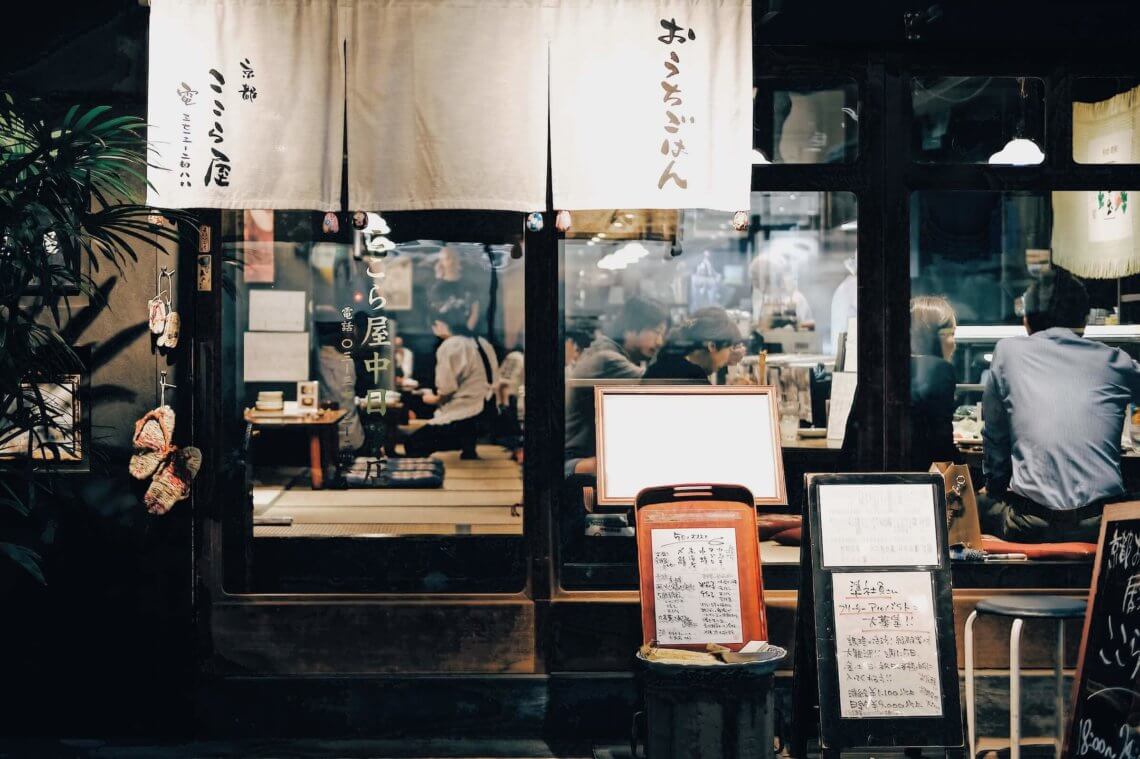
2. Where to Go: Japan’s Best Destinations
Japan has a remarkable number of destinations to choose from and an equally impressive number of things to do in each one.
To get the most out of your trip, we recommend sorting out your itinerary well in advance. Things like accommodation and event tickets often sell out quickly – especially during peak travel seasons – so planning ahead means avoiding disappointment.
If you’re after some inspiration, check out our sample itinerary for two weeks in Japan , and the rest of our unique and immersive sample Japan itineraries .
3. Unique Japanese Experiences
Visiting Japan is an opportunity to enjoy some truly unique and memorable experiences. There are, of course, far too many to fit into a single trip.
You’ll find inspiration in some of our top recommended experiences below. For even more ideas, see our article on 25 Japan experiences to add to your bucket list .
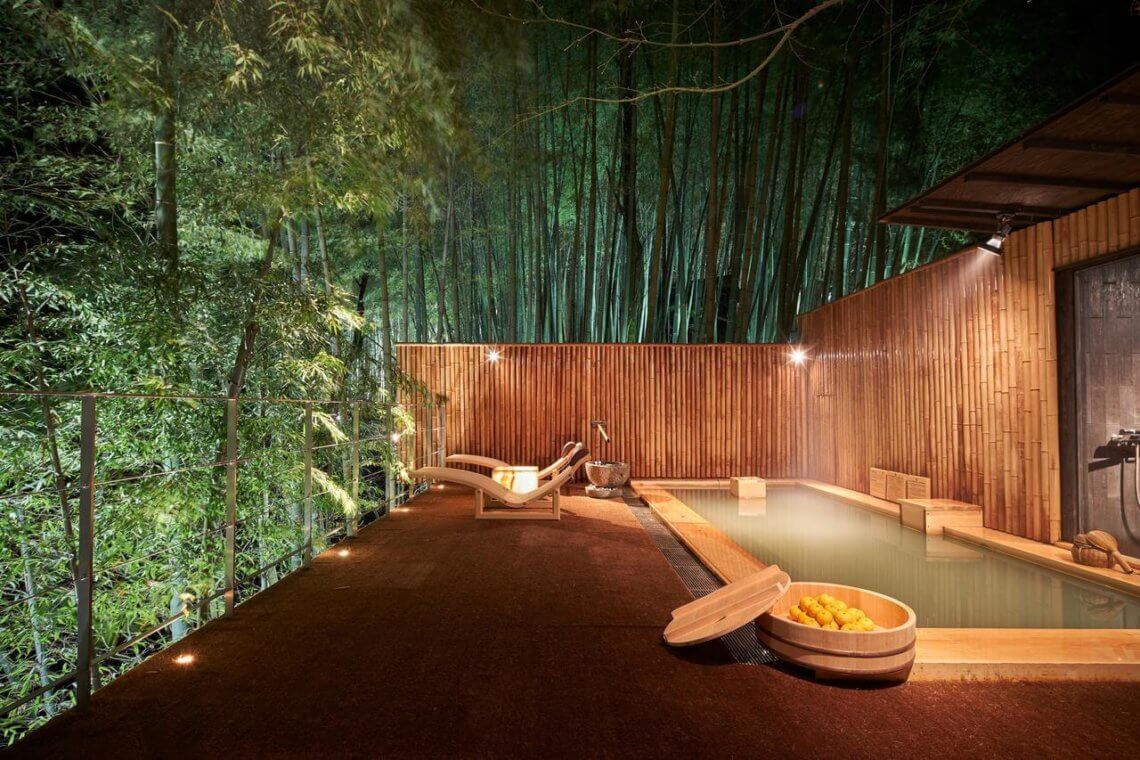
4. Venture Outside the Big Cities
When you think of Japan, the first places you think of are probably the big-name cities of Tokyo , Kyoto , and Osaka . These are amazing places to visit, but by no means everything the country has to offer.
To gain a deeper understanding of Japan, try exploring some of the more off-the-beaten-path destinations – especially if this is not your first trip. Head north to the wilds of Hokkaido, visit the peaceful villages of Shikoku, or explore some of Okinawa’s achingly beautiful islands. Not only will you escape the crowds, but you’ll also get a glimpse of some of the most authentic and memorable parts of Japanese culture.
5. Spend a Night in a Ryokan
A ryokan is a traditional, Japanese-style inn, and we highly recommend staying a night or two in one during your trip. Ryokan are very different from regular hotels, and a quintessential part of the Japanese experience.
The majority are located in the countryside, providing the perfect opportunity to unwind, rejuvenate, and enjoy the very best of Japanese hospitality. Complete with minimalist tatami mat rooms, yukata robes, kaiseki meals, onsen baths, and futon bedding, you’re guaranteed to find it an experience like no other!
To get a more detailed picture, take a virtual tour of a ryokan .
6. Discover True Relaxation at an Onsen
Japanese onsen (hot springs) resorts provide the ultimate in luxury and relaxation. Whether you choose a historic indoor bath or a remote outdoor location surrounded by breathtaking natural scenery, they are a sublime, authentic cultural experience that you won’t encounter anywhere else.
We have even more info about the onsen experience in the virtual ryokan tour mentioned above, but here are a few etiquette tips to keep in mind:
- Wash yourself thoroughly before entering the onsen itself, to keep the water sparkly clean.
- Keep towels, toiletries, and clothing (everything but yourself!) out of the water.
- Don’t stay in hot water too long if you’re not used to it – and be careful getting out. The high temperatures can make you feel lightheaded.
- If you’re nervous about being naked in front of other people, consider renting a private onsen instead. Many high-end ryokan provide private baths attached to the rooms, and others offer hourly rentals.
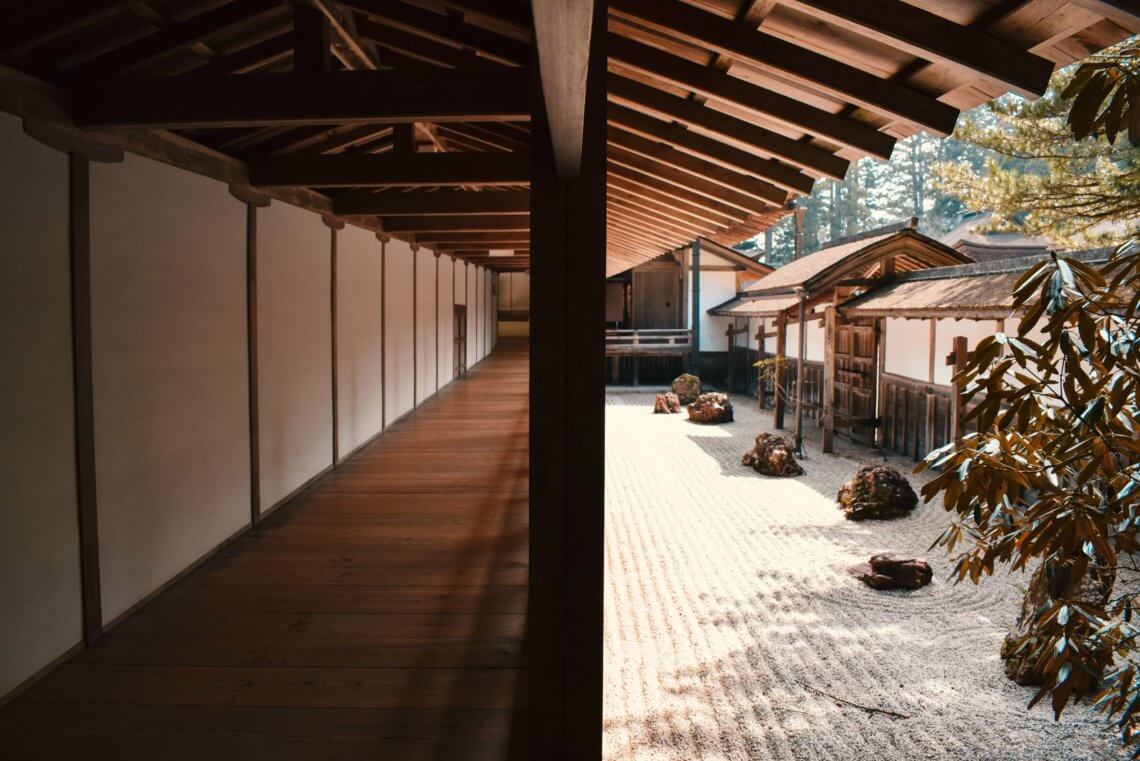
7. Stay in a Buddhist Temple
For even more of an escape from everyday life, a spiritual retreat at a Buddhist temple is just the ticket.
Visitors can get a taste of Buddhist life by staying at a shukubo (temple lodging), where you can take part in early morning prayers, meditation classes, and traditional Buddhist vegetarian cuisine. Some stays will also give you the option to help out with work around the temple as a form of active meditation.
One of the best places to experience temple life is on the mystical Mount Koya . Home to over 100 Buddhist temples and the otherworldly Okunoin Cemetery, it’s one of the most sacred destinations in Japan and the ideal location to immerse yourself in Zen.
8. Attend a Matsuri (Festival)
Japan’s matsuri (festivals) are nothing short of spectacular. Rich in tradition and bursting with color and energy, they showcase the country at its most dynamic and lively.
Attending a festival during your trip will be an unforgettable experience: a chance to try authentic and seasonal street food, witness unique traditions, and immerse yourself in an important part of Japanese life.
Festivals take place throughout the year all across the country, so regardless of your travel dates and itinerary, you should be able to find at least one to attend. Our list of Japan’s best festivals is a great place to start.
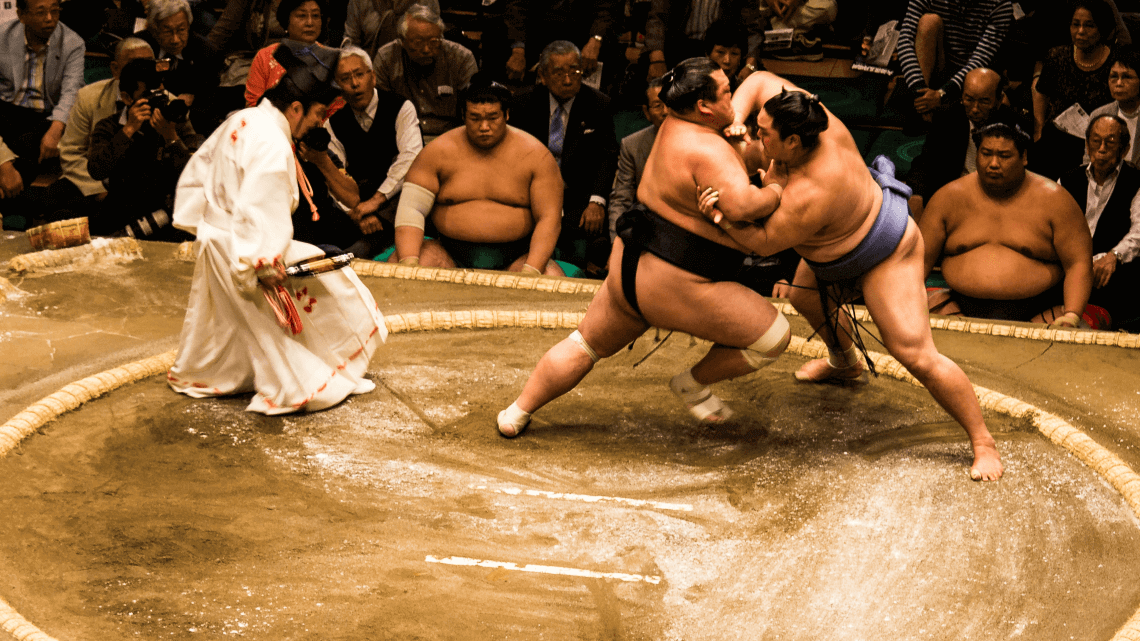
9. Cheer at a Ball Game or Sumo Tournament
To get an insight into a very different side of Japanese culture, consider attending a sporting event such as baseball or sumo – even if you’re not a sports fan.
Sumo tournaments are all-day events steeped in ancient tradition — and they take place just six times a year. If you can’t make it to a tournament, there’s also the option to go to a sumo exhibition or morning practice. All the details you need are in our guide to sumo in Japan .
Baseball is an altogether more modern affair. A Japanese take on an American classic, the games are lively but very friendly, with enthusiastic fans singing and cheering in unison virtually non-stop from beginning to end. Players often have personal fight songs, and each team has unique celebrations involving props such as balloons and mini umbrellas.
Games happen several days a week during the season, and tickets can be purchased online, at the stadium, or from convenience stores.
10. Take a Walk in the Woods
It may come as a bit of a surprise, but Japan is roughly 68% forested and 73% mountainous – making it very easy to escape the noise and lights of the city to spend quality time in nature. So grab your hiking shoes and a bento box lunch, and get out there!
Japanese culture emphasizes harmony with and appreciation for the natural world, and hiking is a popular pastime for people of all ages. In pretty much any city, you’ll find easily accessible and scenic trails to explore. From challenging mountain peaks – including the iconic Fuji-san – to stunning riverside walks, there’s something to suit all abilities and preferences. Plus it’s a great way to burn off the calories from all the delicious food you’ll be eating!
Next up, it’s time to prepare for your trip! Here are a few key things to think about before you leave home, from necessities like passports and currency, to packing advice and more.
11. Check Passports and Visas
A crucial part of any overseas travel!
Your passport should have at least six months’ validity from the end date of your visit, and two to four blank visa pages are recommended.
When it comes to visas, you might not need one – citizens of these countries can enter Japan without a tourist visa, usually for 90 days. Always check with the Japanese Embassy for the most up-to-date information before you travel.
We also recommend getting comprehensive travel insurance for your trip, to plan for the unexpected.
12. Learn Some Key Japanese Phrases
First of all – don’t panic! It’s entirely possible to travel around Japan without knowing the language. Most Japanese people speak a little bit of English, and you’ll find plenty of English-language signage in big cities and popular tourist locations.
Having said that, learning a few Japanese phrases can significantly enhance your overall travel experience in Japan. It’s a rich and fascinating language, and Japanese people really appreciate tourists making an effort to learn it – even if only the most basic of phrases!
Download the Boutique Japan Tiny Phrasebook to get started with some carefully-selected words and phrases.
13. Decide Whether to Buy a Japan Rail Pass
The Japan Rail Pass is a discounted train pass offered exclusively to tourists. It gives you unlimited travel on most JR trains – including the shinkansen (bullet train) – for periods of 7, 14, or 21 consecutive days.
It sounds like a great deal, and if you’re making multiple long-distance journeys it may save you money on travel. However, depending on your itinerary and preferences, it might not be the best option. Our short guide to the Japan Rail Pass can help you decide.
14. Travel with Plenty of Yen
Despite its hi-tech reputation, Japan is a very cash-oriented society – so bring plenty with you!
Many bars, markets, small shops, and local restaurants only accept payment in cash, particularly in rural areas. You will probably need to carry more hard currency than you’re used to. Luckily, Japan is very safe, so you can feel comfortable doing so.
Ideally, you should purchase yen in your home country, but you can also exchange money in Japan at the airport, and at currency exchanges in any big city. Alternatively, more and more ATMs are starting to accept international cards – especially those in convenience stores. Before you go, get the complete lowdown on cash, cards, and ATMs in Japan .
Don’t forget to let your bank and credit/debit card provider know that you’ll be abroad to help ensure you can use your cards while you’re away. If you’re not sure exactly how much yen to bring, check out our article: Is Japan expensive ?
15. Pack Light
Navigating Japan is much easier when you only have a small, easily portable bag or suitcase to contend with, particularly if you’re visiting a number of different destinations.
Can’t pack light? Skip ahead to the Luggage Forwarding section below .
Most trains have only a small amount of space for luggage, and even on the shinkansen there is no guarantee that you’ll find a space for a massive suitcase. Besides, stations are often crowded, making it awkward to navigate with large bags. You may even find yourself dragging bags up and down stairs if you can’t find an elevator or escalator.
If possible, limit yourself to a backpack and a small rolling suitcase – and remember to save room for souvenirs, because Japan is truly a shopper’s paradise!

16. Remember the Essentials!
We’ve already mentioned passports, yen, and weather-appropriate clothing, but there are a few more essentials you don’t want to forget:
- A small towel and some hand sanitizer: Some public bathrooms in Japan don’t have soap, hand towels, or dryers.
- Travel adaptors: Most of Japan’s electrical outlets are 2-pronged “Type A” (100 Volt, 50-60 Hz), so if your devices have a different style of plug, make sure you bring an appropriate adaptor.
- Small gifts from home: These are wonderful for giving to guides and other people you meet during your travels in Japan. Local specialties are ideal!
Check out our complete guide to packing for Japan for more advice on what to bring and what to leave at home.
17. Rent Pocket Wi-Fi
Free Wi-Fi is not as readily available in Japan as you might expect, so we strongly recommend getting a pocket Wi-Fi device for the duration of your stay. Pocket Wi-Fi is a small, mobile hotspot that allows you to connect to the internet from your laptop, tablet, or smartphone pretty much anywhere in the country.
It’s best to order one well in advance, and either collect it at the airport or have it sent to your first hotel. Most companies will also give you the option to rent a Japanese mobile phone or SIM card for your existing phone (if it’s unlocked), which can save you from paying exorbitant prices if you need to make local calls.
For more information and recommended providers, take a look at our Wi-Fi and Mobile in Japan page.
18. Download Some Useful Apps
If you’re opting for Pocket Wi-Fi, you may as well use it to make your trip go smoothly!
Numerous apps can be helpful during your time in Japan, but here are a few to get you started:
- Google Translate : It won’t always give you perfect translations, but it’s useful when trying to negotiate the language barrier.
- Japanese-English dictionary apps: There are plenty to choose from, including Imiwa? and Japanese . A dictionary app can be useful for looking up individual words quickly.
- Hyperdia : This app (and the associated website) enable you to search Japanese train routes and timetables across the country in English. Combined with specific transportation apps for the cities you’re visiting (like a Tokyo subway app), you’ll have no trouble getting around.
- Google Maps : This is invaluable for navigating your way through Japan’s sometimes labyrinthine streets. The general lack of road names can make finding restaurants and bars by address difficult, whereas Google Maps will lead you straight to the door.
Now that you’re all prepared, here are some things to keep in mind once you arrive in Japan. A mix of travel hacks and insider advice, they’ll help ensure your trip goes as smoothly as possible:
19. Get an IC Card
If there’s one thing that will add convenience to your time in Japan, this is it.
IC cards are rechargeable credit-card-sized passes that can be used to pay fares on various public transport networks with a single tap (like London’s Oyster card and New York City’s MetroCard). With one of these, you won’t have to worry about which ticket to buy or how much the fare will be — just tap and go.
Be aware that you will need to purchase paper tickets for the shinkansen and limited express/special express trains. For more information, here’s a dedicated article on train travel in Japan .
What’s great about Japan’s IC cards is that they can be used in other cities, besides the one where you purchased it. For example, Tokyo’s PASMO card can also be used in Kyoto. Plus you can use them to pay for drinks and snacks at most convenience stores and vending machines – it doesn’t get much more convenient!
20. Forward or Store Your Luggage
If you haven’t managed to pack light – or if you’ve purchased many souvenirs – you might find traveling around Japan with a large suitcase a bit awkward.
Luckily, Japan has an answer to your problem: ship your bags separately with the wonderful takuhaibin luggage forwarding service . This overnight service (longer if you’re shipping to airports or far-flung destinations like Okinawa and Hokkaido where ferry travel is involved) will have your bags ready and waiting for you when you arrive. Your hotel or ryokan will be happy to make arrangements for you.
Alternatively, if you only need somewhere to store your bags for a few hours, you can make use of Japan’s numerous coin lockers. Commonly found at train stations and shopping malls, coin lockers are safe, affordable, and convenient places to leave your bags during a day of sightseeing.
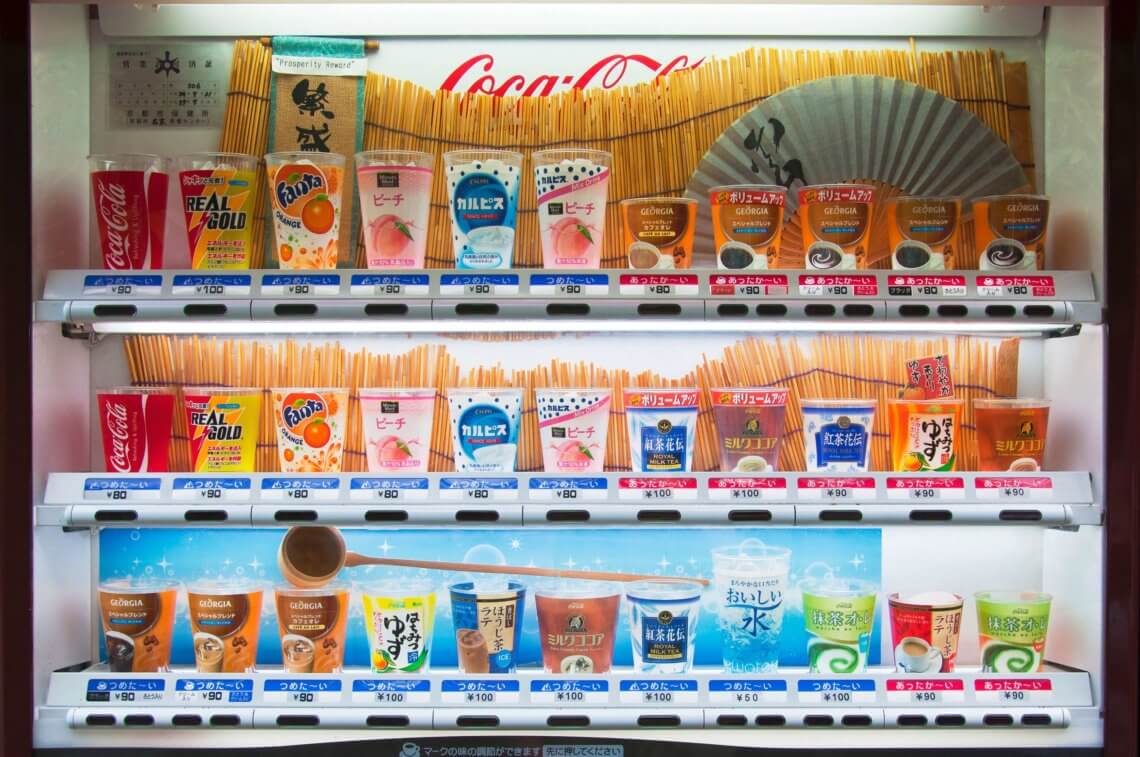
21. Take Advantage of Conbini (Convenience Stores)
Japan’s legendary convenience stores – known locally as conbini – make life for travelers and locals really, well, convenient!
In conbini , you can find ATMs to withdraw cash using your overseas credit or debit card, and arrange luggage forwarding if you’re staying somewhere like an AirBnB rather than a hotel. They offer a surprising array of food, drinks, and snacks, including reasonably priced coffee. On top of this, they sell a fantastic range of travel goods and toiletries in case you forget something.
You can also buy tickets for events like baseball games, and attractions such as Universal Studios Japan in conbini . You can even pay for domestic flights and bus tickets, although not always in English.
The best bit – there’s one on pretty much every corner.
22. Take Your Litter Home
For such a clean country, Japan has surprisingly few rubbish bins.
You’ll find them in places like convenience stores and train stations, but there are hardly any on the street. Apart from sometimes next to vending machines or in public areas like parks, you won’t see many places to dispose of trash. You may find yourself holding on to your litter for much longer than you expect – perhaps even until you get back to your hotel.
You can prepare for this by bringing a plastic bag or reusable tote with you to store rubbish while you’re out and about. It’s a small tip, but can make all the difference when you’ve got a handful of litter and nowhere to put it!
Incidentally, more and more Japanese supermarkets are starting to charge a couple of yen for grocery bags, so bringing your own can save you some cash – and the environment.
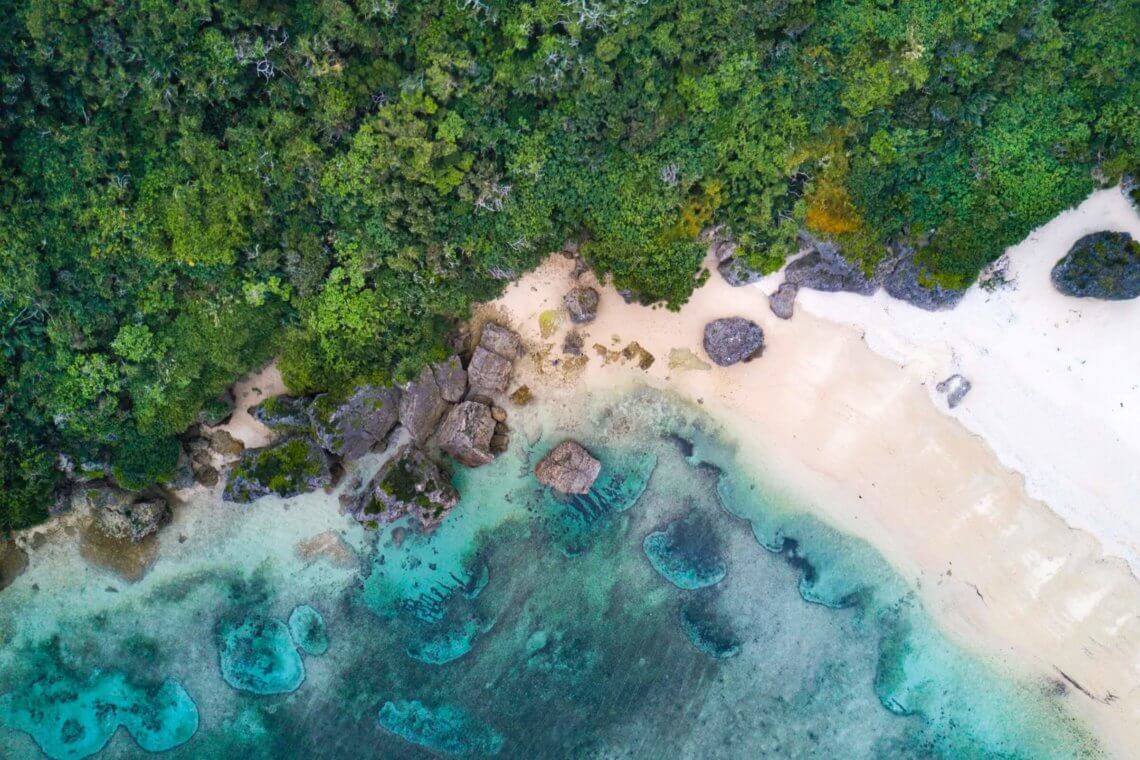
23. Avoid Crowds by Timing Your Sightseeing Right
It’s no secret that many of Japan’s top sightseeing spots can get pretty crowded. Kyoto , in particular, is known for attracting huge numbers of tourists to its most famous locations, including the stunning Fushimi Inari, Kiyomizu-dera, and Kinkaku-ji.
To avoid the worst of the crowds, consider timing your visit to coincide with quieter times of day, namely early morning or late evening. The sights are just as stunning, but you’ll have to share them with far fewer people. Perfect!
Japanese people don’t expect travelers to know all of their customs inside out — don’t sweat it too much. As long as you’re respectful, you’ll be forgiven for making an etiquette mistake or two! However, a little effort goes a long way, so here are some Japanese etiquette pointers .
24. Think Before You Tip
Tipping is pretty much unheard of in Japan, despite the phenomenal level of customer service. In fact, if you try to leave a tip, it will almost definitely be turned down – making for a potentially awkward moment.
If you want to show your appreciation to someone like a private guide or interpreter, one alternative is to bring a small gift from your home country. If you feel strongly about offering a monetary tip, be sure to do so in a manner that matches Japan’s tipping etiquette to avoid causing embarrassment or appearing crass.
25. Take Off Your Shoes
Before entering homes, ryokan , certain temples, traditional restaurants, and any area with tatami matting, you will need to take off your shoes. It’s advisable to wear shoes that slip on and off easily because you’ll be doing this a lot!
Some places provide indoor slippers for you to wear, but this won’t always be the case. For instance, on tatami it’s generally best to wear socks in order to protect the matting. As such, it’s a good idea to wear decent, hole-free socks – or bring a pair with you if you’re not wearing any.
Generally speaking, it will be obvious when you need to remove your shoes: look for indicators like a lower entrance hall, tatami flooring, slippers laid out on the floor, and shoe storage shelves. If in doubt, just ask.
26. Watch Out For Bathroom Slippers
During your travels in Japan, you may notice that certain places, like homes and ryokan, have slippers exclusively for use in the bathroom.
When you enter the bathroom, leave your regular slippers outside the door and switch to the bathroom slippers. These should only be worn in the bathroom, so don’t forget to change back when you leave. This common faux pas might result in you being greeted by (friendly) laughter from the locals!
27. Familiarize Yourself with the Toilet Buttons!
Speaking of bathrooms, Japan is well known for its fancy toilets, which have an array of buttons to control various features. These functions can include small and large flushes, a bidet, a dryer, and an automatic lid opener.
Sometimes the controls are labeled in English as well as Japanese, but more often than not, you’ll be left to decipher the pictures and kanji characters yourself. The icons should be reasonably self-explanatory, but if you’re feeling nervous about it, you can search for a sample image online.
28. Taxi Doors
Japan is famous for technology and efficiency, so it should come as no surprise that taxi doors open automatically.
When you hail a taxi, the driver will pull up, and the rear door will automatically open for you to get in. Once inside, it will close again automatically behind you.
It’s just a tiny thing to be aware of, but one that might save you a bit of a surprise!
29. To Bow or Not to Bow
Bowing is one of the most commonly seen Japanese customs, and it’s used in a wide variety of situations, including greeting people, thanking someone, and apologizing. As a general rule of thumb, the deeper the bow, the more respectful it is.
Don’t worry if you feel uncomfortable at first. Most Japanese people know that bowing is uncommon in the west, and they won’t be scrutinizing your efforts! If you’d prefer to shake hands instead, that will most likely be fine too.
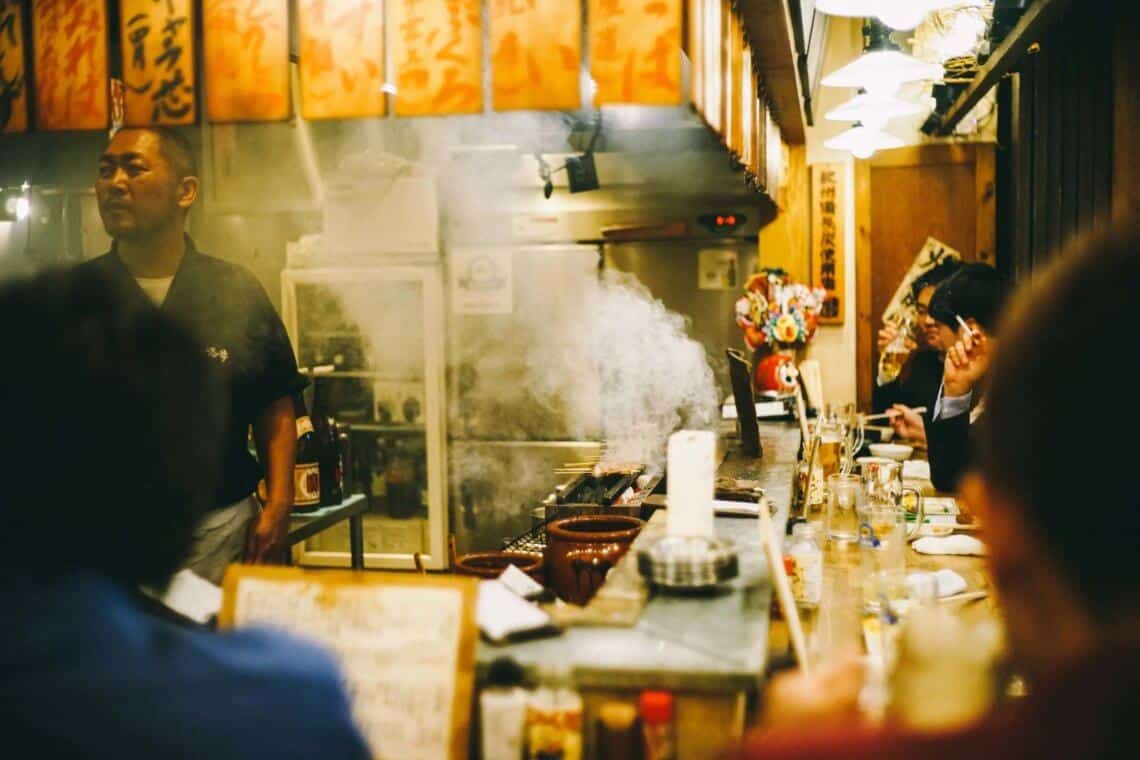
30. Smoking in Japan
If you’re a smoker, you’ll probably find that Japan is more lenient than your home country when it comes to cigarettes. Many traditional restaurants and bars still permit smoking inside. Train stations and other public areas often have an indoor smoking room where you can go to light up. Be careful on the street though, as smoking is usually not permitted on busy sidewalks – instead, you’ll need to look for a designated smoking area.
If you’re a non-smoker, you may well find the situation in Japan a little frustrating. However, an increasing number of bars and restaurants are thankfully choosing to make their premises smoke-free. A quick check of their website or signs in the window should help you find non-smoking establishments.
31. Cover Your Tattoos
In Japan, there is still an association between tattoos and organized crime. As a foreigner, you’re unlikely to be mistaken for a member of the yakuza. However, you might need to cover up your tattoos if you want to use public facilities such as gyms, swimming pools, and onsen (hot spring baths).
If your tattoos are too big or awkward to cover, don’t worry. You can always use a private onsen or search online for a tattoo-friendly one. These are becoming more common nowadays, particularly among establishments looking to cater to overseas visitors.
32. Be Respectful on Public Transport
Japanese society is known for its emphasis on politeness, and one of the places this is most apparent is the train network. Conductors bow to you, carriages are spotlessly clean, and departures are so punctual you can set your watch by them.
Keep these simple pointers in mind, and you’ll fit right in:
- Don’t talk on your phone on public transport. If you need to make or answer a call on the train, you can do so in the small compartments between carriages.
- Queue in the designated areas. On the train platform, you will usually see painted lines, numbers, and symbols on the ground indicating where to wait. And of course, let people off the train before trying to board.
- Enjoy it! Take photos out the window, recline your seat on the shinkansen , grab a delicious bento box lunch from the station or beverage cart. Trains are a great place to relax as you glide seamlessly to your next destination.
33. Use the Money Tray
In Japan, money is rarely passed directly from hand to hand.
When you’re purchasing something in a shop, restaurant, or bar, you’ll often notice a small tray next to the cash register. It might be on the counter or attached to the cash register itself. You should place your money or credit/debit card in the tray, instead of handing it to the cashier.
The cashier will usually place your change in the money tray after completing the transaction. The same system operates when paying for services in places like hotels, cinemas, and onsen.
Another common practice for exchanging money is to place cash in an envelope, rather than passing it openly, and using both hands to pass it.
Japan Travel Tips: Eating and drinking
Japan really is a foodie’s paradise. From Michelin-standard delights to authentic local cuisine, it more than deserves its reputation as a top culinary mecca. Here are some tips to ensure you make the most of Japan’s edible delights during your trip:
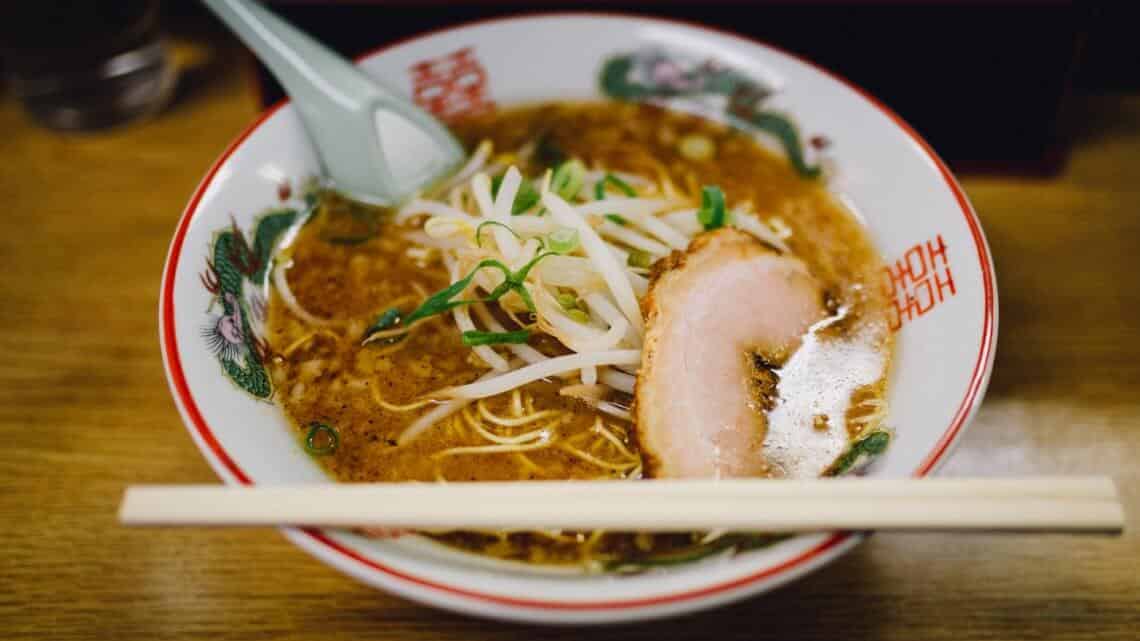
34. Try All the Food!
This may seem like a bit of an obvious point, but it’s still one travel tip worth making.
For a truly high-end experience, you’ll want to splurge on a multi-course, seasonal kaiseki meal – or the vegan/vegetarian version known as shojin ryori . To sample an eclectic variety of Japanese food in one place, head to an izakaya . These casual Japanese-style gastropubs are a must-visit, and one of the best ways to fully immerse yourself in local culture.
From well-known classics such as sushi and ramen to lesser-known but no less delicious dishes like soba and karaage there is a wealth of mouthwatering Japanese foods to try .
On top of this, there are countless local specialties to enjoy as you visit different cities. So if your itinerary includes several destinations, be sure to investigate! To get you started, check out our recommendations for must-eat foods in Kyoto , foods in Osaka , and foods in Fukuoka .
35. Brush Up on Your Chopstick Etiquette
Even if you consider yourself an expert with chopsticks, you might not be aware of some etiquette to keep in mind while using them:
A must for all the food you’re going to be trying!
- Never point your chopsticks at another person, wave them in the air, or spear food with them.
- Don’t stick your chopsticks into a bowl of rice, or pass food from chopsticks to chopsticks, as this is reminiscent of funeral rites.
- When serving yourself from a communal dish, use the opposite end of your chopsticks (not the end you put in your mouth) to serve yourself.
If you can’t use chopsticks don’t worry – you can always ask for a knife and fork.
36. Plan Ahead if You Have Dietary Requirements
Contrary to popular belief, traveling through Japan with special dietary requirements is definitely possible – if you plan ahead.
It is, unfortunately, true that dietary restrictions are not as well understood in Japan as in some other countries, and they cannot always be accommodated. However, following this advice will make your life much easier:
- To prevent misunderstandings, convey what you can and can’t eat specifically (rather than just stating that you are vegan or gluten-free, for example).
- Give plenty of advance notice when asking a restaurant or ryokan to alter their menu, as it will take time and preparation.
- ‘I’m allergic to ___.’
- ‘I can’t eat ___.’
- ‘Does this contain ___?’
- Research, research, research! The internet is a goldmine of information and advice for travelers with dietary requirements in Japan . There is an ever-increasing number of websites about being vegan/vegetarian/gluten-free/etc. in Japan, which can be absolute life-savers.

37. Go Sake Tasting
No list of Japan travel tips would be complete without a little sake!
If you’re not an expert, the best way to gain an appreciation for sake is quite simply to drink it. If you’re unsure of where to start, try a sake tasting experience or go on a brewery tour for a crash course. Another option is to ask the bar or restaurant staff for their recommendations.
One thing to bear in mind is that in Japanese, the word ‘sake’ refers to all alcoholic drinks in general. Use the word ‘nihonshu’ when you order, and you’re sure to impress! If you’re drinking with a group, always fill up other people’s glasses, not your own – and they’ll do the same for you.
For a longer primer on Japan’s national tipple, take a look at our Sake 101 guide. For something a little different, consider branching out into shochu .
Incidentally, while Japan might be best known for sake, it also has an internationally-acclaimed whisky industry . There are several Japanese whisky distilleries across the country that you can visit for a glimpse behind the scenes and a tasting, as well as a plethora of specialty whisky bars.
38. Attend a Tea Ceremony
Japan is home to one of the world’s most venerable tea cultures, and nowhere is this more apparent than in the traditional tea ceremony.
Participating in tea ceremonies is a wonderfully Japanese experience. Conducted using matcha – a high-quality, finely ground powder made from shade-grown green tea plants – it is not simply a way to learn more about preparing and serving tea. The ceremony is also a chance to take a break from the hustle and bustle of everyday life and enjoy authentic Japanese hospitality.
You won’t be expected to know the etiquette of the tea ceremony – after all, that’s part of what you’re there to learn! Just remember to wear nice socks and comfortable clothes, as you’ll likely be in a tatami room and therefore have to remove your shoes and sit on the floor.

39. Don’t Restrict Yourself to Just Matcha!
Matcha might be the most famous, but it’s certainly not the only tea in Japan that you can explore.
If you’re a tea lover, be sure to take the opportunity to try all the varieties of tea on offer. From grassy sencha and top quality gyokuro , to roasted hojicha and brown rice-laden genmaicha , Japan has a tea for every taste and occasion. Besides tea ceremonies, you can visit tea houses for tastings, and even tea plantations for tours.
Tea leaves also make an ideal souvenir, enabling you to bring a taste of Japan back home with you.
Not a fan of tea? Japan also has a booming specialty coffee scene , so be sure to check it out if a cup of joe is more your style.
Looking for More Authentic Japanese Experiences?
Hopefully, these Japan travel tips have helped you in planning and preparing for your trip.
Whether you usually plan your own trips, or normally work with a destination expert, planning a trip to Japan can seem overwhelming at times.
At Boutique Japan, our specialty is crafting completely customized trips for travelers seeking unique, authentic experiences.
If you are interested in learning more about working with us, please feel free to explore our trip planning process .
More Great Posts

Is Japan Expensive?
One of the most common myths about Japan is that it’s incredibly pricey — but how expensive is Japan really?…

Japan’s Best Boutique and Luxury Hotels & Ryokans
The best hotels and ryokans in Japan range from charming traditional inns in the countryside, to stylish design hotels and…

Traveler’s Guide to the JR Pass (Is It Worth It?)
The Japan Rail Pass (or JR Pass, for short) can be a good way to get around Japan, but many…
Plan Your Japan Trip
Learn more and contact us to discuss your unique trip.
Get Started
- The Process
- Testimonials
- Tours & Experiences
- Tailor-made Trips
- Bahasa Indonesia
We are happy to see you again!
Continue with
Or use email.
No Account? Create one
Create account
Already have an account? Sign in
Quickly Sign up with
I agree to Japan Travel's Terms of Service and Privacy Policy . Terms of--> and acknowledge that Japan Travel's Privacy--> applies to me.-->
Email reset password link
Please check your inbox and click the link we will send to you.
9 Tips for Your First Trip to Japan
Rail passes, airport choices, accommodation info, & more

Traveling somewhere new comes with a wide mix of emotions – there's often excitement and anticipation of what's to come, combined with some trepidation or anxiousness about being in a completely different country.
Often, that trepidation or anxiety can be eased when you know what to expect, so we've put together a beginners guide to Japan. The goal of this compilation is to answer some of the questions we regularly receive via our social media channels, plus some things our own staff would have liked to know when they first came to Japan!
Where to fly into?
One of the first things to consider when heading to Japan is where you'll be flying into. Many first timers opt to head to Tokyo, which is served by two international airports – Haneda (HND) and Narita (NRT). Something that visitors aren't often aware of is the difference in distance between them. Haneda is located under 20 kilometers from popular tourist areas like Shinjuku and Shibuya, whereas Narita is located in Chiba Prefecture about 80 kilometers away from the heart of Tokyo. Factor this in when you book your flights!
Transport Tips
A question we receive quite regularly is "should I get a JR Rail Pass or not?", and the answer really comes down to how much ground you plan on covering. At the time of writing, the price of a 7 day rail pass is close to 30,000 JPY, and the 14 day pass is just over 47,000 JPY. When you compare the price to a one-way ticket from Tokyo to Kyoto at 13,320 JPY for an unreserved seat, you can see that the pass pays for itself fairly quickly if you're chalking up some kilometers.
If you're basing your stay in Tokyo, one economical way to get around is the Tokyo Metro one-day pass. Priced at ¥600 for adults and ¥300 for children, the pass includes unlimited rides on Tokyo Metro lines for 24 hours from its first use. The passes can be purchased in advance or on the day, with on the day tickets available via ticket machines at all Tokyo Metro stations.
Getting yourself a PASMO or Suica card is another good option if you're predominantly staying in the one locale. These tap-and-go electronic money cards can be used on train and bus networks, plus they can be used as a means of payment at convenience stores, many vending machines, and even some retail outlets. You can find more information about PASMO cards here, and more information about Suica cards here.
Something to note when you disembark at a train station is which exit you should head out from. Many stations have numerous exits, and heading out the wrong one can put you on the opposite side of where you need to be. We recommend checking a map before randomly picking any exit, so you can be closest to your intended destination.
Some people opt to rent a car for their Japan travels, and this guide on our site covers some of the basics you need to know if you're intending to do that. It's also helpful to know how to fuel up a vehicle, and we've got an instruction guide for that here.
Cash or Card?
Unlike some destinations, Japan still has many stores and restaurants that don't offer card payment facilities. Because of this, it's useful to keep some cash on you to avoid being caught out.
While on the topic of cash, Japan doesn't have a culture or custom of tipping. If you do leave cash on a cafe or restaurant table as a tip, it's likely you'll have a staff member chase you down the street to return your money!
Which accommodation option to choose?
Accommodation options in Japan run the gamut, from size to price. Some types to consider include:
- Capsule Hotels: these are small, pod-like structures that basically fit a bed mattress and not much else. At these hotels, bathroom facilities are communal, so keep that in mind if you would prefer more privacy. Capsule hotels can be a great option for solo travelers on a budget, and there are capsule hotel chains who offer male-only or female-only lodging if you would prefer that.
- Business Hotels: There are several different business hotel chains in Japan, including the likes of APA, Route Inn, and Dormy Inn to name just a few. They are typically small in size but clean and conveniently located near stations to cater to their business clientele.
- Love Hotels: Despite their reputation for being places for some *ahem* quality time, love hotels can serve as an inexpensive, clean, and convenient place to stay. Many love hotels offer automated self check-in and check-out options, which is great if you intend to arrive or leave outside standard hours. Some also have quirky decor themes which can be fun if you're looking for something unique.
- Minshuku: Often referred to as Japan's bed and breakfast option, minshuku are a way to enjoy an authentic Japanese experience with your stay. Something to note about minshuku is that it's common for bathroom facilities to be shared between others staying there, so be sure to check when booking if this is something that would bother you.
- International Hotel Chains: There are also numerous international hotel chains to choose from, including the likes of Hilton, Marriott, and Westin to name just a few. If you're after familiarity when it comes to your accommodation, these chains can be a good option.
- Ryokan: these are traditional Japanese inns, and usually come with meals (primarily breakfast and dinner) included with the room rate. If you have allergies or intolerances, it's recommended to advise your ryokan of this ahead of time so they can work to accommodate your preferences.
Best time of year to visit
It's important to mention that the best time of year is going to be different for everyone based on their own personal interests. For instance, one person may hate the cold, another may adore skiing and snowboarding – so winter might be great for one traveler and not so much for others!
Weather-wise, two of the most pleasant times of year to visit are spring and autumn. They're also two times of year with some stunning natural beauty to enjoy in the form of cherry blossoms and changing leaves respectively.
Something to keep in mind when planning your visit is Japan's schedule of national holidays. One time of year that can present challenges for travelers is Golden Week , a string of public holidays running from April 29th until May 5th annually. During this period, many people travel to visit family or plan their own getaways, meaning that roads are congested, trains and flights are often booked well in advance, and accommodation options are often more expensive during this peak timeframe.
What does Japan think about ink? Long story short, tattoos have associations with yakuza (organized crime syndicate members) here, and tattoos are often still prohibited at places like onsen (hot springs), water parks, and even some public beaches.
If you do have tattoos, there are a couple of options. First, if your tattoos are small, some people opt to cover them with waterproof band-aids and try their luck. A safer approach is to visit places that have a more open mindset regarding tattoos, and using a website like Tattoo Friendly Japan to help narrow down those destinations is useful.
If you are particularly enthusiastic about visiting an onsen, opting for a private one can be a stress-free approach with respect to both tattoos and then idea of being naked around a bunch of strangers – the latter is quite an adjustment for visitors from certain countries.
What to do if you're an early riser
One thing becomes apparent in Japan very quickly – many places (cafes, restaurants, supermarkets) don't open until 10am or later. This is where convenience stores come in handy! Three of the major convenience store chains here are 7-11, Lawson, and Family Mart, and they're places where you can grab a morning coffee or tea, full meals and snacks, toiletries, and plenty more.
Once you're fueled up for the day, temples, shrines, and parks are good options to explore bright and early. These places are often open 24 hours (although not in all cases, so be sure to Google your intended destination to double check!) and can provide a serene and culture-filled start to your morning.
Helpful apps and websites
With most of us traveling with smartphones in our pockets, downloading a few apps ahead of time can be particularly handy. Some that we'd recommend include:
- Google Maps – a must for getting from A to B, pinning spots you'd like to visit, and even working out which trains to catch. Pop your departing station and arriving station into the app, tap the transit icon, and voilà – you've got the routes right in front of you.
- Google Translate – this comes in super handy for things like deciphering restaurant menus or being able to ask someone for help if you don't speak Japanese. If you download the offline version ahead of time you'll still be able to translate things without an internet connection.
- Gurunavi – this website makes picking somewhere to eat a breeze. You can filter by the area you're visiting and the type of cuisine you're seeking, and it will provide a variety of results. There is also an app version, but at the time of writing it is only available in Japanese.
- Halal Friendly Japan – if you're Muslim and looking for halal eateries during your visit, download Halal Friendly Japan. The app helps you find halal restaurants and cafes based on your destination.
- Happy Cow – This website (also available in app form) is useful for vegan and vegetarian travelers looking for plant-based places to eat.
Staying connected on your visit
Another regular question we get asked is how to stay connected during your travels. There are two main options – SIM cards or portable WiFi devices – and there are several companies that provide those services. For sim cards, Mobal is one convenient choice, and they offer various plan lengths with different features.
Portable WiFi is another popular way to stay online, and there are numerous companies that offer these devices. Checking the website of the airport you're flying into can be helpful in establishing where to find either SIM card providers or portable WiFi devices, for instance:
- Tokyo Haneda SIM + Portable Wifi Services
- Tokyo Narita SIM + Portable Wifi Services
- Kansai Airport SIM + Portable Wifi Services
- Share on Facebook
- Share on X (Twitter)
- Copy link to share
Japan Travel Staff
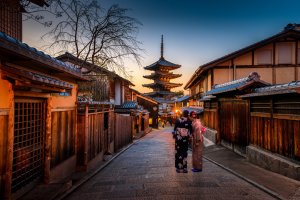
Top Articles
- Recommended

Sakura-tei: The World's Largest Okonomiyaki Restaurant

Guided Tour for Foreign Visitors to Experience Traditional Japanese Performing Arts and Learn About the History of Ginza!

Princess Adachi Festival

Introducing Nomad eSIM

A Foot Bath Path In Kaminoyama

Fūrin, the Symbol of Japanese Summer

Tokyo Ginza Noh Week

A Comprehensive Guide to Nomad’s Japan eSIM

Fairytale Experiences at Nukumori-no-mori

Freshness Burger Okinawa Fair

A Guide to Japanese Visas

Guide to Bringing Medicines Into Japan

Your Name: Real-Life Locations in Tokyo

The Ultimate Guide to Thrifting in Tokyo

Daikoku Car Meet

Hachiko Statue in Shibuya

Nintendo Museum Coming Autumn 2024

Edogawa Fireworks Festival

Japanese Urban Legends

Tokyo Auto Salon
More from this category.
By Mandy Bartok
Guide to Bringing Medicines Into..
By Japan Travel

Money in Japan
By Tom Roseveare

Guide to Earthquakes in Japan
By Edward Yagisawa
Join the discussion

Let us know how we can help.
Help us improve JapanTravel.com
We welcome any suggestions regarding this content. Your feedback is confidential and will be used to help improve this page.
Suggest an edit
https://en.japantravel.com/guide/9-tips-for-your-first-trip-to-japan/69353
Thank you for your support!
Your feedback has been sent.
- Media & Industry
- Meetings & Events
- Select Language 简体中文 繁體中文(香港) 繁體中文(臺灣) India (English) Bahasa Indonesia 한국어 ภาษาไทย Tiếng Việt Singapore (English) Philippines (English) Malaysia (English) Australia/New Zealand (English) Français Deutsch Italiano Español United Kingdom (English) Nordic countries(English) Canada (English) Canada (Français) United States (English) Mexico (español) Português العربية Japan(日本語) Global (English)
- India (English)
- Bahasa Indonesia
- Singapore (English)
- Philippines (English)
- Malaysia (English)
- Australia/New Zealand (English)
- United Kingdom (English)
- Nordic countries(English)
- Canada (English)
- Canada (Français)
- United States (English)
- Mexico (español)
- Global (English)
- Fujiyoshida
- Shimonoseki
- Ishigaki Island
- Miyako Island
- Kerama Island
- Tokyo Island
- Koka & Shigaraki
- Hida Takayama
- Ginza, Nihonbashi
- Beppu & Yufuin (Onsen)
- Ginzan Onsen
- Nagasaki Islands

- Kumano Kodo
- Shikoku Karst
- Amami Oshima
- Hachimantai
- Omihachiman
- Aizuwakamatsu

- Diving in Japan
- Skiing in Japan
- Seasonal Flowers in Japan
- Sustainable Outdoors
- Off the Beaten Track in Japan
- Scenic Spots
- World Heritage
- Home Stays & Farm Stays

- Japanese Gardens
- Japanese Crafts
- Temple Stays
- Heritage Stays
- Festivals and Events
- Theater in Japan
- Japanese Tea Ceremony
- Cultural Experiences in Japan
- Culture in Japan

- Local Cuisine Eastern Japan
- Local Cuisine Western Japan
- Local Street Food
- Japan's Local Ekiben
- Japanese Whisky
- Vegetarian and Vegan Guide
- Sushi in Japan Guide
- Japanese Sake Breweries

- Art Museums
- Architecture
- Performing Arts
- Art Festivals
- Japanese Anime and Comics
- Japanese Ceramics
- Local Crafts

- Scenic Night Views
- Natural Wonders
- Theme Parks
- Samurai & Ninja
- Iconic Architecture

- Wellness Travel in Japan
- Japanese Ryokan Guide
- A Guide to Stargazing in Japan
- Relaxation in Japan
- Forest Bathing (Shinrin-yoku)

- Experiences in Japan
- Enjoy my Japan
- National Parks
- Japan's Local Treasures
- Japan Heritage
- Snow Like No Other
- Wonder Around Japan

Visa Information
- Getting to Japan
- Airport Access
- COVID-19: Practical Information for Traveling to Japan
- Anime Tourism
- Countryside Stays
- Accessible Tourism
- Hokkaido Great Outdoors
- Scenic World Heritage in Tohoku
- Shikoku’s Nature and Traditions
- Southern Kyushu by Rail

- Traveling by Rail
- How to Travel by Train and Bus
- JR Rail Passes
- Scenic Railways
- Renting a Car
- Sustainable Travel in Japan
- Travel Brochures
Useful Apps
Online Reservation Sites
- Eco-friendly Accommodation
- Luxury Accommodations
Traveling With a Disability
- Hands-free Travel
- How to Book a Certified Tour Guide
- Volunteer Guides
- Tourist Information Center

- Japanese Manners
- Spring in Japan
- Summer in Japan
- Autumn in Japan
- Winter in Japan
- Cherry Blossom Forecast
- Autumn Leaves Forecast

Japan Visitor Hotline
- Travel Insurance in Japan
- Japan Safe Travel Information
- Accessibility in Japan
- Vegetarian Guide
Muslim Travelers
- Safety Tips

- JAPAN Monthly Web Magazine
- Arts & Cultures
- Nature & Outdoor
- Festivals & Events
- Insider Blog
- Things to do
- Local Guides
- Food & drink
- Traditional
- Hokuriku Shinetsu

My Favorites
${v.desc | trunc(25)}
Planning a Trip to Japan?
Share your travel photos with us by hashtagging your images with #visitjapanjp

First-Time Visitor Info
- Plan Your Trip
Smooth your way with a little forward planning
It is easy to feel a little overwhelmed and disoriented when you visit Japan for the first time, so find out the basics before you fly and get acquainted with the country through our helping you plan guide.
Learn a little more about Japan's customs, culture and Wi-Fi connectivity, as well as its seasonal weather, geography and luggage delivery options. Many of the questions first-time travelers might have are answered here, along with insider tips and practical advice to help you navigate the country with confidence.
Japan's official language is Japanese, but English is generally understood in major cities and designated tourist sites.
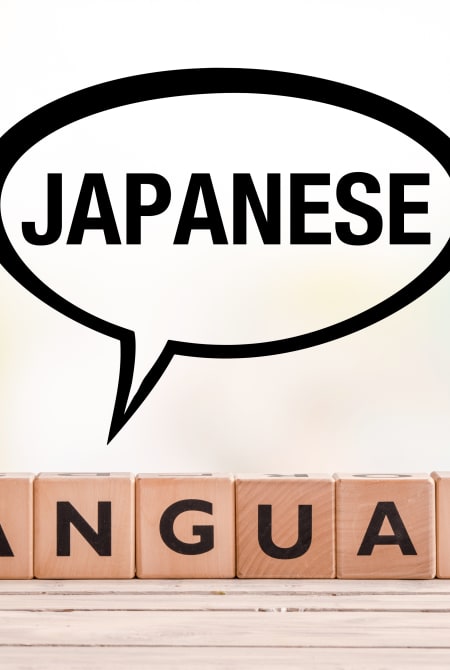
All of Japan sits within the same time zone, and no daylight saving is practiced. The country is nine hours ahead of GMT.
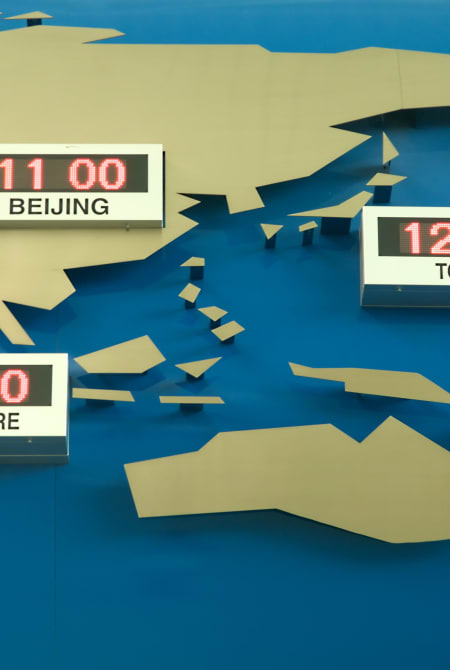
Wi-Fi & Connectivity
Wireless hotspots are popping up all over major cities in Japan, so you should never be too far from a Wi-Fi connection.

Plugs & Electricity
Japan uses two flat parallel prong plugs. For guaranteed charging of your electrical necessities, purchase a plug adapter beforehand.
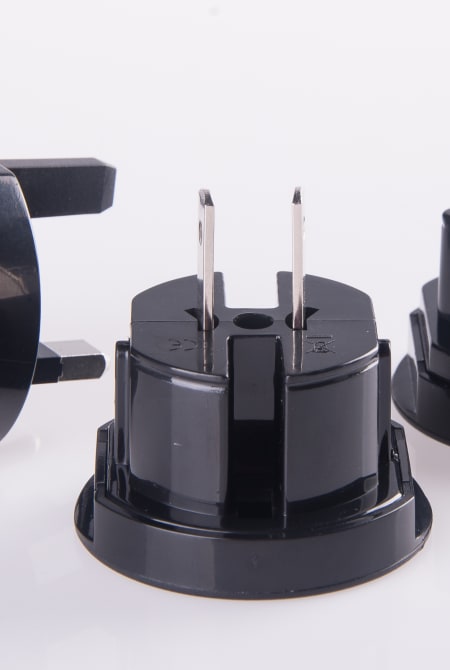
The Japanese yen is used throughout the country and you can exchange foreign currency at the airports and most major banks.
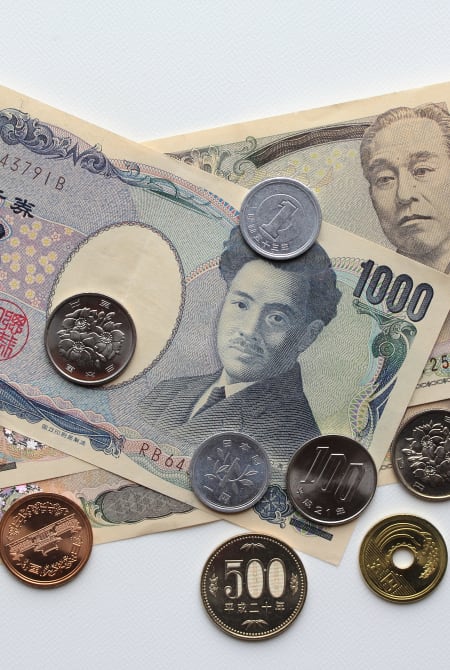
Tax-Free Shopping
Visitors to Japan are eligible for tax exemption on many consumer goods. The process of receiving your tax back can vary from store to store.

Tipping is not practiced in Japan. In fact, it can cause discomfort and confusion if you do. A service charge is generally added on to the final bill in restaurants.

Credit Cards
Even though Japan is a cash-centric country, credit cards are usually accepted in most shops, restaurants and taxis in major cities.

Weather (When to Visit)
The weather in Japan can vary wildly depending on where you are traveling to. Find out the best times to visit and what to pack.

Please check the latest information on Ministry of Foreign Affairs (MOFA) website or contact the Japanese embassy/consulate in your country/region of residence.
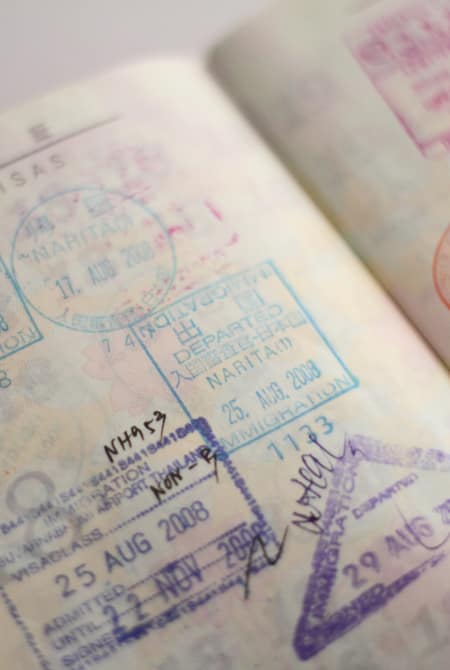
International Tourist Tax
Visitors to Japan pay a 1,000 yen departure tax to expand and enhance the country’s tourist infrastructure—a small tax that will make a significant difference.

Japan National Tourism Organization (JNTO) operates a visitor hotline 24 hours a day, 365 days a year.

Customs & Duty
The Japan Customs official page is your most trustworthy source to answer any questions or queries related to Japanese customs and duty.
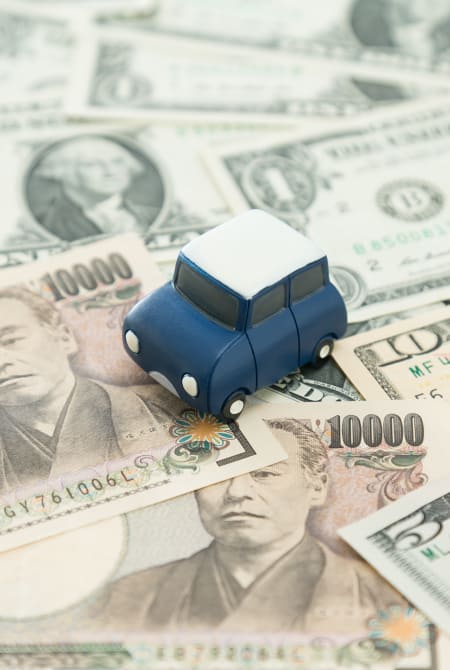
IC Travel Cards
Make your journeys as smooth as the public transportation you will ride on by purchasing a chargeable IC travel card.
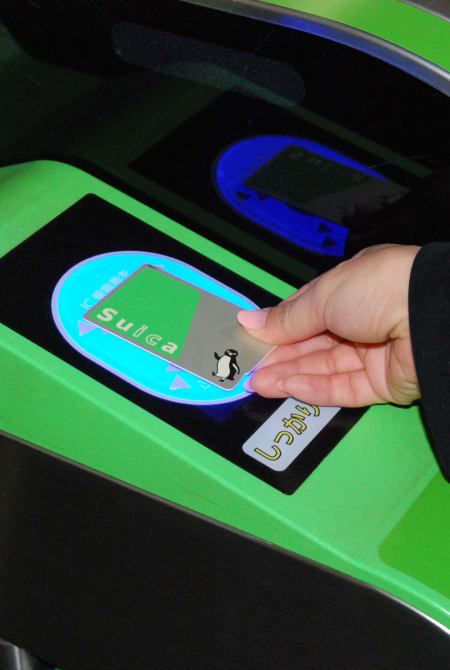
Drinking Water
While bottled water is readily available all over Japan—including in the infinite vending machines—the tap water is perfectly safe to drink.

Luggage Storage & Delivery
If you don't wish to haul your luggage around with you, drop your bags and cases off at the delivery service kiosks located at the airports.
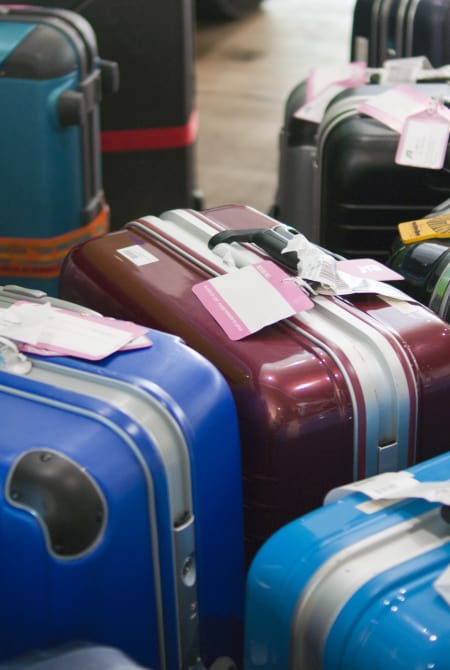
Tips for Budget Travels
To stretch your yen as far as possible, research into discounted travel and accommodation, as well as eating options that won't break the bank.
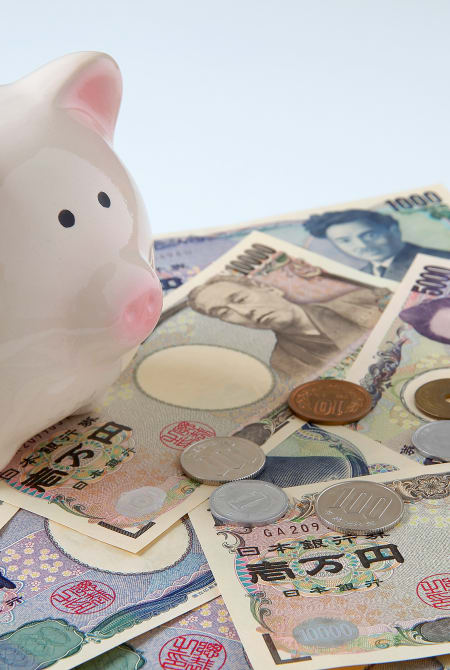
Staying Safe in Japan
If you do find yourself in a situation that requires serious help, dial 110 for an urgent call to the police and 119 for fire or ambulance.

Your embassy is there to help and support you if you should need it. Make sure you know how to get in touch.
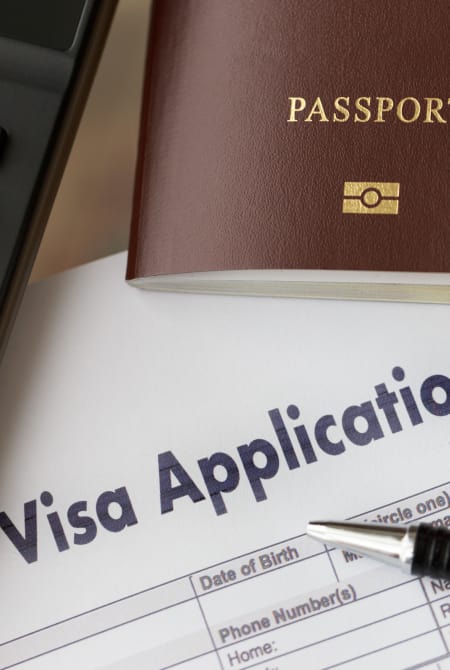
Custom & Manners
Following a general travelers code of respect for the people you meet and places you visit will stand you in good stead.
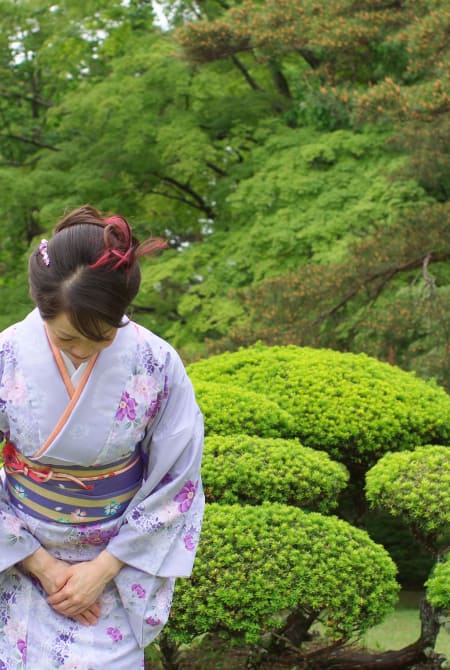
Make sure you are aware of the local laws in Japan as ignorance is not accepted as a valid line of defense.

Business Hours & Holidays
Avoid closed doors and fully-booked hotels by finding out the Japanese business hours for major businesses, services, and facilities, and the dates of the major holidays.

Download a selection of apps to make your trip to Japan run even smoother. Choose from a list of all-round, navigation, sightseeing and accommodation applications.
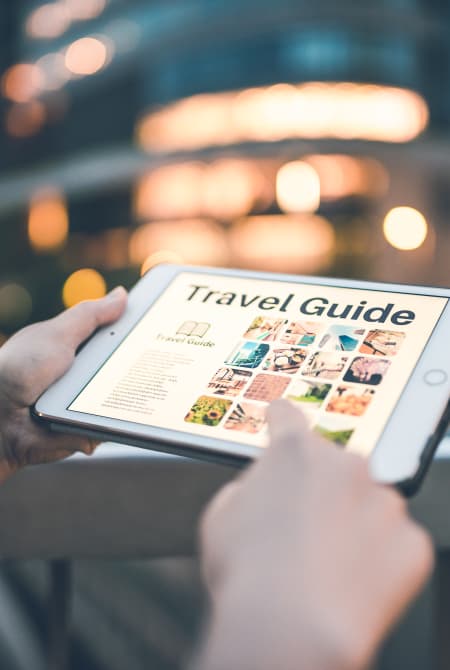
Postal Services
Instead of just an email, send a postcard back home to let friends and family know about your Japanese adventure.
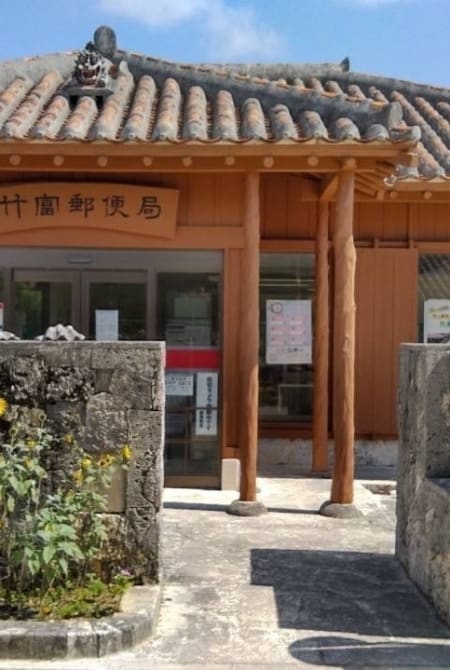
Telephone Calls
While modern technology enables you to connect with friends and family around the world from the palm of your hand, there still might be times when you need to make use of public telephones.
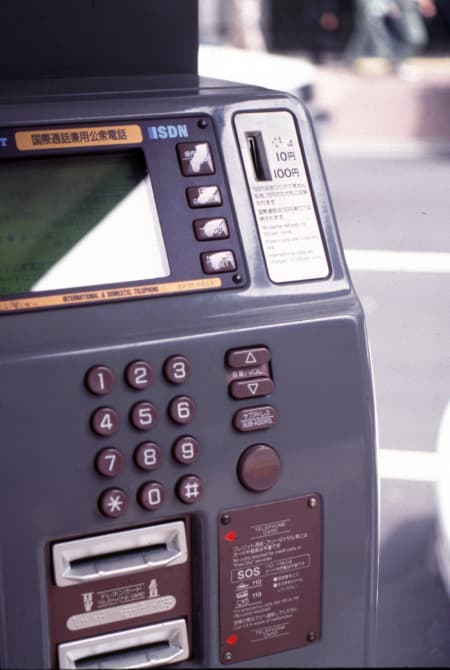
Book your stay in Japan through one of these useful sites offering a wide range of accommodation options.
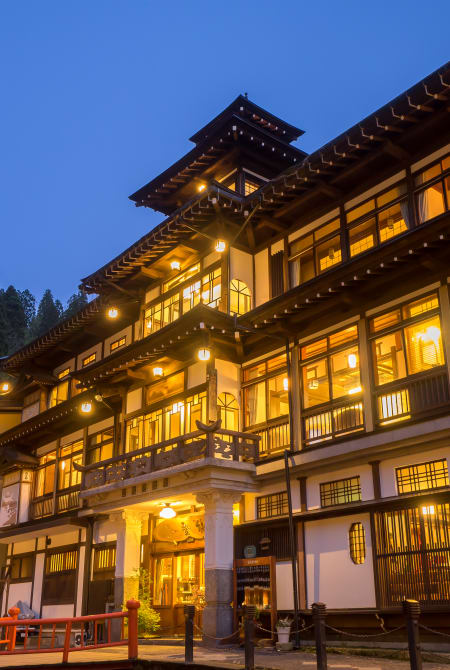
At major train stations, airports, and hotels, as well as in most newer shopping centers and theaters in the city, the disabled traveler or wheelchair user should have little trouble getting from place to place.

Traveling With Children
Traveling to Japan with children may seem like a daunting prospect and something best avoided, however, the country is surprisingly accessible.
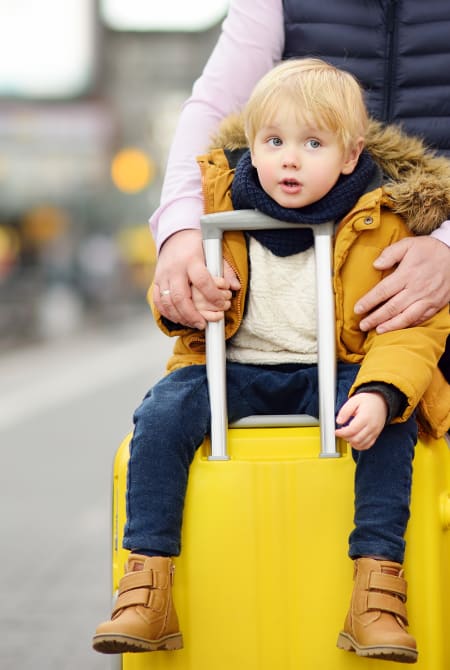
Japan continues to enhance its hospitality for Muslim travelers through the introduction of Muslim-friendly facilities.

Please Choose Your Language
Browse the JNTO site in one of multiple languages
- Visit Oyster on Facebook!
- Visit Oyster on Pinterest!
- Visit Oyster on Instagram!
- Visit Oyster on Twitter!
- Subscribe to stay up to date!
Yes, send me expert tips and deals!
By proceeding, you agree to our Privacy Policy and Terms of Use .
- Subtract one room 1 Rooms Add one room
- Subtract one adult 2 Adults Add one adult
25 Things To Know Before Traveling to Japan
See recent posts by Katherine Alex Beaven
Simply put, Japan is a fascinating destination. You’ll find a seamless blend of old traditions and new technology here. You’ll also discover gorgeous natural landscapes just a short train ride from sparkling, sprawling cities and loud, jarring outlets a short distance from quiet areas full of nuanced rules. It’s the kind of place where people will wait patiently in line for water after a natural disaster but socially ghost you if you accidentally offend them. With a distinct culture and language, it’s tough to list all the things you should know before heading to Japan. We could spend hours describing the country’s spectacular cuisine, listing the top spots to get ramen, sharing all the hidden gems, and explaining how you’re likely to offend someone accidentally. However, for now, we’re sticking to the basics: everything you need to know to help make sure your trip to Nippon is fun and only full of good surprises. We’ll help you save some money along the way, too.
1. Safety in Japan is high.
One of the best things about Japan is that it is safe. Repeatedly shining on the top ten lists of the world’s safest countries, Japan is also a great place for solo female travelers. That doesn’t mean you can throw caution to the wind. As with any destination, you’ll need to be vigilant as a foreigner, stay out of shady areas, avoid flaunting your cash, and don’t provoke anyone.
2. Cash in Japan rules.
Cash is king in Japan. Workers are usually paid in cash, and most businesses and services, including restaurants and shops, accept only cash. Your hotel and some big department stores will usually take credit but always check first. That said, always have plenty of yen in your wallet to avoid awkward conversations that can easily get lost in translation. Tip: If you find yourself without cash, head to 7-Eleven to use the ATM. Not only is your bank card guaranteed to work every time, but it’s also open 24/7.
3. Buying a Rail Pass in Japan is worth it.
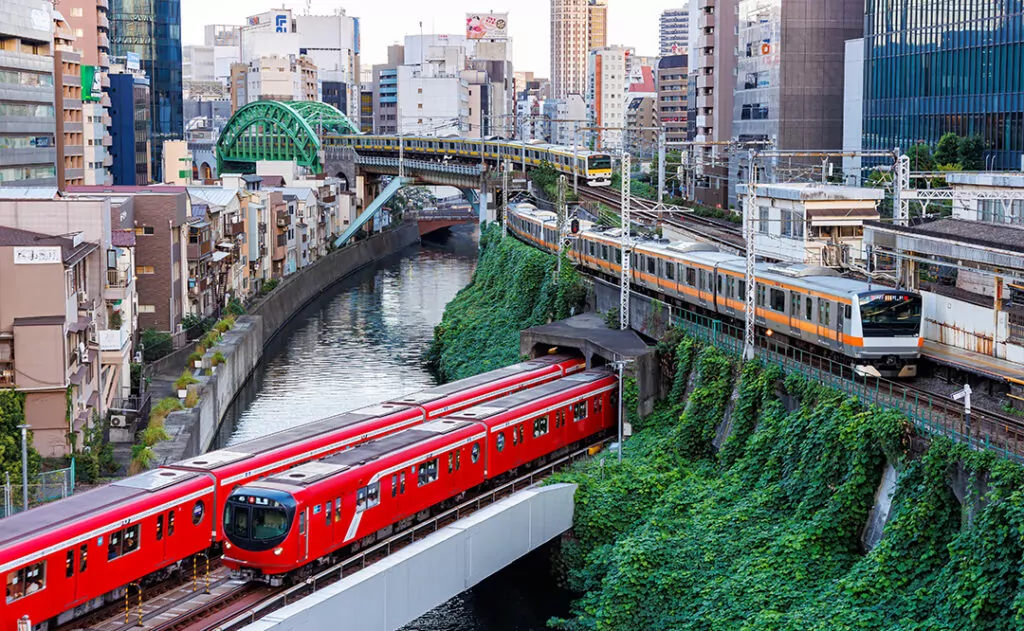
A Japan Rail Pass can help save you plenty of money, especially if you plan to travel around a particular region or the whole country. You can buy an unlimited pass valid for a specific region or country-wide. This will give you access to the bullet train (Shinkansen) and JR-branded commuter trains, buses, and ferries, often for about the same price as two individual train tickets. Remember that passes are valid for a certain number of days within a seven, 14, or 21-day period and cannot be used on the Nozomi trains. JR passes should also be bought before you arrive in Japan, though you’ll still have to validate them at a JR office with your passport and voucher in-hand. If you visit Japan before March 2018, you can buy a pass in Japan, but beware, as it will cost between 10 and 20 percent more and is only sold in certain stations .
4. The metro in Japan is not 24 hours.
It may seem shocking that a country filled with so many conveniences doesn’t have a 24-hour train system, but it’s true — even in the glittering, well-oiled Tokyo . When planning your night out, expect to make a mad dash for the last train. Depending on where you are, you’ll have to be through the doors anywhere between 11:30 p.m. to 1:00 a.m. Missing the train can be an expensive (though adventurous) mistake, leaving you to rely on a pricey cab. (Ensure your hotel or destination address is clearly printed or written before you go out.) Another option? Head to one of the all-night karaoke joints and sing into the early morning. It’s often cheaper than a cab.
5. You’ll likely see many drunk businessmen on trains in Japan.
It’s not the most becoming part of their culture, but it happens — frequently. While the majority of Japanese society is mild-mannered, you’re likely to come across drunk Japanese businessmen. Part of the diehard Japanese work culture is businessmen going out for drinks after work and booze. That said, don’t be surprised if you walk on a train around 7 p.m. and are hit with the smell of booze and visibly intoxicated men in suits. We’ve even seen a few passed out (picture one shoe off, shirt untucked, and briefcase a few feet away on the train station floor).
6. Learn a few Japanese phrases and how to recognize keywords.
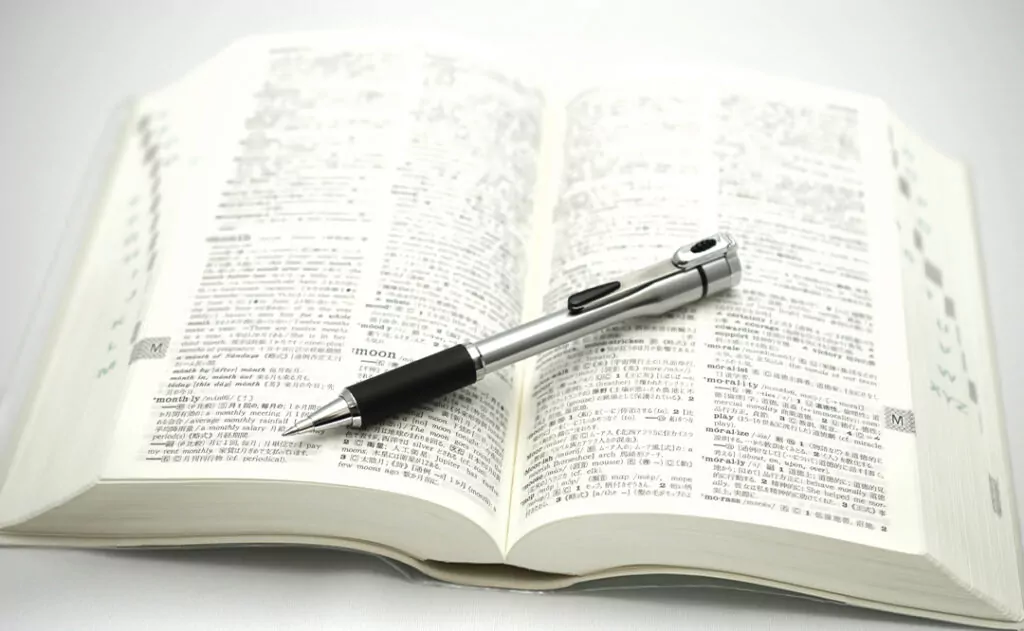
We always recommend learning a few basic phrases in the local language whenever you travel, but this is especially important in Japan, where etiquette is held in the highest esteem. Make sure you are familiar with how to say “thank you,” “please,” and “excuse me,” even if you have to write them down phonetically. You may also want to write down a few translations for your own reference, including the words for bathroom, ramen, karaoke, exit (trust us), and certain toiletries.
7. Tattoos in Japan are considered taboo.
While your tattoos may be an artistic way to express yourself, in Japan, they tend to be associated with criminals — namely, members of the Yakuza gang. This is especially important to consider if you are interested in visiting a traditional Japanese onsen . They will most likely ask if you have any tattoos before you’re allowed entry. And don’t think about fibbing — most onsens require bathers to be in the buff.
Related: The Best Travel Gifts Under $25
8. Most Japanese people love Americans and American culture.
Considering some of our dark history with Japan, it may come as a surprise that Japanese locals are taken with Americans and American culture. Not only do they get excited to meet folks from the U.S., but you’ll also find a handful of American-themed bars and plenty of Japanese versions of American items, especially food. A word to the wise: They don’t often get the recipe right, so it’s not uncommon to find sandwiches with cheese, strawberries, and whipped cream or pizza with mayonnaise and sweet brown sauce or shell-on clams.
9. Keeping your shoes on in certain places is highly offensive.
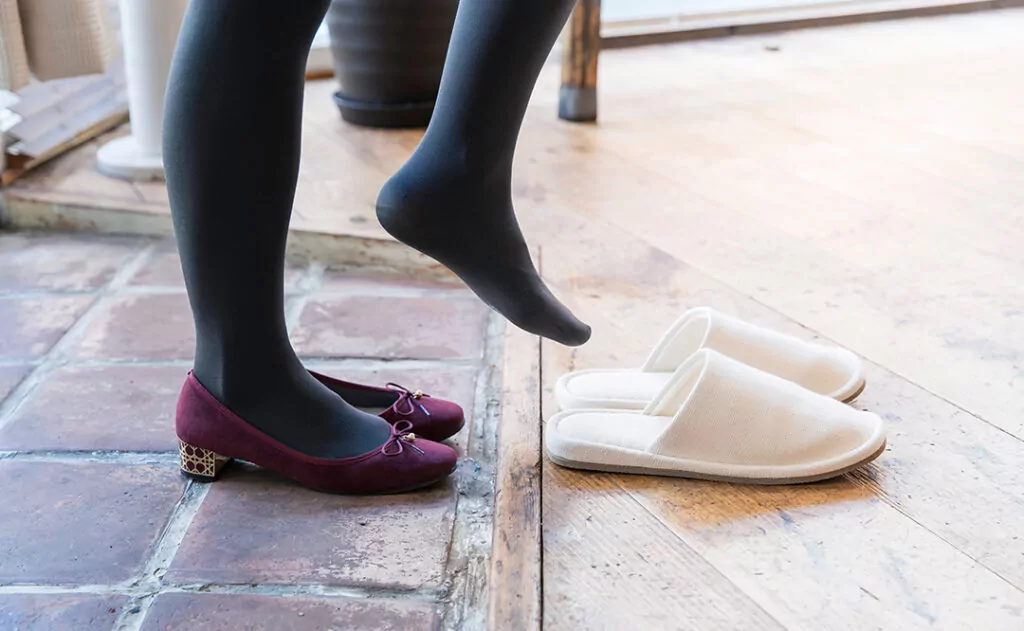
Leaving your shoes on when entering someone’s house is a major sign of disrespect. Like many other parts of Asia, removing your shoes when entering a home is a must. This is also the norm for several restaurants , so be sure to check whether you should slip your shoes off. Oh, and you’ll have to take off your shoes before entering most dressing rooms, too.
10. You don’t have to tip in Japan.
Speaking of restaurant etiquette, you don’t need to tip in Japan. If you do, there’s a big chance your server will run after you to give you the money you accidentally left behind. Waiters get paid a living wage in Japan, so don’t feel guilty. This rule is also true for hotel and other service staff you’ll encounter during your trip.
11. Don’t expect to find any hibachi restaurants in Japan.
We have some bad news for lovers of flashy Japanese restaurants where they cook in front of you, juggle knives, and set stacks of onions on fire. Hibachi restaurants are a Westernized invention. The closest thing you’ll find here is a teppanyaki restaurant, but there’s no chef slicing and dicing for you. In Japan, you’ll be cooking up your own food table side, which, for us, is half the fun.
12. You won’t always find an English translation.
Speaking of eating out, be prepared to encounter menus and signs with no English translations. If you are in tourist-heavy spots, especially in Tokyo, this won’t be a problem. However, once you venture outside of the major tourist hot spots, it’s common to see solely Japanese. This is where your list of Japanese words will come in handy, especially in restaurants. While many places will attempt to rectify this with pictures, it’s still hard to tell what a miso-katsu is. If you don’t have a list and there are no pictures, you can always pick a place with plastic versions of the menu items displayed in the window and at the very least, point to what you want.
13. Most Japanese locals speak English better than they admit.
You can politely ask for help by finding someone who speaks English. And even if your new best friend says they don’t speak much English, it’s likely better than they say it is. Tip: Speak slowly.
14. Don’t flag down your waiter in Japan — there’s a buzzer for that.
You don’t have to impatiently flag down your waiter in Japan. Many restaurant tables have a small black box with a black button so that customers can summon the waiter without calling attention to themselves or creating disruptive noises. Better yet, some spots don’t even have waiters. Instead, guests order from a screen in their booth, and the food arrives in a little slot.
Related: Always Print Your Boarding Pass (And Other Plane Travel Check-In Advice)
15. Department store sushi is pretty good.
There’s no doubt sushi in Japan is expensive. Thankfully, if your budget doesn’t allow for a chirashi splurge every day, you can still get your fix at a depachika, a food hall in the basement of a department store. Here, you can find a wide range of foods, including high-quality sushi, all prepped and ready to be carried out by tourists.
16. The underground malls in Japan are huge.
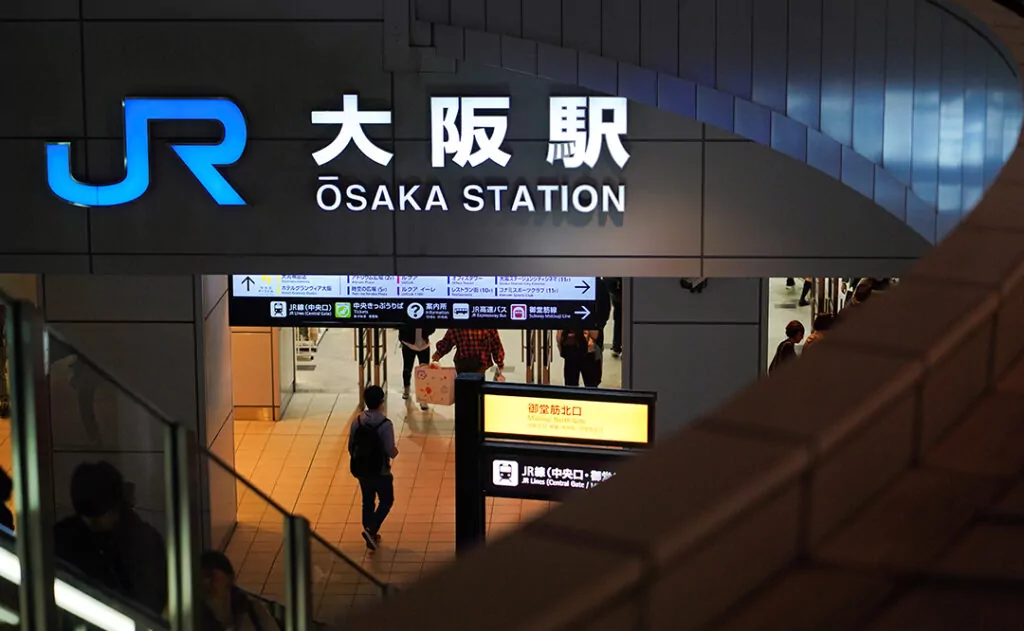
Japan’s cities are covered — no, stacked — with buildings. It’s easy to get stuck looking up, but you’d miss all the action taking place underground. Like South Korea, Japan has utilized its underground space by building huge shopping centers full of stores and restaurants.
17. Skip the animal cafes in Japan.
We’ve all seen the adorable videos of the cat, owl, and other animal cafes found all over Japan. However, these spots are hardly more than petting zoos for animals that would otherwise not receive any attention. If you must go, research your spot first and make sure they are animal-friendly.
18. Get in on the nomihodai in Japan.
What if we told you there’s a way to save big on drinks in Japan? Enter nomihodai — the Japanese all-you-can-drink special you should experience at least once while visiting. The price for a beer or two in New York City will allow you to drink for one or two hours. This deal is often found at izakayas , and they might even offer a food-related all-you-can-eat special too. There are a few rules, though. You’ll need to finish your first drink before ordering your next, and there’s sometimes an entrance charge. When the time runs out, you’ll have to abandon all the drinks you haven’t finished.
19. Speak quietly in public in Japan.
Watching the volume of your voice — and the content of your conversation — is extremely important in Japan. Everyone in Japan is aware of the fact that they are sharing space with others, so keeping conversations to a minimum and voice levels at a low volume in public is always appreciated.
20. A small gift in Japan can say a lot.
While you can’t tip in Japan, you can still offer a small token of appreciation if you want to thank someone for their help or service. This could be in the form of a trinket, such as a keychain or a souvenir from your hometown. No matter what it is, be sure to say thank you and bow as you hand it over. However, don’t make too big a deal out of it, or they might feel ashamed that they have nothing to offer you in return.
21. Pointing at people and things in Japan is considered rude.
Pointing at people or things with your finger, greeting strangers on the street with a friendly “hello,” eating or drinking in public, and snapping photos of people without their permission are big no-nos in Japan. It’s also impolite to raise your voice or lose your temper in Japan, so be careful of how you handle situations that don’t turn out the way you planned.
Plus, Japanese people are constantly worried about offending people, so consider this when asking for favors. They often say “yes” to something when they mean “no.” This indirect communication requires you to read between the lines a little. Look for context clues, like if they go grab a manager or aren’t fully committed to the “yes.” It’s a big deal for them to say no, so if they do, do not push it.
Related: Holiday Gift Guide for Women
22. You can smoke in most restaurants in Japan, but there are designated spots to do so outside.
It’s worth noting that nearly every restaurant in Japan has a smoking section, though it is much more common in izakayas. Some will even let you smoke anywhere inside. It’s funny when you consider that there are several designated smoking stations outside, too.
23. Those surgical masks aren’t what you think.
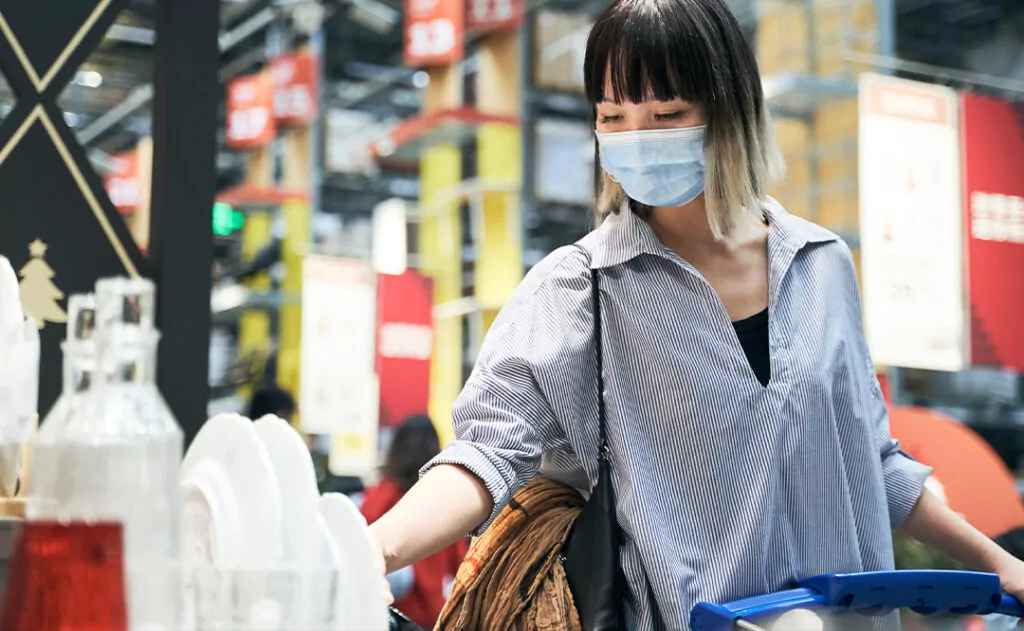
If you think the people wearing surgical masks are germaphobes trying to avoid getting sick, you’d be wrong. It’s the other way around. People don a mask when they aren’t feeling well to help stop the spread of germs to their friends, family, and colleagues. Others wear it to block exposure to pollen.
24. Try a ryokan for a traditional Japanese hotel experience.
If you want a unique Japanese hotel experience, check into a traditional ryokan for a night or two (or more). Originating in the early 17th century Edo period, ryokans are Japanese inns where you’ll sleep on tatami mats rolled onto the floor, sample a traditional Japanese set breakfast, and probably have communal bathing facilities. The latter isn’t for the shy or modest; it’s a fully naked locker room experience where you sit on a stool in front of a vanity and bathe with a shower nozzle. We highly recommend this experience for at least a night in Nippon.
Our Pick for a Japanese Ryokan: Hiiragiya
Established in 1818, this historic ryokan has been family-run for six generations, though it still offers a high-end experience. Rooms are minimal, with sliding wooden doors, floor mats, low furniture, and bathtubs made of umbrella pine. There are, however, many modern amenities, such as minibars and free Wi-Fi. If you’re looking for Western-style facilities, this is not the place for you, but for a slice of history and tradition, Hiiragiya is a solid choice.
25. Hotel rates are high during cherry blossom season in Japan.
In the spring, cherry blossom season in Japan lures locals and travelers from around the world. In addition to contending with crowds, expect competitive hotel rates during this time of year. With that in mind, book your hotel, flight, and even trains ahead of time to avoid exorbitant prices.
You Might Also Like:
All products are independently selected by our writers and editors. If you buy something through our links, Oyster may earn an affiliate commission.
Top Stories

- Travel Tips
Top 11 Las Vegas Hotels on the Strip for Every Type of Traveler
By Christina Vercelletto

- Sweepstakes
Win a Trip to St. Maarten
By Caroline Morse Teel

- Group Tours
How to Choose a Group Tour That You Won’t Hate
By Kelsey Blodget

Where to Go Instead of Mexico: 7 Alternative Vacation Ideas
By Michele Tymann

9 Hot Tropical Destinations to Visit in the Fall
By Katherine Alex Beaven
Japan Travel Tips: 34 Things to Know In 2024
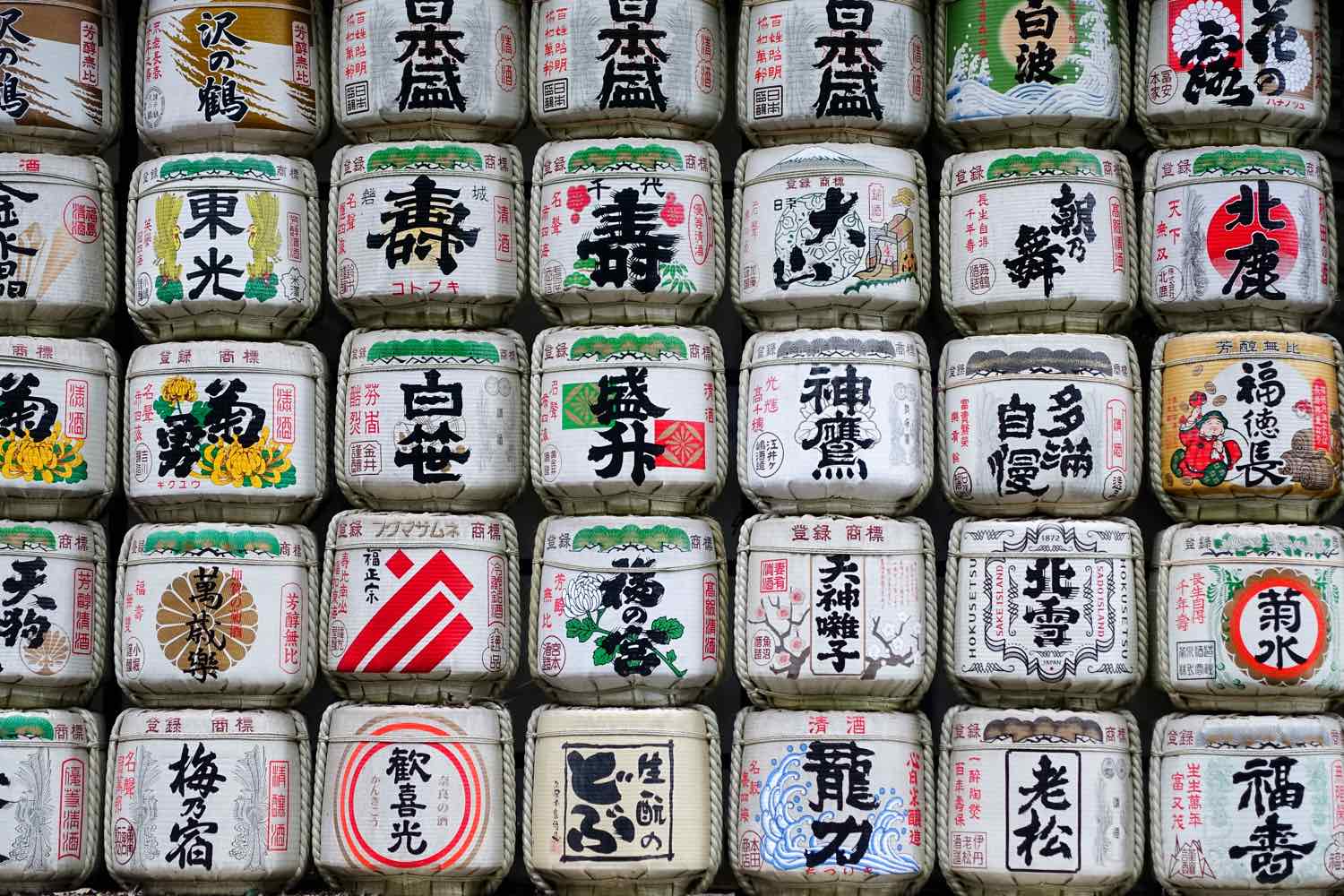
Japan is a fascinating and unique country, so there is a lot to wonder about when planning a trip. These Japan travel tips are bound to give you extra peace of mind on your travels.
Learn how to behave on certain occasions and to respect the local Japanese culture. What to order in restaurants. How to move around efficiently. And many other practicalities of the modern traveler to Nippon . These are 34 Japan travel tips to help you make the best out of your stay!
- Use 7-Bank.
- Public transportation is super efficient.
- A JR Pass can be a great buy.
- Pick the best areas to stay in cities strategically.
- Why do Japanese wear surgical masks on the streets?
- Try all the foods!
- Convenience stores are really convenient.
- Do not tip.
- Indulge in sushi.
- You can’t smoke everywhere.
- It’s an unique place to shop.
- Hold on to your garbage.
- Stay in a ryokan.
- Tattoos are not welcomed.
- Get a IC Card.
- You won’t hear a no as an answer.
- Almost any time is a good time to go.
- Grab some food in an izakaya.
- Venture out of the cities and find amazing nature.
- The best ramen of your life is here.
- A trip to Japan won’t necessarily break your budget.
- Learn the basic etiquette and customs.
- Cities are incredibly crowded…
- You can get away with English.
- Learn some basic Japanese words.
- Explore the underground world.
- You can get templed out.
- Make use of luggage forwarding services.
- Japanese gardens are something else.
- Get lost in a 100-yen store.
- Think twice before going to an animal café.
- Going to the toilet is a life-changing experience.
Let’s go into more detail of each one of these now. 👇
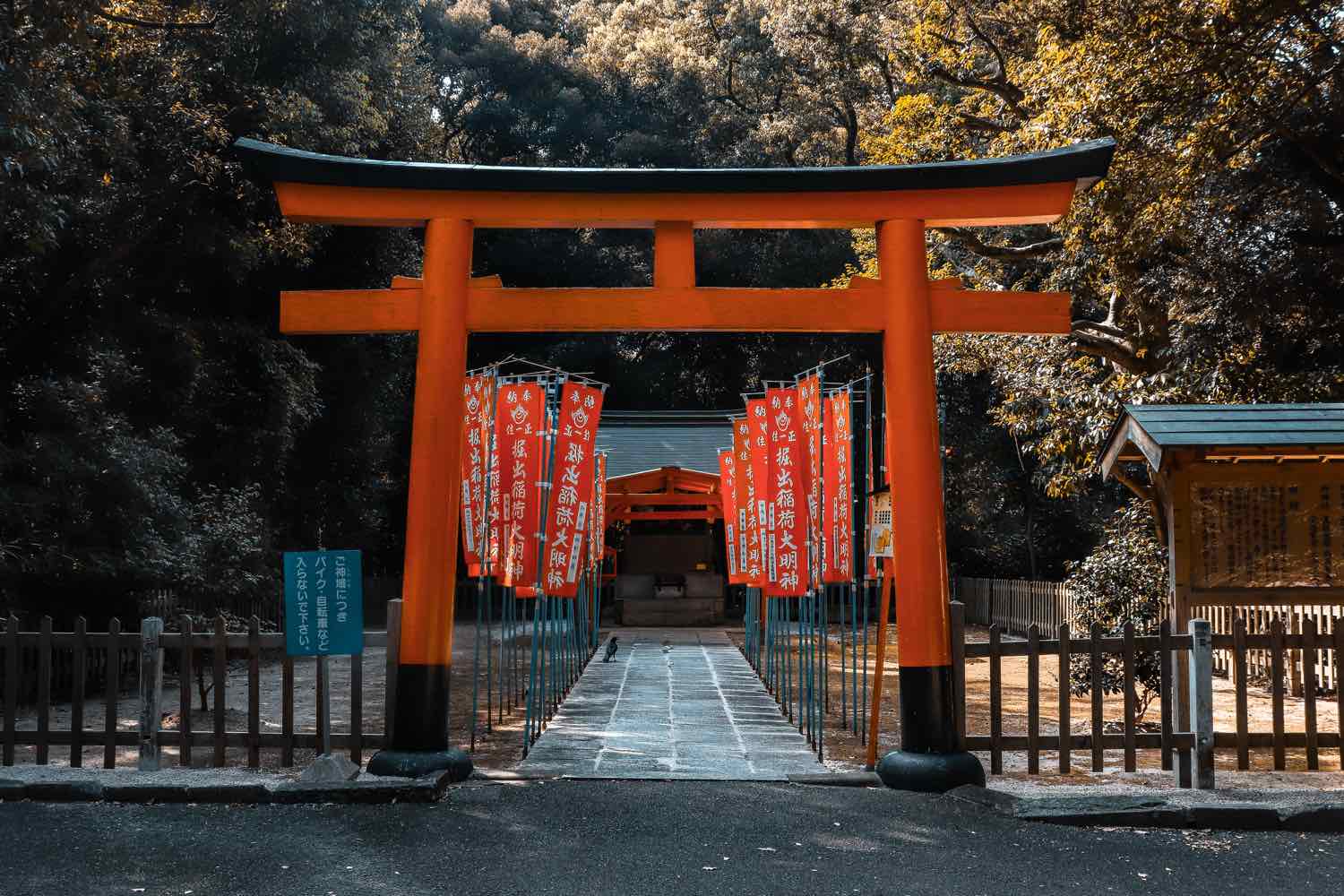
1 Use 7-Bank.
Japan is still far from being a cashless society, so the first thing to worry about is money.
Exchanging currency doesn’t yield the best rates, especially on those sketchy airport booths. Withdrawing money from ATMs directly is a better option, but not any bank. I found the one with the best rates/fees to be 7-Bank (7-Eleven’s bank).
If you’re arriving at Narita Airport in Tokyo, you can find a 7-Bank ATM inside a 7-Eleven store on the departure floor (4F), next to the restaurant’s area.
Pro tip: An IC Card can technically be used as a debit card in many stores, vending machines and restaurants throughout Japan. Also make sure you have a Revolut card , saves money on payments and withdrawals.
2 Public transportation is super efficient.
It’s easy to get overwhelmed with metro and train systems in Japan . There are spider webs less complex: we’re talking about 150 lines and 2,000 stations of overground and underground rail in Tokyo alone! The good news is once you figure it out how to get around, it’s amazingly efficient.
For journeys inside the cities, the fare is calculated depending on the length of your trip. I recommend getting an IC Card (Suica, Pasmo, etc) to avoid these calculations every time you board the subway. Instead, the fare is discounted automatically once you tap the card on the reader when you’re going out of each station.
If you’re traveling long distances with the incredible country’s rail network, JR Pass can be a time and money saver . Make sure you also download Japan Travel for your phone. This app is not exactly a UI delight , but has detailed train schedules and even a useful filter “JR Pass” to find the best trains that fit your itinerary.
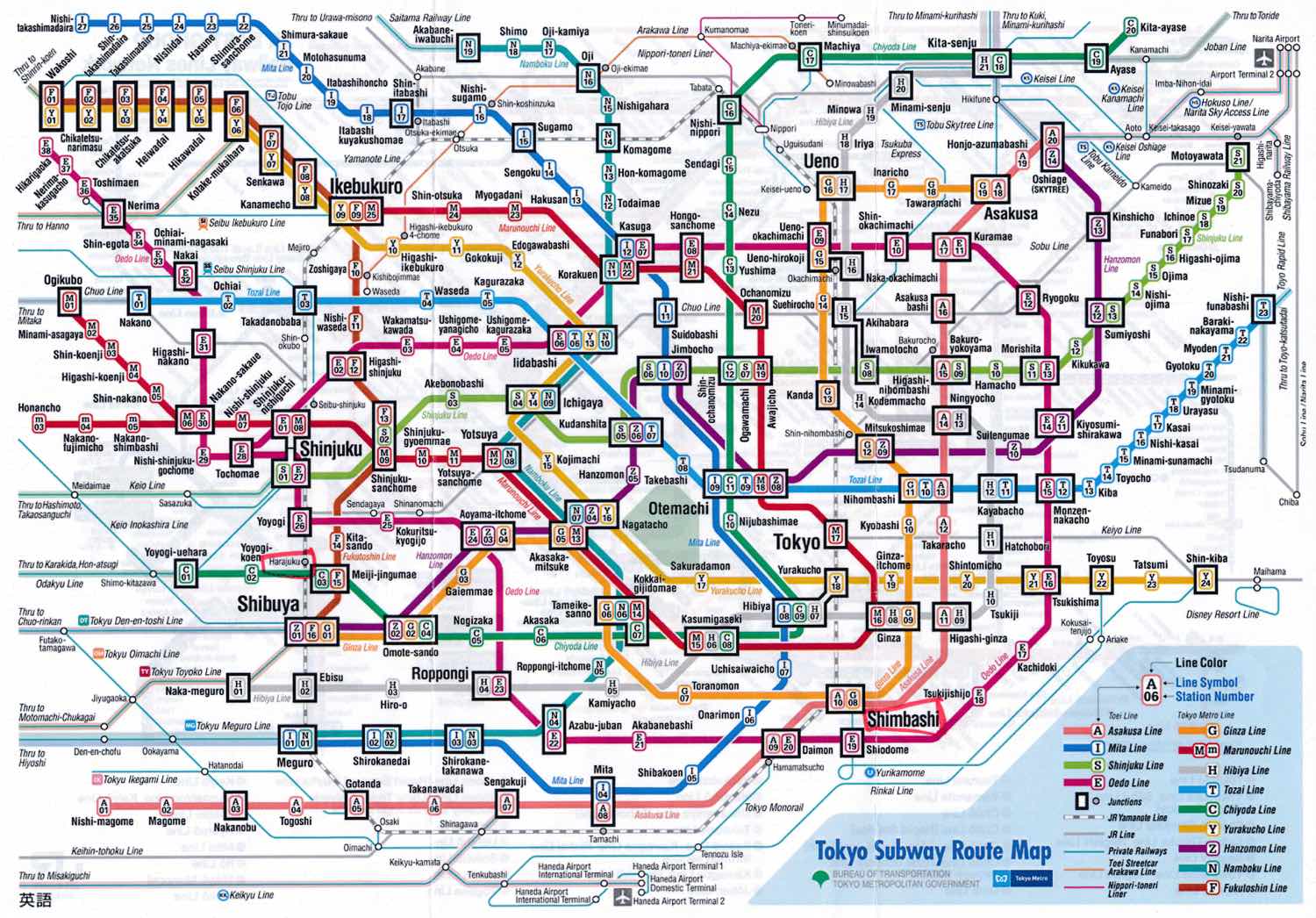
3 Consider a JR Pass.
Emphasis on the can . Every travel blogger out there will tell you to buy a JR Pass through their affiliate link no matter what. The reality is: it depends .
If you’re planning to travel around the country, a 2 or 3-week JR Pass can save you time and money. It’s super convenient and will give you unlimited access to (some types of) Shinkansen and JR-branded trains, buses, and ferries.
However, if you’re staying in one region of Japan only or planning to visit just a few places, a region-specific pass or even individual tickets can be more than enough. This tool can help you understand in what cases does it pay off .
Japan Rail Pass Tips
A Japan Rail Pass is a pass available for travelers only that allows you to move around Japan hassle-free in trains, buses, and even ferries. Choose between a 7, 14 or 21-day pass.
The passes are costly and have spiked 70% in cost after the pandemic, but if you look at prices of individual train tickets you’ll understand they can still save you money with just a couple of trips.
Also, you can buy your JR Pass in some stations in Japan but it will be more expensive. Buy it online before your trip and get them delivered to your home address or hotel in Japan. In either case, you’ll need to activate it in a train station when you arrive in the country.
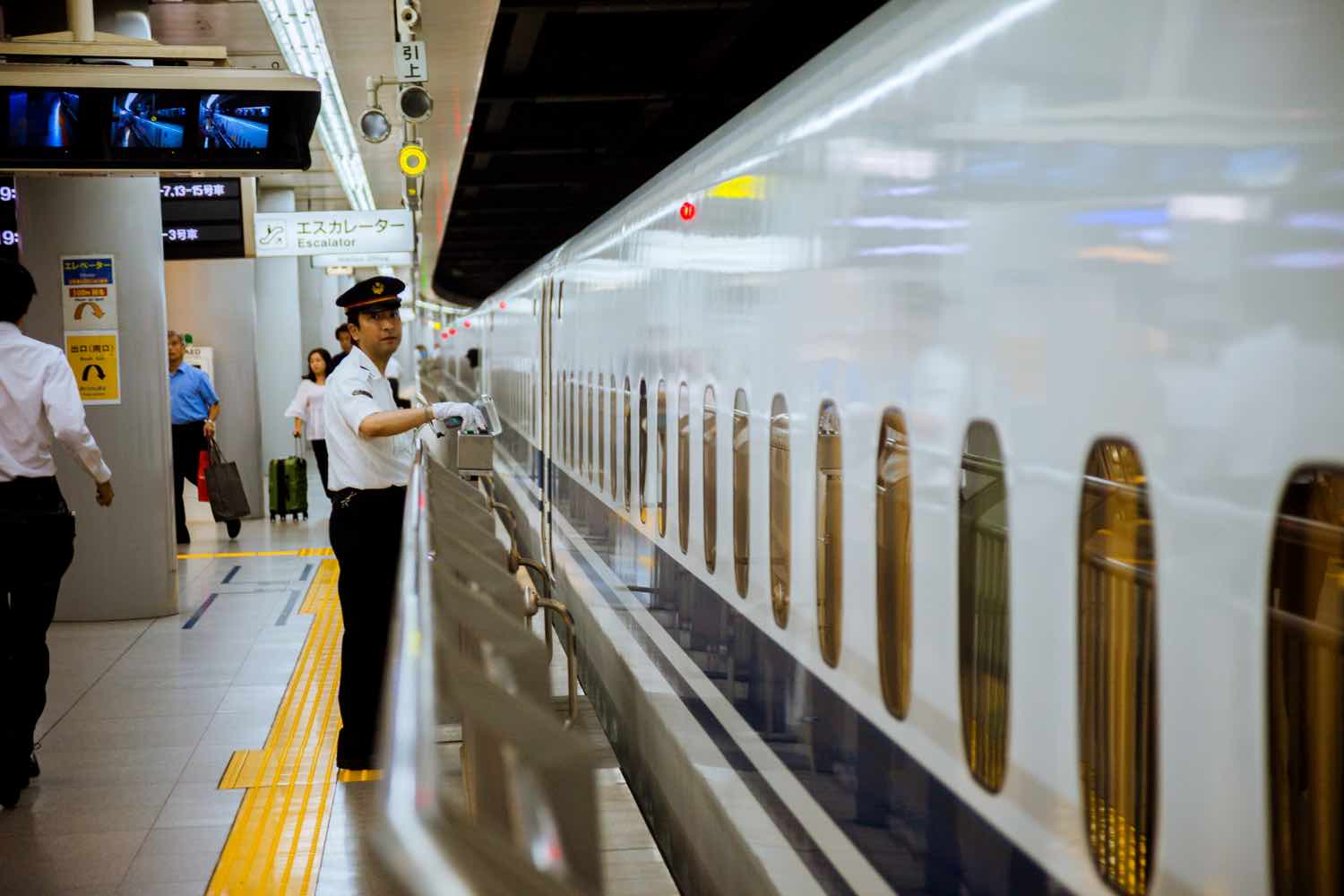
4 Pick the best areas to stay in cities strategically.
Picking a smart location to stay can literally save hours in getting from point A to point B.
Best areas to stay in Tokyo
To be honest, anywhere on the circular JR Yamamote Line is a good bet, as you can get to any area of the city rather quickly.
Shinjuku and Shibuya are popular areas to stay in, with a lot to see, eat and do. Ginza and Tokyo Station are extremely convenient transport-wise but lack the fun factor in my opinion.
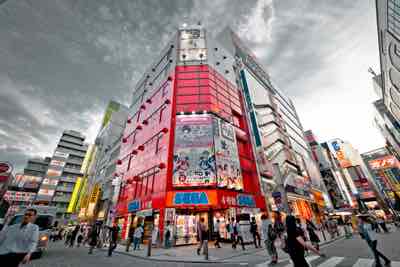
Check out this pre-filtered list of the highest-rated places to stay in Shinjuku area in Tokyo.

Looking for an experience straight out of a sci-fi movie. This is it.
Best areas to stay in Kyoto
The area around Nishiki Market is definitely the most convenient to get to the major attractions of Kyoto . You’ll also be in walking distance to hundreds of malls, bars, shops, and restaurants.
However, if you want a much more unique experience amongst well-preserved architecture and century-old traditions, Gion – the famous Geisha district – is the place. Plus, it’s not every day you get the chance to bump into an authentic geisha and her maiko on the way to your hotel.
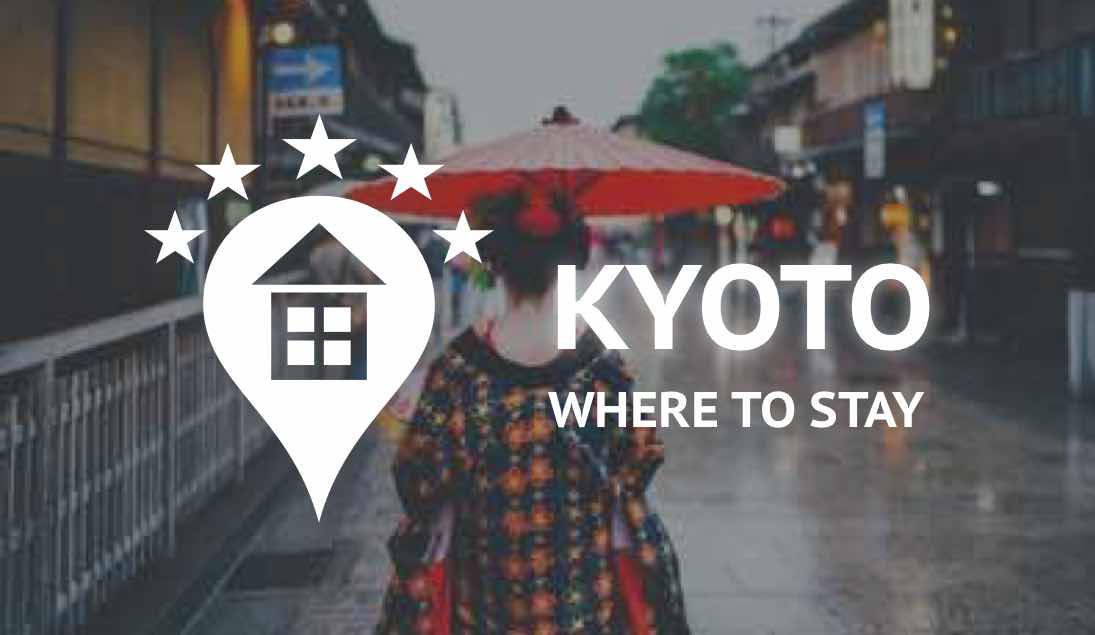
Check out this pre-filtered list of the highest-rated places to stay in the Gion district, Kyoto.
Best areas to stay in Osaka
There are 2 main “city centers” in Osaka – Umeda and Namba – which correspond to the main transport hubs.
Namba is superior in nightlife and food, it’s bright, busy and loud unlike the rest of Japan .
Umeda is more business-y, but with great food options too. It’s also close to some sights and it’s more strategic for shopping.
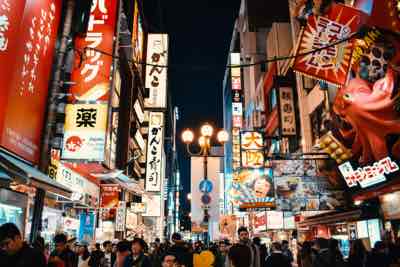
5 Wear a mask.
Before COVID hit, seeing people with surgical masks made me a bit uneasy. Eeewww, poor people! They need to wear masks because of the intense pollution and diseases, what a terrible place to visit!
Turns out it’s quite the opposite: Japanese wear these masks to prevent allergies (i.e. pollen) or to avoid that their germs infect others when they’re sick. Do the same when riding public transport.
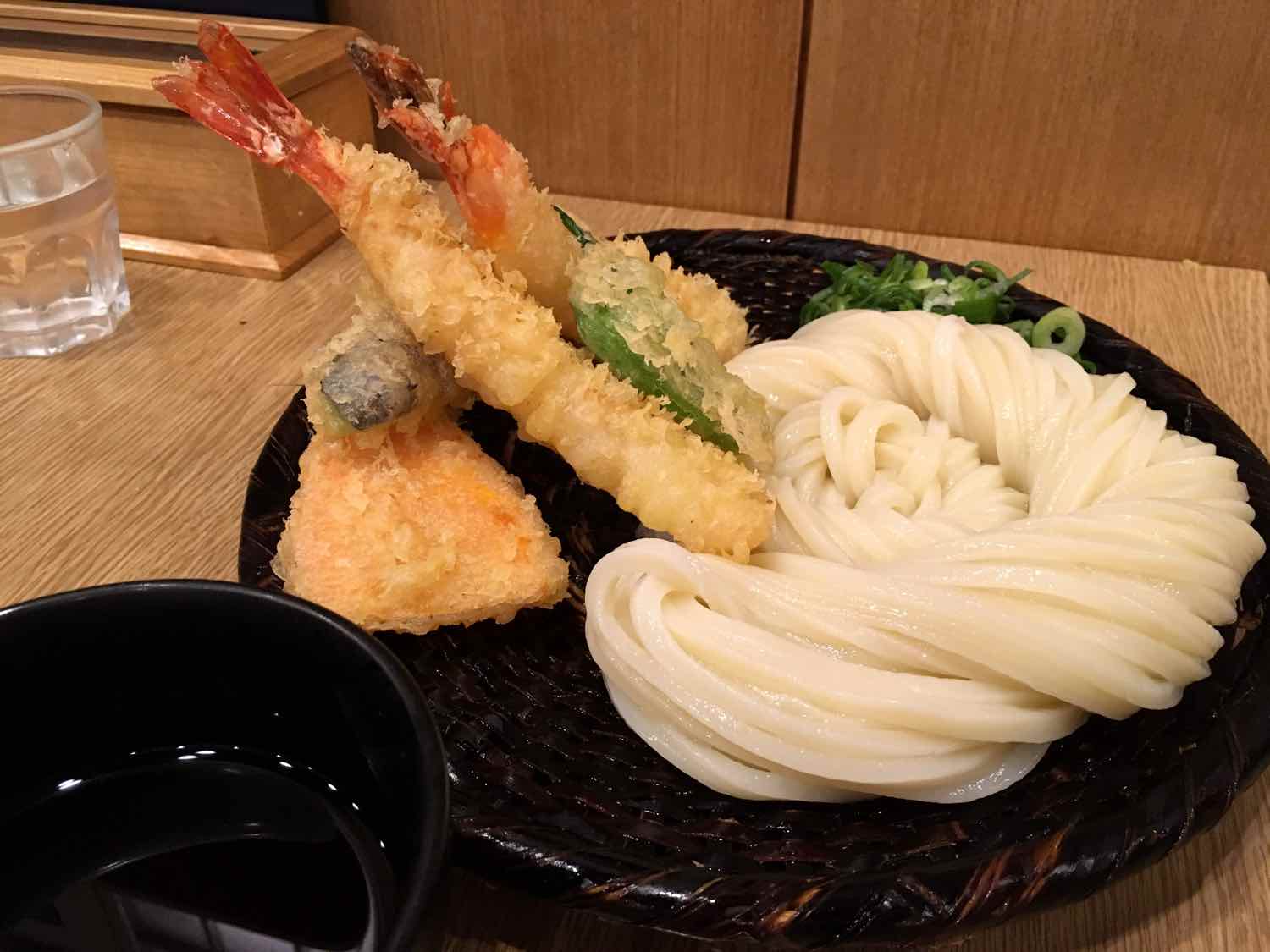
6 Try all the foods!
I might be biased here because Japanese food was already amongst my favorites in the world, but I’ve found eating out in Japan to be an absolute wonder.
Firstly, the amount of restaurants is in-cre-di-ble. Customer service is top-notch, the quality of ingredients and the way they’re prepared is something they care about a lot and let’s not even talk about clean they are.
The standards are so high I honestly think it’s hard to have a “bad meal” in Japan.
What to eat in Japan 🍜
Here’s a non-exhaustive list of the foods to try in Japan .
- Gyozas – Crispy and golden brown on the outside, juicy on the inside. Pork is the standard, but shrimp and veggy are my favorites.
- Japanese Curry – tried this in Coco Ichibanya in Tokyo. Delicious going in, not so pleasant going out.
- Okonomiyaki – typical from Hiroshima, where is served with noodles, this is a Japanese savory pancake with many different ingredients.
- Ramen – wheat noodles served with toppings like seaweed, menma and green onions in a meat or fish-based broth. Can be flavored with miso or soy sauce.
- Soba – thin noodles made from buckwheat or wheat flour. Served either in hot broth (as a soup) or cold, with a dipping sauce.
- Sushi – pretty sure you know what this is.
- Takoyaki – deep-fried dough in shape of a ball with minced octopus inside. Usually served with bonito flakes on top.
- Tempura – deep-fried vegetables or seafood. Did you know this technique has Portuguese origin?
- Tonkatsu – deep-fried breaded pork cutlet.
- Udon – the thick version of wheat noodles, usually served as hot noodle soup.
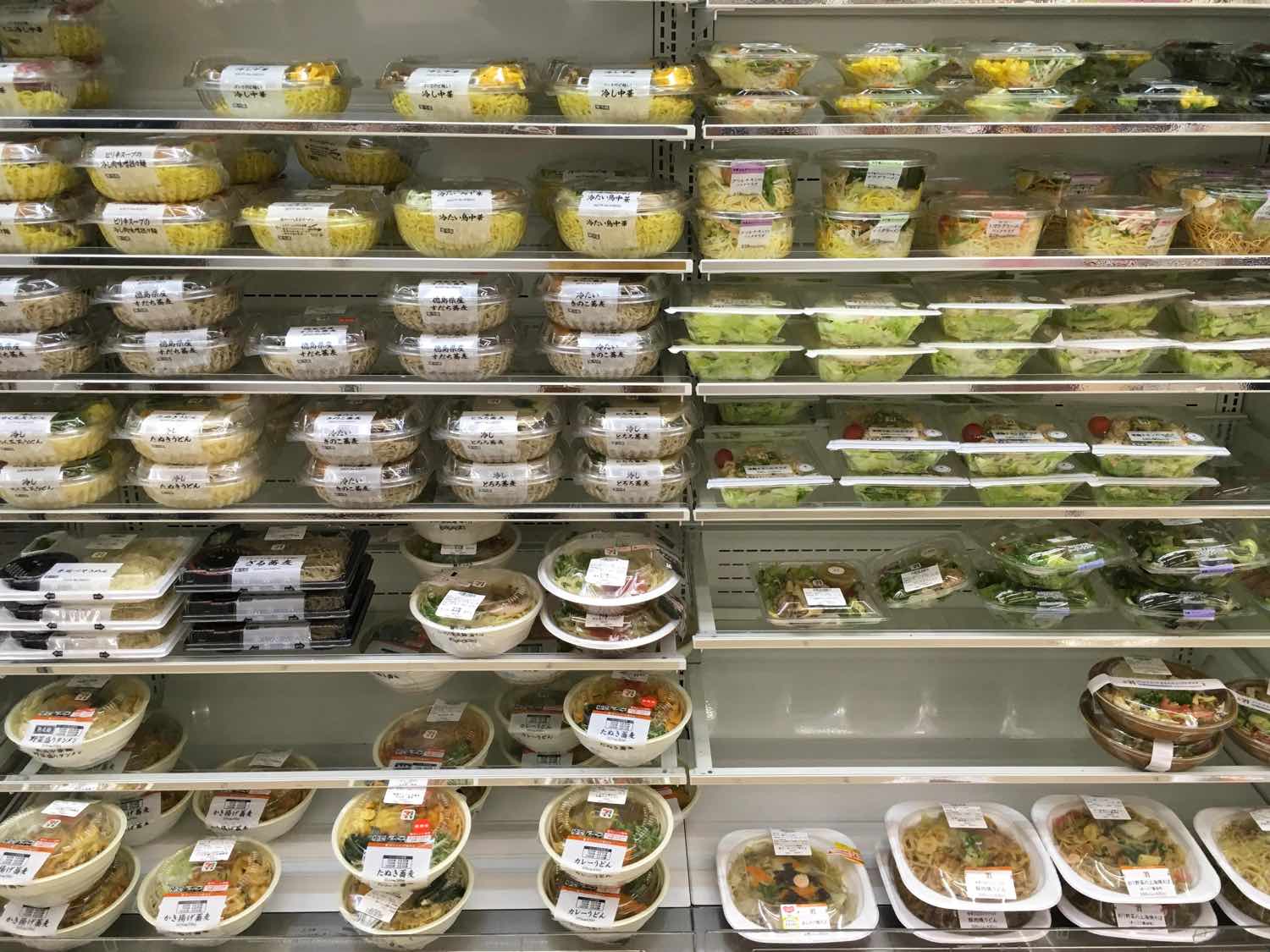
7 Convenience stores are really convenient.
This is one of the things I love about Asia: there’s always a convenience store nearby, open 24 hours/day for whatever random item you’re in need during your stay.
There are three main stores in Japan : Lawson, Family Mart, and 7-Eleven. 31% of the worldwide stores of the latter are here. They’re incredibly varied on the inside, selling everything from cookies to face masks, from cookies to underwear.
The highlight here is the food though: from small snacks to delicious ready-to-eat meals and everything in between. Sushi, onigiri (rice balls) and full bento boxes although I personally recommend the egg salad sandwiches.
8 Do not tip.
Guys, this one is important. Do not – under any circumstances – tip in Japan. Not only it’s not a common practice, it’s actually considered rude. No matter how great the food or exceptionally good the customer service is.
To ask for your bill, simply make an “X” sign with your index fingers.
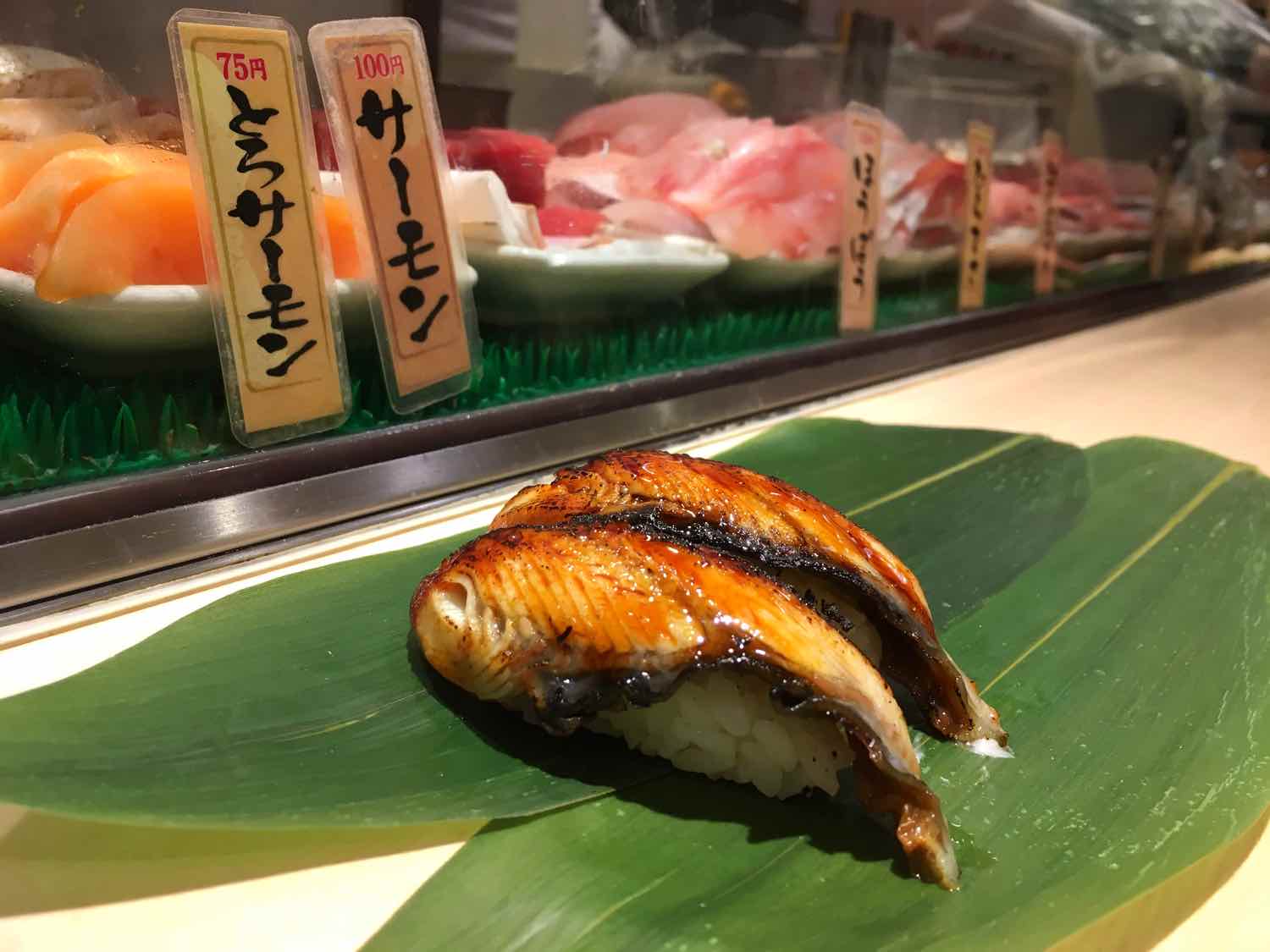
9 Indulge in sushi.
Sushi is NOT the most common food you can find in Japan. That would be ramen . Especially if you get out of the big cities, sushi is really not that common and treated as a more premium meal.
The major difference of sushi in Japan is in 1) how fresh are the ingredients 2) the experience you can get. The fish-to-rice ratio is quite big, with several different types of tuna to choose from. Plus – and this is what I think it makes it special – you can find places where sushi chefs make the rolls per order, right in front of you. All for the price of an average meal in Europe or US.
Tips to eat sushi in Japan 🍣
- Unless you have money to spend in a luxury high-end experience, the best sushi places are tiny, with limited seating where you ask directly the chefs what you want and they make the pieces in front of you. Case in point: Standing Sushi Bar in Tokyo.
- Try a conveyor belt sushi. These are some levels below in the quality scale, but still very acceptable for western standards. You grab your items directly or order through a tablet and the food comes in cute train platforms. It’s incredibly cheap.
- There are many different types of tuna, but fatty tuna ( maguro ) will rock your world.
- Sashimi is only eaten with chopsticks but it’s acceptable to eat nigiri with your hands. Only the fish part should be dipped in the soy sauce.
- Green tea – cold or hot – is often complimentary in sushi restaurants.
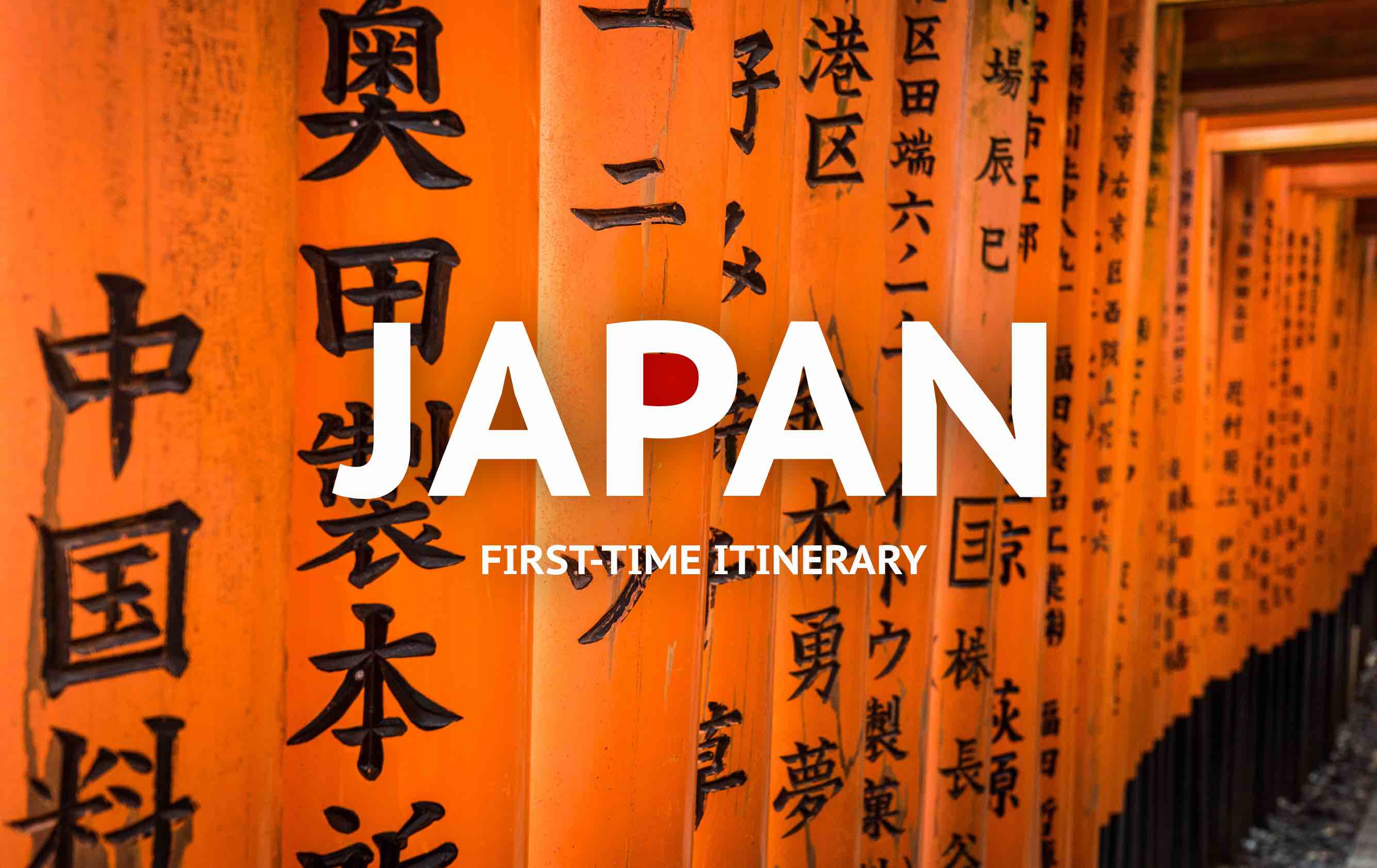
First time in Japan? Know where to go and let me help planning a memorable trip!
10 You can’t smoke everywhere.
Like in other places in Asia, smoking on the streets is forbidden . When you’re outside, make sure you go to a designated smoking area, usually next to big buildings, shops or train stations. Smoking outside these areas is extremely disrespectful and one of the biggest offenses you can do in Japan.
On the other hand, in some places smoking inside is allowed , such as bars, specific cars of bullet trains or even restaurants.
11 It’s an unique place to shop.
Let’s put it this way: there’s no shortage of ideas to buy cool souvenirs in Japan . Gadgets – particularly DSLR cameras or anything related to video games – are excellent buys too. And don’t miss a 100-yen store !
Shops worth going as a traveler 🛍️
- Don Quijote – the wackiest department store I’ve been. Anything you can imagine, from drones and gardening supplies to sweets and phone cases. Great place to find weird Kit-Kat flavors.
- Muji – house supplies and furniture with the slick and minimal Japanese style.
- Tokyu Hands – a more sophisticated version of Don Quijote, with the same random assortment of items.
- Bic Camera – massive department store dedicated to all sorts of electronics and gadgets.
- Super Potato – a heaven for lovers of retro games in the Akihabara district in Tokyo .
- Uniqlo – simple and slick clothing for men, women and kids. As a foreigner, you can apply for a direct VAT refund (8%).
12 Hold on to your garbage.
Japan is a SUPER clean country. And when I say clean, I mean immaculate (ok maybe apart from Osaka). Thus it’s counter-intuitive that such impeccable cities have so few trash cans. But it’s true – I found myself holding trash with me for hours before I found a place to put it.
This happens because there’s little garbage in the first place. When locals are walking, they don’t smoke or eat so there’s no need for bins. If you find yourself with the odd piece of paper or plastic, the quickest way to get rid of it is inside a convenience store.
13 Stay in a ryokan.
Heading back to the 17th century, when Japan was enclosed in the Edo period, ryokans are traditionally Japanese inns where guests sleep on tatami mats rolled onto the floor. Most ryokans serve a Japanese set breakfast and/or dinner and have communal bath facilities, including private onsen (hot spring baths) where you’re enter fully naked.
Staying in a ryokan for at least one night is a must-have experience in Japan . I stayed in charming Sumiyoshi Ryokan in Takayama and it was one of my most memorable experiences of the whole trip.
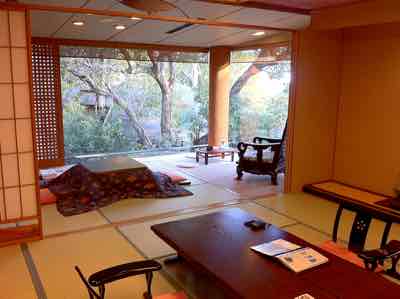
This pre-selection contains the best traditional ryokans with hot spring baths in the entire country.
14 Tattoos are not welcomed.
Across Japan, tattoos are strongly associated with criminal gangs like the Yakuza . Although this is (allegedly) changing with increasing tourism, foreigners with tattoos are not particularly welcomed by some. You can expect to be denied entry in some places, especially onsen (hot springs), saunas and pools.
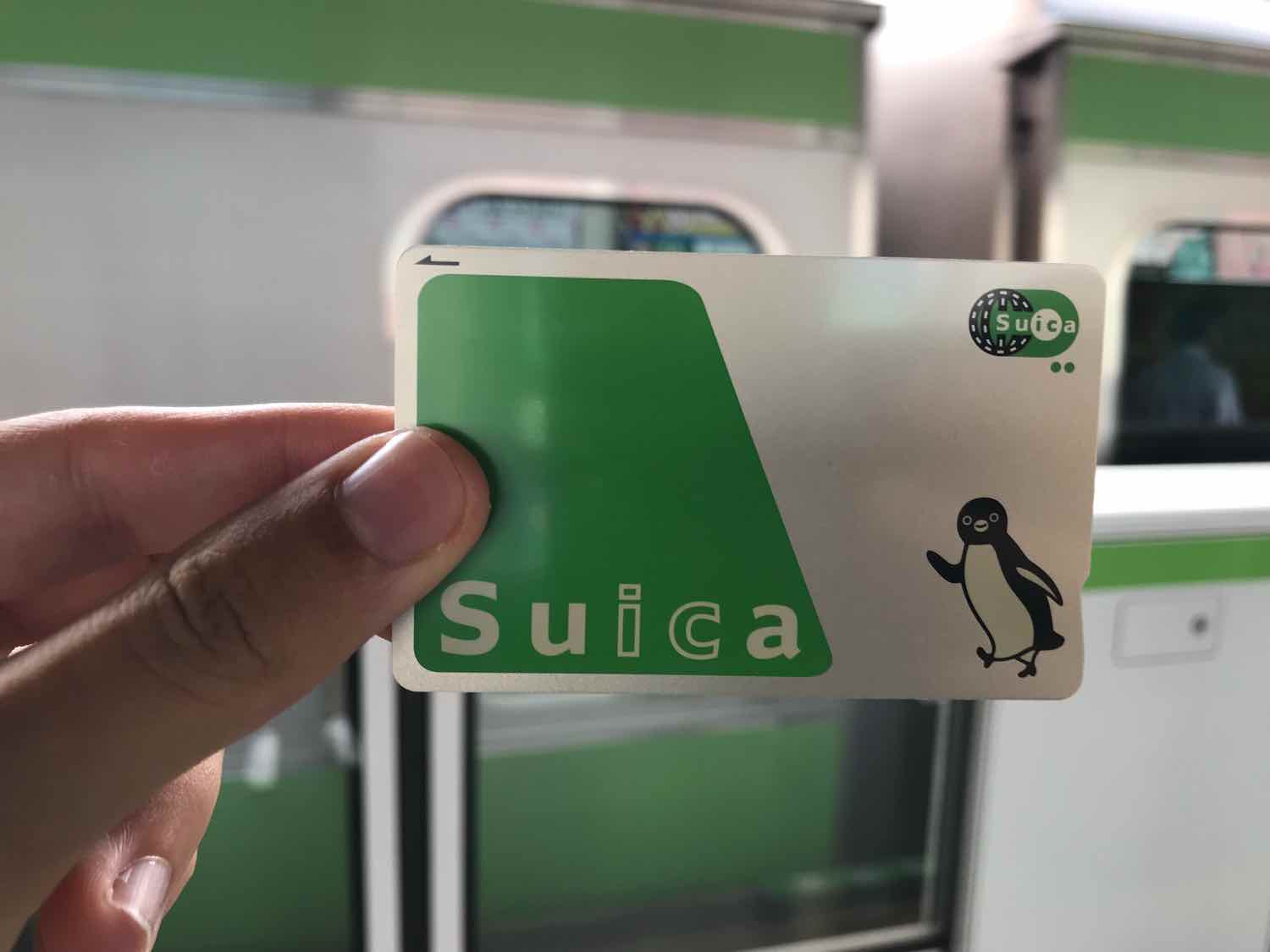
15 Get an IC Card.
IC cards like Suica, Pasmo and Icoca are the easiest way to pay not only for public transportation but for nearly everything in Japan. These work like prepaid rechargeable cards that work on convenience stores, vending machines and even game arcades.
- They also work in vending machines, convenience stores, and even some shops and restaurants, making it an effective debit card.
- If you’re traveling across Japan you can use your Suica card in other cities too. In 2013, the different systems were made compatible so you can use it as an additional debit card to pay for your travels.
- It works on your Apple Wallet and in fact you can add it and charge it even before you land in Japan.
Getting an IC Card
Even though physical IC cards are becoming less common, you can get yours at ticket machines and ticket counters of any major train or metro station in Japan. There is a refundable deposit of 500 yen. However the easiest would be the Wallet app in your phone. Simply add a new transportation card, charge it and you’re ready to go.
Using an IC Card
Once you have preloaded money onto your IC Card, the card works with a simple tap. In train stations, you’ll have to do it on the ticket gates on both the way in and out (fares are not fixed and depend on the length of the journey). You can check the remaining balance on your card as you pass through the gate.
Returning an IC Card
You can bring your physical IC card to a station attendant, who can return you ¥500 deposit and the remaining balance on your card. You can’t get your money back upon leaving Japan.
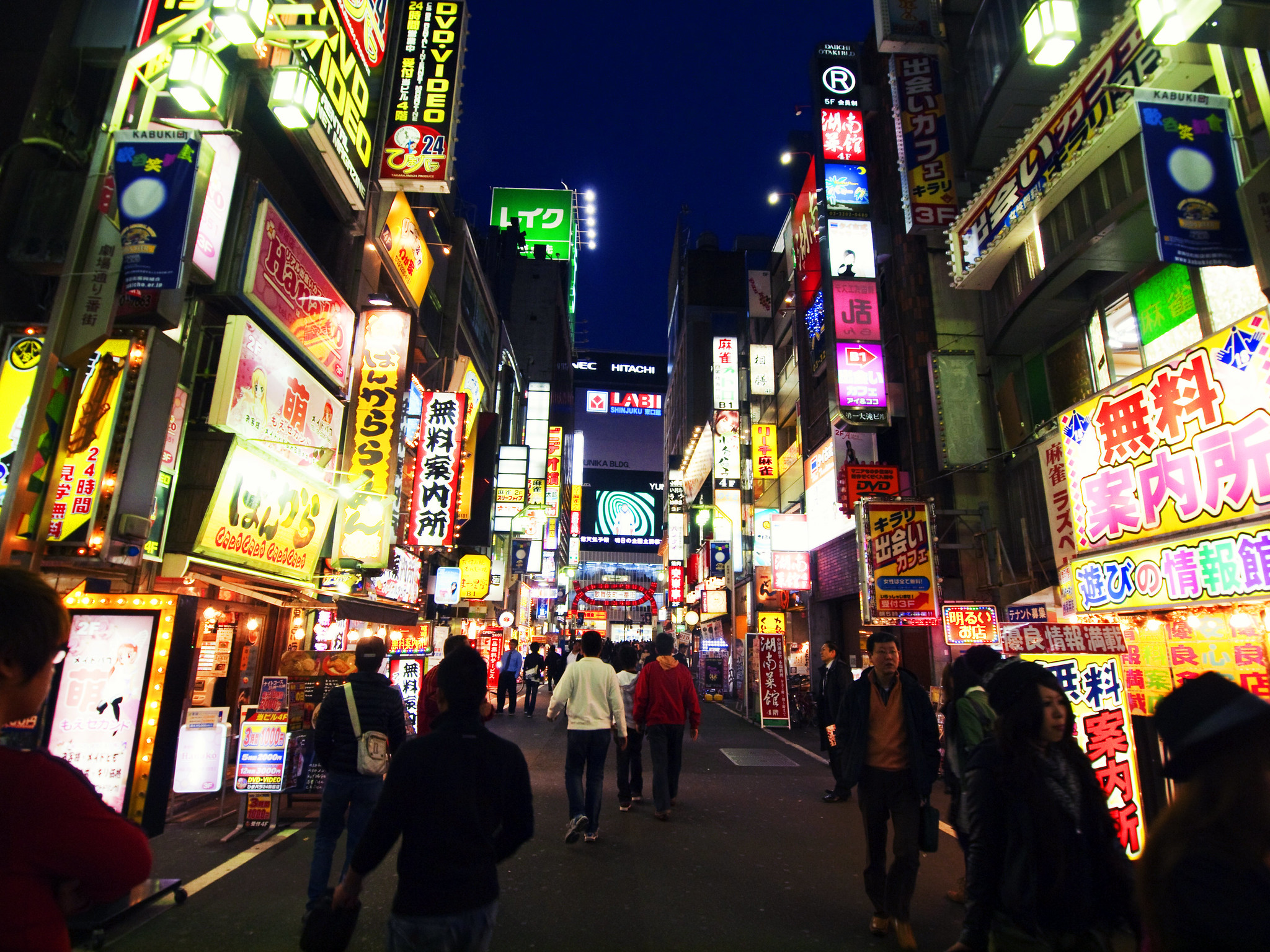
Explore the essential mobile apps when traveling Japan that set you up to a (even more) memorable time.
16 You won’t hear a no as an answer.
Japanese have a really hard time to say “no” to strangers. When you ask something, many times the answer is “no” but they will say “yes” anyway. This is a way for them to avoid offending people. 🤷
Keep this in mind when you ask something – look out for clues on nonsensical behavior or uneasy body language.
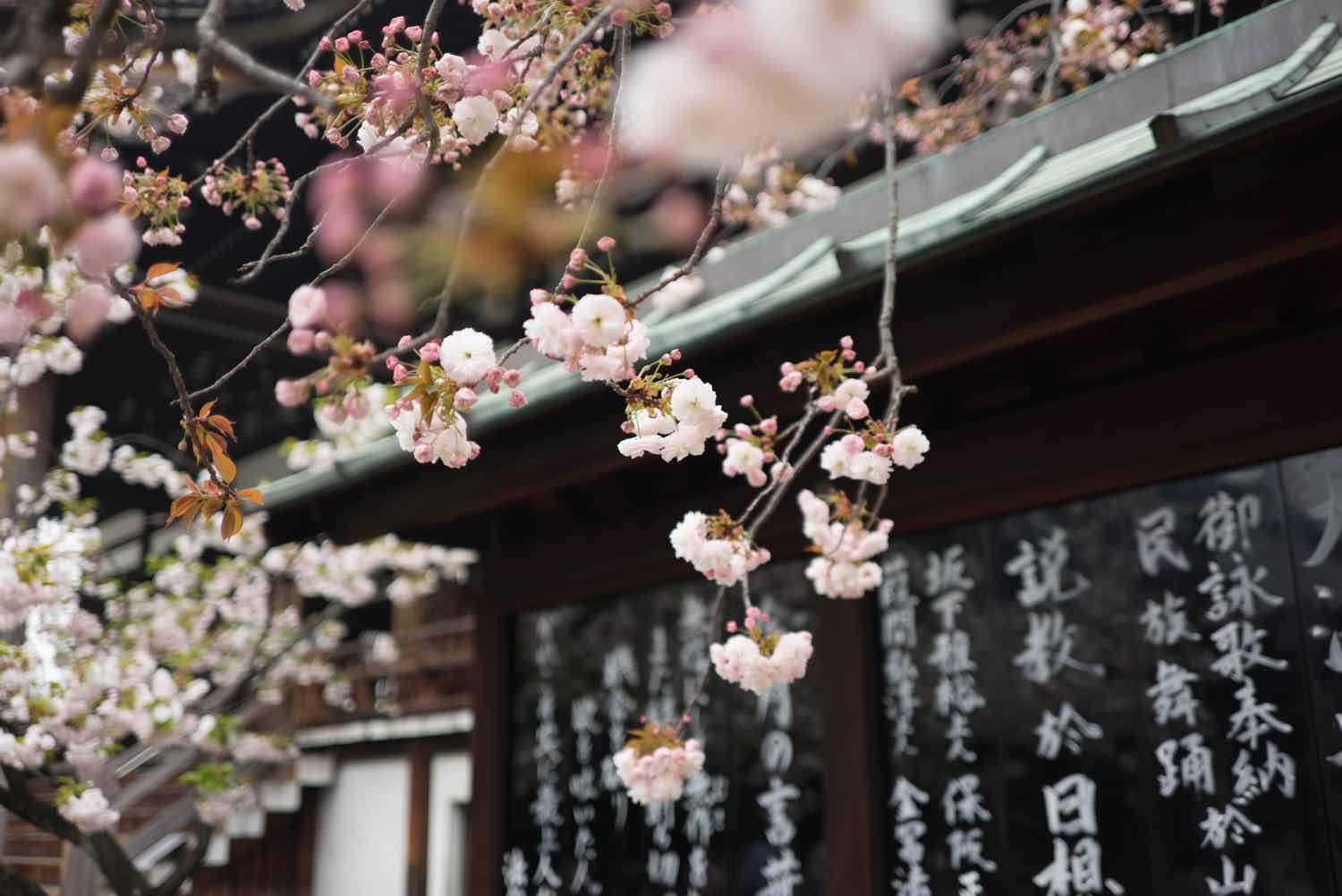
17 Almost any time is a good time to go.
In case you’re still deciding when to go to Japan , rest assured every season has something to wonder about.
The weather will obviously depend on where you’re going – the southern islands of Okinawa are very different from the northern tip of Hokkaido – but there’s a lot to see and do no matter when you go.
- Spring (March-June) : a magical season in Japan where flowers bloom and weather is neither too hot or cold. Prices can be (crazily) inflated in hanami season, when everyone goes crazy for the cherry blossoms all around the country.
- Summer (June-September) : brings out the hot sunny weather and the green foliage. Mount Fuji is open for hiking.
- Fall (September-December) : foliage acquires all sorts of colors of the rainbow. During this season, Kyoto is especially beautiful.
- Winter (December-March) : snow covers the highest lands, but in Tokyo there’s minimal rain and snow. Best time to visit the snow monkeys in Jigokudani .
18 Grab some food in an izakaya.
Work culture is intense in Japan. It’s common for people – particularly men – to devote their time, sweat and tears to their company, even more than to their families. And this doesn’t stop at 6. After work or even during weekends, they head to an izakaya , sort of a Japanese version of a gastropub, to drink and grab something to eat.
You can visit one of these tiny and cozy places too and have small dishes like yakitori made in front of you.
Best areas for izakayas in Tokyo 🍻
- Omoide Yokocho – this narrow alley near Shinjuku station is very popular amongst tourists.
- Ameyoko/Ameya Yokocho – located near Ueno station, it’s an open-air market style.
- Yurakucho – many cheap izakaya places right under the railway.
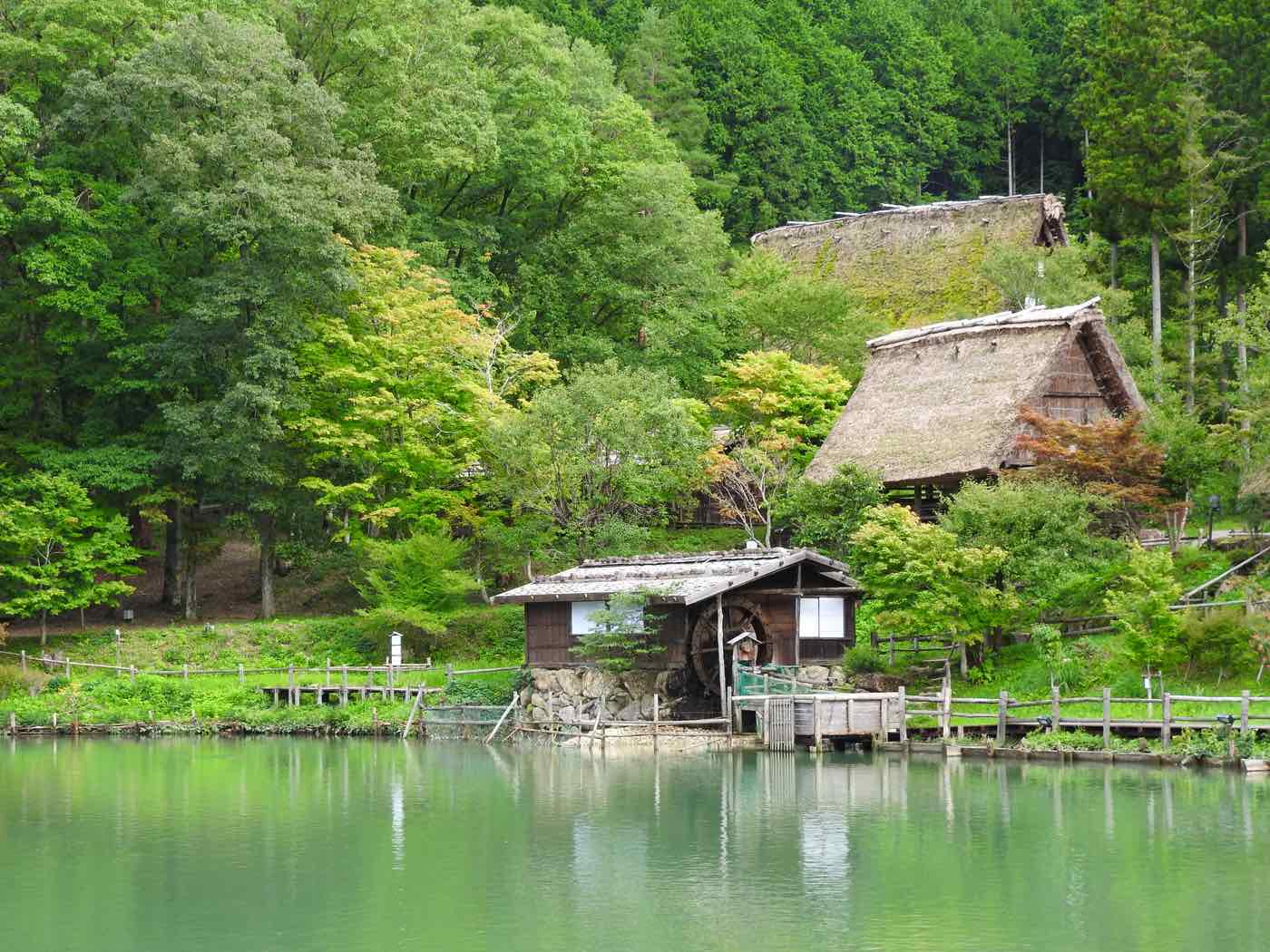
19 Venture out of the cities to find amazing nature.
When we think of Japan we normally think of futuristic tech, Blade Runner alleys, and massive skyscrapers. That certainly corresponds to the reality of the big cities.
What you might not be aware of is that 2/3 of the country is covered in forest. Nature – at least an orderly version of it – is highly appreciated and if you venture out a bit into remote Japan , you’ll find incredible waterfalls, monkeys, lakes, hiking trails, bears, and mountains.
Japanese people are extremely polite – that’s one of the foundations of their society – and bowing is the way to show respect when you meet someone. But this gets complex when you realize there are different types of bows depending on who you’re greeting.
- 30-degree bow (quick):
- 70-degree bow (quick):
- 90-degree bow (long): usually reserved for high authorities, like the CEO of a company or a president.
However, if you don’t feel confident to control this bowing technique, don’t worry. Japanese people are understanding and most likely you’ll get some chuckles.
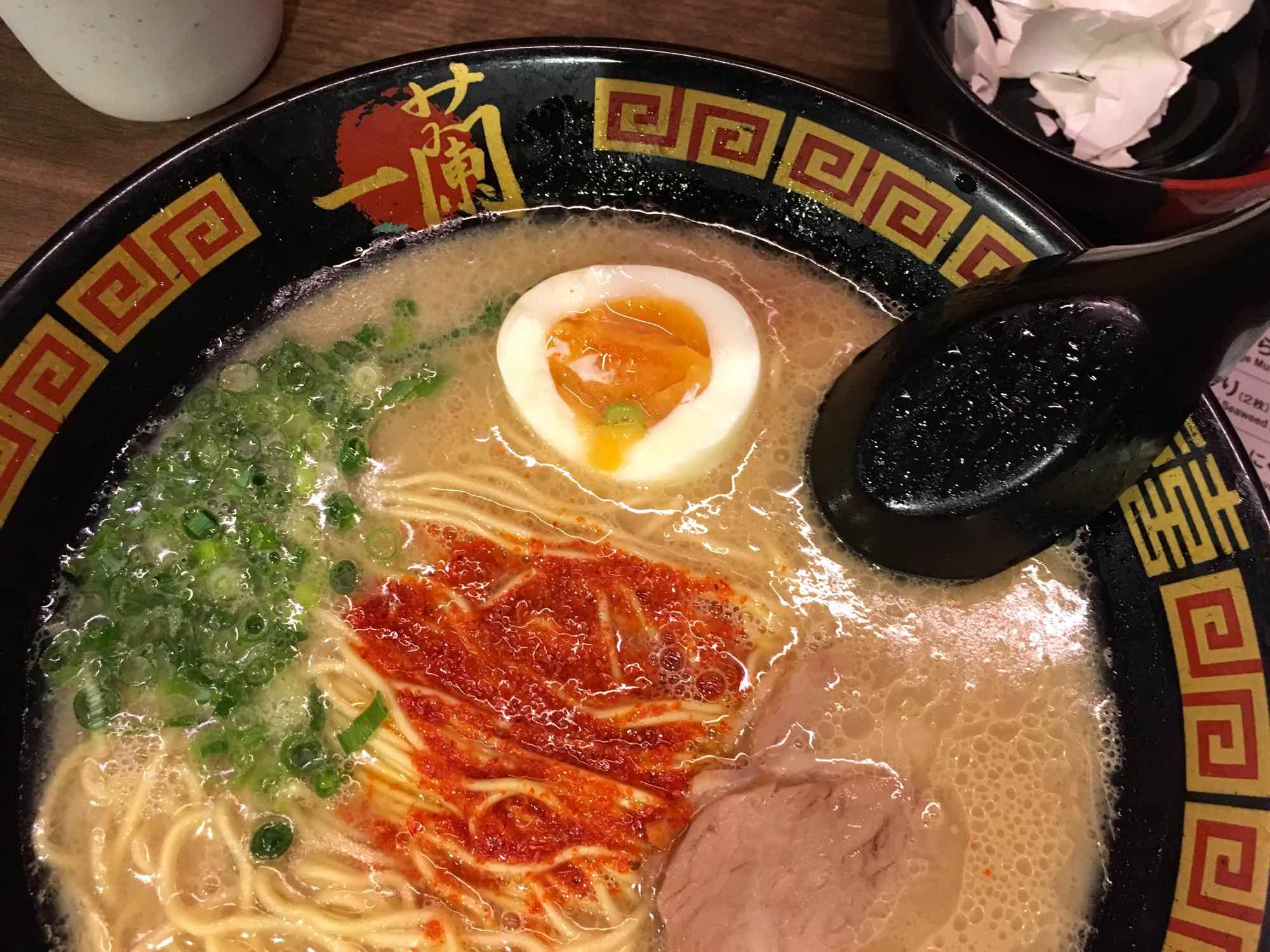
21 The best ramen of your life is here.
I’m not the biggest fan of ramen , but if I had to describe it in Japan it would be: OH MY GAWD. The depth of flavor of ramen in Japan is unlike anything I’ve tasted before and now I get why it’s considered to be the ultimate comfort food.
There are over 200,000 (!) ramen places across Japan and every single one of them is perfect to go for dinner after a cold day traveling around. It’s a hearty and very affordable meal – very rarely surpassing 1000 yen per bowl.
I could recommend many different places to eat ramen in Japan , but from an experience perspective, try Ichiran . It’s a chain present in Kyoto , Fukuoka , Tokyo , and now even New York City and Hong Kong too.
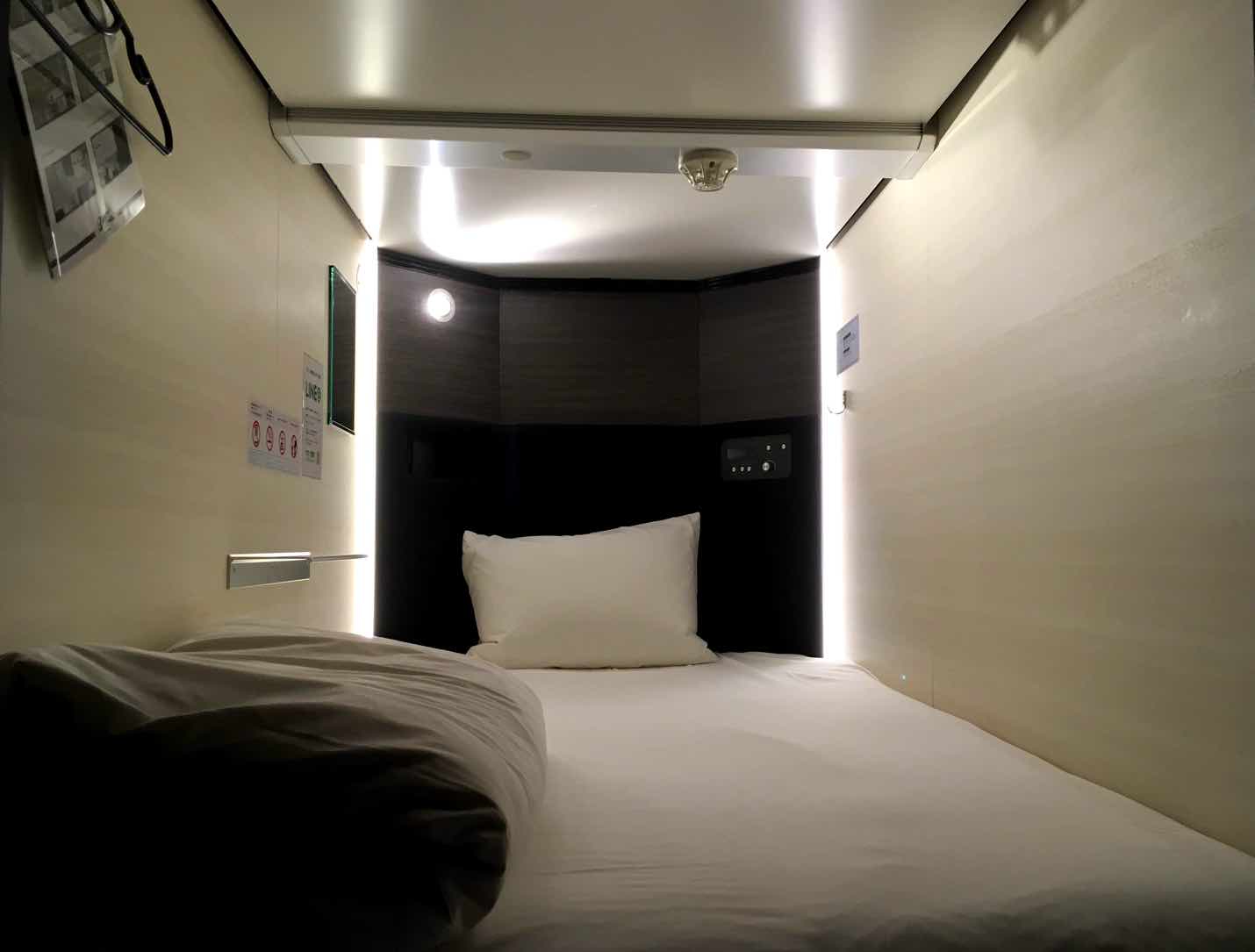
22 A Japan trip won’t necessarily break your budget.
A top concern for many travelers going to Japan : the budget. Well, I have to say I was surprised with how inexpensive it can be!
Entrance fees to attractions are rarely prohibitive. Passes can reduce the cost of public transportation. For every expensive restaurant, there are 10 low-cost ramen and ikazaya spots. And for the ultra-budget traveler, food in convenience stores is actually much better than you think.
Flights and accommodation will likely take the biggest chunk of your budget.
But there are workarounds in that department too. Guesthouses with futon beds are cheaper and the unique capsule hotels are all across Japan . The latter can be a problem for the more claustrophobic, but with TV, earbuds, air conditioning and a full kit with PJs, toothbrush, towels, and slippers, it can actually be a very comfy night.
I stayed in a capsule hotel in Tokyo and turned out to be a fun and memorable experience for under $30/night. Highly recommend it!

More than a budget saver, staying in a capsule hotel is an experience . The best capsule hotel experiences in Japan are in this list.
23 Learn the basic etiquette and customs.
I can’t stress how important politeness and an orderly way of behaving is to Japanese people. And this is only the tip of the iceberg as regards to their fascinating unique culture.
Some of the things that are a big no-no in Japan are:
What you should not do in Japan 🙅
- Eating in the streets (do it inside the stores or restaurants)
- Smoking in the streets outside the designated areas
- Taking photos of people
- Pointing at people or things
- Speaking loud outside, including in public transportation (although in Osaka this didn’t seem to be an issue)
- Saying “no” aggressively or abruptly
- Entering someone’s house with shoes on (sometimes applies to guesthouses and restaurants too!)
If you wish to know more, I recommend reading a book. I devoured Hitching Rides With Buddha and A Geek In Japan – both written by expats in the country – during my trip and it definitely helped to gain a lot of insider knowledge on Japanese culture.
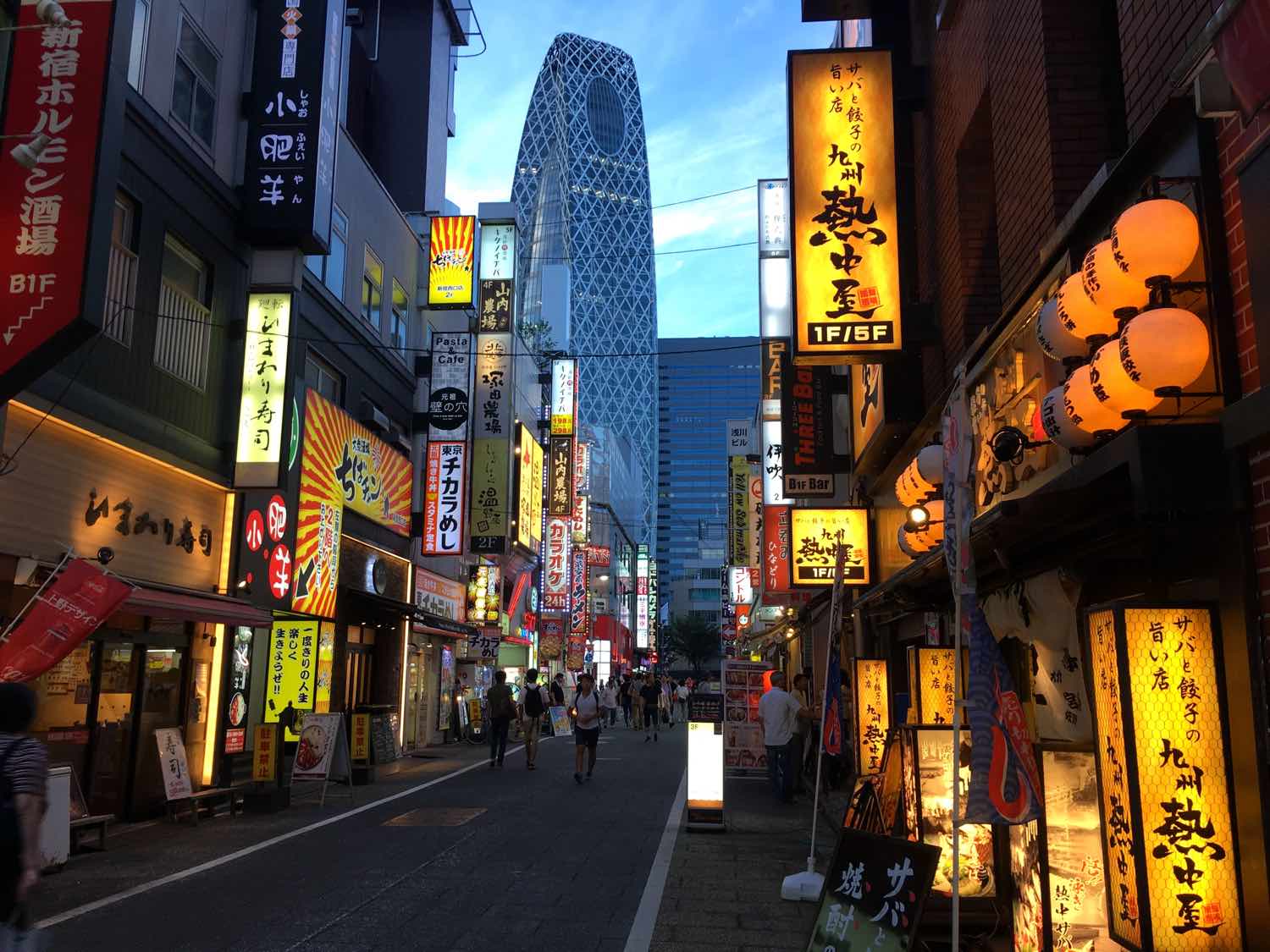
24 Cities are incredibly crowded…
… but efficient. Despite being the largest and more populous city in the world, Tokyo is so well connected that it doesn’t feel that big. The train network is excellent, led by the circle JR Yamamote Line which stops at every main area of the city.
Masses move quickly and everything is designed to flow as efficient as possible. So make sure you go with that flow. When awaiting your train, queue up next to one of the doors. Check which carriage it’s closer to the exit you want to take. When riding escalators, stand on the right (except in Osaka where for some reason you should stand on the left).
I used Citymapper to help me get around. Bottom line is don’t even think about renting a car in Tokyo , it’s not needed at all.
Find a deal in Tokyo, Japan!
25 you can get away with english..
Even though it won’t look like it, Japanese are good in English. They can understand almost anything you say, but they’re usually too shy to answer back because their domain of the language is not perfect. To increase your chances of getting an answer, smile, be polite and speak slowly.
That said, the above is true for big cities like Kyoto , Tokyo , and Osaka , where it’s common to find menu and signs in English. If you explore other more remote areas of the country, don’t be surprised by the lack of any translations in signs and menus. This is where the next tip becomes even more important.
26 Learn some basic Japanese words.
Regardless of where you go, I always suggest learning a few words in the local language when you travel. It’s fun and it can really go a long way!
In a country where respect and etiquette are so important, learning some Japanese is even more important. It may be overwhelming at first to look at the symbols, but the good thing about Japanese is that sounds exactly the way it’s written in Rōmaji (Latin alphabet version).
Here’s some important words and expressions I’ve used:
Basic Japanese for travelers 🗣
- 🗣 Hello – こんにちわ (konnichiwa)
- 🗣 Yes – はい (hai)
- 🗣 No – いいえ (iie) – hardly used.
- 🗣 Thank you (close friends) – ありがとう (arigatō, for close friends)
- 🗣 Thank you (everyone else) – ありがとうございます (arigatō gozaimasu)
- 🗣 Please – ください (kudasai)
- 🗣 Excuse me/Sorry – すみません (sumimasen)<
27 Explore the underground world.
I consider myself to have a strong sense of direction and I rarely get lost. Still, I’ve got lost several times in the underground malls in both Tokyo and Osaka. They link each subway station to the next via DOZENS of restaurants, shops, and different exits to the surface.
Department stores are another world to explore. Even if you’re not in the mood for a shopping spree, head to the ground floor or basement – depachika – to find very good quality restaurants at affordable prices. Easy meals for those in a budget.
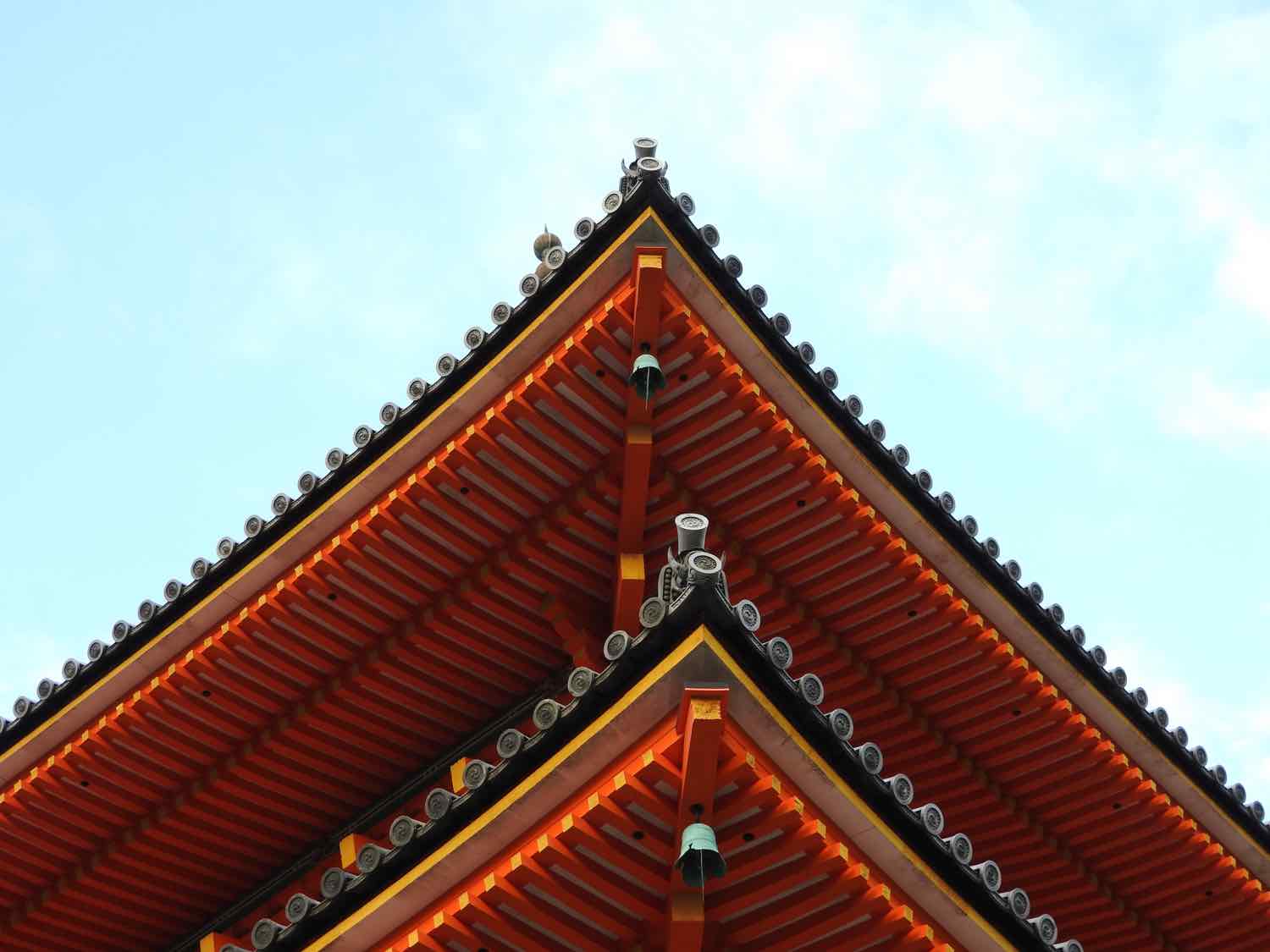
28 You can get templed out.
Despite being architectural wonders and spiritual landmarks, Japanese temples and shrines are like churches and cathedrals in Europe – after a while, they will all start to look the same. If you don’t know anything about Buddhism, all the statues, shrines, and temples will look dull.
But I don’t want to sound too uncultured, so I will also say that it depends on your knowledge of Japanese culture and religion. Once you dig into it a bit – more than travel guides, I recommend reading a book! – visiting a temple will be fascinating and the longer it will take to get bored.
For standard travelers though and especially in Japan’s ancient capital, Kyoto – which alone has over 1,600 temples – it’s easy to get “templed out” so study the places to visit beforehand .
29 It’s safe.
Japan is one of the safest countries in the world, where people go out of their way to avoid any kind of conflict or upset. It’s one of those places you can leave your laptop or phone on the table when you’re going to the WC.
Stemming from Shinto beliefs, Japanese people believe physical objects carry a part of the spirit of the owner, so they don’t have much interest in stealing it from you.
The country is so safe we, as travelers, face the opposite problem: for locals, every gaijin (foreigner) can potentially be dangerous! There’s a barrier to overcome before Japanese trust a foreigner completely.
30 Make use of luggage forwarding services.
One thing you’ll quickly understand in Japan is that for every problem there is a solution. So for instance, if you decide to bring one of those massive bags or trolleys, let me tell you it won’t be easy to navigate the public transportation system.
That’s why they invented Yamato . This luggage-forwarding service available at many hotels or convenience stores (again, mega convenient) works like a parcel delivery, taking your bags to another hotel or city in Japan . It’s not that expensive and can save you a lot of hassle.
An alternative is the train station lockers (that I used a lot). For about 500-700 yen/day, you can store a large bag. These were particularly useful when we had to check-out in the morning but didn’t want to carry our luggage for the rest of the day.
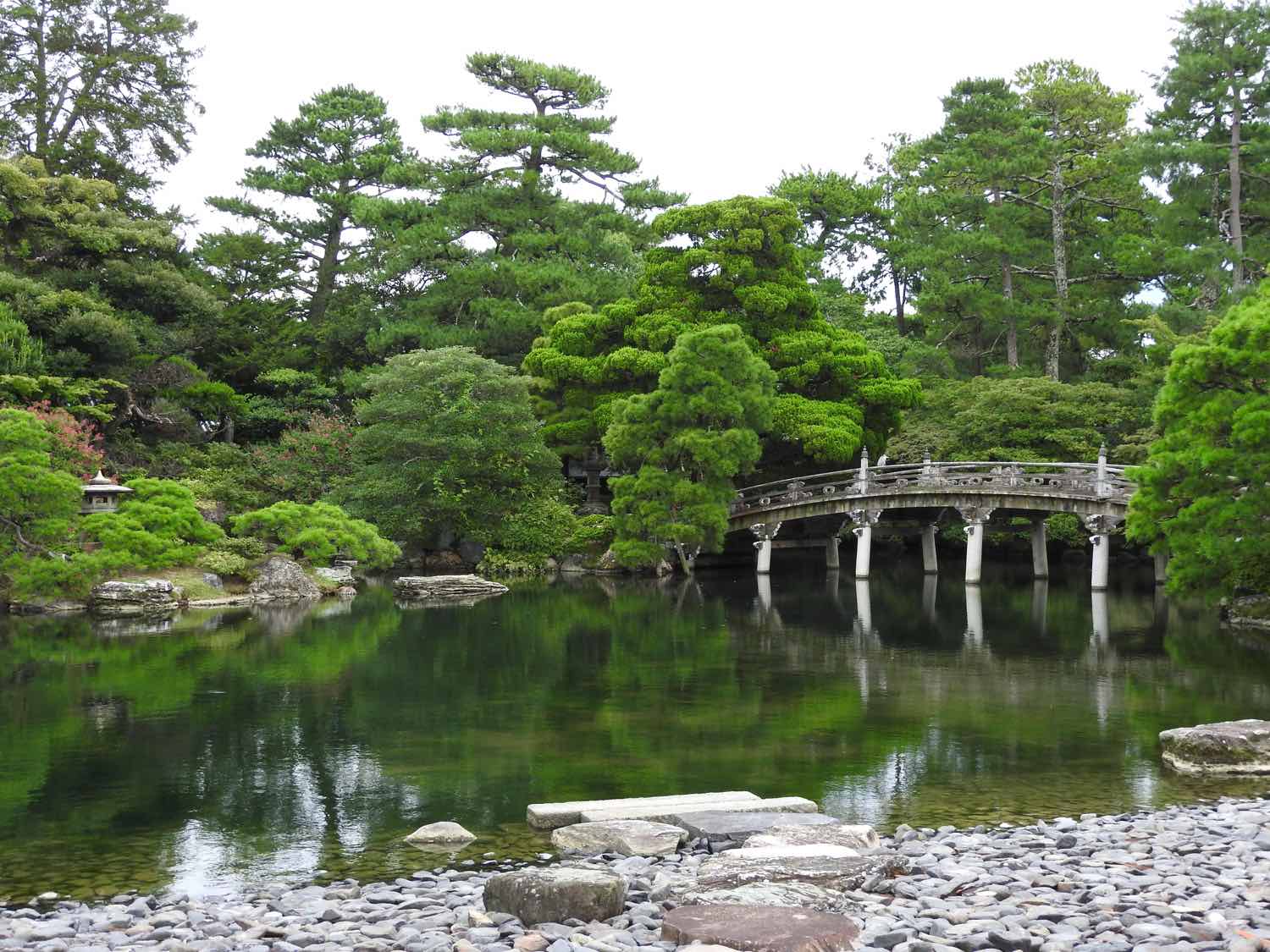
31 Japanese gardens are something else.
The best compliment I can give gardens in Japan is that every garden I go seems like a subpar experience now. But you must be wondering – what the heck, aren’t gardens in the world all the same? No.
There is a zen feeling when you visit a Japanese garden. No rock is out of place. Everything makes sense and is beautiful from every angle or perspective.
Japanese gardens are planned thoroughly from the start and need to follow 6 features to produce true beauty. These are grouped into contrasting pairs: spaciousness & seclusion, artifice & antiquity, water flow & panorama. Don’t miss one.
32 Get lost in a 100-yen store.
One of the most fun and budget-friendly activities you can do on a gloomy day. Head to a 100-yen store like Daiso – you’ve guessed it – everything costs 100 yen! It’s a golden opportunity to dive in into the wackiest products you can think of, as well as cute souvenirs or interesting items for a bargain.
Amongst the absolutely random items I’ve bought there is a couple of miso soup bowls, kitchen glass paper, cable holders, insoles for my sports shoes, and chopsticks with intricate designs.
33 Think twice before going to an animal café.
Full disclosure here: I have been to animal cafés. These are very tempting in Japan as you can find cafés with many different animals – owls, porcupines, bunnies and even otters and what can I say, I have a sweet spot for cats. But I don’t recommend it.
Not only it was a deflating experience but also most of these places are authentic petting zoos where the animals are constantly being picked up for selfies, pets, and even drugged to behave. Do your research beforehand. If the animals are not up for adoption it’s usually a red flag.
34 Going to the toilet is a life-changing experience.
Germophobics will like this one. Public toilets can be a nightmare for some in the West… but not here! Japanese people take cleanliness very seriously anywhere so toilets are as germ-free and comfortable as you never seen before.
Oh and expect technology too. Even in the tiniest restaurants of the more remote places, expect a keypad with different functions. From seat heating to extra sounds for privacy (usually ambiance music or waterfalls).
- おしり (oshiri) – releases a spray of water
- ビデ (bidet) – same as oshiri , but for women
- 乾燥 (kansou) – releases a burst of air
- 小 – tiny flush
- 大 – big flush
Note: in some (rare) bathrooms the toilet paper has to be purchased from a vending machine before you go in.
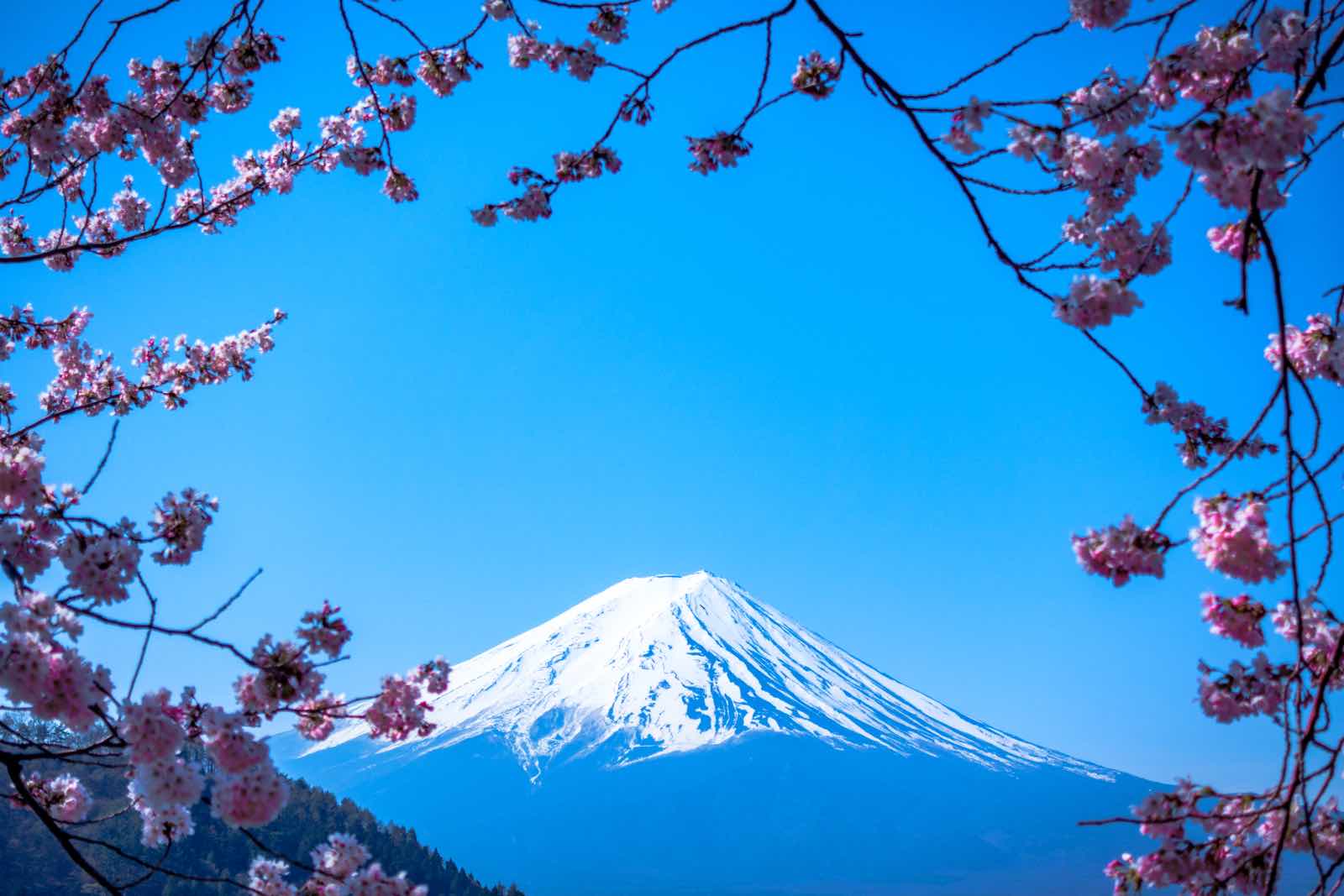
Which other Japan travel tips do you think are important and that a traveler should know? Let me know in the comments 👇
You might also like these articles 💬
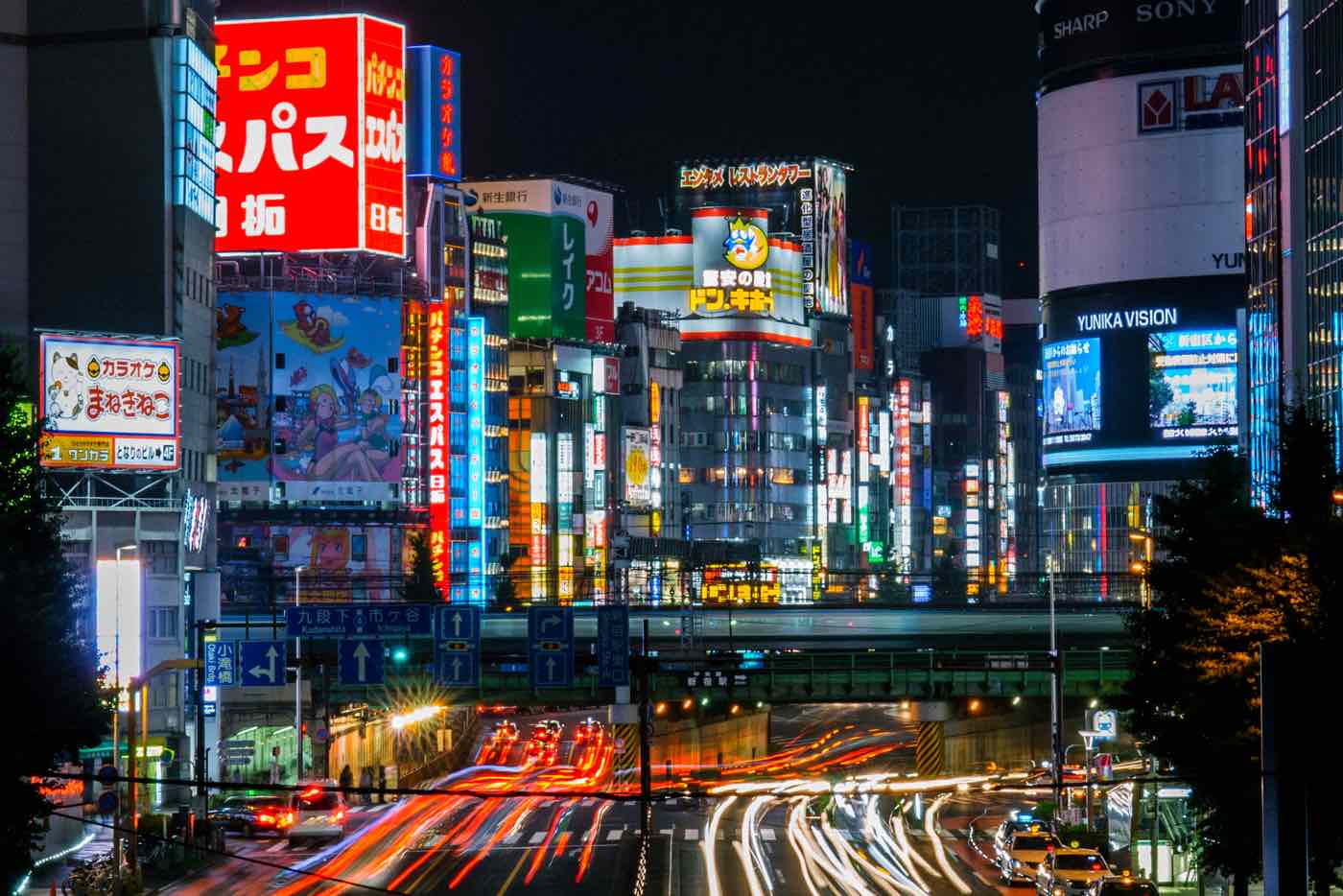
Most Useful Japan Travel Apps in 2024
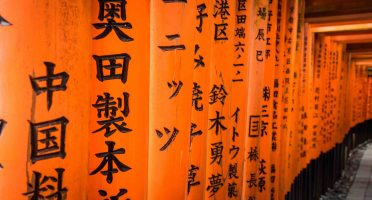
Japan Two Week Itinerary: The Best of Japan!

Travel Guide to Bohol, Philippines – Budget & Itinerary
Share your thoughts 💬 cancel reply.
Your email address will not be published. Required fields are marked *
25 comments 💬
Will I get the veg food in Yokohama?
This is really helpful! I’m planning a trip to Japan aimed for March of 2021 and I’m doing as much research as I can. I’ve been surprised to find how inexpensive a lot of the aspects are and I’m currently trying to learn as many phrases and words as I can. This really helped me get an idea on where I should stay!
Japanese language things to know is the national language is Japanese,which is the primary spoken language across the country included Japan.Borrowed ideas from other countries are infused with existing customs to become something distinctly Japanese.Many visitors from abroad say that Japan is a beautiful country.Come visit Japan and experience these beautiful aspects of this country.Some students are attracted by Japan’s high educational standards, while for others the attraction is Japan’s rich cultural heritage.Beauty of Japan is a young and dynamic travel agency with a deep passion and love of Japan.Japanese is the official and primary language of Japan.Japanese is the official language.Some English is spoken in Tokyo,Japan and other large cities but is less usual in rural areas.There are many regional dialects and there are distinct differences in the intonation and pronunciation between eastern and western Japan.Japanese manners and customs are vastly different from those of westerner people.Japanese are self disciplines so thoughtful about themselves as Japanese is friendly more humbled personality;they know all standard Japanese version to study so well aboard work hard elegantly this years?
Beginning to research our upcoming 2020 Feb. Japan trip on my break times at a hospital I work overnight at & on my days off. My wife & I find the tips/ content of “geekyexplorer.com” very straight forward & easy to assimilate into our first trip to Japan. Good decent advice. Highly recommended site to glean travel info about a country for a first time traveller to Japan.
Really well detailed and helpful article. Could you please also give us some tips on which airport to go to as well as traveling to and from the airport. Thank you.
I suggest an open-jaw ticket. E.g. fly to Tokyo and get back from Osaka. This way you’ll be saving a train ride. There are frequent trains from any airport to the city center. If you want the quickest way in Tokyo, take the Narita Express.
I’m a Japanese highschool student. I read this article and I was so amazed!!
You often make better explanations than we Japanese do lol.
I hope the number of this kinds of blogs will increse and help tourists to Japan. Thank you so much!!
Yaay local approval is great. Thank you!! 🙂
Very nice article and well explained. Any recommendations for honeymooners?
Not really, Japan can be a very romantic place by itself. 😉
Amazing blog. I got all the details required to plan a trip.
Yay, great to know 🙂
Awesome article with awesome pictures. this information is very helpful for us to visit and stay in Japan. I will surely visit Japan. Thanks for the article.
You welcome Kanika, any solid plans for your trip?
Nice article with the beautiful pic. This information very helpful for us. Thank you for sharing…!!!
Nice post! Thanks for sharing!
Thanks for passing by Anna.
OMG this is so useful! I’m trying to organize my solo travel to Japan and needed such tips. Thank you a lot.
Let me know how it goes, traveling solo in Japan is gotta be fun!
Nice post, love how detailed you are in your tips. I will go on a trip to Japan next year with wife and kids and this is exactly what I needed to get me started. Thank you!
Thanks for passing by Adam!
Such an amazing Blog, i visited your blog first time and now i bookmarked it 🙂 because your many Blog are very informative for me even for us. Thank you for sharing
Thank you Ava!
A superb article with a very helpful information which really help all travellers who want to go to the japan. Nicely done everything. Keep it up the best work.
Thank you Dipak, thanks for passing by.

Destinations🌎


The Ultimate Japan Itinerary for First-Timers: From 1 to 3 Weeks

I’ve yet to meet a traveler who didn’t love their time in Japan . It’s just one of those countries that everyone loves. How can you not? The food is carefully crafted and delicious; the history and culture are both rich and long; the landscape breathtaking; and the people super friendly and polite.
Japan remains one of my favorite countries. No matter how long I visit, it’s never enough. I always leave wanting more.
But the country always seems forbidding to many travelers. It definitely still has that “exotic” stereotype that makes people think it’s hard to travel around.
Where should you go? What should you include in your Japan itinerary? Should you buy a JR Pass to help you get around?
To help you out, here are a few suggested itineraries based on my years of visiting that will ensure you see the best sites on your Japan trip — as well as get off the beaten path and get a real sense of Japanese culture!
Table of Contents
Japan Itinerary: Know Before You Go
Japan itinerary: one week, japan itinerary: two weeks, japan itinerary: three weeks.

Just be sure to get one BEFORE you go as you cannot purchase them on arrival. For more information on the pass, including how much they cost and how you can get one, read this blog post . It has everything you need to know!
Mobile Data in Japan In Japan, English isn’t widely spoken (especially outside of the major cities) so having access to the internet is vital for checking addresses, using translation apps, and looking up things to see and do. The easiest way to get data is through an international eSIM for Japan .
An eSIM allows you to access mobile data via a QR code so you can have internet wherever you are, without worrying about physical SIM cards or roaming charges. This will save you a lot of time and hassle when using apps like Google Maps, Google Translate, Instagram, and YouTube. It will also come in handy for checking menus at restaurants (since they are rarely in english).

Day 1 & 2: Tokyo Chances are you’ll be starting your trip in Tokyo , since it’s home to the country’s biggest international airport. If your trip is seven days long, activate your JR Pass right away, so that you can take advantage of the free JR trains that run through the city.
While you could easily spend your entire week in Tokyo and not get bored, here are some of the highlights:
Visit the fish market – In 2018, Tokyo’s main fish market moved to Toyosu, which is twice the size of the old one, Tsukiji, making it the largest in the world. While a lot of good restaurants moved too (Sushi Dai being the most famous), I find the place itself very stale, since you can no longer wander the floor (you look down via a walkway above; you also need a visitor’s pass to enter).
The old outer market in Tsukiji is still great though, and you can still find food and stores there too. You can wander alone and just eat and shop until you can’t anymore! Most businesses open at 6am, so it’s a perfect place to go in the morning when you wake up early because of jet lag. Food and drink tours of the Tsukiji Outer Market are available for around 13,500 JPY.
See Sensoji Temple – Sensoji is beautifully painted and sits in a scenic spot near a five-story pagoda and the famous Kaminari Gate. There’s a huge statue of Kannon, the goddess of mercy, inside the main hall. It’s always busy but is worth seeing with your own eyes. The temple is free to visit.
Drink in Golden Gai – This alleyway of back-street bars is a lively place to drink at night and has a bit of a red-light-district feel to it. It is not to be missed. Even if you don’t drink, be sure to wander about. Arigato Tours offers tours of the area where you’ll learn about the neighborhood while stopping to sample Japanese classics like sushi, yakitori, and ramen. Tours are 23,900 JPY and include a drink and dishes at four food stops.
Visit the Imperial Palace – When the emperor moved from Kyoto to Tokyo in 1869, he took Edo for his new residence and renamed it Tokyo. Though you can’t go inside (or get very close), the building is amazing. It is surrounded by lovely grounds and a park, and there’s a moat around the stone walls. You can also see the changing of the guard, though it’s a relatively low-key and unassuming ceremony.
Watch a sumo match – Kokugikan, Japan’s most famous sumo arena, hosts tournaments three times each year. The wrestling that we see today dates to the 17th century, though its origins go back even further, and it’s still one of the most popular traditions in the country. If you’re in town at the right time, this is a must-do! Tickets sell out quickly, so act fast. You can book a ticket online here (you’ll be accompanied by a guide too, so you can learn more about the tradition as it unfolds before your eyes).
If you have more time, consider taking a day trip to Kamakura to see the giant Buddha statue (Daibutsu). It is over 13 meters (42 feet) tall and dates back to the 13th century. The journey is around 90 minutes each way — and free with the JR Pass !
For delicious food, some of my favorite bars and restaurants include: Uogashi Nihon-Ichi (Standing Sushi Bar), Nemuro Hanamaru KITTE Marunouchi, Motodane, Tokyo Whisky Library, Ichiran Shibuya, and Uohama.
WHERE TO STAY IN TOKYO : Hostel Chapter Two – A small, family-run hostel not far from Skytree Station in Asakusa. I really like the shared kitchen and common room, as there’s a real social feel to them.

With its beauty come lots of crowds though, so try to visit outside of the busy summer months. Even with lots of tourists, though, the city is still magnificent and has a lot to offer. Some things to see and do that you shouldn’t miss are the following:
Visit the Golden Pavilion – This famous (and picturesque) temple dates to the 1950s, when a monk burned down the previous temple (from the 14th century) while trying to commit suicide. It’s a UNESCO World Heritage Site and one of the most-visited destinations in the country!
Explore Gion – Gion, the historic geisha district, is renowned as being one of the most iconic and atmospheric areas of town. It’s known for its traditional wooden machiya houses, narrow alleyways, cobblestone streets, and preservation of geisha (known locally as geiko) culture. Lining the main street are ochayas (teahouses where geishas entertain), small shops, and many restaurants, ranging from upscale kaiseki restaurants serving traditional Kyoto cuisine to casual eateries.
To really learn more about this amazing party of town and its past, take a walking tour of Gion . You’ll learn a ton and get a lot of context. They cost around 1,800 JPY.
Wander in the Bamboo Forest – For a relaxing break, head to Arashiyama and let the dense and towering stands of bamboo envelop you. Located near the famous Tenryu-ji temple, it’s one of the most beautiful places in the entire country. It’s not that big, but there are some hidden areas to explore. Just make sure to arrive early if you want to enjoy it without the crowds (it fills up fast after sunrise).
While there, I would also recommend visiting the Okochi Sanso Garden, which (along with the home) belonged to the famous Japanese actor Denjir? ?k?chi (1898–1962). It’s not free (it’s 1,000 JPY), but it’s really nice and has some wonderful views.
Admire Ryoan-ji temple – This is my favorite temple in Kyoto. Originally established in 1450 as a residence for a high-ranking samurai, it was soon converted into a Zen temple and is now a UNESCO World Heritage Site, with a mausoleum that houses the remains of seven emperors. Its traditional rock and sand garden is considered one of the best in the country. There’s also a teahouse where you can experience the traditional Japanese tea ceremony ( chanoyu ) as you overlook the Kyoyochi reflecting pool.
Wander the Nishiki Market Nishiki Ichiba is now one of the biggest indoor markets in town. Known as “Kyoto’s Kitchen” and spanning over five blocks, it is full of vendors selling traditional dishes from the region, classic Kyoto souvenirs, and really just about anything else. There are over a hundred stalls here, many of which have been in the same family for generations. Opening hours depend on the shop but are typically from 9am to 6pm.
To dive deeper into Japanese food culture, you can take a food tour of the market . It’s the best way to learn about all the food you’ll see, as well as the market’s history.
For a half-day trip, you can also visit Nara. It’s a small city just one hour from Kyoto. Nara was the capital of Japan in the eighth century, so there are lots of buildings and temples here that are upwards of a thousand years old (which is rare in Japan, due to fires, as well as World War II). But the real draw in Nara are the deer.
Since the 17th century, those in and around the city have been considered sacred. You can buy crackers to feed them or just watch them stroll around carefree. A guided half-day walking tour that includes all of Nara’s highlights as well as a traditional lunch is 11,500 JPY.
While you’re here, don’t miss a visit to Todai-ji. It’s the world’s largest wooden building and is home to a 16-meter (52-foot) Buddha statue. It was built in 738 CE and is now a UNESCO World Heritage Site. Admission is 600 JPY.
WHERE TO STAY IN KYOTO : Backpacker Hostel K’s House – A fun, social backpacker hostel in a great central location. The rooftop terrace is a cool spot to hangout and meet other travelers after a day of exploring.

Don’t miss Osaka Castle though. While it’s not the original (this version dates to 1931), it’s nevertheless an impressive sight. It’s home to a small but insightful museum and an observation deck that offers some picturesque city views.
And be sure to stroll down Dotonbori (ideally at night), the main street, which is lined with restaurants, stores, and tons of neon lights and signs. A guided walking tour that includes Dotonbori as well adjacent neighborhoods is 6,500 JPY.

Today, Hiroshima is thriving . Don’t miss the Atomic Bomb Museum, which depicts the history of the city before and after that fateful day. It has photos, artifacts, videos, and information about the effect of radiation on the population. It’s a sobering experience but one that should not be missed.
If you feel like getting out of town afterward, head to Miyajima , an island that offers a place to hike and enjoy nature. You can also take a cable car to the peak of the mountain to take in the view. A one-way ferry ride to the island takes 10 minutes and is free to JR Pass holders.
WHERE TO STAY IN HIROSHIMA : Roku Hostel – A cozy, small hostel with a rustic atmosphere and design. It feels like you’re staying with a friend here, and the beds are super comfy too.

If you like history, don’t miss the Hida Minzoku Mura Folk Village, home to a collection of traditional thatch-roof houses that you can enter to further immerse yourself in the country’s past.
This city (and region, really) is famous for its Hida beef, a high-fat variety that’s even better than any A5 Wagyu you might have. It just melts in your mouth. Be sure to have some while you are here!
The Japanese Alps are not far from here as well, so if you love hiking and want to extend your time in the region, head to Kamikochi for a day hike or overnight trip. It’s just an hour away and has both easy and moderate trails, which are open from April to November. Hiking trails can also be found in Hakusan National Park (also just one hour away by car).

One of the more unique temples in Japan is here too: Ninja (Myoryuji) Temple. While the temple wasn’t home to actual ninjas, Myoryuji was built as a defensive structure (strict laws forbade local lords from building defenses, so they were hidden in the temple to circumvent the rules). These include hidden rooms, secret tunnels, and a maze of staircases and halls to confuse enemies.
If you need a break from exploring cities, Hakusan National Park, home to Mount Haku, one of the three holy mountains, is just an hour south of town.

If you’re here in April, there are incredible cherry blossom displays that are famous in the region. And, just like Takayama, Matsumoto is close to the Japanese Alps, so you’re just a stone’s throw from some of the best hiking in the country.

There are tons of hotels (both modern and traditional) that have their own hot springs (often both indoors and outdoors). It’s the perfect place to wrap up a trip, relax, and take in the views.
In addition to getting a copious amount of R&R, be sure to ride the cable car up the mountain for even more amazing views. The area is surrounded by craters from an inactive volcano that erupted 80,000 years ago (not to be confused with nearby Mount Fuji, which is an active volcano), and you’ll find lots of vendors at the top selling eggs cooked in the sulfurous waters. It’s said the eggs prolong one’s life by seven years, so feel free to give them a try!
If you prefer to hike up instead, the trail is open between July and September, with the trek taking anywhere from 5 to 12 hours, depending on your level of fitness. Typically, hikers leave at night in order to arrive at the summit by dawn. There are little shops along the way that sell food and even beds you can rent in advance if you want to split your journey up. Just make sure you do your research and prepare in advance as it’s a tough hike!
If you really want to play tourist, you can also ride a mock pirate ship around the lake for more views of the mountains, and Mount Fuji in particular.
Full-day tours around Hakone that include all the main sights cost 14,800 JPY.
WHERE TO STAY IN HAKONE : Hotel Green Plaza – With gorgeous views of Mount Fuji, a huge buffet dinner (with both Western and Japanese options), and a private onsen where you can relax and enjoy the view, this is one of the best places to stay in Hakone if you want value but don’t want to break the bank.

Using the suggestions above, here’s how I would organize your itinerary:
- Days 1-3 : Tokyo
- Day 4 : Mount Fuji or Hakone
- Day 5 : Takayama
- Days 6 & 7 : Kanazawa
- Days 8 & 9 : Matsumoto
- Days 10-12 : Kyoto
- Days 13 & 14 : Osaka
- Days 15 & 16 : Hiroshima

If you do want to spend a few hours in Hakodate, don’t miss the Morning Market, where you can find lots of fresh seafood. You can also visit Fort Goryokaku, the first “Western”-style fort in the country.

Be sure to stop in at the local Beer Museum too, owned by Sapporo Breweries (the oldest beer company in the country). It showcases the history of beer in Japan and how the business got its start. If you’re a whiskey fan, stop by The Bow Bar, home to some rare (and expensive) whiskeys and considered one of the best such bars in the world.
What I love about the city is its location. This region has some of the best hiking in the country. There are plenty of hills and mountains, offering options for both day hikes as well as overnight trips. Some highlights include Mount Me-akan, Mount Asahim, Mount Mashu, and Nishibetsu-dake. For the best views of the city, head to Mount Moiwayama. It’s just a 30-60-minute hike to the top, though there is a cable car you can take as well.
And if you’re visiting in the winter, hit the slopes! There are over a hundred ski resorts in Hokkaido. You can rent skis (or a snowboard) for around 10,000-18,000 JPY. Lift prices are usually 4,000-6,000 JPY per day. In the winter, don’t miss the annual Sapporo Snow Festival. It’s held every February and draws over two million visitors. There are ice sculptures, igloos, live music, and delicious local foods on offer.
Additionally, be sure to take a day trip to Otaru, where you’ll find some of the freshest uni in the whole country (this is the main area where the famed Hokkaido uni is caught). Go hungry and visit the markets, stalls, and shops around there.
WHERE TO STAY IN SAPPORO : Waya Hostel – This is a laid-back, colorful hostel with a social atmosphere that makes meeting people a breeze. It has a homey, DIY feel and is perfect for budget travelers looking for a no-frills place to crash.

There is a ton to see and do in Japan , and you could easily spend another month here and still just scratch the surface (we didn’t even get to Okinawa and the islands!). And while these itineraries are a bit fast-paced, Japan isn’t cheap, so budget travelers need to move around the country quickly to avoid breaking the bank.
But no matter how long you visit, you won’t be disappointed. Japan is an amazing, beautiful, and unique destination that I never get tired of visiting. While it’s not as affordable as its neighbors, there are still plenty of ways to save money , and it’s definitely worth spending the time (and money) visiting. You won’t be disappointed!
Just make sure to get your Japan Rail Pass before you go!
Book Your Trip to Japan: Logistical Tips and Tricks
Book Your Flight Find a cheap flight by using Skyscanner . They are my two favorite search engines, because they search websites and airlines around the globe, so you always know no stone is left unturned!
Book Your Accommodation You can book your hostel with Hostelworld as they have the most comprehensive inventory so they are best for booking a hostel. If you want to stay in a hotel or guesthouse in Japan, use Booking.com as it consistently returns the cheapest rates for guesthouses and hotels.
Don’t Forget Travel Insurance Travel insurance will protect you against illness, injury, theft, and cancelations. It’s comprehensive protection in case anything goes wrong. I never go on a trip without it, as I’ve had to use it many times in the past. My favorite companies that offer the best service and value are:
- Safety Wing (best for everyone)
- Insure My Trip (for those over 70)
- Medjet (for additional evacuation coverage)
Looking for the Best Companies to Save Money With? Check out my resource page for the best companies to use when you travel! I list all the ones I use to save money when I travel — and I think they will help you too!
Be sure to check out the Japan Rail Pass if you’ll be traveling around the country. It comes in 7-, 14-, and 21-day passes and can save you a ton of money!
Looking for More Travel Tips for Japan? Check out my in-depth Japan travel guide for more ways to save money; information on costs; tips on what to see and do; suggested itineraries, reading, and packing lists; and much, much more!
Got a comment on this article? Join the conversation on Facebook , Instagram , or Twitter and share your thoughts!
Disclosure: Please note that some of the links above may be affiliate links, and at no additional cost to you, I earn a commission if you make a purchase. I recommend only products and companies I use and the income goes to keeping the site community supported and ad free.
Related Posts

GET YOUR FREE TRAVEL STARTER KIT
Enter your email and get planning cheatsheets including a step by step checklist, packing list, tips cheat sheet, and more so you can plan like a pro!


35+ Helpful Japan Travel Tips To Know BEFORE You Go
Japan is a remarkable country filled with so much history, natural beauty and modern touches. I’ve just returned from my second trip to Japan and was reminded of so many things I had forgotten about the country! Traveling in Japan is an amazing and enriching experience, however it is also a country filled with traditions and unique ways of operating that visitors may not be used to. Below I share the best Japan travel tips to help you make the most of your trip.
Disclosure: Some of the links in this post are affiliate links, meaning at no additional cost to you, I will earn a commission if you click through and make a purchase.
Jump to a Heading Below
Top Japan Travel Tips to Know BEFORE You Go
Before you head off to Japan, there are a few things you will need to know in advance and to plan for. While most things on this list can be figured out while in country, a few MUST be done before you leave your home. Whether you opt for the classic tourist circuit Japan itinerary or get off the beaten path , these tips will go a long way to help you enjoy your trip to the fullest.
Get A Japan Rail Pass in ADVANCE
If you want a Japan Rail Pass , it is only available to purchase for overseas tourists BEFORE they enter the country. Once you are in country, you can no longer purchase a JR Pass, so if you plan to use the bullet train between destinations quite a bit, this is a must do before you leave. You must also give yourself plenty of advance notice as well as the pass is still mailed to a physical address.
However, I will say that sometimes it’s not actually cheaper to get a JR Pass. Research the Shinkansen trains here and which trains you plan to take to budget accordingly. Often you can take a train that is just a bit slower, for a lot cheaper.
Regardless, the most important piece of advice for the JR Pass is once it is activated you CANNOT lose it. If you lose it, it is gone. You will not be able to print a new pass. You will not be given a refund. You cannot buy another pass until it is expired as it is connected to your passport. A fellow traveler on my recent trip had this experience, and it was not pleasant to lose a $600 pass on day 1 of his trip!
Keep Your Train Tickets With You
Along with the JR Pass information above, another thing to know when traveling on the trains in Japan is to keep your train ticket with you at all times. One, you will often be asked to show it on many longer distance train journeys and you will need it to exit the stations. Even better is to get a transportation card mentioned below for city travel as it is a little less easy to lose. Trust me, these tiny slips of paper are easy to misplace!
Get an IC Transport Card
There is nothing worse than arriving to Japan, transferring through the airports and needing a drink but unable to get one! Japan’s vending machines and many shops do not take US or foreign credit cards. What do you do when you only have a vending machine as an option in the airport? The best way to deal with this is to download and preload an IC card BEFORE your arrival. Not only does a Suica card or Pasmo card provide easy access to public transportation, it can also be used at vending machines and for small purchases at convenience stores.
Insider Japan Travel Tips You MUST know: If you have an iPhone, you can go to your wallet, click the plus sign, then click Transit Card. Now you can search “Japan” to see the Suica option. Now you can select the amount to add to your card and go through the payment portal. BAM. You are ready to roll upon hitting the ground in Japan.
If you cannot load it on your phone, you can purchase Suica Cards at most train stations. You can also order Suica Cards online and have them mailed to your house abroad prior to your trip to be sure you will have access when in the country.
Learn Basic Japanese Words
While you might find some level of English in the big cities or top tourist spots, much of Japan still exists without much English. I always find this interesting, but again, how cool that they have managed to keep their language and Japanese culture so true to themselves! That said, if you plan to get off the beaten path at all, make sure you know a few phrases and have your Google Translate handy!
The top phrases I found useful while in country include:
Hello – Konichiwa
Thank you – Arigato
Thank you very much – Arigato Gozai mas
Delicious – Oishi
Cute – Kawaii
Cheers – Kanpai
Sorry, Excuse me, Pardon me – Sumi masen
Download Google Translate
One of the most important travel tips I can provide is to download the Google Translate app and Japanese packet as you will often need it. As mentioned above, there is often still quite a bit of a language barrier in Japan, especially in smaller towns or off the beaten path at all. Having Google translate will help you when you want to say something to someone but can’t communicate. The translate will provide it in text for the other person to read which is super helpful. Additionally, you can actually just turn on your microphone and let a person speak into your app and get the translation quickly. This is a great help throughout Japan!
Cash is King

Tipping is NOT Customary
Contrary to the West, tipping is not customary here and in some cases can be considered rude. To be honest as an American who is asked for a tip at every turn, this was a welcome change. I was so happy to not have to worry about tipping at restaurants, bus drivers or our guides. If you are unsure you can ask, but in general it is not done!
Don’t Expect a Western Breakfast
One of the things I most remembered from my first trip to Japan was the very different, for me, breakfast options. While I am all for trying things and diving into the local culture, sometimes you want a little something that is reminiscent of home. For me that is often breakfast. At most restaurants and hotels, you can expect to see very little western offerings for breakfast. If you want something you are used to (coffee even) you will need to seek out western establishments. I don’t often go to McDonalds at home or abroad, but I sure do like that sausage egg mcmuffin after a week in Japan!
Walk on the Left Side of the Street
Without even noticing it, I found myself crossing over a path of people in the underground to get on the “right” side of the walking path. You will see that people traffic flows very smoothing in Japan and most of that is because of how the Japanese walk on the correct side. Watch the flow of food traffic and you will quickly see where you need to be! When I was in Sapporo, there was an entire city of underground walkways. I quickly realized that everyone was sectioned off in the direction of their travel. It made it very easy to get through even with large end of day crowds. But beware of those very useful, but pesky bumps for sight impaired. They are everywhere and are not really an indicator of which side of the street you should be on!
View this post on Instagram A post shared by Karilyn | Adventure Travel (@nobackhome)
Get Ready to Take Off Your Shoes
While it isn’t as common to remove your shoes in Japan as it is for say India, you will need to remove your shoes for more traditional establishments including restaurants. We had to remove our shoes at the front door to one of our hotels even and couldn’t put them back on until we were leaving! I love not wearing shoes indoors, but it was not always easy especially when I was wearing my Blundstones that are so difficult to get on/off!
Take Your Passport Shopping
If you would like to take advantage of tax-free shopping, make sure to take your passport with you when you go shopping. Some shops like UNIQLO will automatically give you the tax free savings right away once they see your passport, helping you to avoid doing it at the airport. Other shops will require you get a refund at the airport. If you plan to do any shopping, just take it with you!
Respect the Japanese Traditions
One of the most amazing parts of traveling to Japan is how it is SO different than what many of us are used to. Historically, Japan has been a closed off society. Most of the country is Japanese origin with little Western influence. It is one of the many things that makes it so unique. That said, the most important thing is that you recognize and respect their traditions even if it’s very foreign to you. Take time to learn and ask about the traditions and practice them during your visit. It’s a great way to show respect and fully immerse yourself in the country.

Prepare Yourself for A Japanese Onsen
One of the most beautiful parts of Japanese society is the public bathing system of the onsen. These hot springs are located throughout the country in stunning locations. It is definitely a big part of life here and something tourists should try at least once. I will warn you though, that unless you are having a private onsen, they are completely nude and can be mixed gender as well. I could write an entire article on how to visit an onsen as there are customs and rules to know, but in general you will need to fully shower and bathe with soap before entering the pools, they are totally nude and many do not allow people to enter with visible tattoos. If you are staying in a ryokan with no private shower facility in your room, make sure the staff are aware of any tattoos in advance so they can make arrangements for you.
Transportation Etiquette
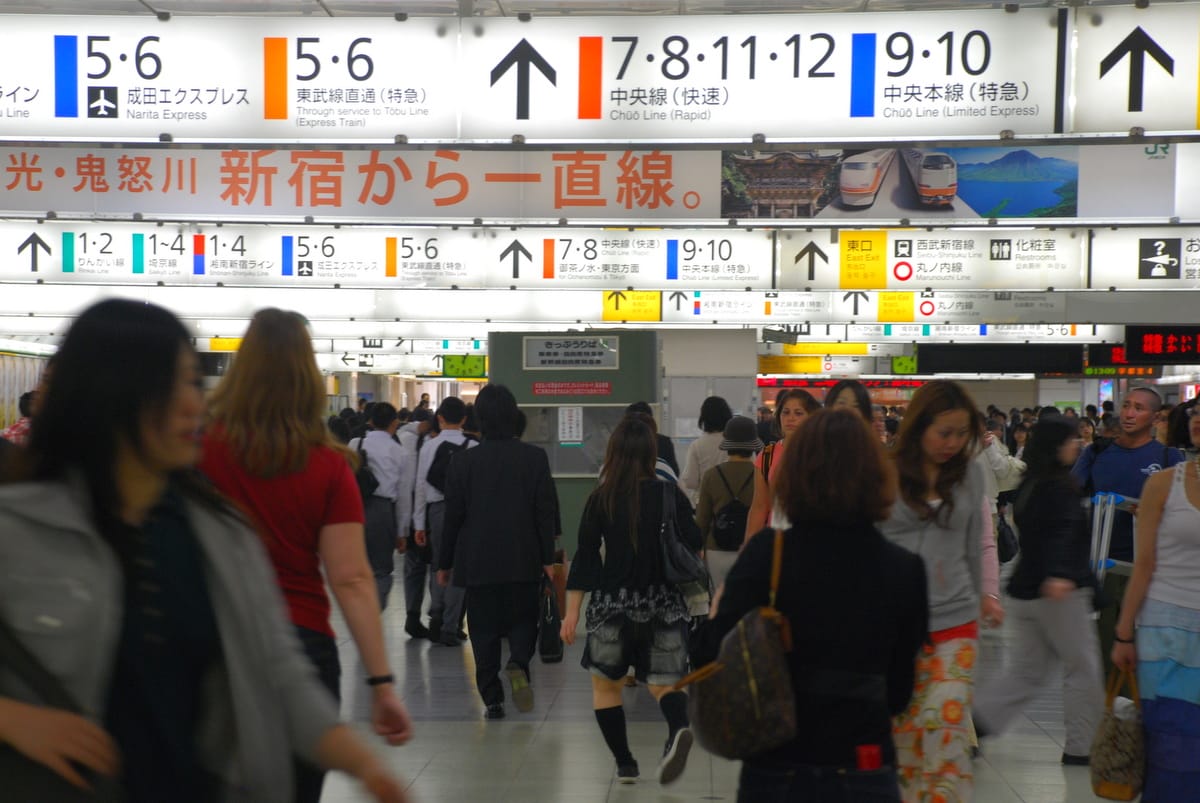
Don’t Be Afraid of Shopping at Convenience Stores
In Japan, convenience stores are everything. And EVERYWHERE! There are so many varieties from 7-11 to Lawson’s to Family Mart or more local shops like SeicoMart in Hokkaido that you can never be very far from one. Here you can literally get anything you want including breakfast or dinner! You can find ready made meals like fried chicken in Hokkaido to udon noodles, tempura, sandwiches and more. They also have chargers if you happen to have soaked your phone and need a cordless charger. They have candy and sweets, beer, iced coffee and so more more.
Get Ready to Carry Your Trash Around
One thing that is always a surprise to me when I’m in Japan is the lack of trash cans in public spaces. They are not on the roadsides or even that frequently found in shops. You will carry a lot of trash in your pockets all day long! Carry a small plastic bag for your trash to make life easier, but do remember to say no to plastic bags at most places as they are given very freely still or a minimal extra cost.
Separate Your Trash
Japan is not super up on the “use less plastic” concept, but they are very strict about separating their garbage. Hopefully this means they have a much better track record of recycling than we do in the US! If you are not used to separating your trash, educate yourself a bit on what is compostable, what is recyclable and what is landfill trash. At big festivals or events you will find very trash cans (as mentioned above), but when you do, they will expect you to seperate it all into the correct containers.
Eating, Drinking & Smoking in Public
While I am not 100% if there are rules on this, but in general you will notice that the Japanese people do NOT eat, drink or smoke while walking. There are of course designated areas for smoking, which is not allowed all over the place. But for drinking your morning coffee on the way to the train station? Nope, you won’t see Japanese people do this. Is it an unspoken rule or just a custom I am not certain, but I tried to follow suit as much as I could.
Throughout history, Japan has been a closed off society. Would you believe that almost 99% of the country is Japanese? The result is a unique culture with little Western influence and little English. So don’t be surprised if you ask questions or try to converse with people, but don’t receive much of a response. It’s not because they are rude, they simply know they can’t speak your language, and you likely can’t speak Japanese
Japanese Toilets Will Spoil You
Ok, one of the BEST things about Japan has to be their toilets. From the airport to public restrooms, you will find some really great toilets to literally write home about! My absolute favorite that I didn’t realize until I got back home was the heated seats. It really does feel so nice to sit down on a toasty toilet in the middle of the night. There are also several bidet options, drying options and of course also “privacy” sounds/music for many public toilets. Make sure to have your phone handy though as you may need to translate some of the buttons if they aren’t obvious. I have found myself stuff with the water on, not knowing how to turn it off! All of that said, you will also still find squat toilet options in most public bathrooms. They typically have a sign on the door indicating what type of toilet you can expect.
Get an e-SIM For Your Phone
If you haven’t tried an e-SIM yet, you need to get on the wagon. They are SO easy to use, super affordable and available all over the world. For my recently 2 week trip, I used a 10 GB e-SIM card which allowed me to have data access wherever I went. While there is often free Wi-Fi around major cities, often the log-in screen is only in Japanese which makes it challenging to login quickly. Get $3 off your first purchase at AIRLO using my code: KARILY0402
Stay at Ryokan At Least Once
One of the coolest Japanese cultural experiences I can recommend is to stay in a ryokan. A ryokan is basically traditional Japanese inns. While they come in many forms these days including a super traditional ryokan where you sleep on the tatami mats, you can also opt for ones that do have more “western” beds. I have stayed in all various forms and personally I love being able to plop down in an actual bed, but for a one night experience I would recommend trying the super traditional way as well.
As part of the experience, you might find that you have a traditional kaiseki meal for dinner or breakfast, you might also have no private shower in your room or have to take your shoes off at the hotel entrance. It is so fun and cool to see Japanese locals having their dinner or breakfast in the provided yukata (robe in the room) and wearing the slippers. I find this to be one of the most immersive cultural experiences you can have in Japan and well worth the price tag. (Shockingly they are usually quite a bit more expensive than western style hotels).
Japan is Not THAT Expensive
Japan has a reputation of being an excessively expensive country. While it is definitely more expensive than it’s other Asian counterparts, it is also not as pricey as some places in Europe! There are ways to reduce your expenses quite easily. One recommendation to mix up accomodation options – stay in a traditional ryokan, but also stay in chain hotels like Tokyu Stay. We had a great room at Tokyu Stay with a washer/dryer in our room for less than $80 a night. There are plenty of small shops for meals that will run you $5-10 a meal, while more traditional kaiseki meals will cost more. The biggest expense tends to be transport between cities, so that is why it is important to price it out in advance and check for internal flights and getting the JR Pass.
Do NOT Lose (or Keep) Your Hotel Key Card

Traditional hotels still use actual keys, so those are much easier to keep track of and not loose. If you are worried about losing one, you can drop it off with reception before you go out for the day.
Japan Trains Run VERY Timely
While I can’t say that Japanese trains run on time always because I have experienced delays with them, overwhelmingly they do run on a very tight schedule with very little disturbances. This is great as long as you are early, but it’s tough when you are running late! Always plan for delays in the train station and arrive with plenty of time.
Check for Seasonal Festivals
Regardless of when you visit Japan, there is sure to be some type of festival happening. These are often the best places to fully immerse yourself into the culture. For example, the cherry blossoms in the spring often have many festivals that accompany it, which can be quite fun. In Sapporo, there is an Autumn Festival in September that brings in tons of amazing food options every day for visitors to sample.
Bring Snacks With You
Whether it is a bus or train journey, do not plan on food being available. There are no dining cars on trains regardless how many hours they are. We found out the hard way that we needed to always have water and snacks with us because options were not always available. Shockingly though, you can eat and drink on the long distance trains, just make sure to take all of your trash with you.
Tap Water is Safe to Drink
One of the best things about travelling in Japan is that the tap water is safe to drink. I loved not having to purchase water bottles all the time or worry about water being bad quality. I even drank from a mountain spring in Rishiri Island that was crisp and cold and so delicious. Bring you recyclable water bottle and fill up in the hotels every day instead of buying more plastic.
Public Space & Japanese Etiquette
Japan has a concept called “ma” or personal space. Respect it, especially in crowded places with lots of people. Many of these etiquette rules are unspoken, but if you take time to look around you, you will notice that the Japanese people strictly adhere to them. Again, one of the best Japan travel tips I can provide is to look around you and follow what the locals are doing!
Wear Your Bag In Front on Crowded Trains
In places like Paris or New York, you might see people wearing their backpacks on their front on busy trains, but in Japan this is not for safety as much as it is a respect for fellow passengers. When you wear your bag on the front you are making sure that you are not accidentally hitting other people. This culture is one that is very fond of respect for others and I just love this example!
Safety in Japan
Overall I feel VERY safe in Japan at all hours of the day and night. Trains can get super crowded and you will see people wearing their bags in front like I mentioned above, however that is not necessarily for safety as it might be in other cities. All of that said, I would still be aware of your belongings when in crowded public places and wear your mobile on a strap like this one to make sure it isn’t snatched!
Use Google Maps for Train Travel
If you don’t already use Google Maps, one of my top Japan travel tips is to download it now! One of the coolest features of Google maps is that it will tell you how to walk to a train station, which train to get on and even which exit to look for when you arrive to the destination train stations! However it is important to note that oftentimes your internet may not work in the subway stations, so it is a good idea to have it all loaded before you get underground.
Expect Lines at Restaurants

Dietary Restrictions are Challenging
In Tokyo you can often manage with dietary restrictions more easily, but once you leave the big city, it can often be quite challenging to deal with dietary restrictions. I personally am allergic to MSG, which meant asking everywhere if I could eat the food prepared. For the most part, most chef’s knew instantly whether they used it or not. In the more rural parts of Japan in the far north of Hokkaido, I ran into a few more challenges. If you are a strict vegetarian, it is also a bit cumbersome to find food that does not include any fish sauce as it seems to be included in a ton. Just take your time and ask around as there are often places that can cater to your needs.
An International Drivers License is Required in Japan
If you plan to hire a car and self drive during your visit to Japan, make sure you acquire an International Driver’s license before you leave home. If you are in the US, this is easily obtained at AAA for around $20 in one day. This is just an additional piece of paper that says that yes, your license is for driving and you are able to drive outside of your home country.
Japanese Wait for the Walking Sign
Just like in Germany, for the most part Japanese people do not jaywalk or cross until the walking sign is illuminated. I have seen a few people here and there cut across the road or go before the walk sign is lit up, but by far the general rule is that you wait patiently on the sidewalk!
Try All the Drinks, But Don’t Expect Much More than Coke
In Japan you will quickly notice that the only western drink you can purchase by and large is Coca Cola and not even diet, just regular coke. I was so surprised when our Japanese exchange student had never had a Sprite, but after my recent visit I was reminded why – it’s tough to come by! Only occasionally did I see a Sprite in a convenience store and almost never in a vending machine. Overall, you will be presented with a ton of drinks that are only Japanese!
Also, I found out after much sampling and discussion with our Japanese hosts – you will never find sweetened tea in the vending machines unless it is Chinese or American. They do not put sugar in their green tea at all. I purchased MANY tea varieties looking for a sweet option, with absolutely no luck!
Buy From ALL the Vending Machines
One of my top Japan travel tips includes buying stuff from the vending machines. I just love the vending machines in Japan. And I love that you can purchase almost anything in the world from them. At one of my onsen visits, they had a vending machine with underwear (new!), razors, earbuds and more. We saw a vending machine selling frozen ramen which would be the perfect take out food if you lived there. You will of course find drinks machines everywhere you go as well. My favorite one of the entire country has to be the “cake in a can” vending machine in Sapporo. The cake was amazing as is the concept. It was pricey, but worth it at least once.
Another great one to look out for and try is a coffee vending machine. You can usually adjust how strong you want the coffee, how much sugar and how much milk. It is so fun to just pay 100 yen and have a hot coffee. Additionally, on most regular machines you can look for the signs that say hot/cold as some machines dispense BOTH hot and cold drinks. You want a hot tea, but your friend wants a cold drink. You got it. Seriously, these machines are the best and one of my favorite things to check out while wandering around towns!
Japan is a country with a rich culture and history, so embracing its traditions and customs can really enhance your travel experience.
There really is no “best time” to visit. There are distinct seasons, each offering unique experiences, so you do not have to only go during the high season of summer (or during the cherry blossom season in spring!). The colorful foliage in fall is worth a trip as is seeing the country blanketed in snow! Wherever you go, have fun and enjoy all the differences that you are sure to find!
MORE TRAVEL AROUND JAPAN
We hope you enjoyed these Japan travel tips! For more travel around Japan, see the links below:
- 3 week Classic Japan Itinerary in Photos: Tokyo, Kyoto, Snow Monkeys & More
- Get off the Beaten Path in Hokkaido: Rishiri & Rebun Islands
- The Best Food in Japan That You MUST Try!
If You Enjoyed This Post, Sign Up To Receive Posts By Email or…
- Join us on Facebook for regular updates and related articles
- Check us out on Instagram to see what we are up to in photos
- Follow us on Twitter for links to great travel articles curated just for you
- Or share this post with others by pinning on Pinterest!

Leave a Comment Cancel reply
Save my name, email, and website in this browser for the next time I comment.
This site uses Akismet to reduce spam. Learn how your comment data is processed .

75+ Japan Travel Tips for 1st Time Visitors from the USA (2024)
After returning from two weeks in Japan , I was bombarded with questions from readers, friends, and family who were curious about our trip or considering planning their own Japan trip. I get it, planning a trip to Japan can be intimidating with concerns about culture shock or language barriers. To help those planning their first trip to Japan, I put together these Japan travel tips for first time visitors to bring together everything we learned and things we really wished we knew before we went.
To make it easier to digest, I’ve broken these travel tips for Japan into categories including before you go, things to know on arrival, money matters, getting around, eating in Japan, what to wear in Japan, and general information about the Japanese culture.
Before we jump in, let me assure you that Japan is a fabulous country to visit, even for those from the USA or another Western country. The Japanese people are extremely polite, the cities are the cleanest you have ever seen, and the language barrier is really minimal. For these reasons and more, Japan makes an excellent first country to visit in Asia.
If you are planning a trip, be sure to also check out my very detailed itineraries for Tokyo , Kyoto , and Osaka , or my article about how much a trip to Japan costs .
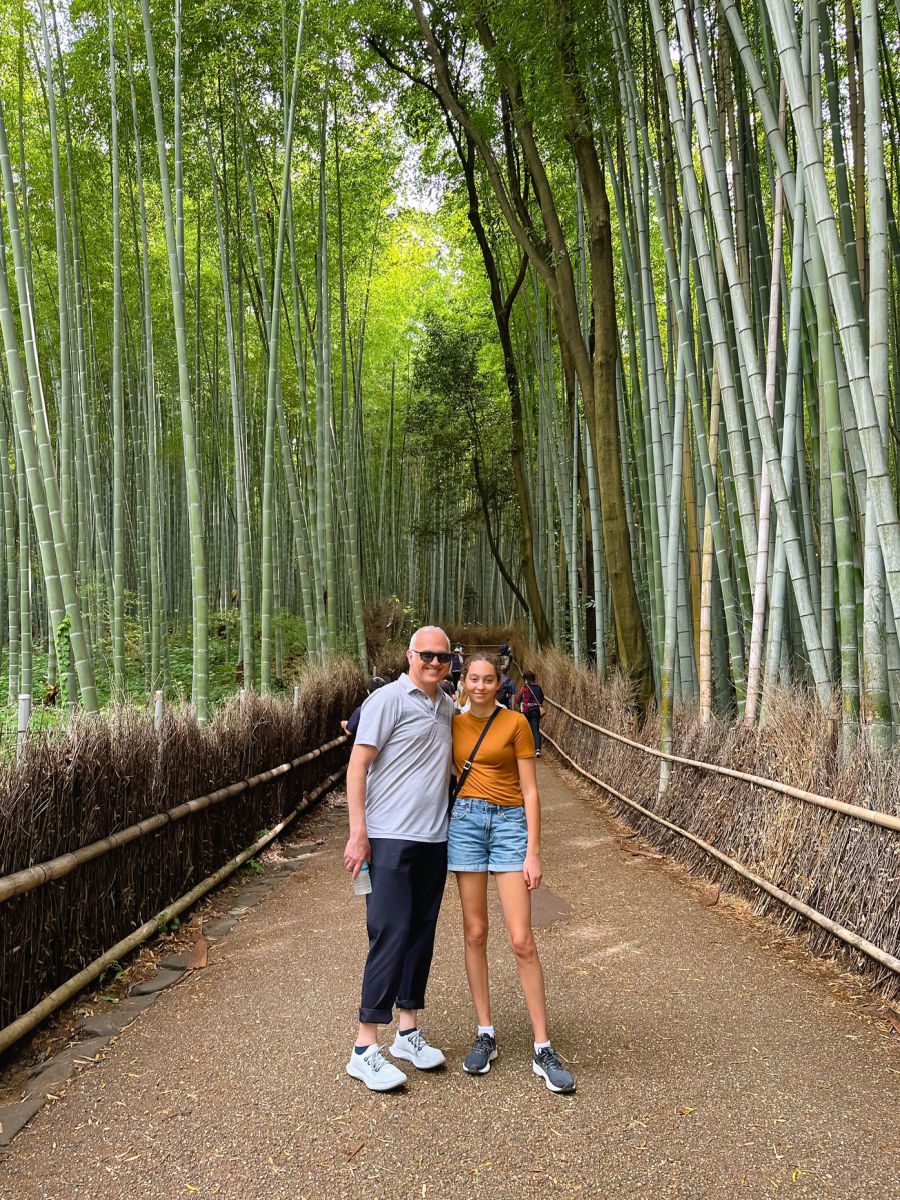
Japan Travel Tips: Before You Leave
Note: This post may contain affiliate links. If you click a link and make a purchase, I may receive a small commission. All opinions are my own.
Luckily, visiting Japan is quite easy. However, there are still a few things to do before you leave:
- Decide if you want to purchase a Japan Rail Pass for use in Japan. This pass is only available to overseas tourists and must be purchased before you arrive. Keep in mind that the JR Pass is ONLY valid on JR Trains (not Metro systems or private train lines) and there are different passes offered, depending on if you are traveling just within one region or throughout multiple regions (when you need a National Pass.) Prices have gone up recently so you really want to calculate how much you will use the Pass versus the cost of buying individual train tickets to see if it is worth the trouble.
- Prefill all required immigration and customs information on the Visit Japan Web site before you leave so that all you need to do upon arrival is show your QR codes for each person in your party.
- If you have prescription medications, be sure to research what medications are prohibited in Japan, as many common over-the-counter medications and prescriptions are illegal in Japan.
- Book all of your accommodations well in advance, especially if you are visiting during the busy springtime Cherry Blossom Season or Golden Week in early May. Keep in mind that Japanese hotel rooms are pretty small so if you want more space you may want to spend a bit more on an American brand. You can also consider staying one to two nights in a ryokan, a traditional Japanese inn that typically features tatami-matted rooms and communal baths known as onsens. To save money, you may want to consider an Airbnb or capsule hotel.
- Book as many restaurant reservations as possible a few weeks in advance, especially if you are looking to experience some of Japan’s many renowned Michelin Star or fine dining options. Not all restaurants offer online booking but this is where a hotel concierge can help, or there are paid restaurant booking services (that I’ll discuss more below.)
- Buy timed-entry tickets to popular attractions that sell out, especially TeamLab Planets Tokyo or Sumo practice .
- Reserve a mobile WiFi hot spot that you will pick up at the airport, or look into an international eSIM provider , as this will typically be cheaper than an international data plan on most cellular carriers.
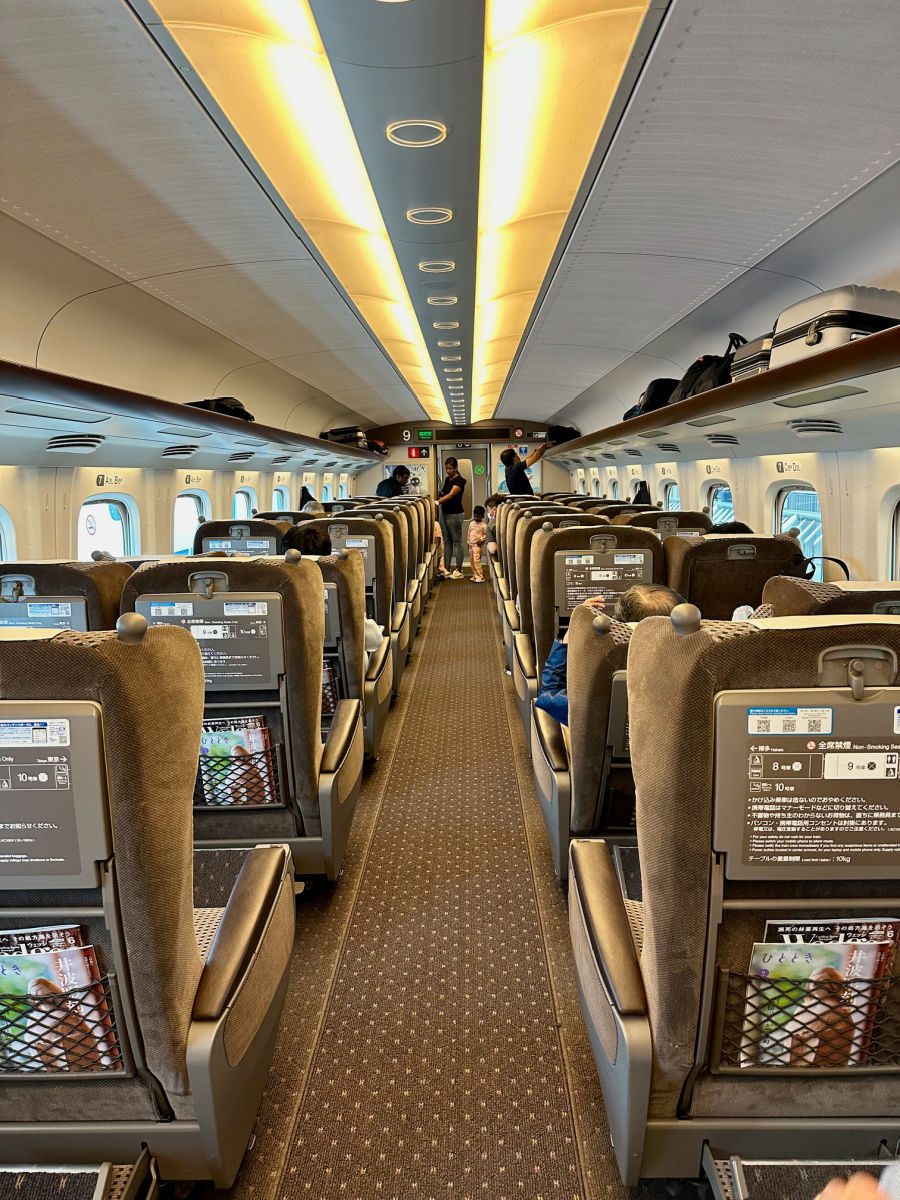
What to do when you arrive in Japan
If you fly into Tokyo, you will arrive at either at Narita Airport (NRT) or Haneda Airport (HND) in Tokyo. Narita is over one hour from the city center, while Haneda is a lot closer. In either instance, taxis from the airport will be quite expensive and it pays to look into alternative transportation options.
Since we flew on Delta, we arrived at Haneda Airport, which is connected to Tokyo via a monorail or train options. We didn’t want to deal with transferring trains and metros with our large luggage after a full day of travel, so I booked the Airport Limousine Bus , which provided door-to-door transfers from Haneda airport to our hotel (the Hilton Tokyo) at a very affordable rate.
Before you leave the airport, there are a few important things you need to do first!
- Go to an ATM and withdraw about 50,000 Yen to start. Remember you want to withdraw as much as you think you might need in one chunk versus multiple smaller withdrawals to avoid extra fees. While Japan has moved to be more contactless post-Covid, there are still many smaller restaurants, shops, and food stalls that only take cash. And even the high-tech machines you use to get your IC Cards only take cash (bizarre, I know!)
- Purchase an IC Card. An IC Card is a rechargeable, prepaid travel card that is used to access public transportation including metros, busses, and some ferries throughout Japan. Many vending machines also accept IC cards as payment and you can also use them to rent lockers in train stations. There are different flavors of IC cards such as the Pasmo or Suica card. Some require a 500 Yen deposit. However, at the airport, you can use a touch-screen machine (with an English option) to purchase a Welcome Suica card, which does not require a deposit. You must pay cash to load money onto your IC card. I’d recommend putting about 3,000-5,000 Yen on each card to start for a 14-day trip. Because of a chip shortage, it is now harder to get a physical IC card, but you should still be able to purchase the Welcome Suica card at the airport or large train stations. You can also try to load a digital IC card if you have an Apple iPhone with either a Mastercard, American Express, or Apple Card connected to your Apple Pay.
- Keep in mind that each person in your party needs their own card . You cannot use the same card to swipe multiple people through a turnstile. When you go to use the card, you tap it on the reader at the turnstile and then tap again to exit the station. On a bus, you typically only tap it to exit. If you are able to load a digital IC card, you can just tap your phone at the readers.
- Pick up a mobile hotspot or international SIM . Unless you are using an eSim , you may want to reserve a mobile hotspot or purchase an international SIM card for your two weeks in Japan. These work out to be cheaper than paying for most international calling plans. For example, Verizon charges me $10/day for data and throttles the speed after a certain threshold is met. But, we rented a mobile hotspot from Ninja WiFi for $98 for unlimited data for 14 days. This allowed all three of our devices to stay connected for much less than we would pay for one phone’s international plan. There are many shops to rent a hotspot or purchase a SIM card at the airport and you just drop it off before your flight home.
- Exchange your JR Pass vouchers . If you plan on using a Japan Rail Pass, you need to purchase it online before you leave home. You will be sent a voucher that you exchange upon arrival in Japan at certain JR ticket offices. The ticket offices in the airports will exchange your voucher for a pass, but you may need to visit a JR ticket office at one of the major train stations to make seat reservations (depending on which level pass you purchase.)
- Also keep in mind that if you are traveling with checked luggage size bags, you will need a luggage reservation on the bullet trains (and these are limited), or you can arrange to ship your luggage ahead.
- Depending on the JR ticket office, they may also make train reservations for you (if you purchased a pass that includes seat reservations such as a Green JR Pass.) If not, you can do this at the ticket offices in the major train stations, such as Tokyo Train Station, Shinjuku Train Station, etc.
- Arrange a transfer to your hotel. Taxis are very expensive in Japan, especially if you are traveling all the way into center Tokyo from Narita airport. It is cheapest to use public transportation. However, another option, depending on where you are staying, is the Airport Limosuine Bus, which connects the airports with central train stations and hotels for door-to-door service. It is nice to not have to navigate the trains on your first day in Japan (when you are still tired and jetlagged.) I booked our bus in advance and gave too much time to get through customs and the other steps at the airport and had to switch to an earlier bus when I got there. You may want to just wait until you clear immigration/customs before you book your bus transfer from the desk at the airport.
- When you get to your hotel, don’t lock your passport away in your hotel safe. It is required that you carry your passport with you when you are out and about in Japan. I’d suggest keeping hard copies in a safe space in your hotel just in case it gets lost (and a picture of it on your phone.)
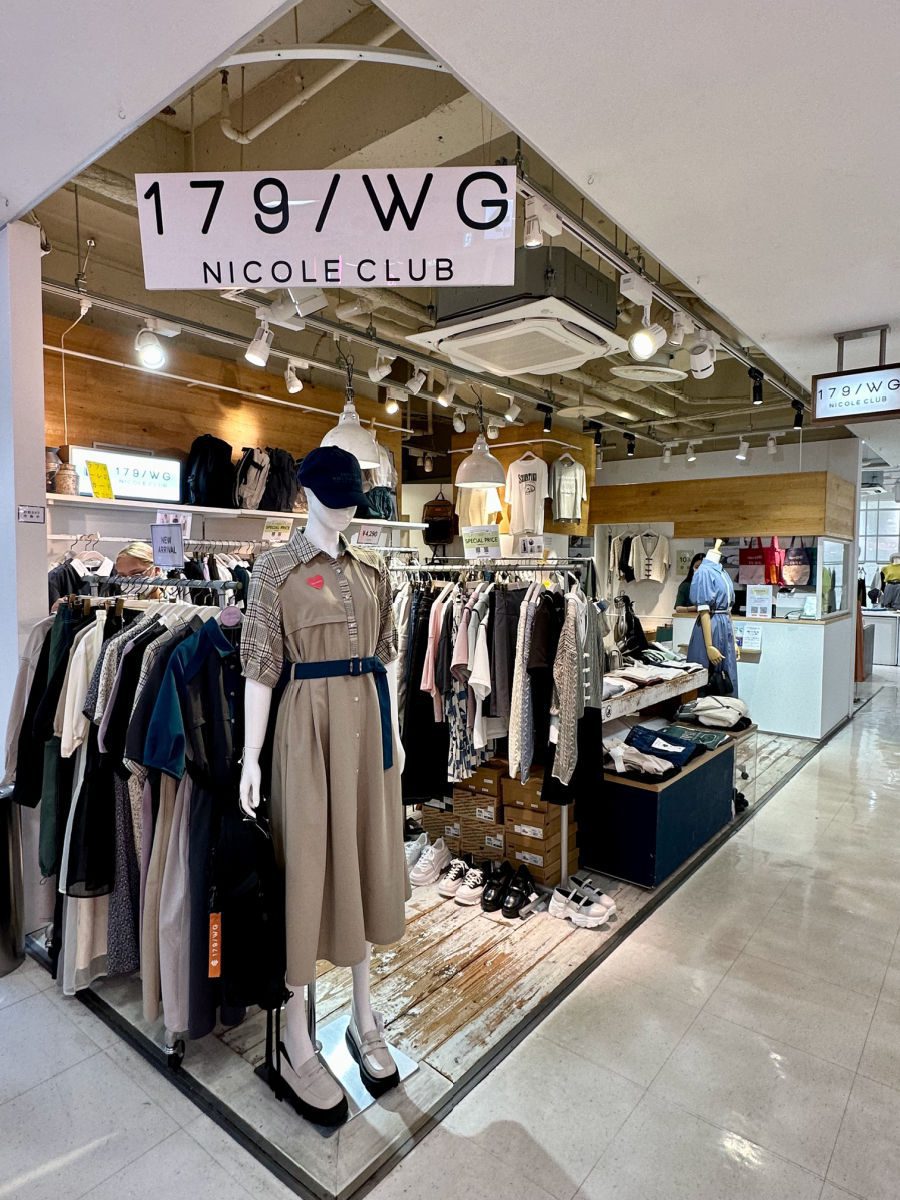
Japan Money & Shopping Tips
- The local currency is the Japanese Yen. The current exchange rate is $1.00 = ~ 156 Japanese Yen. You can check the current exchange rate using XE.com .
- Always keep some cash on you, including some change, as many businesses and attractions still do not accept credit cards. Change is used especially when visiting temples or shrines to make an offering, purchase a charm, or receive a fortune.
- While many establishments now accept credit cards, not many support Apple Pay (they have a local digital contactless payment system). You will generally need to insert your credit card and sign a receipt. Don’t be surprised when the clerk hands you both the original receipt and the credit card receipt for each transaction.
- Not many businesses accept American Express and some also don’t accept MasterCard. To be safe, carry a couple of cards and make at least one of them a Visa.
- To reduce the use of plastic, shops now charge a small amount for a shopping bag (typically about 20 Yen). To avoid this fee or excess packaging, carry a packable reusable shopping bag such as these .
- Some shops advertise Tax-Free Shopping. If you see this sign, give them your passport and they will take the tax off your purchase on-site, without any forms to drop off at the airport. This saves around 10% for purchases over a certain amount. Other shops participate in the Global Blue tax refund, but for those you will need to fill out paperwork and bring it to a Global Blue location at the airport or in the shopping center with the goods you purchased.
- Tipping is NOT customary in Japan. Honestly, after the creep of the tipping culture in the U.S. in the last few years, it is such a pleasure to not tip in Japan and to know it is not expected. Some restaurants may charge a cover charge but that is it.
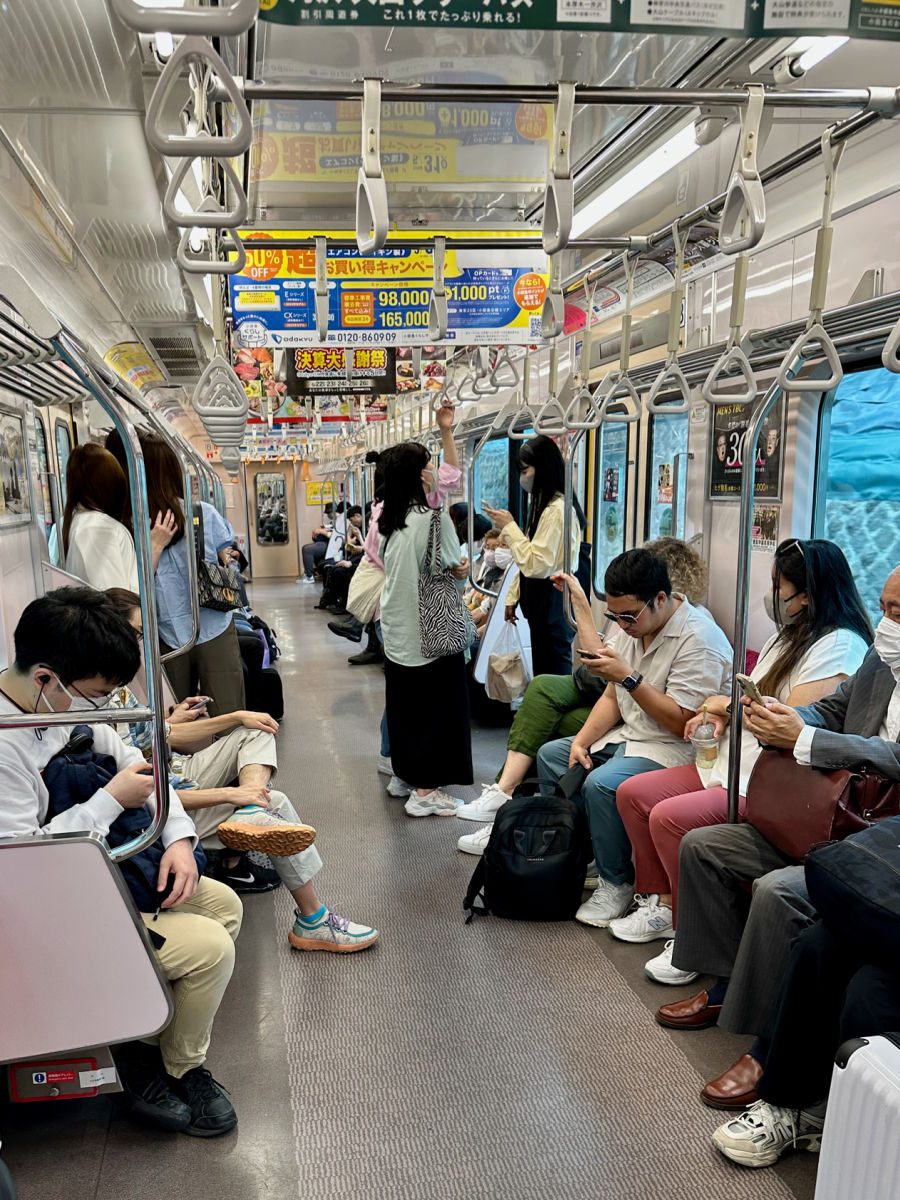
Tips for Getting Around Japan
Getting around Japan is very easy with its efficient and usually prompt train and public transportation system. However, there are a few things that will make getting around the cities a little easier:
- Travel between cities is easiest using the Shinkansen bullet train. Just keep in mind that the fastest bullet trains, the Nozomi and Mizuho Shinkansen trains, are not included in the JR Pass.
- If you take the Shinkansen from Tokyo to Kyoto, try to get a seat on the right hand side of the train and on a clear day, you will get a great view of Mount Fuji.
- Most trains do not require reservations, but purchasing a ticket with a reserved seat or a JR Pass that includes reservations, is much more pleasant as you know you will have a seat, even on busy trains. The platform will indicate which train cars are reserved versus non-reserved.
- You need a luggage reservation when bringing large checked bags onto a Shinkansen train. Keep in mind that there is very limited luggage rack space and otherwise only the seats in the last row also offer a luggage reservation in the space behind the seats. If you plan on bringing your bags on the train, I recommend stopping at the JR ticket office in one of the large train stations and getting help reserving seats and luggage spaces.
- Smaller carry-on size bags can fit on the rack over the seats. Just keep in mind that bringing any bags through the metro at rush hour is near impossible on the busy lines.
- You may want to consider shipping your luggage ahead to your next hotel. Depending on the location and season, this can typically be done in 24 hours, so that you can travel with just a backpack or small bag with your things and reunite with your luggage at your next hotel or the shipping office in the next city. Most of the hotels will arrange for your luggage shipping at the concierge or bell desk. However, if you are staying at an Airbnb, you can look into using a shipper such as Yamato Transport . We did this between Tokyo and Kyoto and Kyoto and Osaka and it made getting around so much easier. It cost less than $20 per bag for our ~50 lb. checked-luggage sized bags.
- In most cities, in addition to Japan Rail (JR) trains, there are also private trains and local metro or subway systems. Google Maps is extremely helpful in determining the best route, but you may want to do a little more research if you are trying to use JR trains. The route search on the official Japan Travel App from the Japan National Tourism Organization or the Japan Travel app from Navitime are helpful if you want to find the best routes for specific types of tourist passes.
- To use your JR Pass, simply insert your JR Pass at the turnstile and take it back after you walk through. You will need to do the same when you exit the station.
- If you are using your IC Card, tap the card at the turnstile when you enter the station and tap again when you exit. Keep an eye on your balance. Most stations have machines where you can easily reload your IC card (with an English menu.)
- If you have any trouble, the staff at the train stations are very helpful in providing directions.
- When it comes to using the trains and subways, Google Maps offers invaluable information regarding which platform the train will be on, when it is leaving (and when the next trains are expected), what car is best to board if you are transferring, the length of the trip and the number of stops, the stop name, the cost with an IC Card, and the best exit to use at the train station (trust me that this is so, so helpful.)
- On trains and subways in major cities, all the train signage both on the platform and in the train cars, is offered in Japanese and English, as are the announcements on the train letting you know the next stop, etc.
- Once you are on the train platform, you will need to line up behind the yellow line at one of the spots indicated by a number that corresponds with the car number. In Japan, it is customary to line up single file.
- When the train arrives, let those exiting to get off the train before boarding.
- Note that on some trains, certain cars indicated with pink on the platform are for women only during certain hours.
- The only time you might see pushing in Japan is people squeezing themselves onto a subway train. Rush hour on certain lines such as the Maranouchi line in the Tokyo Metro that goes through Shinjuku station, which is the busiest station in the world they claim, is an absolute crush and best to avoid, especially with small children.
- Once on the train, follow the local customs and silence your phone and if you talk, do so quietly. The trains and subways in Japan are very quiet and surprisingly clean. People do not talk or eat on the train. Many nap, others read or play games. I saw plenty of people reading manga comics on their phones and even one guy reading sheet music for “Moon River.”
- Note that while walking through busy train stations and on the street, people typically walk on the left. Except in Osaka, where it is customary to walk on the right. Many stations have arrows on the floors.
- On escalators, stand on the left to let those in a rush go by on the right. Except in Osaka, then stand on the right.
- If you are using a maps app for walking directions and you are using a mobile hotspot, we found Apple Maps to offer better turn-by-turn walking directions that were easier to follow. The arrow on Google Maps used to indicate your location would often spin in a confusing way and it wasn’t as clear about when to go up steps, across bridges, etc.
- Most train stations offer lockers if you want to store your belongings and go out and explore. There are small, medium and large lockers and the medium and large will fit a suitcase or multiple smaller bags. The price ranges from 300 to 500 Yen.
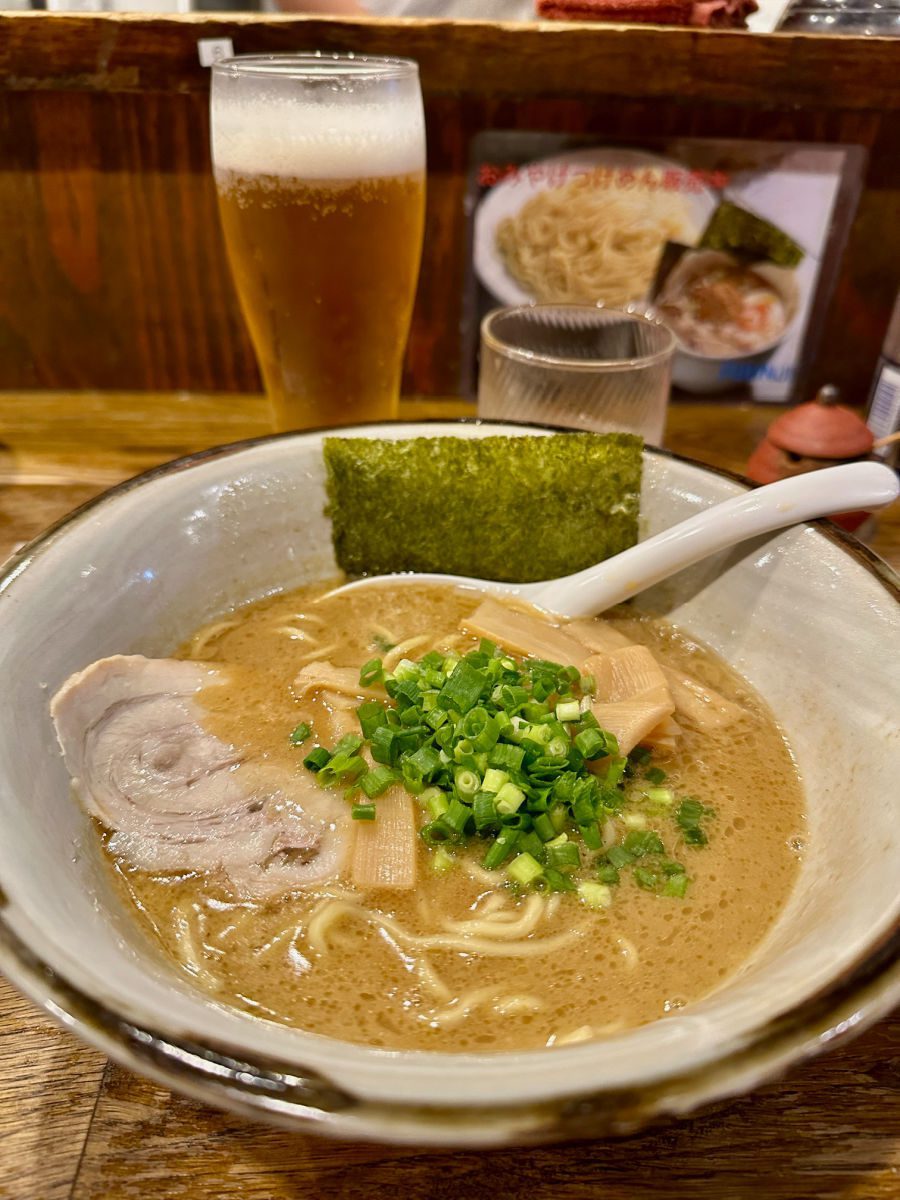
Japanese Food & Restaurant Tips
Japanese cuisine is incredible and no, you don’t have to eat sushi every day. Each shop specializes in a specific dish and does it well. You will eat ramen, soba noodles, tempura, shabu shabu, street food, sushi, and so much more. There are a few things to keep in mind when visiting restaurants though, including:
- Japanese people love to line up for good food. There are many small restaurants with less than a dozen seats and people will line up for two hours or more to eat there. It is hard to do this as a tourist who is tired from walking and doesn’t want to spend precious vacation time in line. But it is part of the experience. Also, this is most common at the cheaper places. If you want to spend more, it is easier to get a reservation. If a restaurant opens at 5:00 pm, expect a line to start forming by 4:30 pm if not earlier.
- Luckily, these restaurants turn over seats very quickly as people are encouraged to eat and go. Japan is not a place where people linger over meals. They eat quickly and quietly and leave.
- You will find a wealth of inexpensive restaurants in Japan. However, you will also find a large number of very expensive (e.g. $200-500 per person) restaurants. Unfortunately, there isn’t a lot in the middle. So it is either get in line and eat cheap or make a reservation and spend an arm and a leg (there are exceptions of course.)
- If you want to try a special restaurant, there are number of restaurant reservation services that will help you make reservations. Trust me that many book up weeks in advance and even if you set an alert to make a reservation when they open the calendar, you may still miss it. Some of these services include: Pocket Concierge, Omakase, JPneazy.com, MyConcierge Japan, Table All, and Table Check.
- Keiseki is a traditional Japanese meal with multiple small courses. These are typically served at ryokans and traditional tea houses.
- Omakase is chef’s choice sushi, which is typically offered at different levels or numbers of pieces with different price points.
- It is impolite to be loud in restaurants, but slurping in a noodle place is accepted and expected.
- Each restaurant will provide either a hot towel (washcloth) or a disposable wet towel to clean your hands before eating. However, what we consider napkins or serviettes are not provided.
- Do not rub your chopsticks together in Japan, it is considered rude. Likewise, don’t stab with your chopsticks and don’t rest them on your bowl.
- To reduce waste, bring your own reusable chopstick set . I saw someone with these on our last day of our trip and I really wish I had thought of it sooner.
- You don’t dip your sushi in soy sauce in Japan as the chef prepares it as it should be eaten.
- Don’t walk and eat in Japan. If you purchase food at a convenience store or food stall, you can eat out front and then bring them back the trash.
- Garbage cans are very scarce in Japan!! Be prepared to carry around your trash until you find a bin (typically at the train station.) But don’t worry, the streets in Japan are very clean. Littering is not part of the culture.
- You will find vending machines everywhere selling various drinks and many take the IC card for payment, although some require cash or other digital payment systems.
- Unfortunately, there are not many public bottle refill stations or drinking fountains.
- Avoid eating on the metro or local trains, but it is acceptable to eat on the longer, Shinkansen trains, and there are many shops in the train station selling bento boxes that are packaged perfectly for this purpose.
- Many higher end restaurants speak English. However, many others offer either an English menu or a menu with pictures. At others, you order from a vending machine with photos. This can be a little tricky to understand but generally just select the photo of the item you want to order, insert your cash, take your ticket and hand that to someone behind the counter.
- Google Translate with the camera function / Google Lens can be very helpful for menu translation. I’d recommend downloading the Japanese dictionary for offline use.
- Some restaurants offer a tablet at the table for ordering or a button to call the server to place an order.
- At many restaurants, you take the bill to the front to pay at the cashier.
- Don’t leave your chopsticks sticking upright in a bowl of rice (this is a funeral ritual).
- When receiving a drink, cup it with two hands to show gratitude.
- Japanese convenience stores such as 7 Eleven, Lawsons, and Family Mart all offer surprisingly good food, which is an inexpensive way to eat while in Japan.
- Many department stores also have a floor with food stalls that offer prepared foods to purchase and bring home to eat including bento boxes, sweets, and other foods that can be reheated easily.
- Taking a food tour is a great way to learn about the local cuisine. We took a food tour in Osaka with Arigato Travel and definitely recommend them.
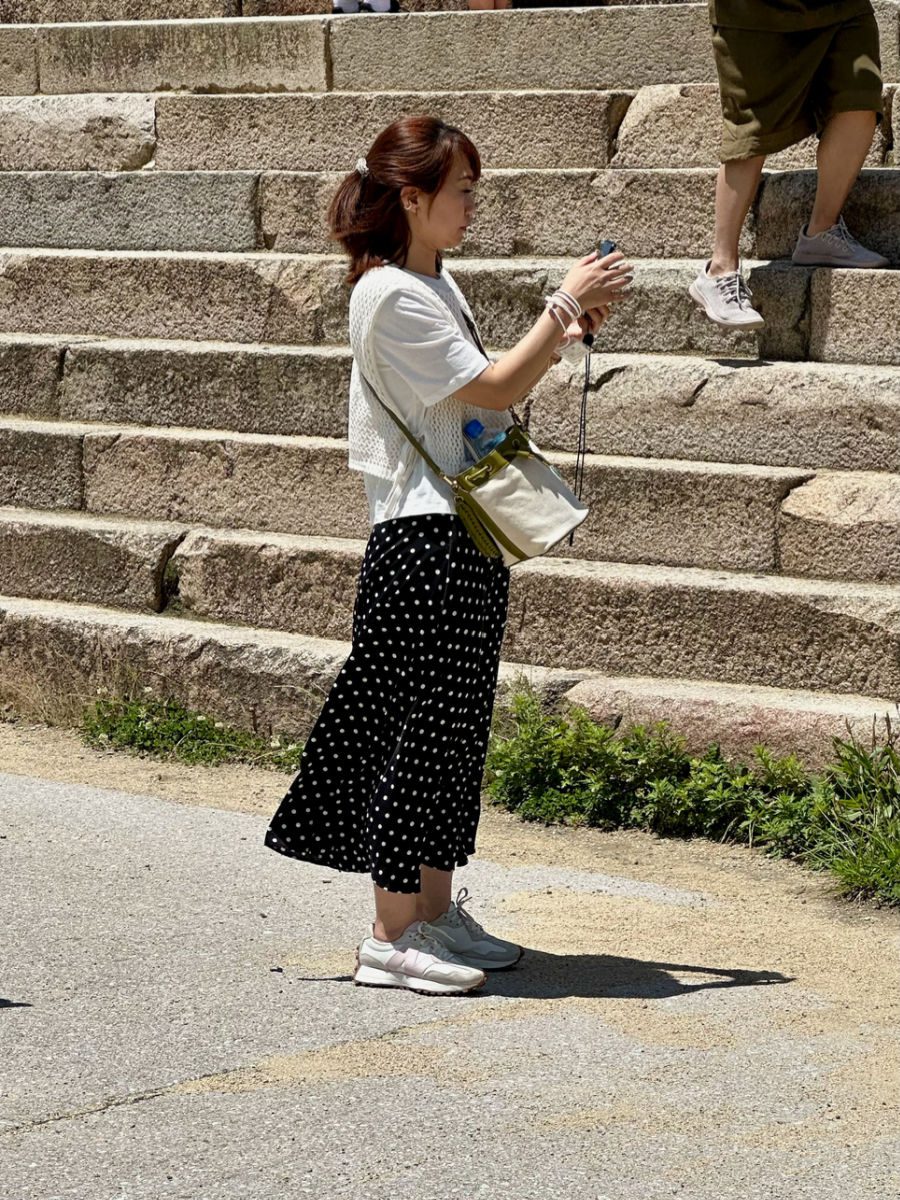
What to Wear in Japan
Japan is a fairly conservative society when it comes to dress, with the exception of the “kawaii culture” amongst the youth. To fit in and show the proper respect, it is important to keep a few tips in mind:
- When visiting temples and shrines, it is appropriate to make sure the knees and shoulders are covered, although it isn’t policed as strictly as some churches in Italy.
- Shorts are rarely worn by locals. You are more apt to see shorts on international tourists in Kyoto than in the big working cities like Tokyo.
- Women wear a lot of loose fitting, wide leg pants and long skirts, paired with a t-shirt under a sweater or flowy button-up shirt or light jacket.
- Men are often in suits or business attire, or slacks and a golf shirt. Younger teen boys will likely wear jeans and t-shirts.
- If you are visiting temples and shrines, or traditional restaurants, it is helpful to wear shoes that can easily be slipped off, as required upon entry.
- When visiting Japan, it is important to wear comfortable shoes, as you will do a lot of walking.
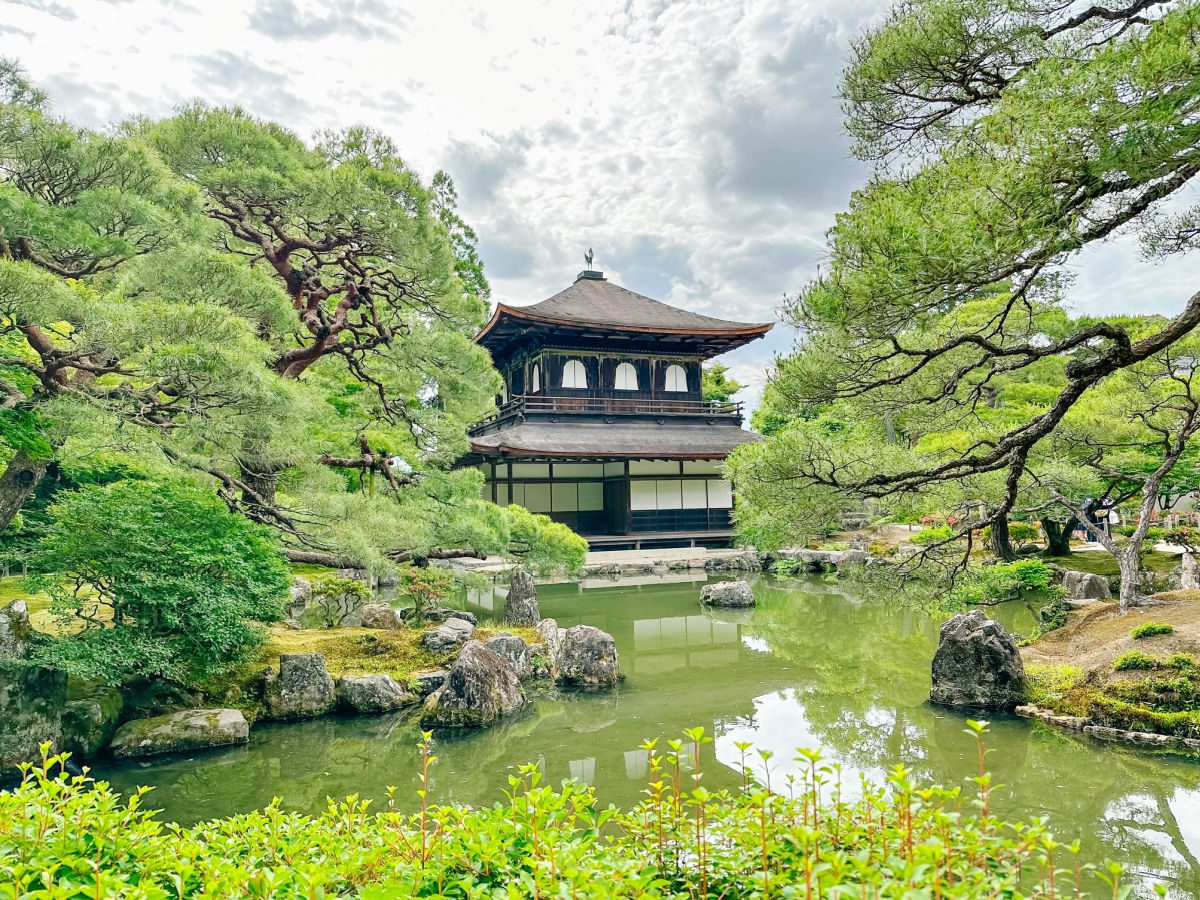
Japanese Culture Tips
The Japanese culture values politeness, cleanliness, order, following the rules, and beautiful presentation. You will see these reflected during your visit and it is important to show respect by observing cultural norms.
- Konnichiwa – hello
- Arigatou gozaimasu – thank you very much
- Sumimasen – excuse me
- Dō itashimashite – you’re welcome
- Hai – yes
- Lie – no
- Gomen’nasai – I’m sorry
- Ohayō – good morning
- Konbanwa – good evening
- O-yasumi nasai – good night
- Japanese packaging may seem excessive or wasteful, but it is very culturally important to present things beautifully. Your purchases will be wrapped and bags sealed with stickers to keep them closed. If you purchase a pastry at a shop, it is often individually boxed with small ice packs to keep it fresh until you can enjoy it at home.
- If you are invited to someone’s home, remember to bring a gift that is nicely packaged.
- A slight bow is a show of respect when meeting someone or thanking them.
- If someone hands you a business card or a gift, except it with two hands and a slight bow.
- Do not blow your nose in public.
- Wear a face mask if you aren’t feeling well.
- Wait to cross the street only when the light is green, even if no one is coming.
- Be on time!! No one is late in Japan, they are usually early. On one tour, our tour guide was being generous by agreeing to wait until 2 minutes after the meeting time for someone that hadn’t yet showed up.
- In Japan, Buddhist temples and Shinto shrines often sit side by side. When visiting, remember to remove your shoes before entering the inside of a temple or shrine (there are usually cubbies provided). At a shinto shrine, it is appropriate to wash your hands first. If you want to offer a prayer, first you bow, then give an offering of small change, bow deeply twice, ring the bell, clap twice, offer your prayer, then bow once more. See a full description of temple and shrine etiquette .
- Remove your shoes when entering a shrine, temple, restaurant with tatami mats, or someone’s home.
- In Japan, public restrooms are widely available and they are very clean. Japanese toilets are also the best, offering features like heated seats, privacy sounds, and washing options. Many public restrooms also offer baby seats in some stalls, along with family bathrooms, changing tables, and nursing rooms.
- Japan is one of the safest countries to visit and even if you are traveling solo, you will feel very comfortable walking around even at night.
I hope these Japan travel tips are helpful. As a travel blogger, I have visited many countries but I found Japan one of the safest, most comfortable, and most orderly place I have been to. It suited my type A personality perfectly and I loved the blend of ultra modern and traditional culture.
Still Dreaming of Japan?

If you want a taste of Japan at home or a fun way to surprise and excite the family for an upcoming trip, consider ordering a Tokyo Treat box . TokyoTreat is a monthly pop Japanese snack subscription box, you will get up to 20 exclusive, limited edition, and seasonal flavored Japanese snacks and Japanese candy that are only available in Japan for a limited time.
Save this to Pinterest
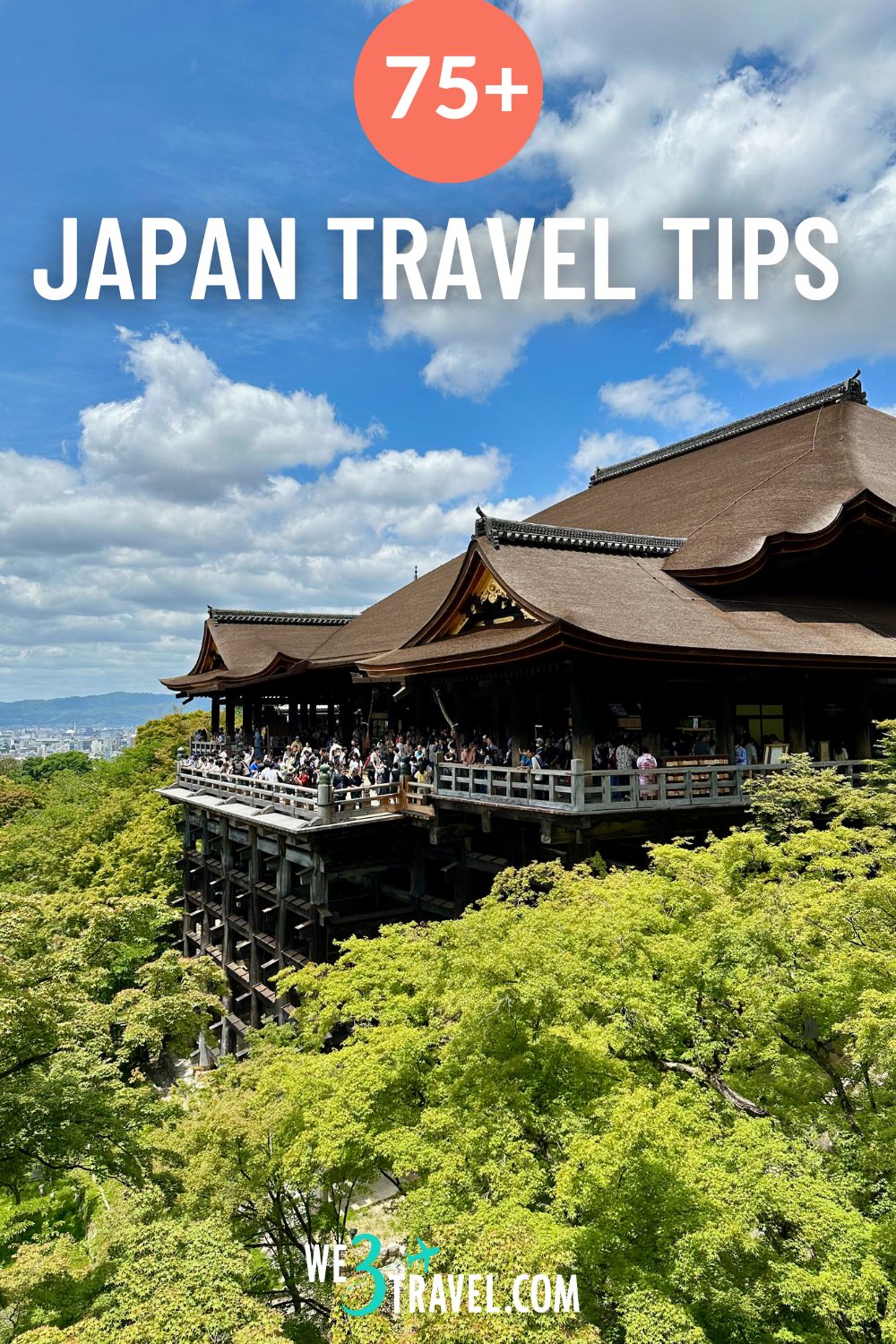
Tamara Gruber is the Founder and Publisher of We3Travel. A former marketing executive and travel advisor, Tamara is an award-winning travel writer and recognized expert in family travel. Tamara is a member of SATW and the Adventure Travel Trade Association, and serves on the Board of the Family Travel Association. She is also the publisher of YourTimetoFly.com and the co-host of the Vacation Mavens travel podcast.
Find this useful? Share it!
Publish Date: May 27, 2024

SIGN UP FOR OUR NEWSLETTER & RECEIVE A FAMILY VACATION PLANNING KIT!
We3Travel.com will use the information you provide on this form to send you newsletters. You can unsubscribe at any time by clicking the link in the footer of any email you receive from us, or by contacting [email protected] . By clicking below, you agree that we may process your information in accordance with these terms.

Start typing and press enter to search

TRAVEL to JAPAN – Tips and Information Guide (2024)
Everything you need to know about travel to Japan in our brand new Japan travel guide.
Japan is an island nation with a tremendous amount of history and culture intertwined with is present fast-paced reputation.
From the epic wilderness of Hokkaido down to the tropical beaches of Okinawa, travelling to Japan is an experience like no other.
Whether you’re into food, culture, history or the outdoors Japan has it all. Travel to Japan is on the rise and it’s easy to see why.
Of Japan’s four main islands Honshu gets the vast majority of visitors. Travellers are in constant awe of the spectrum of Kyoto’s temples, taken captive with Nara’s deer and consumed by eating everything in sight in Tokyo.
However, the islands of Hokkaido, Kyushu and Shikoku are also home to some of the country’s most stunning scenery and are definitely worth a visit.
Whatever you want, you can find it in Japan. Let us help you plan your journey to one of the most awe-inspiring destinations on the planet!
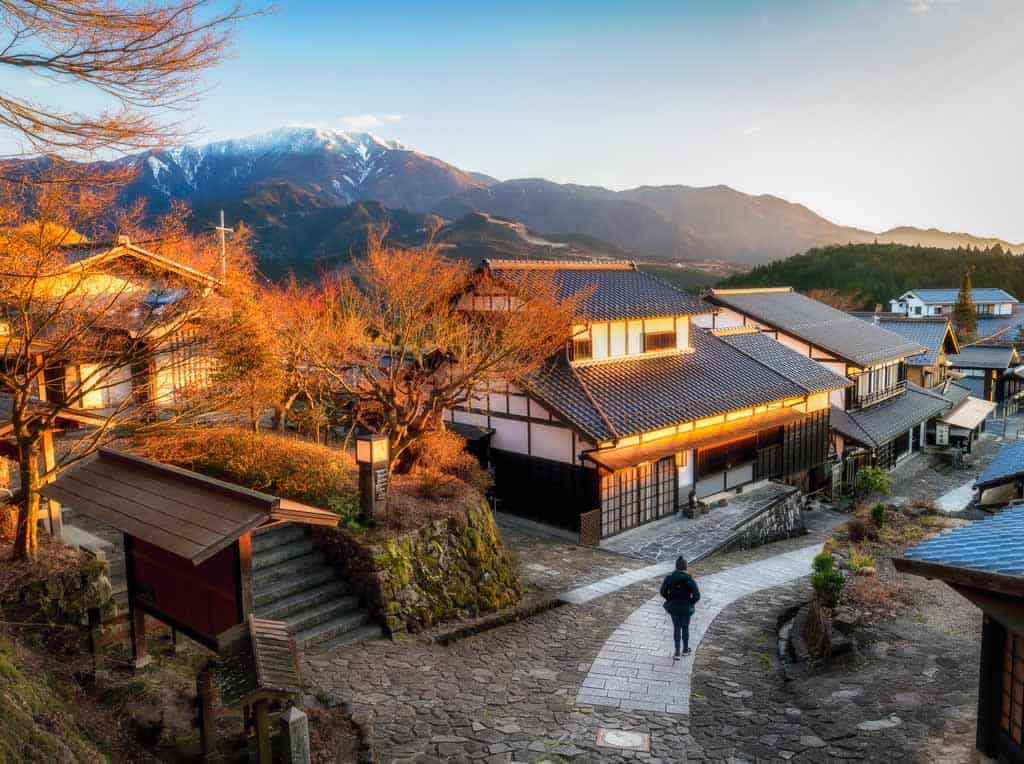
19 BEST Things to Do in Osaka, Japan [2024 Edition]
The perfect 3 days in tokyo itinerary, the best day trips from every city in japan [2024], travelling in japan: at a glance.
Here are the basics about travel to Japan.
OTHER MAIN CITIES:
Osaka , Kyoto , Nagasaki, Fukuoka , Sapporo and Nagoya
Yen (See current exchange rates ) (1$USD is approximately 108 yen) 1 beer is approximately 500 yen (USD$5)
ENTRY / VISA:
Visa requirements for Japan are very straightforward. Most travellers are visa-free and can stay for 15, 30 or 90 days depending on their nationality. For information about which countries are granted visa-free access click here.
Japanese is the official language in Japan. And while most of the world speaks a fair amount of English, do not expect Japanese people to speak it. However, in some hostels and hotels, English is spoken. Before travelling to Japan be sure to learn a few key phrases to help you enjoy your travels more and, of course, to show respect for the Japanse way of life. Many signs are in both Japanese and English and announcements at subway and train stations are often in both languages.
Japan is one of the safest countries in the world for both men and women. Petty theft and violent crime are extremely rare. Stories of people leaving wallets, passports and bags on trains and being reunited with them are the norm. However, you should still be sensible and follow the usual travel precautions.
ELECTRICITY:
100 volts / Type A and B electric sockets (Be sure to get your universal travel adapter before you leave)
TRANSPORTATION:
By far the most common way to get between cities in Japan is by using the JR Pass. Within the larger cities, you can very often make your way around using public transportation. Traditional taxis are also available in most cities and suburban regions. And rideshares such as Uber are on the rise as well – though don’t count on one of these outside of the main Japanese metropolises.
Don’t Forget to Pack the Most Important Thing: Travel Insurance !
TOP 5 TRAVEL EXPERIENCES IN Japan
With so much to see and do in Vietnam, it really is hard to pick the top experiences.
However, we think that to truly appreciate Vietnam you need to plan to do these 5 activities during your visit.
Gorge yourself on sushi.
Japan is known for sushi. You can find it everywhere. For added enjoyment, try your hand at making it!
Book a sushi cooking class here .
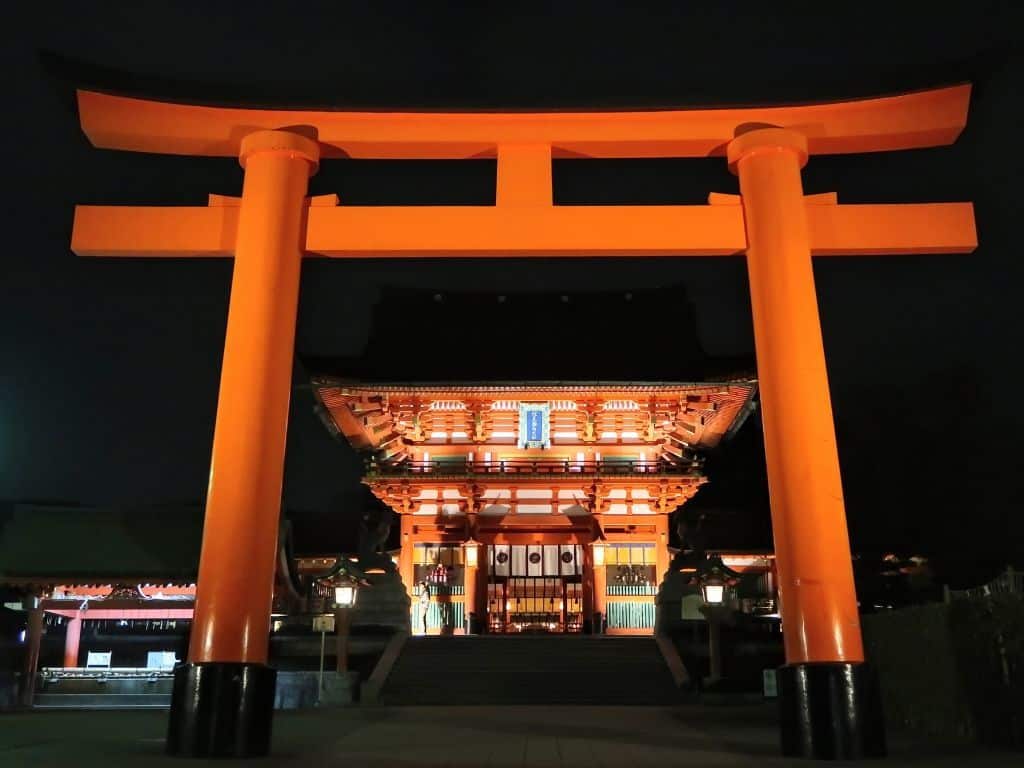
Visit ancient temples in Kyoto
Kyoto is the magical, ancient city of Japan known for being the spiritual centre of the country. Immerse yourself in the beauty and stillness of its many temples.
Check out our 3 days in Kyoto itinerary here.
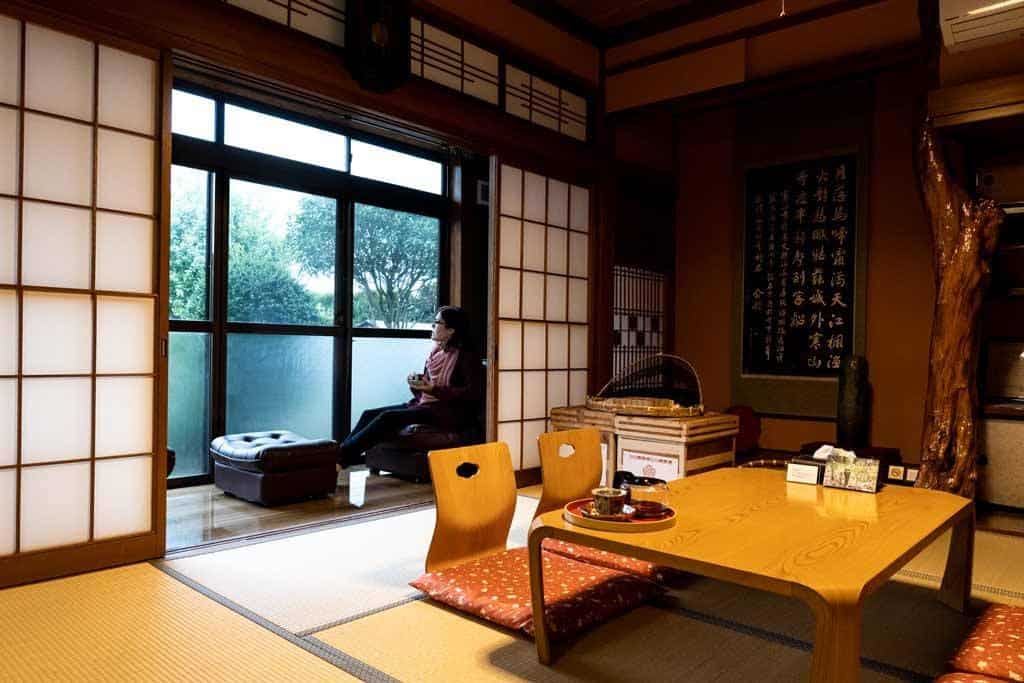
Spend the night in a Ryokan
Staying in a ryokan is the most authentic way to experience Japan. Splurge on the experience and find yourself turning Japanese after a refreshing stay!
You can stay in a great ryokan in Murakami .
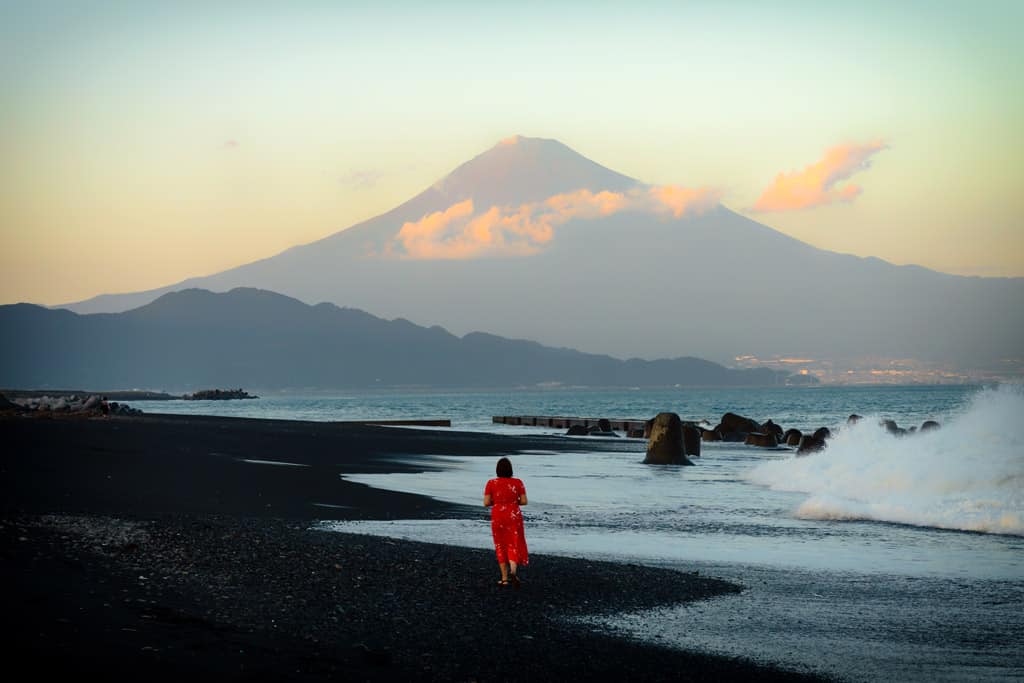
Climb/View Mt. Fuji
One of the most picturesque volcanic mountains in the world is accessible to climb, or simply view, throughout much of the year.
This is the best Mt. Fuji day trip you can find anywhere
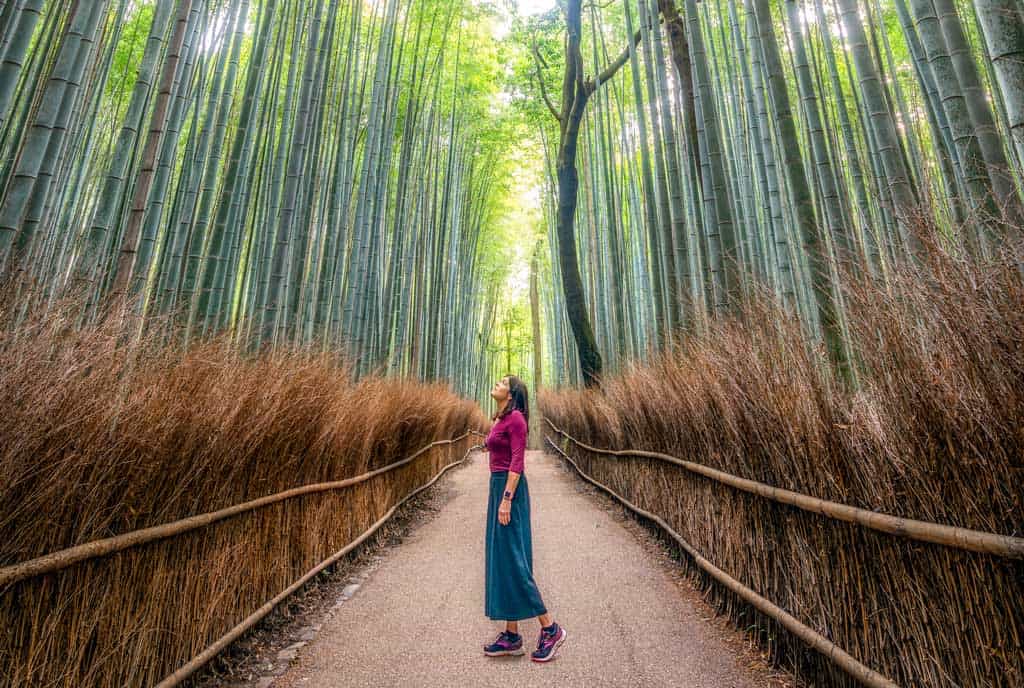
Get lost in a giant bamboo forest
Bamboo that stretches to the sky can be found in Kyoto. Be mesmerized by the sound of the swaying forest.
Other Things to do in Japan
Party with robots in Tokyo: The 90-minute show is one of the most unique and bizarre must-do activities in Tokyo. It may take you a few minutes to figure out what you’re watching (don’t miss that video of it). But you’ll definitely be glad you went!
Watch a sumo wrestling match . Sure, sushi can be found on every street corner. But eating it at every meal won’t give you a chance against world-famous sumo wrestlers. Catch a match and be a part of a long and sacred activity.
Cross the world’s busiest pedestrian intersection . Shibuya Crossing in Tokyo will blow your mind with the number of people moving at any given time when the traffic stops to let pedestrians cross. Head to the QFRONT building to watch 2,500 people cross the streets below.
Hang out with deer in Nara . The normally shy creatures are anything but shy as they can be found in abundance in Nara Park . Whether you want to interact with them, or simply view them in nature, the experience is worthwhile!
Spend the night in a capsule hotel . Japan is known for tiny packaging. A Capsule hotel is just as it sounds: a tiny box-like structure intended for one person to spend the night. Warning, this is not for the claustrophobic!
Relax in an onsen . Onsens are hot springs that can be found in natural and man-made settings. You haven’t relaxed until you’ve spent a few hours in an Onsen. Just know sometimes the dress code is your birthday suit! Check out this one in Hokkaido . Just be careful if you have tattoos, because many onsens don’t allow them.
Go diving in Okinawa . While the northern Japanese islands have a tendency to be cold, Okinawa is located in a more tropical climate and lends itself to spectacular diving. You’ll love the underwater world of these islands!
Go Kart dressed as your favourite cartoon character . If you’ve ever played Mario Kart and wondered where in the world you could go and ride around a go-kart dressed up like Mario, Yoshi, Princess Peach or your other favourite characters, this is it.
Watch the cherry trees blossom . Japan has cornered the market in cherry tree blossoms. This is so much so that every year thousands of people participate in cherry blossom festivals as the trees unload their dazzling colour across the country. If you visit Japan in spring be sure not to miss out! This particular tour is incredible as a day trip from Tokyo .
Hike with monkeys . If you enjoy hiking AND monkeys then the 30-minute hike outside of Kyoto is for you! But if you just prefer to hike and don’t want anything to do with monkeys, there are plenty of other great trails to hike in Japan!
BE SURE TO CHECK OUT THESE OTHER AMAZING THINGS TO DO IN JAPAN
READ MORE...
18 Amazing Things to Do in Kyoto at Night (2024 Guide)
The ultimate travel guide to chino in nagano, japan, the ultimate travel guide to nakatsugawa, japan (2024), the ultimate travel guide to oita, japan (2024 edition), the ultimate sado island japan travel guide [2024], best places to visit in japan.
There are plenty of amazing places to visit in Japan. Depending on your interests, trip duration and time of year you will find plenty of things to do during any length of stay.
There’s a reason Tokyo is considered one of the most incredible, vibrant, unique and fascinating cities on the planet! Where ancient meets modern, history rubs shoulder with the future and the world’s best cuisine is out in full force.
Japan’s capital and a city full of awesome things to do !
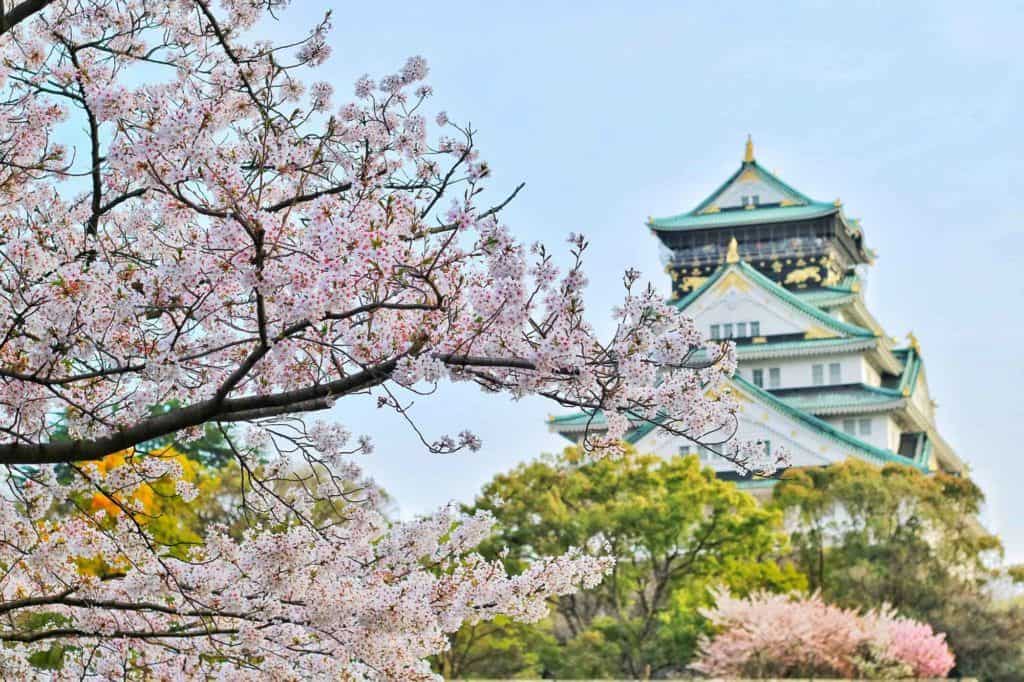
A city where ultra-modern meets ancient and you can do just about anything you can imagine.
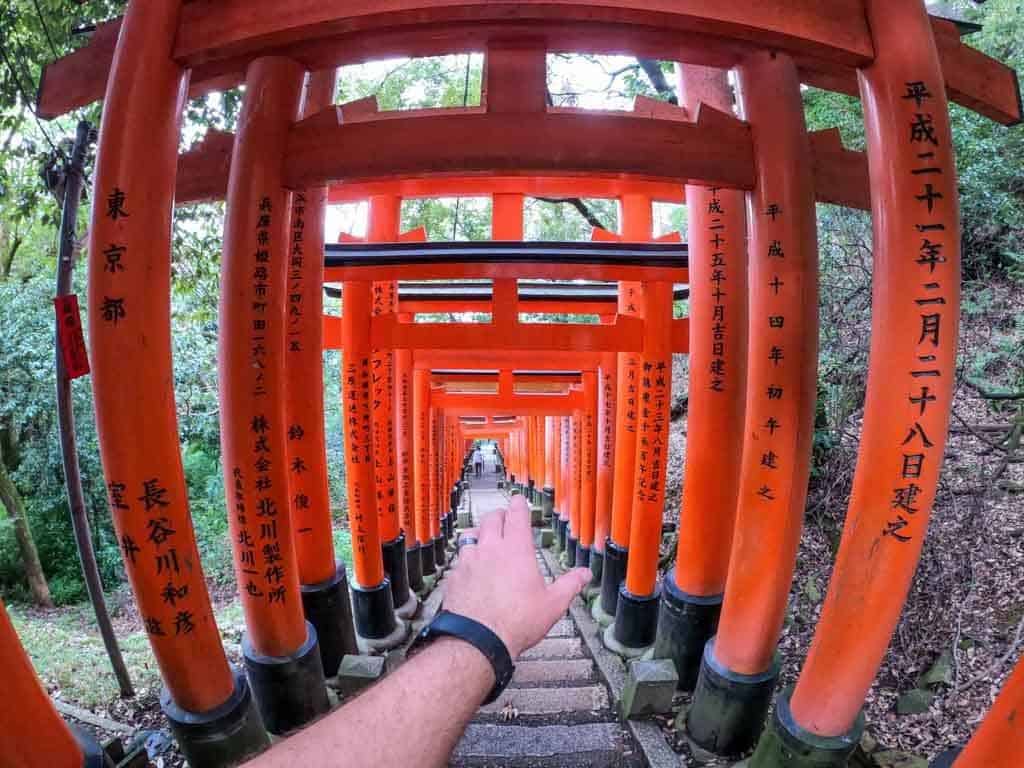
A magical place to explore Japan’s rich culture and history .
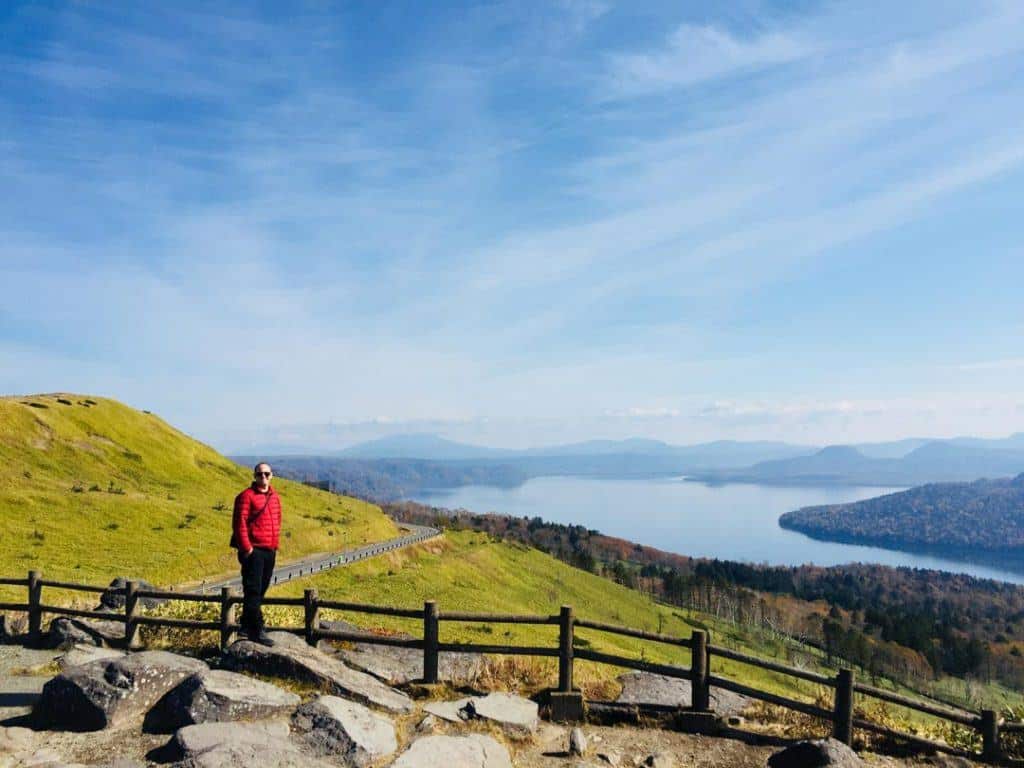
Get away from the cities and explore the gorgeous island of Hokkaido !
For more information on specific things to do in the top places to visit in Japan, reference our following city travel guides:
- 3 Day Tokyo Itinerary
- Day Trips from Tokyo
- 3 Day Kyoto Itinerary
- Day Trips From Kyoto
- 3 Day Osaka Itinerary
- Day Trips From Osaka
- 3 Day Yokohama Itinerary
- Day Trips from Yokohama
- Hokkaido itinerary
- Hokkaido activities
BE SURE TO CHECK OUT THESE OTHER AWESOME PLACES TO VISIT IN JAPAN .

BEST JAPAN TRAVEL ITINERARY
Depending on whether you are starting from scratch or have a general idea of what kind of things you would like to see and do, we’ve put together a few itineraries that are sure to leave you wanting for nothing at the end of your visit.
There are so many amazing things to do in Japan that planning an itinerary for your travel can be a little overwhelming.
In this section, we’ll not only help you plan a 1-, 2-, or 3-week Japan itinerary but also give you an overview of many of the places you might want to consider visiting and things you may want to do.
Of course, no one-size-fits-all plan will suffice. But if we were to head back to Japan these are the top places and things that we would want to do!
KEEP AN EYE OUT FOR AWESOME DAY TRIPS FROM EVERY MAJOR JAPANESE CITY
3-Week Japan Travel Itinerary Highlights
Even with a country that seems as small as Japan, three weeks is hardly enough time to get started in seeing it all!
However, with three weeks you can have a really nice time both spending more time in places many people only glance by as well as visiting some places that most people don’t see when they visit Japan.
Here’s an overview of how we’d spend 3 weeks in Japan.
2-Week Japan Travel Itinerary Highlights
With two weeks to travel to Japan, you are going to have to cut out some of the nicer places you could see with an extra week or two.
But the good news is you are still going to see and do a lot while you are here!
This is an idea of how we’d spend 2 weeks in Japan.
1-Week Japan Travel Itinerary Highlights
If you only have 1 week to visit Japan, don’t worry it is definitely worth your time. Of course, you’re going to have to pick and choose where you go and what you do much differently than if you had more time.
And you likely won’t want to spend all of your time travelling from one island to the next.
So if we had just 1 week in Japan, this is how we’d spend it.
JAPAN TRAVEL PLANNING
You’re well on your way to becoming an expert when it comes to travel to Japan! Now we’ll fill you in on the rest.
Best Time to Visit Japan
There really is no best or worst time to visit Japan. The timing of your trip all depends on what you want to see and do and how willing you are to share your Japan travel experience with other travellers.
Across the country sakura (cherry blossom) season in Spring is one of the most popular times to visit. But it happens at different times across the country due to the differences in climate from north to south along the island chain.
Another less popular, but no less stunning, time to visit is Autumn as the leaves begin to change colour.
Whilst this doesn’t quite bring in the crowds like sakura season does, the sheer array of colours on display is absolutely stunning, particularly on Japan’s most northerly island, Hokkaido.
Summer brings sweltering temperatures and typhoons in the south. However, Japan is extremely well prepared for such events. As such is still possible to travel to Japan during this of year.
Winter brings some of the world’s best skiing on Hokkaido as snow makes some roads and hiking trails impassable. However, this is also the best time to see the famous ice flows close to the Shiretoko National Park.
And, of course, it’s a great time to shred some powder if you’re looking for some world-class slopes!
Japan Travel Budget Guideline
Japan has an unfair reputation for being incredibly expensive. And whilst you could easily empty your bank account in a short time, it is possible to travel in Japan for less money than you think.
Budgeting Tips
To make your money go further here are a few tips:
1. Purchase the rail pass you need. There are a huge number of different types of rail passes available in Japan. This is your one-stop-shop for a variety of rail passes.
2. Take advantage of low-cost internal flights. You can fly affordably between most major cities.
3. Utilise convenience stores for finding cheap and delicious eats.
4. Japan has an extensive and reliable night bus service. Use it to save on travel and hotel fees.
5. Limit your alcohol intake, it’s surprisingly expensive. 1 beer = 500-600 yen (USD$5-$6).
6. Check the subway passes available in the city in which you’re staying and purchase the rail pass you need.
CHECK OUT OUR JAPAN BUDGETING GUIDE TO HELP MAKE YOUR MONEY GO FURTHER.
But there are a few things you should know about the different budgets at which you can choose to travel.
Note: Budgets shown as Single Traveller / Couples per day.
Budget Traveller ($50-60 Single / $80-110 Couples)
Hostels are the best options for single budget travellers. However, if travelling as a couple it’s often cheaper to get a private room.
There are plenty of awesome free things to do all over Japan. You will need to think outside the box and do your research but it is very possible to travel in Japan on a budget like this.
Your meals will likely come from low-cost restaurants and corner stores. And you’re likely going to spend a fair amount of time walking and taking public transportation.
Mid-Range Traveller ($60-100 Single / $120-180 Couple)
Whilst you may not get much of an upgrade on the accommodation front, travelling in this budget range will put you in the position to possibly rent a car to explore parts of Japan that are more difficult to reach.
In addition, you may be able to spend more time eating in some funky izakayas and sushi restaurants and participate in a few formal tours.
Luxury Traveller ($250+ Single / $400+ Couple)
Luxury hotels and fancy restaurants are the order of the day here. If money is no object then travelling in Japan can extremely luxurious!
For instance, you can stay in beautiful ryokans instead of hostels or hotels. And you can order a variety of different meals to enjoy while dining at some of the finer restaurants.
Of course, you’ll also be able to do more by way of renting a car and/or joining up on a variety of different tour groups to keep your itinerary completely packed.
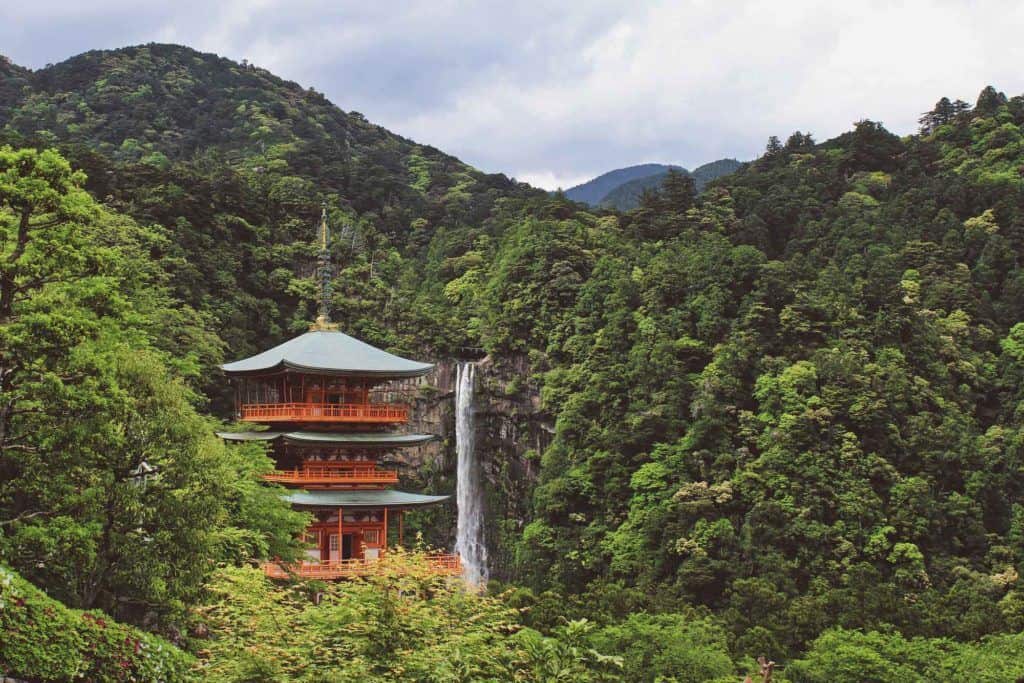
Getting To and Around Japan
Japan is an island nation, thus travelling to Japan is limited to only air or water transportation.
The majority of International Flights will take you to Tokyo’s Narita or Haneda Airport’s or Osaka International Airport. From there you will connect, as necessary, to other Japanese destinations.
Entry Requirements
Visa requirements for Japan are very straightforward.
Most travellers are visa-free and can stay for 15, 30 or 90 days depending on their nationality. For information about which countries are granted visa-free access click here.
Getting Around Japan
Travelling in Japan is both easy and convenient.
The public transport network is wide-ranging and extremely reliable. And compared to many places in the world, it can also be quite affordable.
Additionally, hiring a car is both easy and safe.
Travelling by Air
Japan has an excellent domestic air travel network. There are two passes run by JAL and ANA that will allow you to take domestic flights for around $100.
The price can sometimes vary depending on where your origin and destinations.
If you plan this effectively with other transport options available it has the potential to make your visit to Japan even more convenient and affordable.
Travelling by Car
Although the country is fairly well connected with both public and private transportation options, hiring a car is an excellent option for travelling in Japan.
The best part is that it is not as difficult as you may imagine.
Driving in Japan is safe and easy. For Hokkaido, Kyushu and Shikoku, a car is the best way to see most of each island’s most beautiful sights outside of the city centres.
Travelling by Bus
There are a number of bus companies operating in Japan. The biggest of these is Willer Bus Service.
Not only are fares convenient and affordable, but they can also help you consolidate expenses if you travel at night.
Combining overnight bus travel with a JR pass can save you a fortune as the difference in price between regional, 1 week national and 2-week national passes are huge.
Travelling by Boat/Ferry
Often the only way to access some of Japans smaller islands, particularly in the Seto Inland Sea, is by boat or ferry. Japan boasts an excellent maritime transport network.
Generally, ferries are affordable and in some cases, they are covered by a JR pass (the ferry to Miyajima being the most well-known example).
Naturally, the costs increase if you ferry a car or if you are taking a long-distance ferry.
Travelling by Train
Japan’s train network is simply incredible as it can take you from the north of Hokkaido to the south of Kyushu.
But it can also be confusing as, like with a lot of things in Japan, there is a myriad of different options available to you.
PURCHASE YOUR JR PASS TODAY
How to Maximise a JR Pass
Because your travel to Japan will very likely involve transportation on a JR line at some point, we’ve put together a few tips to help you plan your JR Pass use accordingly.
- Download Hyperdia – This amazing app allows to research train times and more importantly prices. Currently, it is free to use for 3 months (after that you will need to pay). You can work out which JR pass is the best financial option. Do note that the seat fare (sometimes two-thirds of the cost) is not optional, you will need to pay it.
- You don’t need a rail pass for your entire time. Some people may be visiting Japan for 2 weeks and will buy a 2 week nationwide JR pass. You are likely not going to be using the train every day and it’s likely you will pay more than you need to.
- Activate your JR pass at the right time. To activate you pass you will need to go to the station and inform them of when you want to activate it. Make sure you activate it when you really need it so you can get the most out of it.
- Check out the regional passes. There are numerous regional passes available that are much cheaper, but they cover a smaller area and don’t last as long. However, they can be a fantastic option. Combining such passes with night bus services can save you plenty of money.
Apps and Technology
Japan is definitely well connected when it comes to technology.
When you visit Japan you are likely going to want to remain connected to the outside world as well as take advantage of mobile apps that make travelling through Japan a little easier.
Here are a few we think you should definitely acquaint yourself with prior to your travels:
- Hyperdia – Hyperdia is the premiere app for helping you to understand the transportation system in Japan. Find the right rail line, station and even schedules to help navigate what could otherwise be a complicated transportation system.
- XE Currency – Transfer, monitor and calculate currency as the need arises. This app may not be totally necessary as you are typically tied into rates the banks charge for services. But it is handy to have around.
- Express VPN – This will protect your sensitive information wherever you travel – not just in Japan. Be sure to have this to keep your online information secure as you travel.
- GuruNavi – This app will help you to find food options in whatever prefecture you happen to be at the moment. You can search through different types of cuisine as well as to filter your selections for things like English-speaking staff and WiFi availability.
- Google Translate – Even if you don’t know more than a handful of Japanese words, iTranslate will help you communicate as you travel in Japan.
Best Things to Eat in Japan
Japanese cuisine is justifiably one of the worlds popular. It focuses heavily on high-quality ingredients and as a result portion sizes are smaller than you may expect.
Although fried dishes are common in Japanese cuisine, Japan has the lowest rate of childhood and adult obesity amongst the OECD nations.
This is down to a mixture of smaller portions and a culture that promotes restraint and health.
Yakiniku: Japanese BBQ. These restaurants can be found all over Japan, and it is very rare that they are anything other than delicious. Many offer time based all you can eat/drink deals. Look out for the characters 放题 as they usually don’t advertise this in any language other than Japanese.
Katsu Curry: Fried chicken or pork cutlets smothered in Japanese curry. Heaven on a plate.
Kushikatsu: All manner of meat and veg skewered and deep-fried.
Sushi and Sashimi: This can go from cheap to eye-watering expensive. Conveyor belt sushi restaurants offer the cheapest prices. Be brave and try delicacies like sea urchin, horse or chicken sashimi.
Sukiyaki: Meat and vegetables cooked in a hot pot with a small amount of water and soy sauce.
Ramen: The nations most popular noodle dish, often an excellent budget option.
Gyoza: Pan-fried dumplings, often filled with pork.
There is certainly much more available than this, but hopefully this gives you a quick overview.
Convenience Stores: For budget eating options convenience stores like lawsons, family mart and 7-11 are often an excellent option for a cheap and hearty meal!
Izakaya : No mention of eating in Japan would be complete without mentioning Japan’s most famous eating places; the Izakaya (居酒屋).
An izakaya is a Japanese pub that is generally a place where friends, colleagues and family members will go to eat, drink and chat.
The huge menus consist of small plates that are shared amongst the group. Expect to find sashimi, yakitori, cold dishes, salads, fried dishes and desserts.
ACCOMMODATION IN JAPAN
Japan has a huge range of accommodation options. The most obvious difference is whether it’s a Japanese or western style room.
In Japanese style rooms, you will be sleeping on tatami mats on the floor, which are actually incredibly comfortable.
This option is far more common outside of popular tourist destinations. Western-style rooms have regular beds.
Many single rooms in hostels, guesthouses or hotels will have bunk beds to fit more people. This will usually be stated when booking.
It is not always the most romantic option but it does help you get more bang for your buck.
Types of Accommodations
Whilst hostels exist in Japan, they are not as cheap South East Asia. There is a reasonably good hostel network throughout Japan. But hostels are not as common or widespread as in other popular travel destinations.
If travelling in Japan as a couple or pair, a hotel room is often cheaper than 2 beds in a dorm. It’s always worth comparing, hostels are not always the cheapest option when there’s more than one of you.
Western-Style Hotels
These will be the traditional hotels that you would find in most places in the world.
They include major Japanese and international brands and are more common in larger cities.
You can expect amenities and comfort similar to those you’d find in other destinations.
Capsule Hotels
A unique way to spend a night or two in Japan is in a capsule hotel. As the name suggests, these are small enclosed spaces usually only large enough for a bed.
Sometimes you will have a television and a small storage space. But more often you can expect to have to stash your gear in a locker. You’ll also, obviously, be using shared restrooms.
Traditional Japanese Ryokans offer luxurious stays in often gorgeous accommodation and locations. However, they can sometimes be very expensive.
It’s not uncommon for Ryokans to have an onsen. But if you want an authentic Japanese overnight experience you won’t find anything that surpasses a stay in a Ryokan.
Another good option in recent years is AirBnB, and there are more and more amazing places popping up to stay for very affordable prices every day.
As is typical in many destinations where Airbnb accommodations are popping up, you’ll likely find great value and a little more personal space with an Airbnb stay.
Onsen Hotels
Last, but by no means least; Onsen Hotels. In short, these are hotels that have an onsen attached.
They cover a wide variety of budgets but often they are not the cheapest options available.
However, the luxury of being able to have an onsen whenever you want is well worth it.
Just note that with onsens there are some basic rules to follow. These will often clearly displayed, but here they are:
- You must be completely naked – no bathing suits. Leave awkward at the door, with your clothes.
- Do not put your towel into the onsen water. Most people wrap it around their head.
- Shower before you enter the onsen, taking care to splash others with your shower water.
Or, if you’d like to check out a few options on your own here are a few resources to get you started!
JAPAN TRAVEL TIPS
Travelling in Japan can definitely be rewarding. But it can also be a bit of a headache – especially if your knowledge of the Japanese language and culture is limited.
Further, not being prepared for adventure can hamper your optimism as well.
Imagine you’re all set for your day of walking around majestic Kyoto and you failed to pack an umbrella or raincoat.
Of course, you have your own reasons for travelling to Japan. So likely you know whether you plan to dive in Okinawa or climb Mt. Fuji.
But for everything else in your journey, let us remind you of a few travel tips for Japan to make your adventure safer, more enjoyable and more affordable.
General Japan Travel Tips
While there are many basic travel tips we suggest you use when travelling to Japan, there are also plenty of Japanese-specific tips that will make your visit the best it can be.
Here are a few we recommend you consider as you plan your trip to visit Japan:
1. Research Cultural Norms and Behaviour
Japan is a country with a very strong national identity and behaviour. Breaking these behavioural norms is most definitely frowned upon.
Here are a few basic Japanese cultural expectations:
- Do not talk loudly or answer your phone on the subway, bus or train.
- Do not eat on the above.
- Walking and eating are sometimes frowned upon.
- Stand on the left-hand side of an escalator.
- Follow the rules in an onsen.
- Do not litter – Japan is immaculately clean.
If you’re not sure if something is ok, just ask.
Many Japanese people know that foreigners are unlikely to be aware of Japanese norms and expectations and will be happy to help you.
2. Eat, Eat, Eat.
Japanese food tastes so much better in Japan. Take the opportunity to try things that you are very unlikely to find in your home country.
3. International Drivers Permit
If you plan on renting a car in Japan you MUST have this document.
Without it not only will you be unable to rent a car, but you also will not be given a refund if you have already paid.
4. Take your own chopsticks
Single-use chopsticks are the norm in Japan. Take your own and do a little bit for the planet.
5. Do your research
A bit of planning and research does make a real difference, especially for utilising public transport. Getting a handle on this will leave you in the best place to get the most out of your trip.
6. Show respect and places of worship:
All temples and shrines will have rules and guidelines clearly displayed in English or with pictures, yet some people are still not able to understand them. Don’t be one of those travellers that give everyone else a bad name.
7. Remove your shoes
This is common everywhere in Japan. In some cases, you may need to remove them before entering the lobby of a hotel.
However, it is more common that you are expected to leave your shoes in the coves next to the door of your hotel room. This is especially common in more traditional Japanese hotels.
8. Embrace Japanese toilets
The gadgets available in Japanese bathrooms are the stuff of legend. Soft music can be played so no-one can hear you doing your business, seats can be warmed on cold winter mornings and the variety of spray options will leave you feeling as clean as a whistle.
Japan Packing List
We always travel with a core packing list wherever we go. And when it comes to Japan, many factors will affect what else you need to bring along with you.
Check out our travel essentials and be sure to add any of the other additional items listed below.
TRAVEL INSURANCE. SIMPLE & FLEXIBLE.
Which countries or regions are you traveling to, what’s your country of residence, enter traveler’s age, staying safe in japan.
Japan is a relatively safe country in which to travel.
Clearly you should always practice some basic safety guidelines no matter where in the world you travel.
- Keep copies of your passport and financial documents in the event they are lost or stolen.
- Don’t be flashy with expensive items or cash. You’re not very likely to be targeted as a tourist in Japan. But this would surely set you apart.
- Avoid travelling alone at night. Call a taxi or Uber in advance and wait inside the venue until it arrives.
- Be aware of your surroundings, particularly if you’ve had a night out drinking.
- Keep your personal items close. Pickpocketing is about as bad as you can expect in Japan, so make sure your purse, wallet and phone, etc are secure particularly when travelling in crowded public transportation.
We won’t bore you with a more extensive list. Unless this is your first trip out of your home country you’ll be better off when you travel in Japan than many other places in the world.
If this is your first trip, congratulations!
If you practice many of the same common-sense habits you would at home, then you’ll be quite safe and enjoy your time in Japan.
Staying Connected in Japan
Japan is an ultra-modern country, particularly when it comes to technology. Thus staying connected when you travel to Japan will be no issue.
Of course, like any place in the world, the further you go away from metropolitan areas the more you can expect slow to no-service in areas.
For phone and data service, first check with your local cellular carrier to determine if your current plan will cover you when you travel to Japan.
In many cases, carriers have expanded their international coverage to popular places such as Japan.
If not, they will likely have a very expensive option for you to purchase on a daily/weekly basis.
We feel like your money will go a lot further if you consider a few other options.
Purchase a SIM Card
First and foremost is to pick up a local SIM card upon arrival in Japan. You will need to make sure that your device is unlocked before you can switch SIM cards.
However, this will be a reasonably inexpensive and fairly common way to access Japanese cellular networks without paying outrageous international travelling fees through your home carrier.
Rent a Portable WiFi Device
A second option would be to rent a portable WiFi device that will allow you a certain amount of data/service over a set period of time.
These are relatively affordable compared to most cellular plans’ international options.
You’ll typically have to pick these up from central locations such as the airport or train station. But it’s likely you’ll be passing through here anyway.
Access Free WiFI
And finally, you could always just ensure that your device is on aeroplane mode and then hop from one WiFi hotspot to another.
Plenty of places in the towns and cities you will visit will offer WiFi.
From restaurants, hotels, railway and train stations and even some public spaces, you’ll find many venues that will cater to your need to stay connected.
Be a Responsible Traveller in Japan
Being a responsible traveller in Japan is important on many levels.
First, you represent yourself wherever you travel.
Nobody likes a jerk – especially people minding their own business in their own country.
Taking the time to learn about Japanese customs and culture will help you understand how you can be more responsible when you travel to the country.
Second, you represent your home country and other travellers. If you act or say things that reflect poorly on yourself while travelling in Japan then these actions also reflect poorly on other travellers.
While stereotypes suck – the truth is that most people form opinions based on first experiences. So let’s try to make your interactions with others positive while travelling in Japan.
Additionally, the resources of the world are limited.
Even though you might have certain customs or routines back in your home country does not mean you need to extend them when you travel to Japan.
For instance, carrying a reusable water bottle is loads more responsible as a traveller – although you may not think twice about using disposable bottles back home.
Key Japanese Travel Phrases
You don’t have to be fluent in Japanese to have a great time when you travel to Japan. But it does help to know a few key phrases.
This will not only assist you in your travels but it will also show respect to the local Japanese people that you are doing your best to assimilate into their culture.
Books To Read About Japan
Maybe you already know everything about Japan. Chances are you don’t!
But even if you are well-read, here are a few suggestions that might be worth your time while you’re on the plane to Japan.
A Geek in Japan . A fascinating read that takes you into the heart of understanding Japanese culture. This is a top pick among most Japan travellers.
Memoirs of a Geisha . Perhaps the. most well-known book in recent times thanks to its popularity as a movie. The historical fiction follows the story of a young woman thrust into the life of a geisha.
Rice Noodle Fish . A creative way of exploring Japan from a culinary standpoint. Tantalizing pictures of delicious food accompanies the personal story and in-depth information about some of Japan’s best eats.
Hokkaido Highway Blues . Follow a hilarious and entertaining journey by the author to traverse Japan in stride with the cherry blossoms. Meet a cross-section of Japanese culture through the lens of the author.
BOOKING RESOURCES
I know, I know – we’ve already mentioned these resources a bunch in this travel guide.
But here’s the thing… we know you’re going to want and need these resources to help you save money and have a more enjoyable trip
Table of Contents
Read our vietnam posts, ryokan ochiairo review – is this japan’s best ryokan, budget travel in japan – ultimate backpacking guide [2024], 25 awesome things to do in tokyo, japan, 7 best day trips from osaka, japan (2024 travel guide).
Traveling Canucks
Canada Family Travel Blog
25 Japan travel tips for first time visitors
06/01/2023 By Traveling Canucks 3 Comments Categories: Japan Popular Tokyo Travel Stories Trip Ideas
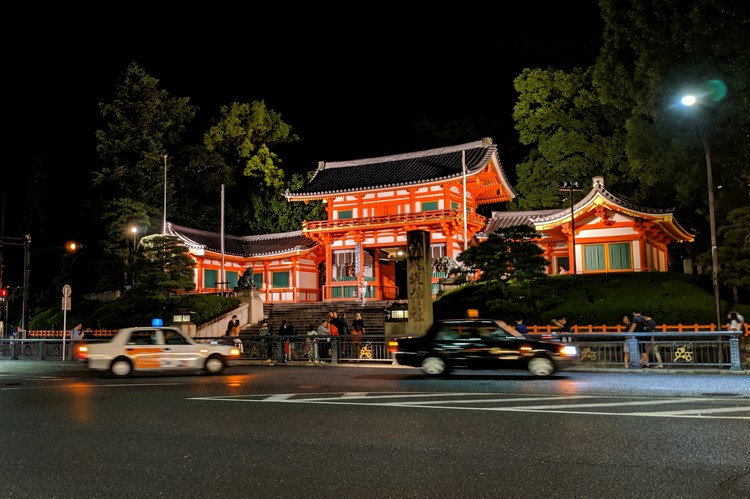
Japan travel tips for first time visitors
Japan can be a culture shock to the senses for first time visitors. There’s a lot of things to know before traveling to Japan, so today’s blog post shares a few useful Japan travel trips.
Japan is easily one of our favourite travel destinations in the world. It’s unlike anywhere else. The people, the food, the culture, the quirkiness, the architecture, the history, the World Heritage Sites.
Simply put, Japan has everything you want in travel destination.
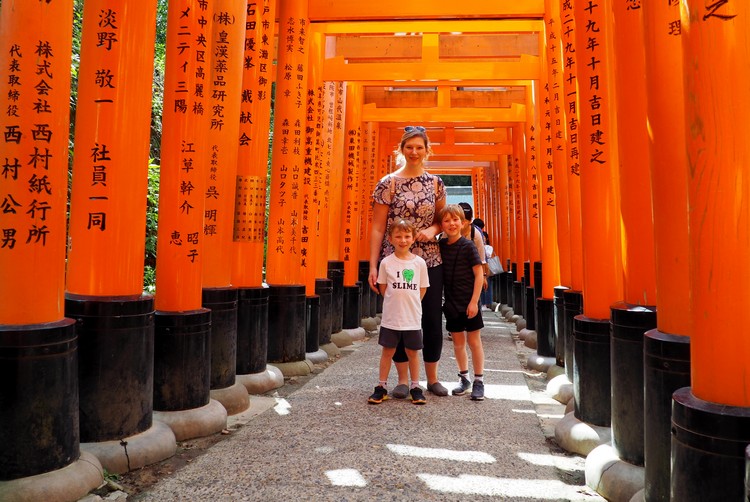
Japan travel tips for first timers
To give you a little context, the purpose for us traveling to Japan was to attend the Rugby World Cup . We spent a total of 15 days in Japan, visiting Tokyo, Kyoto, Kobe, and Shizuoka.
We visited Japan 10 years ago, before having kids, so this trip included a few new destinations and activities, like visiting Tokyo Disneyland . Read about our experience at Tokyo Disney Resort .
On our previous trip, we visited the aforementioned cities plus Osaka, Nara, Hiroshima, Yokohama and Narita, which is a lot of travel for two weeks. Too much, actually. This recent trip was much slower. We enjoy the slower pace and find it’s more suitable for family travel.
More posts from our trips to Japan:
- Beginners Guide to Food in Japan for first time visitors
- 50 Photos of Kyoto that will inspire you to visit
- 15 Things to do in Kobe, Japan
- How to spend 3 days in Tokyo: Travel guide for first time visitors
- Staying at Tokyo Disney Resort – what you need to know
- 100 Photos of Tokyo Disneyland, Japan
This Japan travel blog shares what you need to know before your Japan vacation. We share practical travel tips for your first trip to Japan, including the dos and don’ts for tourists in Japan.
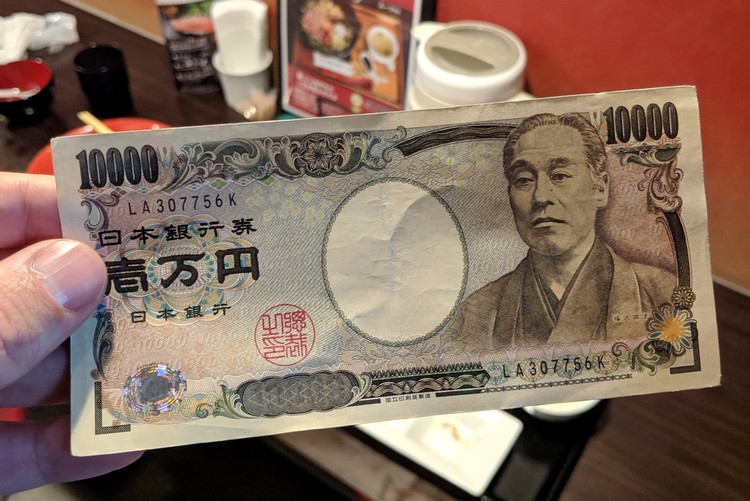
1. Cash is still king in Japan
Surprisingly, cash is still the preferred method of payment in japan..
Most convenience stores, like Family Mart, 7 Eleven and Lawson, accept debit and credit cards. And most restaurants in touristy areas will also accept credit cards, but many restaurants, cafes and shops still only accept cash.
Before you sit down at a restaurant, it’s wise to ask if they accepts debit or credit cards. If the restaurant does accept plastic, use your cards and save your cash for later. You’ll be glad you did.
You will find ATM’s scattered throughout the cities. They are relatively easy to find. We typically got cash from the ATM’s at the 7 Eleven convenience stores and at the train stations.
Most ATM machines will limit your withdrawal to 50,000 Yen, which is approx. $600 CAD or $460 USD. We took the max withdrawal each time to avoid unnecessary international bank charge. Bank fees range from $2 CAD to as high as $20 CAD per transaction, plus the ATM fee.
It’s wise to bring at least 50,000 Yen with you. Your bank may need to order Yen, as it’s not widely held at Canadian banks, so it’s best to do this a few weeks before your departure date.
Avoid converting your currency at the airport. The conversion rates are terrible.
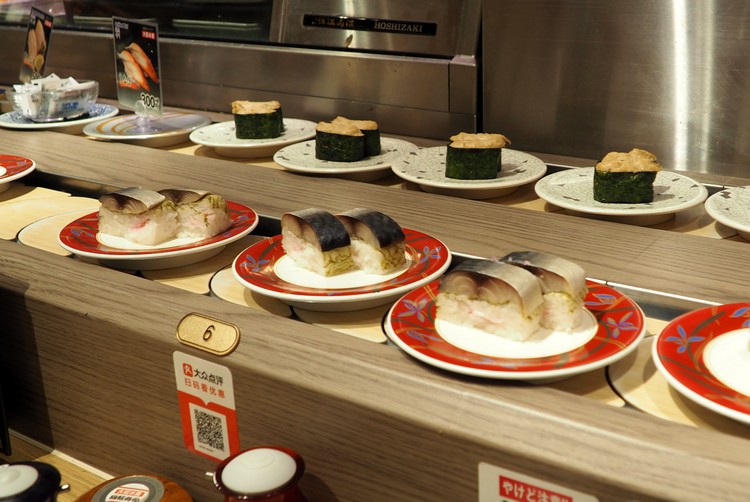
2. Soy Sauce is not widely used
Our first lost-in-translation moment in japan happened at a restaurant when we tried to order soy sauce..
Our boys love white rice. They also love to dump soy sauce all over their rice. We assumed soy sauce was widely used in Japan and that we’d find it at most restaurants.
This was an incorrect assumption.
When we ordered soy sauce at a restaurant (to be clear, this was NOT a sushi restaurant), the server looked very confused. We did the typical hand gestures and talked slower, but she was not picking up what we were putting down.
I Googled soy sauce images on my phone and showed them to her. She smiled and nodded.
Yes, we did it! We navigated our first awkward language encounter.
Nope. Wrong again.
She brought us Worcestershire shire sauce instead. I assumed the black sauce was soy sauce, so I put it all over the rice. Both boys made funny faces and said the rice was bad. They were not impressed.
Confused, I tried the rice. This is when I realized the error.
Have you ever tried rice with Worcestershire sauce all over it? It’s really, really bad. Don’t do it.
That said, you will find soy sauce at sushi restaurants.
We eat sushi all the time in Vancouver . At least once per week, for years. We thought we knew the correct way to eat sushi, but we were wrong. How did we not know this before going going to Japan?
Here’s an etiquette guide for how to eat sushi the correct way .
Apparently, the golden rules are: (1) don’t stick your chopsticks upright in the rice; (2) don’t cut a piece of sushi in half with your chopsticks; and (3) don’t mix wasabi in your soy sauce.
There are a lot of things to know about Japanese culture. Most people will forgive foreigners for not knowing proper Japanese customs and etiquette, so long as you’re respectful, quiet and polite.
Related reading – Quick guide to eating in Japan
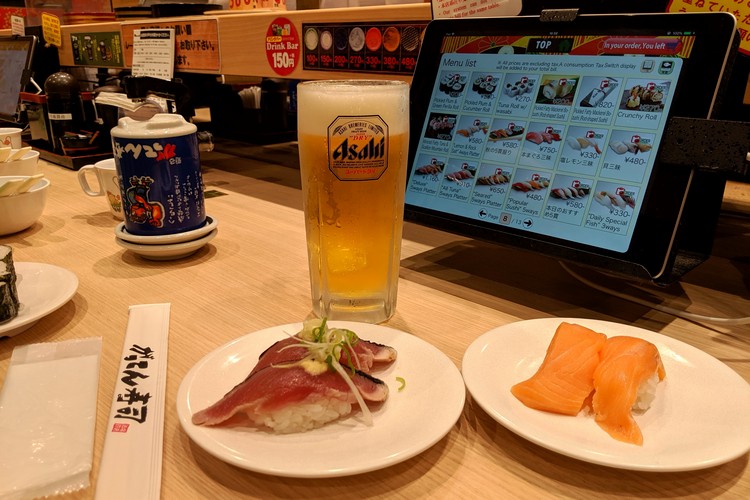
Above – Nigiri sushi at a conveyor best sushi restaurant in Tokyo.
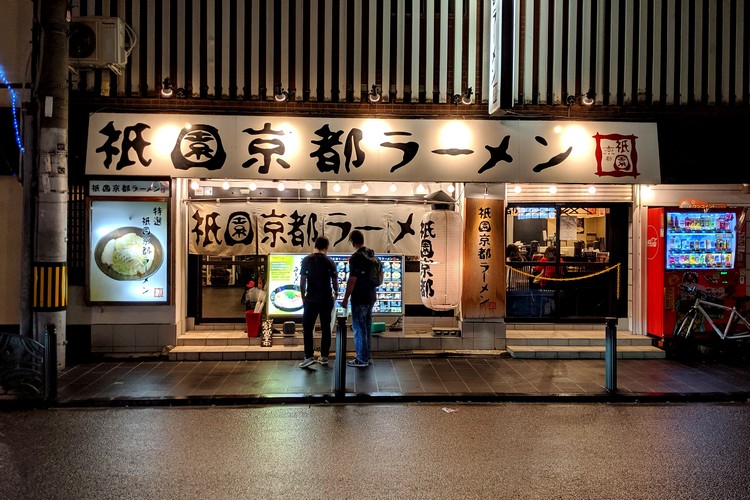
3. Download the Google translate app
The soy sauce fail mentioned above could have easily been avoided.
The answer = Google Translate.
We can usually navigate language barriers by learning a few basic words. But here’s the challenge with Japan – we can’t read the characters. We can’t see patterns or memorize words because we only see shapes and lines.
If you don’t already use Google translate when you travel, you should.
When we tweeted about our lost in translation moment , a few people sent us messages saying, “Why aren’t you using Google Translate?” Great question! We felt a little dumb.
It’s free, it’s easy and it works like a charm. If you’re nervous about visiting Tokyo without knowing Japanese, Google Translate will act as your Japan tourist guide.
Download the app from Google Play or Apple Store .

4. Save time – get a Suica Card
The Suica Card is a prepaid smart card that allows you to use most public transport (metro, trains, buses, monorail). Initially, these convenient transit cards could only be used in Tokyo; however, Suica cards are now usable at most train stations in Japan. Using a Suica Card is the best way to travel in Tokyo.
Here’s a map of where you can use Suica Cards .
You can purchase Suica Cards at most train stations using the electronic vending machines pictured above. Suica Cards allow you to avoid purchasing tickets from machines before each ride.
You can also order Suica Cards online and have them mailed to your house prior to your trip. That’s what we did. We were unsure about the process to purchase Suica cards at train stations, so we decided to get them ahead of time, to avoid confusion.
In hindsight, this was unnecessary. It’s just as easy to buy Suica cards when you get to Japan.
How to use Suica Card in Japan
Once you purchase your Suica Card, and add money to the card, head to the turnstiles that say IC Card or Suica Card. You simply tap the Suica Card at the turnstile and pass through the gate once it opens – see photo below.
When you arrive at your destination, you tap the card again to exit the station. Suica automatically calculates and deducts the fare owed for the trip.
Things to know about Suica Card
- Prices include a deposit of 500 yen. The difference between the adult’s card and child’s card is the amount deducted when using transportation.
- Suica Cards can be loaded up to a maximum of 20,000 yen at Automatic Ticket Vending Machines and Fare Adjustment Machines displaying the Suica mark.
- Only yen may be used to load a card. A credit card cannot be used to load a Suica.
- Suica card does not work on express trains, shinkansen, long distance buses (highway buses) or airport shuttles.
- You can use your Suica to make purchases onboard trains as well as from vending machines, to rent coin lockers and for spending at convenience stores and restaurants.
Credit source – the above bullet points were copied directly from the JR East website .
Children under 5 years old travel for free when accompanied by an adult.
This is not widely advertised to foreigners. We purchased 4 x Suica Cards and used them for a few days before it was time to reload (we spent 2,000 yen per card – which is about $25 CAD). A friendly ticket agent at the train station informed us that Connor, who was 5 years old at the time, was able to ride for free.
Children 6 to 11 years old pay 50% of the adult fare.
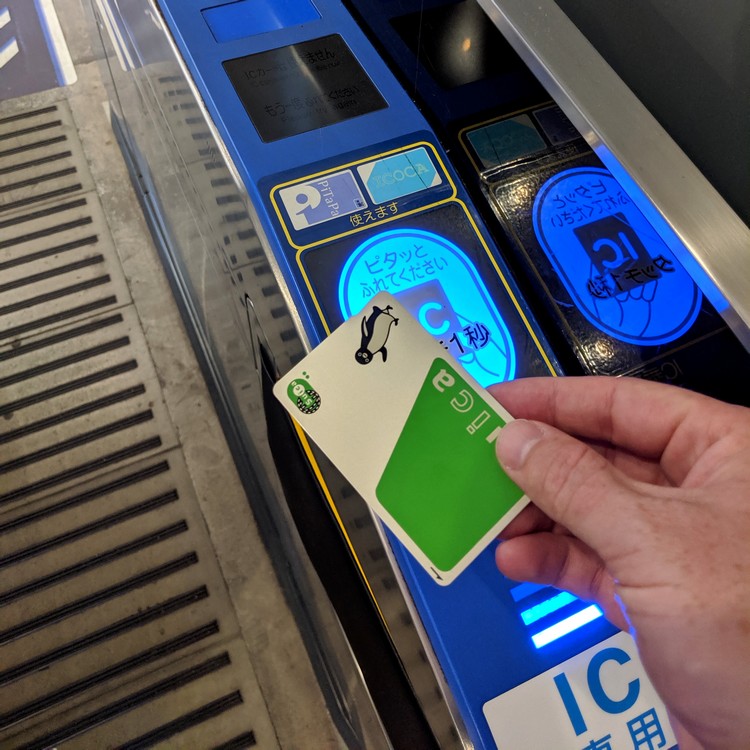
Related – Our experience at 2019 Rugby World Cup in Japan
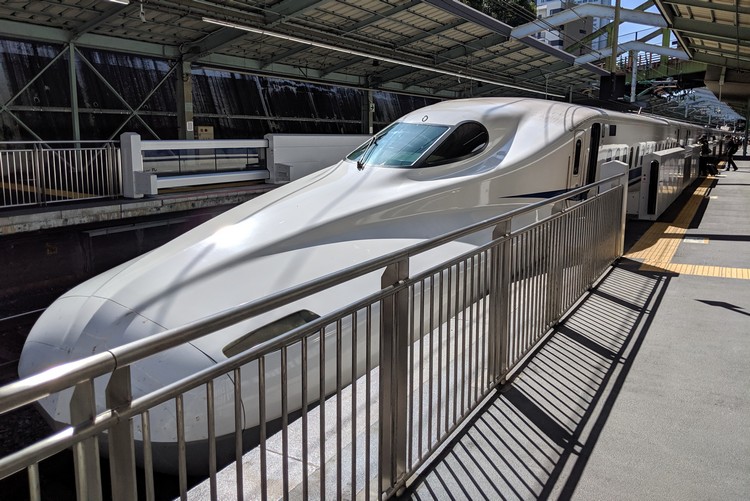
5. You don’t have to get a JR Pass
Almost every japan travel tips post we’ve read states you should get a japan rail pass..
We’re not convinced the JR Pass is an essential purchase for first time visitors. While the JR Rail Pass (Japan Rail Pass) does have many benefits, especially if you plan to cover a lot of ground in a short period of time, it might not actually be the right fit for your Japan trip.
If you plan to travel slow and spend time in big cities, like Kyoto, Osaka, Kobe and Tokyo, it might make more sense to skip the JR Pass and opt for one way train tickets.
For shorter distances, like Kyoto to Osaka, you don’t actually need to take the Shinkansen train . Instead, you can take local trains, which are cheaper and not that much longer.
Research Shinkansen ticket prices here .
We mapped out our Japan itinerary and priced out each segment. Trains are the best way to get around Japan, so we did the math and realized it was cheaper for us to purchase one way tickets.
Our Japan trip was 15 days, so we would need to purchase the 14 day JR Rail Pass. The price for the 14 day JR Pass is $576 per adult and $288 per child, as of October 2019. By purchasing individual segments, we saved about $100 per adult and $50 per child.
Not huge savings, but enough to make us skip the JR Pass.
Most of our time was spent visiting Tokyo, Kyoto and Kobe, so we used our Suica Card to ride subways and local trains (most subways are not covered by the JR Pass).
If you’re only spending one week in Japan, the JR Pass might make sense for your Japan vacation.
Research the JR Pass here and use the Japan Rail itinerary planner.
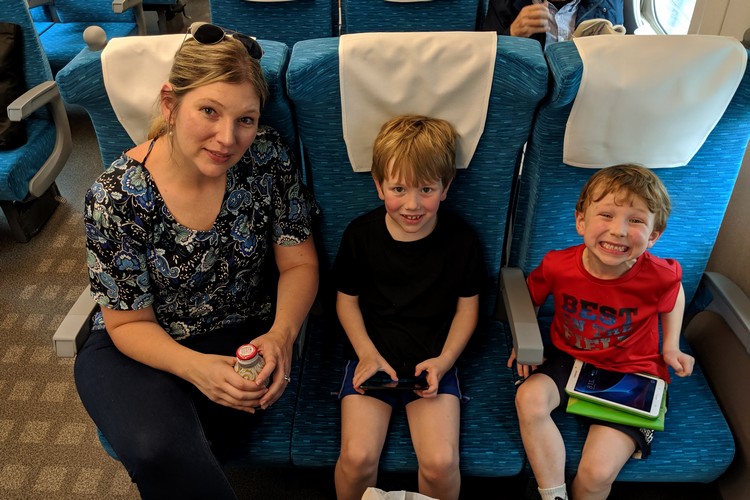
Shinkansen seat reservations
To make Shinkansen seat reservations, which is recommended during busy travel times, you must see a ticket agent at the train station. So, you’re not really saving time by having the JR Pass.
Now, keep in mind, we were traveling with 2 young boys, so it’s important that our seats are side by side. If you’re traveling solo or you don’t mind sitting alone, you likely won’t need reservations and you can wing it. That was not an option for us.
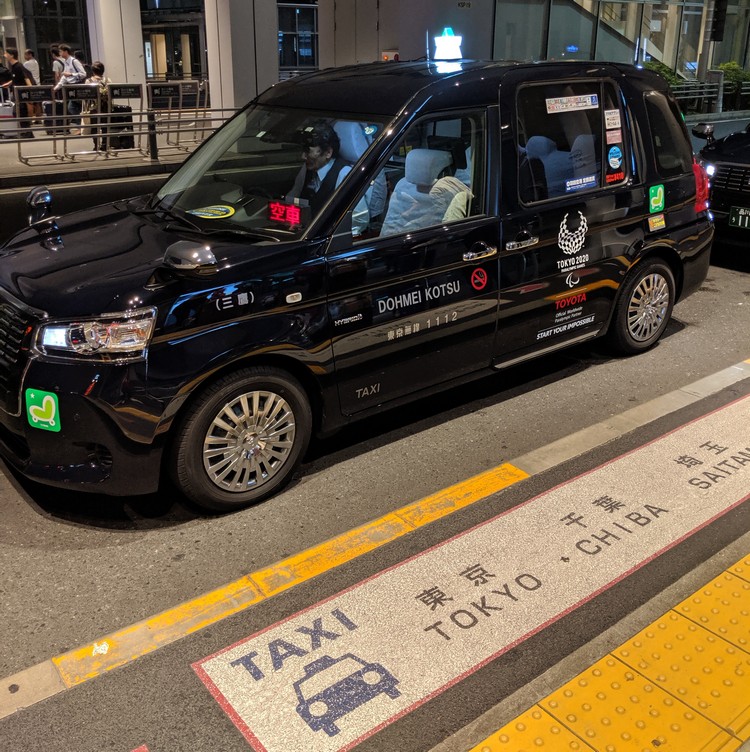
6. Taxis are expensive. Avoid if you can.
Taxis in Japan are expensive. We knew this before arriving, but it still surprised us when we took an airport taxi from Tokyo Haneda Airport to Sheraton Tokyo Bay Hotel at Tokyo Disneyland .
The distance from the airport to hotel is 25 km and it takes about 30 minutes.
After currency conversion from Japanese yen to Canadian dollar, the price was almost $100 CAD. That felt expensive to us. For perspective, a similar distance in Vancouver costs around $50-$60 CAD, depending on traffic. Vancouver is also an expensive city, so it’s a relative comparison.
Now, to give the taxi experience some credit, the cars are impeccably clean and comfortable. Taxi drivers are helpful and they even wear clean white gloves. So, while taxis are an expensive option, they do offer a comfortable and convenient white glove treatment – literally.
Traveling to Tokyo? Read: How to spend 3 days in Tokyo
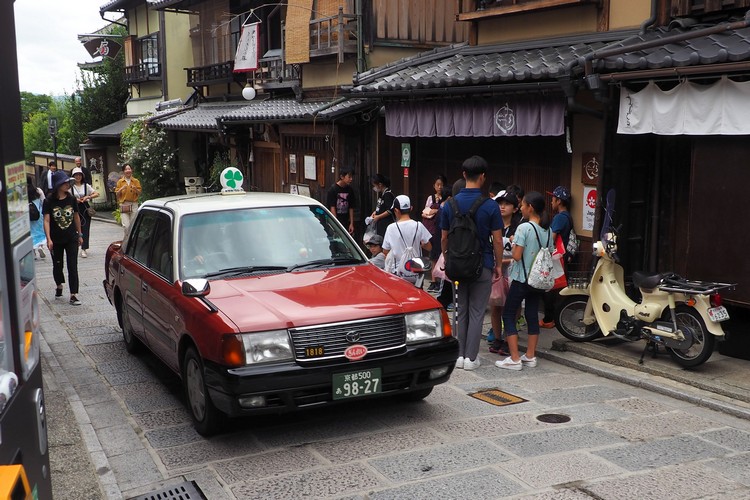
7. There is Uber in Japan – but it’s different
Yes, japan has uber, but it’s mostly limited to big cities, like tokyo and kyoto..
However, it’s not widely used by locals because the train system is so convenient. Most people use Uber for airport pickup and dropoff, rather than for intercity transportation.
We took an Uber in Tokyo and Kyoto.
The Uber app syncs just like it does in North America, so you don’t need to worry about downloading a different app. This means you can input your destination in English, which avoids confusion and language barriers (many taxi drivers do not speak English).
Uber rides in Japan are basically like taxis. The cars actually look like taxis, too.
We like that fares are automatically paid for with the credit card on our account, so we don’t have to use cash or wait for change. Uber fares are generally cheaper than taxis and the app gives a maximum fare for the trip. We like this feature – it gives us peace of mind that we’re not being overcharged.
A downside to Uber in Japan is that there aren’t as many drivers (when compared to North America), so you end up waiting longer than if you flagged a taxi. In Kyoto, it took 20 minutes for our driver to pick us up. To be fair, it was during rush hour and the traffic was bad, but we saw dozens of taxis pass us by while we were waiting.
If you don’t like Uber, or you’re having problems with the app, you can also use the JapanTaxi App . We’re told this platform is relatively new and it connects with multiple taxi companies.
Related – Staying a Tokyo Disney Resort? Read our review .
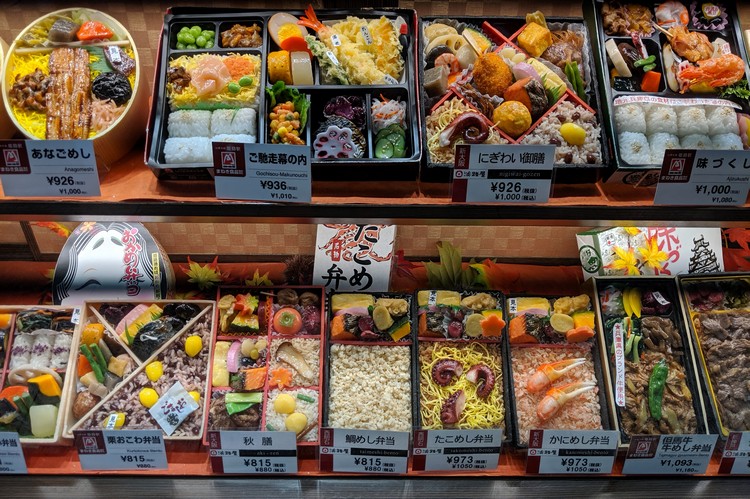
8. Most restaurants have plastic food displays
You don’t have to worry about ordering food from restaurant menus that are in Japanese. Most restaurants in Japan have plastic replicas of their food on display, especially restaurants located near train stations, shopping areas and tourist zones.
We love this! It takes away the confusion about what you’re ordering and removes language barriers. When in doubt, just point to the dish you want.
Most restaurant menus also have photos of the available dishes.
Related – Beginner’s Guide to Eating Food in Japan
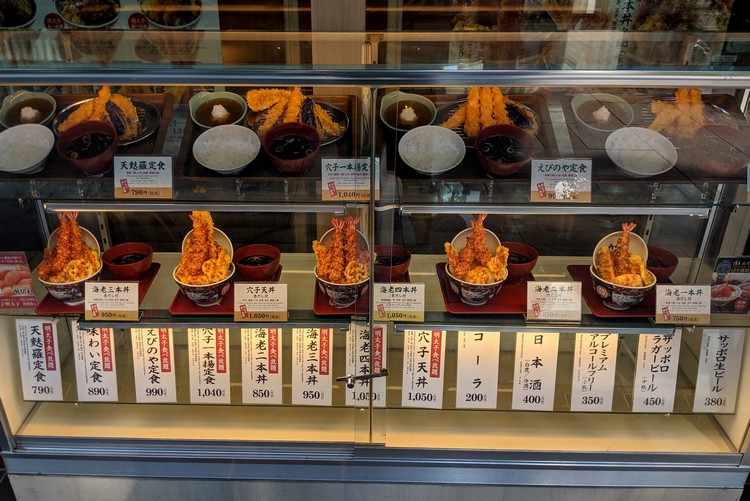
Do you have Japan travel tips? Leave us a comment below.
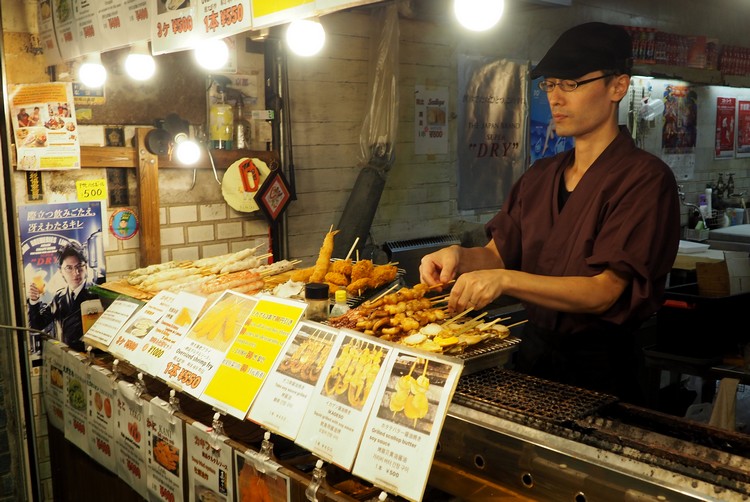
9. Don’t walk and eat in Japan
In Japan, it is considered rude to walk and eat at the same time. If you purchase food to go, the expectation is that you will NOT walk down the street while eating your food.
This applies to food purchased at convenient stores, like 7 Eleven and Family Mart, as well as food purchased from street vendors or yatai stalls .
It is acceptable to eat at the place of purchase (see photo below) or just outside the store. There’s usually a designated area for eating. Benches or seats in parks or public spaces are generally okay to eat on, but avoid eating messy or strong smelling foods.
Eating on public transit is not allowed. Don’t be that tourist.

Above – a yatai selling quick bites at the Nishiki Market in Kyoto.
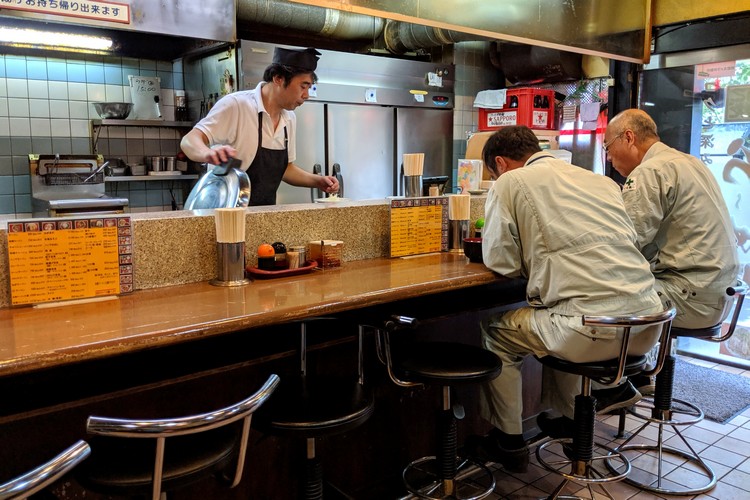
10. Do NOT tip at restaurants
One of the most common questions for first time visitors is – do you tip in Japan?
Tipping is not expected in Japan. In some cases, it’s actually considered to be rude.
We made this mistake on our first trip to Tokyo. We left a generous tip and the server chased us down the street to give us back our change. He was not impressed, either.
This is one of the best Japan travel tips we can give – do NOT tip in Japan.
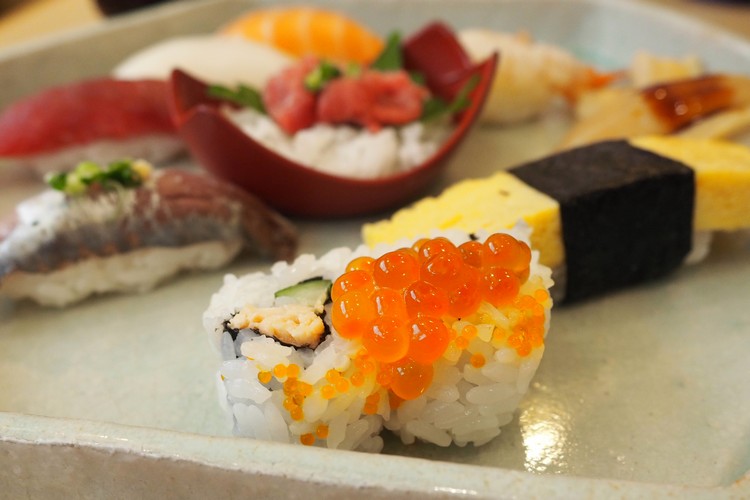
Related: 50 Photos of Kyoto that will inspire you to visit
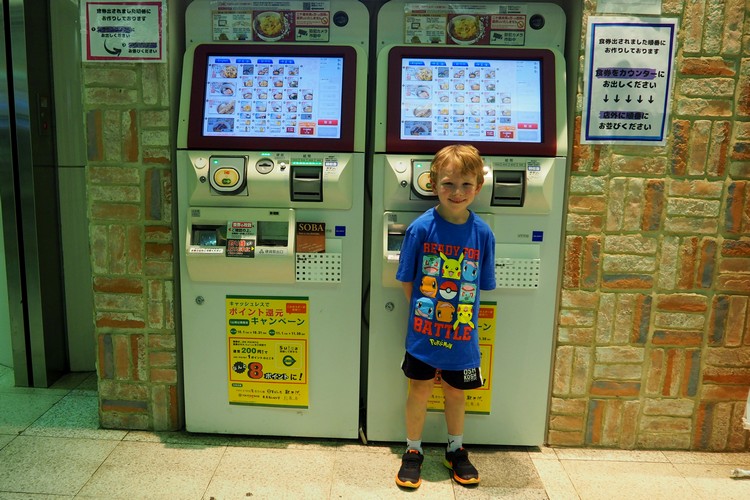
11. Order your lunch from a vending machine
One of the things we love about Japan is that everything is efficient and convenient. A perfect example of this efficiency is the electronic vending machines located outside many restaurants.
The touch screen machines often have photos of each dish, which is convenient and avoids the potential language barrier that may arise if you had to order from a server who does not speak English.
The process is simple. You select the food you want from the touch screen machines, pay with cash or credit card, grab your receipt and head inside. Your food is then delivered to your table or your number is called and you pick it up from the counter.
Once you’re finished eating, you leave. No need to wait for a server to bring your bill.
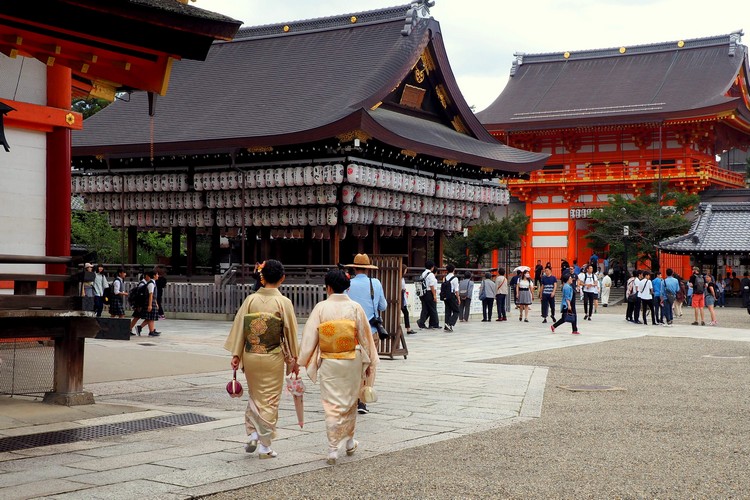
12. Pack your trash. Garbage bins are hard to find.
This one still confuses me. .
How on earth does a country not supply garbage bins in public areas? And, even more baffling, how does Japan stay so clean and garbage free without offering garbage bins?
It makes no sense. Yet, it makes perfect sense.
First of all, if you’re practicing travel tip #9, you shouldn’t be walking and eating, therefore you shouldn’t have garbage in public. If you do bring snacks and drinks with you, the expectation is that you will bring your garbage home with you.
It’s a counter-intuitive approach to littering, but it appears to work very well in Japan.
Without question, Japan is the cleanest country we’ve visited.
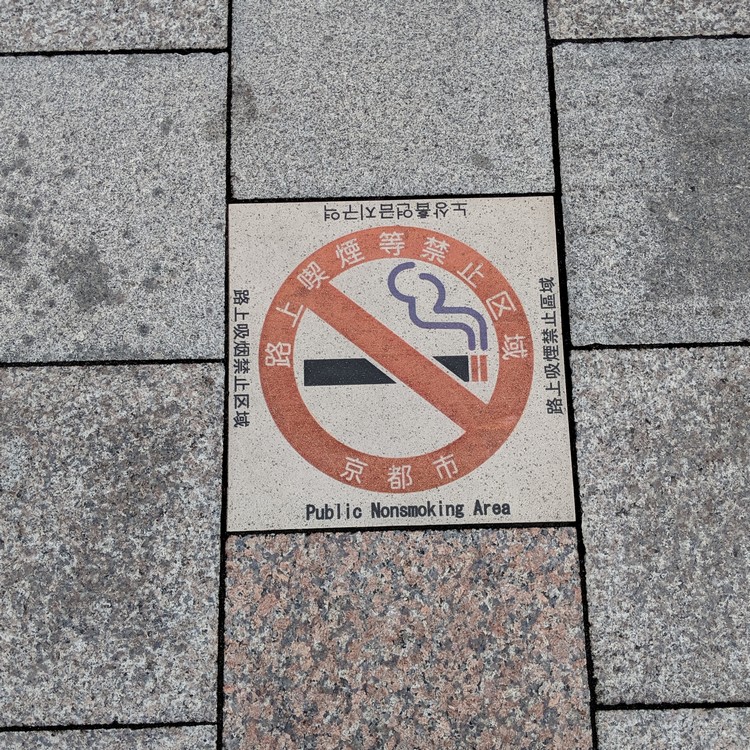
13. No smoking in public areas
Not only is Japan the cleanest country we’ve visited, it’s also the most smoke free. Most city streets and public areas are designated as smoke free. Even sidewalks have no smoking signs on them (see photo above – these signs are found in most heavily trafficked areas).
Now, you may be asking, where do smokers smoke?
There are designated smoking areas scattered throughout the city (see photo below). These designated smoking areas are typically located on side streets and away from people.
The best part about this system is that people actually follow the rules and only smoke in designated areas. Imagine that.
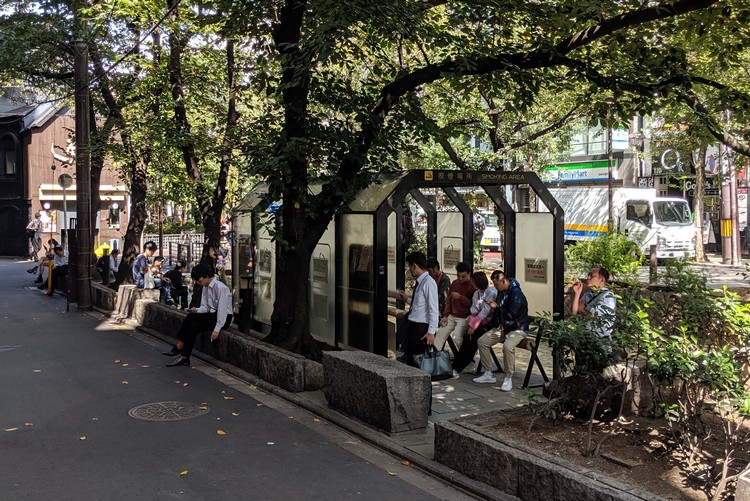
14. Train and subway stations have storage lockers
Most train and subway stations have storage lockers available for temporary use.
This comes in handy if you plan to do some sightseeing and you don’t want to drag your luggage around.
For example – you check out of your hotel at 11:00 AM but you still want to visit a few temples before you catch a train. Simply drop off your luggage at these storage lockers and your free to explore without your luggage.
The above photo was taken at Tokyo Station . As you can see, there’s a variety of sizes to choose from. You pay for the locker using cash or credit card. Price depends on the size, but it’s generally around 500 yen.
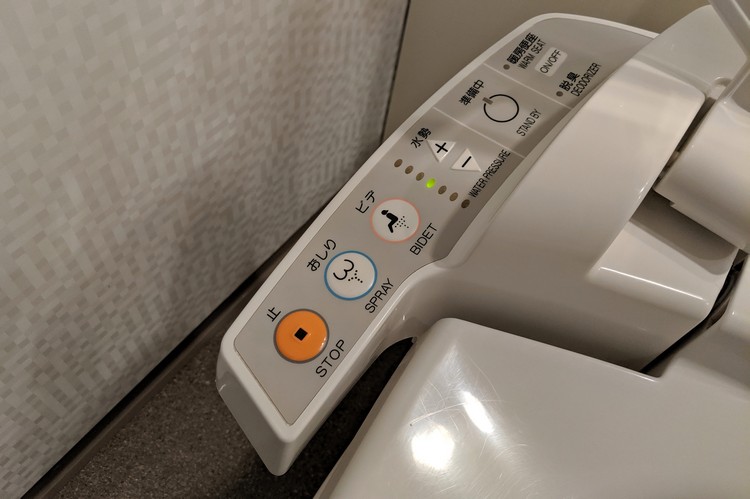
15. Japanese toilets are fancy
You will always remember the first time you try a japanese toilet..
Japanese toilets are next level, when compared to toilets in North America. Public washrooms in Japan are also very clean and organized.
Toilets in Japan typically look like the one pictured above. Toilet seats are often heated and they have a control system that allows you to spray water at varying speeds.
Some toilets even have sounds and music for privacy. I used one that makes a fake flushing sound, so it drowns out the sound of you doing your business.
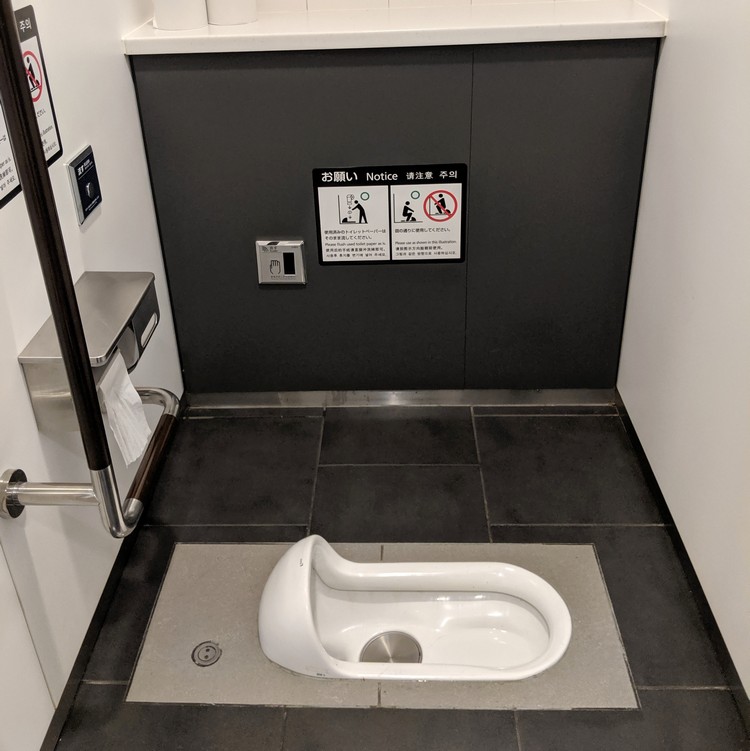
BUT – Not all toilets are high tech
We feel it’s important to highlight the other types of toilets in Japan. Though not as common in Japan, you may come across a toilet that looks like the one pictured above.
This hole-in-the-floor toilet is commonly found in Asia. If your trip to Japan is also the first time visiting Asia, the sight of this toilet will no doubt rattle you.
I remember my first encounter with this toilet in Thailand. It takes some getting used to.
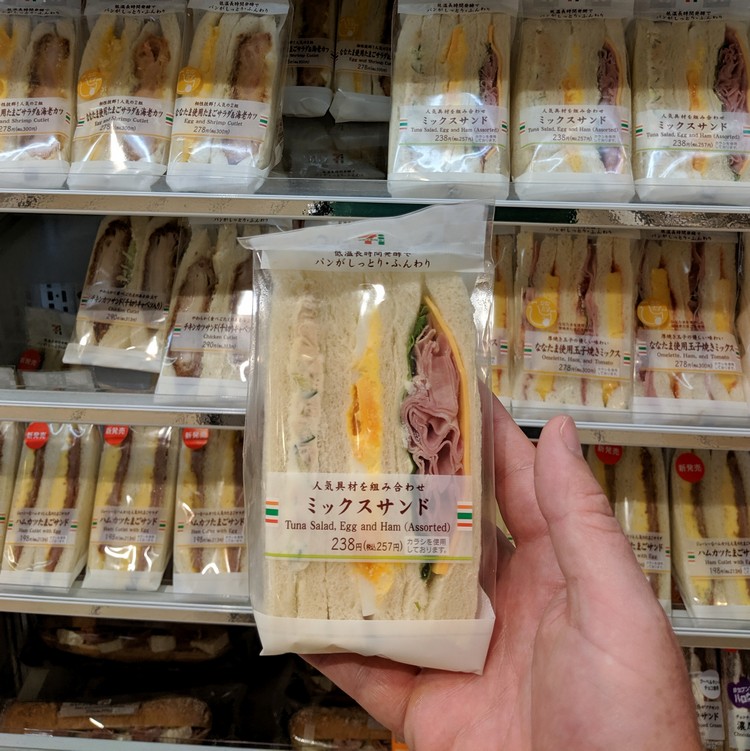
16. Eat at convenience stores
We rarely pick up ready-to-eat food at convenience stores in Canada, unless we’re on a road trip or there aren’t other food options available.
Ready-to-eat food at convenience stores is common in Japan.
Convenience stores actually have a good selection of prepared food, from sandwiches to bento boxes to baked goods. We often grabbed prepackaged sandwiches (picture above) and pastries for breakfast each morning. You can purchase beer and wine from these convenience stores. Eating at convenience stores is one of the easiest ways to travel cheap in Japan.
The main stores in Japan are 7 Eleven, Family Mart and Lawson. Most are open 24 hours.
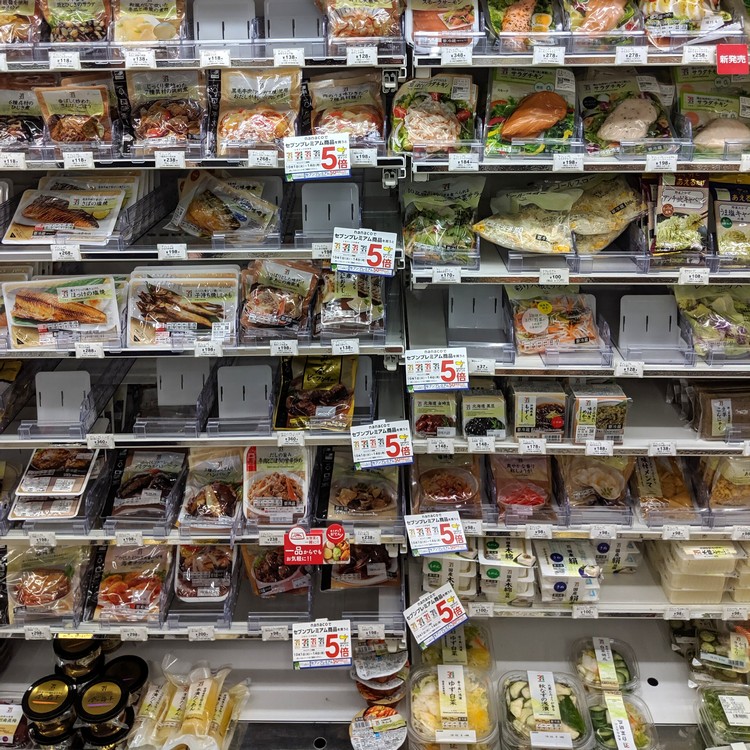
Related – Quick Guide to Japanese Cuisine for Tourists
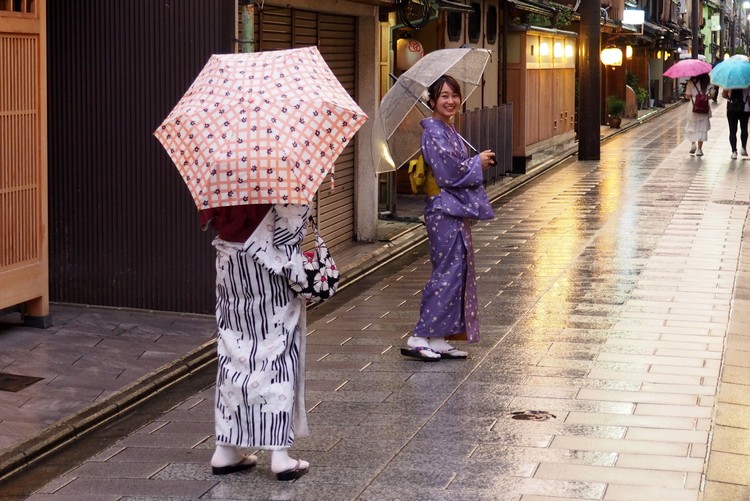
17. Kimonos in Kyoto is a thing
When you visit Kyoto for this first time, you will see hundreds of people wearing kimonos as they wander the old streets of Gion and Higashiyama.
At first, we assumed it was common dress attire for residents. However, we later learned that most people were dressing up in kimonos to take photos at traditional Kyoto landmarks, like Kiyomizu-dera , Hōkan-ji Temple and Yasaka Shrine .
Many of the people wearing kimonos are not residents of Kyoto. They are visitors from other Japanese cities or they’re foreign tourists. It’s popular to rent kimonos and hire a photographer for a few hours.
You will find several kimono rental stores in the old Higashiyama District of Kyoto.
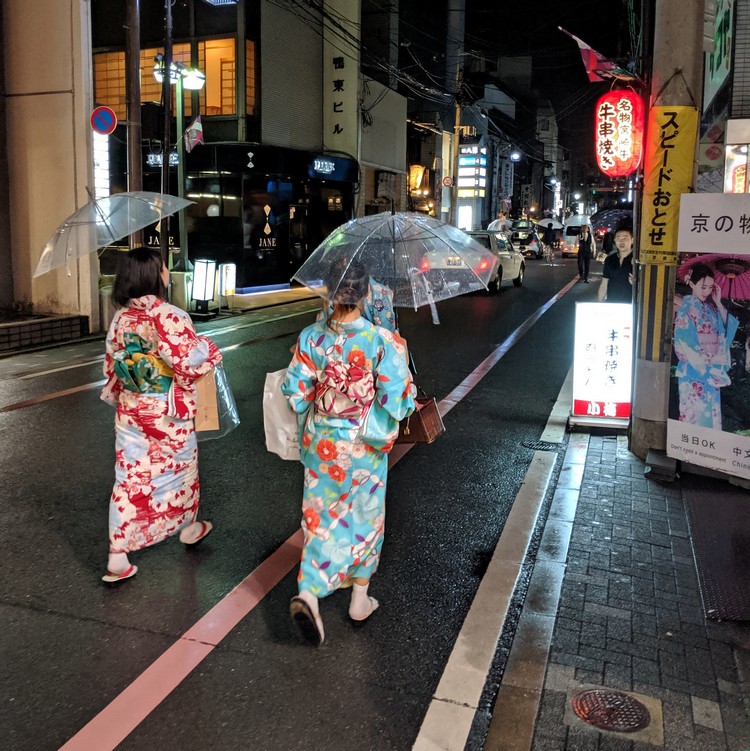
Look at the advertisement to the right. Then, look at the woman on the right. Coincidence?
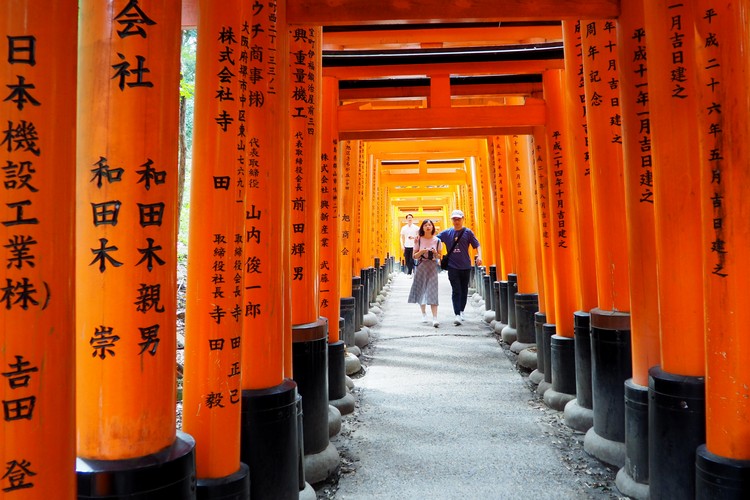
18. Toy stores have interesting figures on display
Alright, let me start by reminding you that we visited Japan with our two young boys.
Like most boys, they want toys. They both like Pokemon right now, so they were constantly on the lookout for Pokemon cards and toys.
As you’d expect, we came across a few toy stores on this trip to Japan.
What we didn’t expect to find was half-naked stripper dolls on display right beside the Pokemon toys. Some of these figurines were quite provocative, too.
Now, I don’t want to sound like a prude, but be aware of this should you decide to bring your kids to toy stores that sell animated figures. I wasn’t prepared for the questions that followed.
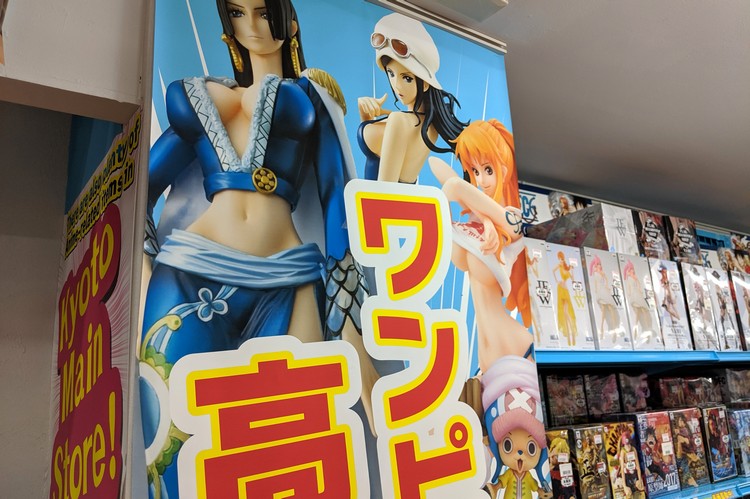
Some of the figures and posters are quite suggestive – and disproportionate.
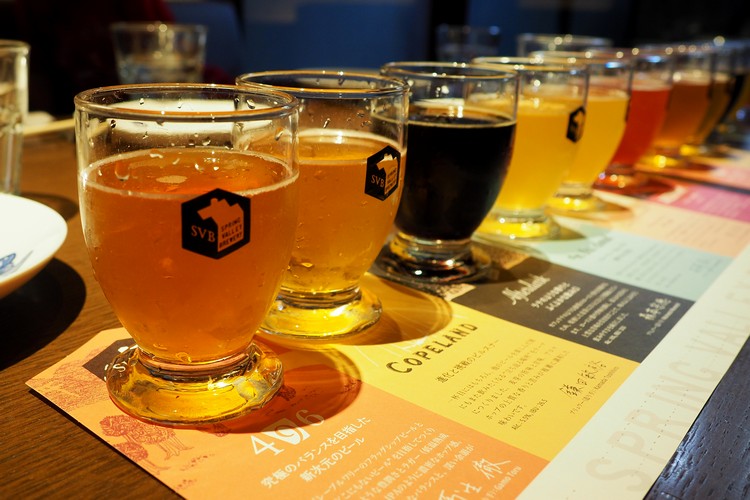
19. Craft beer is available, but it’s not popular
You will find craft beer in Japan but it’s not as popular as North America or Europe. We don’t often associate Japan with craft beer, it’s an ongoing evolution ; however, the scene has experienced growth in recent years.
While exploring Kyoto’s Nishiki Market , we stumbled across Spring Valley Brewery . We ordered a flight of beer, pictured above, and it came with 8 varieties of beer in 4 oz glasses.
Most restaurants in Japan serve the big three – Asahi, Kirin and Sapporo.
We don’t normally drink lagers or pilsners, we prefer pale ales. However, we often found ourselves craving a frosty pint of Sapporo during our time in Japan. It reminded us of drinking Guinness in Ireland – it tastes so much better when consumed in its home country.
Here’s a list of the best craft breweries in Japan.

Spring Valley Brewery in Kyoto.
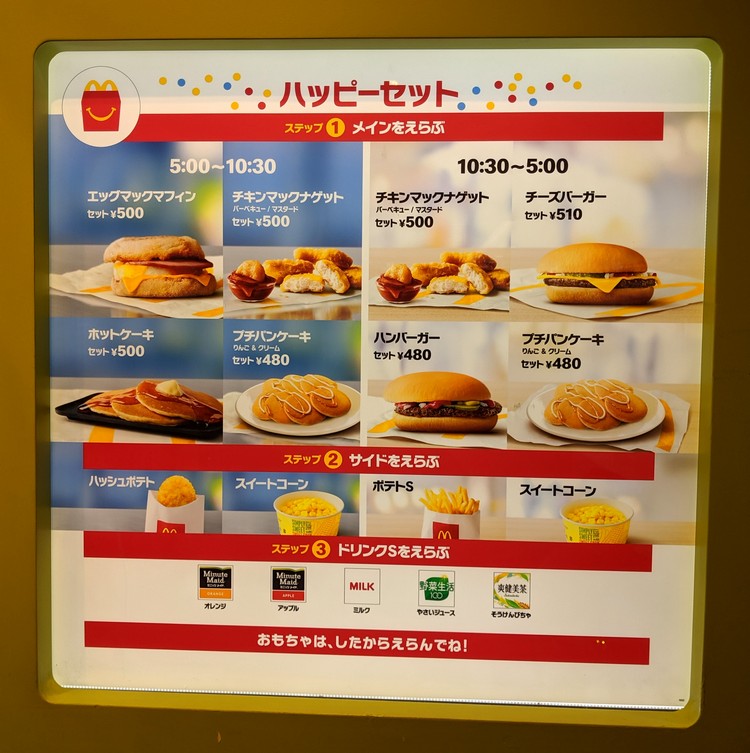
20. McDonald’s menus are basically the same
Sometimes, you just need an egg mcmuffin for breakfast. am i right .
Our boys love Chicken McNuggets and French fries from McDonald’s. After days of trying new food in Tokyo, unsuccessfully at times, they were excited to see the familiar Golden Arches.
We like to visit McDonald’s when we travel overseas. Not because we enjoy the food, but because we like to see how McDonald’s has adapted its menu to appeal to local audiences.
The McDonald’s menu in Japan is basically the same as Canada.
You will find Big Macs, McChicken sandwiches, Egg McMuffins and Chicken McNuggets. However, it does offer some unique sandwiches and burgers. I tried the Teriyaki Burger and Shrimp Burger. They were okay. Not great. The main difference is the sauce.
Here’s a list of McDonald’s menu items found only in Japan . I only saw a handful of these menu items, so I’m not sure how accurate or up-to-date this list is. The menu is also regional and seasonal.
McDonald’s is a good place to get free WiFi in Japan.

Share YOUR Japan travel tips in the comments below.
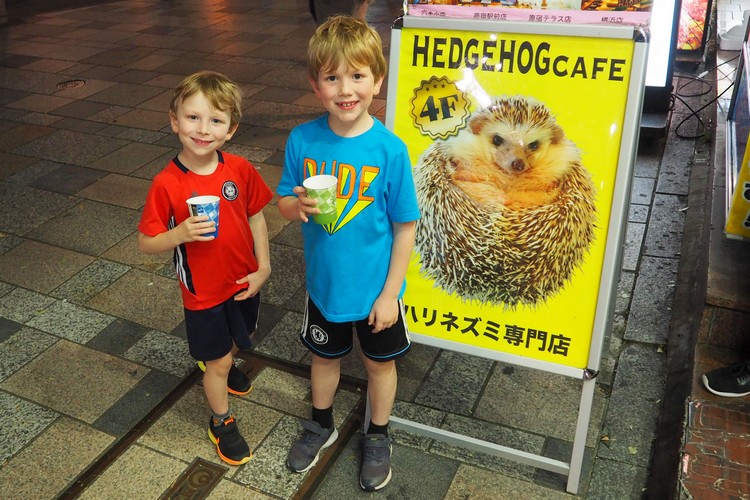
21. Choose your themed cafe wisely
Tokyo is known for it’s unusual and quirky themed cafes..
Most Japan travel tips blog posts will tell you to visit a themed cafe in Tokyo – and we agree. But here’s the thing – many of these cafes are tourist traps and they exploit the people and pets involved.
It’s important to do a little research and choose your cafe experience carefully.
We decided to visit the Hedgehog Cafe in Harajuku , Tokyo.
Our oldest boy recently got a hamster, so he was excited to play with hedgehogs. We like that HARRY Hedgehog Cafe has separate resting areas, so they’re not being handled constantly. It can be stressful for the hedgehogs. This cafe sells the hedgehogs, so its goal is to also find a home for them.
HARRY hedgehog cafe is located 2 minutes from the Harajuku Station . It’s on the 4th floor.

Read more Japan blog posts here .
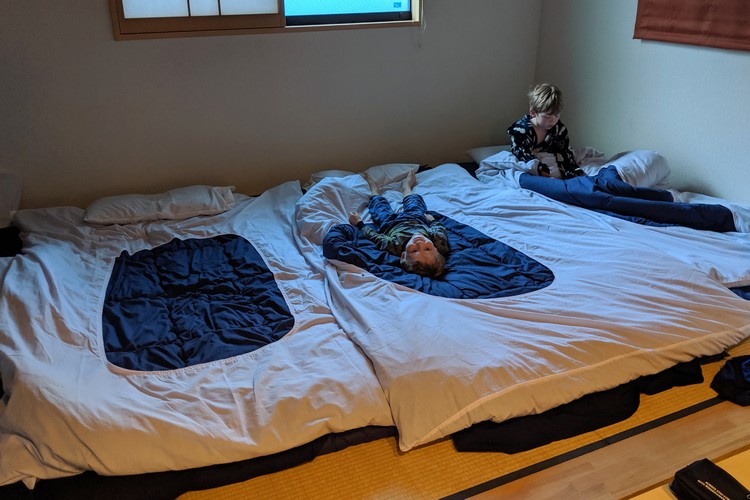
22. Stay at a traditional Japanese Ryokan
Staying at a ryokan is a unique japanese experience that first time visitors should try – at least once..
A ryokan is a traditional Japanese inn that typically features tatami-matted rooms and communal baths. Basically, the hotel rooms do not have beds. Instead, each guest is provided a Japanese futon mattress and bedding.
Here’s a video about how to make a futon bed at a traditional Japanese Ryokan.
Our boys had fun sleeping together on the tatami-matted floor. They said it felt like camping indoors. We’re used to sleeping on a mattress, so our backs were pretty sore and stiff in the morning. It’s a fun experience, but after a few nights sleeping on the floor, we were thankful for a bed.
Another unique feature of a Ryokan is the shared baths.
This traditional bath experience is quite different from Western culture. Spoiler alert – you will be naked with other guests. You do not share baths with the opposite gender (ie. men with men, women with women).
Many Canadians will find this public nudity to be uncomfortable. What can I say, that’s just how some of us are hardwired.
Communal baths will vary depending on the Ryokan, but typically you shower while sitting on a plastic stool. See photo below. After your shower you can soak in shallow hot tub. Some ryokans also have saunas.
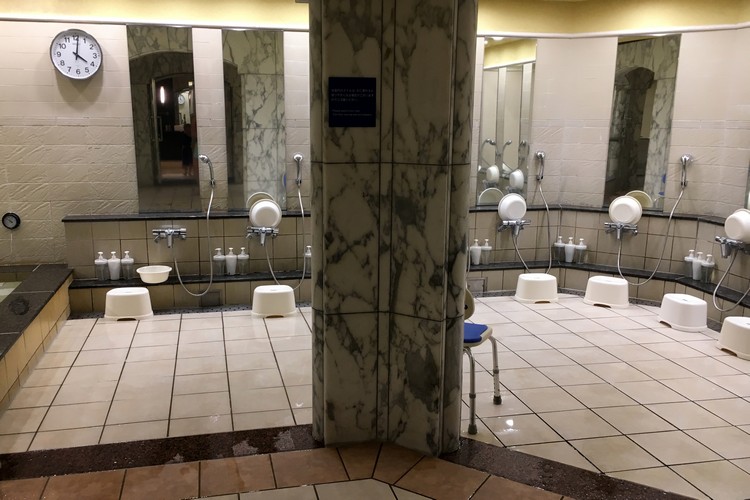
Above – shared bath and shower at a ryokan hotel in Japan.
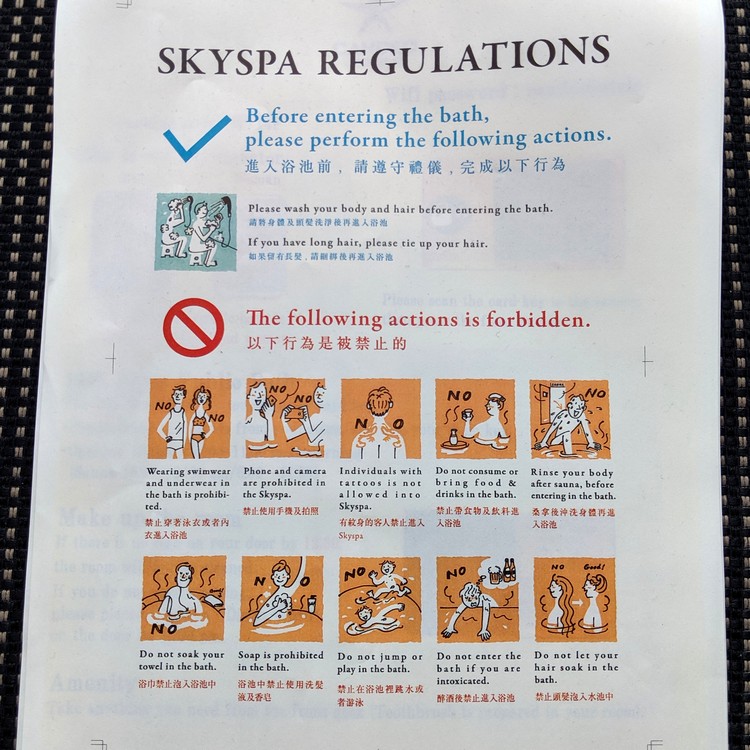
23. Cover up. Tattoos are not well received.
If you stay at a ryokan, or visit an onsen (japanese hot spring), you will likely be told to cover your tattoos..
If you’re covered in tattoos, you might be denied access to the bath or onsen. In Japan, tattoos are not socially acceptable and they’re often associated with criminals and gang members.
This happened to us in Kobe City. The hotel we stayed at has a nice spa and bath on its top floor.
When we arrived, we were handed the letter you see pictured above. If you look at the 3rd item, in the middle of ‘forbidden actions’, you will read ‘Individuals with tattoos is not allowed into the Skyspa’.
We both have a tattoo, so we asked the front desk if were allowed to use the Skyspa. They handed us a stack of bandages and said we had to cover our tattoos with the bandages. It seemed excessive, but we followed the rules and covered up.
If you have tattoos, keep this in mind when making your travel plans.
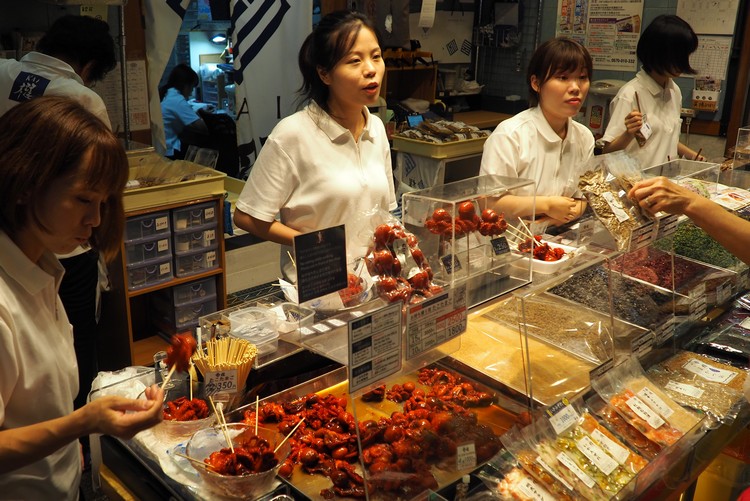
24. You can communicate with English
Contrary to what we read prior to visiting Japan, most train stations, hotels and shopping centers have English signs. We did not have trouble navigating Japan without speaking Japanese.
Japan hosts many world events, including the 2019 Rugby World Cup and the upcoming 2020 Tokyo Olympics , so the country has adapted to the global language.
The United Nations World Tourism Organization (UNWTO) estimates that over 28.7 million tourists visited Japan in 2017 ( source ). And that number is expected to rise by 6% each year.
It’s recommended you learn a few basic Japanese words. Even if your pronunciation is off, people will appreciate you making an effort to learn the language.
When in doubt, revisit #3 on this list of Japan travel tips.
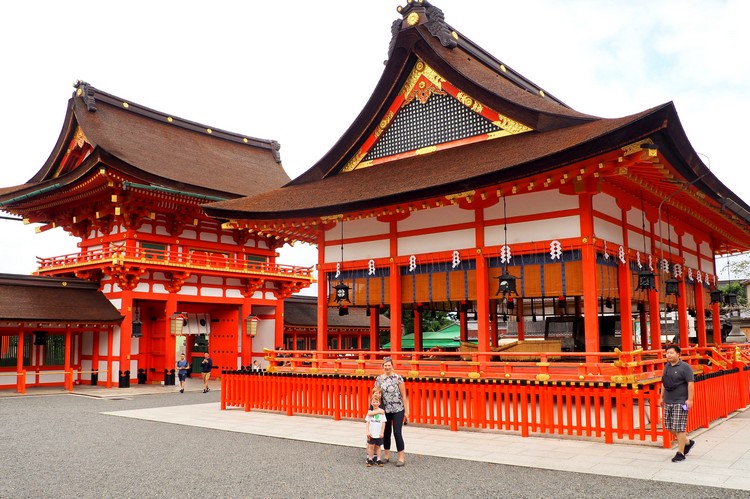
25. Japan is very safe
Yes, it is safe to travel to japan. .
Japan is a great family travel destination. It’s consistently ranked as one of the safest nations in the world. We found the people of Japan to be very friendly, respectful and accommodating.
We did not feel unsafe at any point during our trip.
How safe is it to travel in Japan?
Japan ranks in the top 10 in the Global Peace Index ( source ). Violent crime is rare. The general crime rate in Japan is ranked well below the national average of the United States.
Of course, like anywhere in the world, you still need to use common sense. For example, don’t walk down dark alleys in the middle of the night, be careful when taking money out of ATMs and don’t engage in criminal activity.
Before you travel to Japan, check travel advisories here . Japan is prone to typhoons, earthquakes, volcanic activity, landslides and tsunamis.
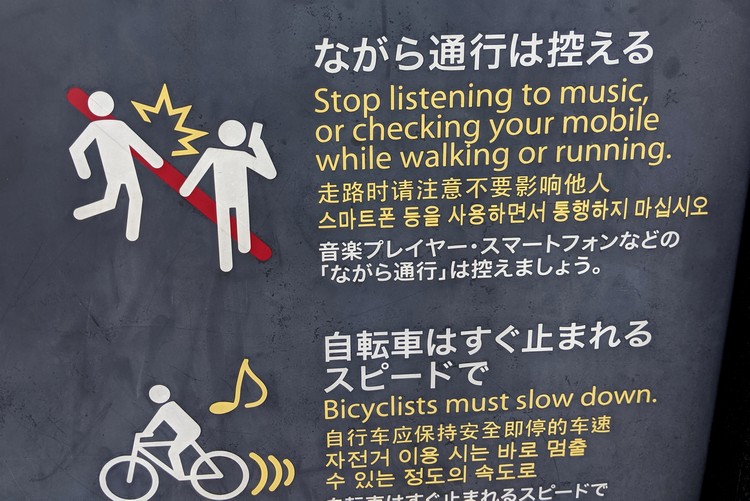
More Japan travel tips you should know
- Take off your shoes when entering a home, hotel room or onsen.
- Don’t point directly at people – it’s rude.
- Wait your turn. Japanese respect the queue. Don’t skip the line.
- Japanese people often wear paper face masks to keep them, and you, healthy.
- Don’t be loud in public areas. No talking on phones or playing music, shows or games without using headphones (see above photo).
- Be polite and respectful to everyone.
- When paying for things, place your money on the tray instead of handing it directly to the cashier.
- Don’t blow your nose in public.
- Bring a portable multi charging adaptor with USB outlets.
- Get a portable Wifi device so you can stay connected during your travels.
- Tourists are not always welcome. While the Japanese are very friendly and helpful towards foreigners, there are some establishments where tourist aren’t welcome (eg. high-end restaurants in Ginza).
- Everything is tiny. Hotel rooms are tiny (like capsule hotels ), restaurants are tiny, cars and vans are tiny – everything in Japan feels smaller. Have you heard of the Kei Car vehicle class ?
- Most standard hotel rooms have twin beds. Consider this before booking your hotels. Search for cheap Japan hotels here .
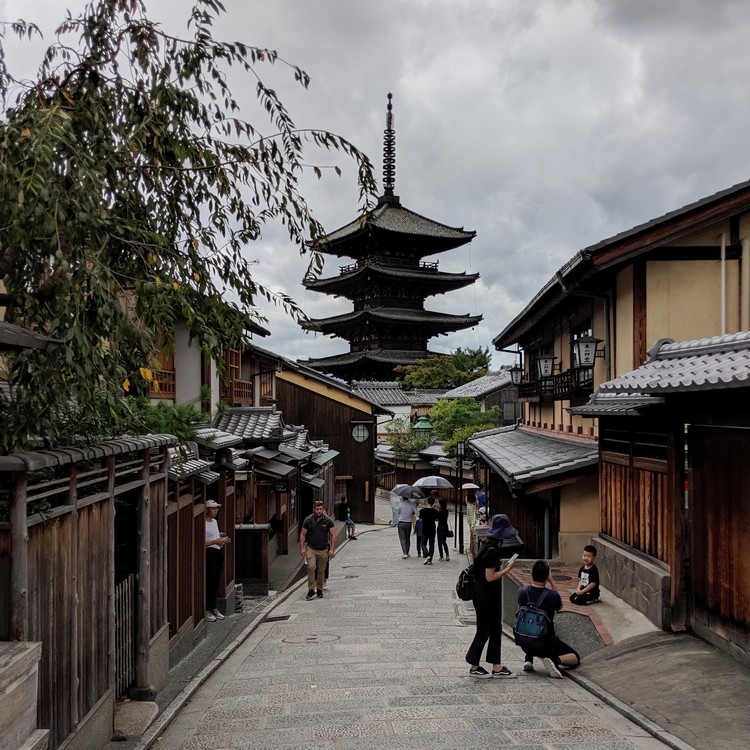
Read more posts from Japan:
- 100 Photos of Tokyo Disneyland
- Guide to eating Japanese Food in Japan for travellers
Have you visited Japan? What did we miss?
What would you add to these japan travel tips.
Share your Japan travel tips in the comments section below.
Related posts:
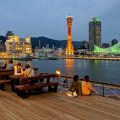
03/18/2020 at 9:20 pm
Great to read your info on ‘current’ aspects of visiting Japan. I had many business visits there in the 1970s and always tried to spent an extra day or weekend there to enjoy the interesting country and their cleanliness and civility. I even went to a wedding there after lunch at a country ryokan. One final comment – their English translations on posters etc seems to have improved in the last 40-50 years!
05/20/2024 at 8:48 pm
Hi Cam and Nicole I am a Canadian living in Ontario. I am going to Japan for the first time in August.. and then will travel through various countries all the way to PNG and in to Australia. I have been to 47 countries so far in 5 continents. I hope I will able to travel to Japan and all other countries without Compromising my home comfort as in Canada. I am not a foodie guy. So I like to stick with what I know. Never like the street foods. And I don’t tip even in Canada or US. But hope I could find hotel like in Canada, propèr bed and washroom. I am retired single traveler, like my comfort at night and love to explore the nature mountains river volcanos I hope I will find the comfort in Japan and in other Southasian countries. BAny comments will be appreciated. Thanks
05/24/2024 at 11:13 am
Thanks for your reply, Tony. I hope you enjoy your trip to Japan! It’s one of our favourite travel destinations
Leave a Reply Cancel reply
Your email address will not be published. Required fields are marked *
Yes - Subscribe me to your monthly newsletter!
This site uses Akismet to reduce spam. Learn how your comment data is processed .

Top tips for first-time visitors to Japan
All you need to know before you go
Tomorrow I’m flying to Nagoya , the start of a new adventure exploring Shoryudo, the heart of Japan. This will be my first visit to this exciting country and when I asked my fellow travel writers, bloggers and photographers for a few Japan travel tips, they had a lot to say, with quite a few of them responding excitedly “My favourite country!”

Image credit: Jeremy Hoare, Travel Photographer and fellow BGTW member.
40 top travel tips for first-time visitors to Japan
From translating Japanese menus to using public transport, never blowing your nose in public to navigating your way around a high-tech toilet, here are 37 Japan travel tips that I’m sure will be invaluable to anyone travelling to Japan for the first time.
UPDATE: I’m back from my trip. Having spent a fabulous week in Japan, I have a few amendments I’d like to make this Japan travel tips list. As my travel blogging friend Jessica from Notes of Nomads explained to me “The thing about Japan is that most tourists understandably don’t speak Japanese and it’s not a culture that can easily be understood in a short time (even after years and years), so it can lend itself to some misconceptions. Plus things can vary widely depending on where you visit.”
Table of Contents
Before you go
1. pre-book an airport transfer.
“My tip is that if you have travelled on a long-haul flight to Japan, you should pre-book an airport transfer, as trying to work out the complicated Tokyo train system when you are tired is pretty difficult.” Anne, Pretraveller
2. Buy Your Rail Pass Before You Arrive
“If you are planning on travelling a lot by rail, buy your Japan Rail pass before you leave home to save time (although you can now also buy them in Japan). They can save you a lot of money if you are planning to travel by train between cities but are unlikely to if you’re travelling within a single city. You can use the HyperDia app to check if a pass will work out cheaper.” Stefan, Nomadic Boys
3. Buy Travel Insurance
4. download google translate.
“The best way to decode menus in Japanese and communicate when you’re having difficulties is to have Google Translate downloaded for offline use, with Japanese language installed. You can even take a photo of your menu and the app will instantly translate it into English.“ Karen, Wanderlusting K
5. Learn a little Japanese
If you are only travelling to the most popular cities, you’ll probably get by in English although learning a few words in Japanese will go down well. If however, you are travelling away from these major cities, you will find learning some Japanese invaluable. Even in a big city like Nagoya we found it invaluable that one of our group spoke fluent Japense. There are many great apps and online courses that can help, such as Rosetta Stone* , which is one of the most popular.
Save 50% today*! Rosetta Stone – Learn the language, not just the words!
6. Buy pocket WIFI
If you want to have access to the internet on the go and let’s face it, it can be very handy, especially when travelling in a new country where you don;t speak the language. You can rent a pocket Wifi from Japan Rail Pass which will work for up to 5 devices.
7. Buy a local Sim
Japan Rail Pass also over Japan SIM Card f or travellers with an unlimited data plan with no daily limit.
8. Download HyperDia App
“The app we’ve found invaluable for travelling across Japan is HyperDia , which provides train routes, timetables, and even tells you which platform number to go to at the station.” John, Roaming Around the World
9. Familiarise yourself with Japanese cuisine
Food in Japan is very varied with some superb dishes you won’t want to miss and some you’ll most probably want to avoid. Read my blog posts on Japanese cuisine, and the best and worst things to eat , before you go to give you an idea about what you would like to try. It’s a unique cuisine that you should discover but it can be confusing to know what to order. You can also read about traditional Japanese breakfast here.
10. When to visit Japan
Each season in Japan has its pros and cons. Spring is cherry blossom time when hotels get booked up early and prices are high but if you plan your trip well in advance it’s a fabulous time of year to visit with mild temperatures. Summer is typhoon season in Japan (June to October). It’s wet and hot but it’s fabulously quiet and has a unique beauty worth capturing with your camera. Autumn is again a photographers dream when the trees put on a spectacular display of rust and gold and as in Spring temperatures are mild. Winter in Japan can be cold, depending on where you travel but a snow covered Japan is like a scene from a fairytale, prices are low and there are fewer tourists around.
11. Build the anticipation
While you’re waiting to travel, build up the anticipation for your trip by trying some Japanese arts and crafts at home. You could try your hand at some origami or perhaps some Japanese paper cutting !
Japanese Etiquette Tips
12. never leave a tip.
“It is very offensive to leave a tip and it will often be refused. It implies that the person you are tipping doesn’t earn very much.” Natasha, The World Pursuit
13. Take Off Your Shoes
“Always look for shoes in the entrances of buildings. If you see them, be sure to remove your shoes before entering. Wearing shoes indoors, especially in homes and some businesses, is seen as very rude and dirty.” Kay, Jet Farer
“Bowing in Japanese society is extremely important, and the ritual is filled with rules and etiquette many travellers will not be expected to know or understand. As a general ‘cheat’ you should keep your back and neck straight and bow at the same angle as the person in front of you, and this will get you a lot of brownie points for being polite.” Mike, Bemused Backpacker
Top Tip: Don’t forget your travel adapter. Japan sockets are like USA two pin sockets. This Worldwide USB Travel Adapter is perfect for UK residents wherever you travel.
15. Stand on the Left
“Always stand on the left when using an escalator. Everyone does this, no exceptions. Make sure you pick the correct side of the escalator. If you can’t remember which side that is, just follow the others.” Clemens, Travellers Archive
UPDATE: The exception is Osaka , where you should stand on the right.
16. Don’t Blow Your Nose
“Don’t use tissues to blow your nose in public, it’s highly offensive to the Japanese, just sniff.“ Sally, 3 Kids v the world
17. Don’t Smoke on the Streets
“If you are a smoker and visiting Japan, be aware that in most big cities you will not be allowed to smoke in the street (and could risk a pretty heavy fine if you do). Instead, you will have to smoke in designated areas, which can be pretty hard to find. It is worth checking online where those laws apply – Tokyo and Kyoto are two of the cities that have applied this ban.” Maria-Carmen, Orient Excess
UPDATE: Smoking areas can be found outside every train station and you can still smoke in a lot of restaurants in Japan.
18. Purification Ritual
“When visiting a shrine, learn the purification ritual. Use the ladle to wash each of your hands with fresh water, then put some water in your cupped hand and rinse your mouth and spit out the water beside the fountain.” Dawn, 5 Lost Together
19. Cover Tattoos
“Cover up any tattoos before visiting local swimming pools “ Sally, 3 Kids v the world
There is a deep-rooted cultural suspicion towards tattoos, stemming from their association with organised crime gangs, the Yakuza, who pledge their allegiance with full-body markings. You are unlikely to be allowed in swimming pools (including your hotel’s), spas, onsen (see tip 17) and gyms, unless you cover your tattoos.
20. Business Cards
“If you are planning on giving or receiving business cards in Japan then don’t forget the etiquette that goes with it: Always hand business cards over by holding them with both hands, thumbs on top, while bowing a little. Make sure you receive your contact’s card with both hands too and if you are sitting, keep the card in front of you.” Maria-Carmen, Orient Excess

Above and featured image credit: Tim Bird, Travel Photographer, fellow BGTW member and blogger at Six Images .
Planning a trip to Japan? Check out this 10 day Japan itinerary .
Handy to Know Japan Travel Tips
These tips about carrying cash and using ATMs are possibly the most important Japan travle tips to take onboard.
21. Carry Cash
“Japan is a cash-based society, so make sure you have local currency on you at all times. You’ll be surprised by the number of places that won’t take your credit card.” Leah, Kid Bucketlist
22. Using ATMs
“Many ATMs (automatic teller machines) in Japan do not accept foreign cards. ATMs that work with foreign cards can be found at post offices, Citibank, 7-Eleven stores and a few other convenience stores.” Matilda, The Travel Sisters
UPDATE: I fell foul of this one on my last day. I ran out of money and wanted to go out for a drink that evening but couldn’t find an ATM that would accept any of my cards. Thanks to Adam from Travels of Adam for bailing me out.
23. Public Toilets
”Toilets are kind of a complicated deal in Japan, although in more rural areas you will also come across squat toilets. For the high-tech toilets though, you’ll want to figure out in advance the basics of how to flush, which isn’t always obvious from the outset, and is usually a lever or button separate from the Star Trek-style control panel you might initially be presented with!” Laurence, Finding the Universe
UPDATE: I’d recommend taking hand sanitiser as few public toilets have hot water or soap to wash your hands or any way to dry them.
Don’t panic if you see a squat toilet inside the cubicle. It’s always worth checking the other cubicles to see if there are any western style toilets as well.
And if you notice a button that says ‘flush noise’ it doesn’t do anything other than making a noise. Its sole purpose is to disguise any embarrassing noises you might make. It still puts a smile on my face when I think of it. I’m surprised they didn’t also have a button for covering up embarrassing smells!
24. Don’t Ask ‘Do you speak English?’
“If you need to stop a stranger to ask for directions, don’t start by asking ‘Do you speak English?’– many people are shy and will say ‘No’ even though they understand some English. Instead, try something like ‘Hello, could you please help me? I’m trying to find…’.” Patrick, German Backpacker
25. Visit an Onsen
“Go to a Japanese onsen, preferably one with an outdoor bath. Make sure to scrub and clean yourself thoroughly before entering the public bath. Soap, shampoo, and conditioner are usually provided for you. It’s the best way to beat jet lag or any fatigue, and you will love the experience.” Corrine, Reflections Enroute
UPDATE: I was rather nervous about how I’d feel walking around naked in front of strangers but when I plucked up the courage to do it, it was surprisingly easy, although I’m pleased to say that onsen are virtually all single sex only. If there is a choice of indoor and outdoor baths, opt for the outdoor one as you can stay in longer and for me, it felt far more relaxing gazing up at the stars.
If you go to a true rotenburo (outdoor bath), there may be no showers at all and just a tub with a ladle near the entrance to rinse your body (and no soap, so it doesn’t get into the natural onsen water).
Trying an onsen has to be one of my favourite Japan travel tips and something I’d higly recommend.
Japanese Food and Drink Tips

Image credit: Tim Bird, Travel Photographer, fellow BGTW member and blogger at Six Images .
26. Should You Finish Your Drink or Meal?
“Don’t finish your drink or meal if you are out with Japanese people. They will assume they have not fed you enough, or have not got you drunk enough. This is insulting to the Japanese people who pride themselves on their hospitality. Always leave a little in your glass, and a little on your plate. Also, let your host pour your drink.” Paula, Contented Traveller
UPDATE: This only applies to certain formal situations and generally it’s actually polite to finish your meal, especially your rice.
27. Eat Sushi at the Supermarket
“Did you know most supermarkets offer fabulous sushi? I’ve found it both tastes great and is very cheap, especially if you go one or two hours before closing time when it is reduced to half-price!” Cornelius, Cycloscope
28. Eat Everything!
“I was given this advice when I first visited Japan and it was spot on.” Sarah, A Social Nomad
UPDATE: Having spent a week in Japan eating in a variety of restaurants where I was rarely given a choice of what to eat, I’m sorry to say I don’t agree with this tip. For example, while the eel with rice was surprisingly delicious, the eel liver soup (with a whole liver floating in it) most definitely was not, and while I could stomach the crab brains, the raw crab sashimi was, well, let’s just say it was a step too far.
29. How to Order Food from a Vending Machine
My favourite meal during my visit to Japan was surprisingly at a motorway cafe/truck stop — king prawns in breadcrumbs with curry and rice. There was what looked like a vending machine with pictures of the various dishes on offer. This is where you pay and collect a ticket for your order, which you hand over the counter. When your order is ready they will call out your number in Japanese! Near the counter, there was a drinks dispenser with free water and tea.
30. Book Restaurants in Advance
“If there is a specific restaurant you’re looking to visit in a tourist area, check hours in advance and make reservations. I had more trouble getting seated at restaurants in Japan than anywhere else I have visited, as most had only a few tables.” Nancy, We Go With Kids
31. Chopstick Etiquette
“Don’t stand your chopsticks upright in your bowl of rice – it’s the way rice is offered to a deceased person’s spirit; crossing them means a similar thing. You shouldn’t spear food with chopsticks either.” Emily, Kids and Compass
32. Don’t Walk and Eat
“Don’t eat while walking – it’s considered rude. Grab your food and sit or stand somewhere, and finish it before moving on.” Thais, World Trip Diaries
UPDATE: There are some exceptions, such as street snacks.

Image credit: Notes of Nomads , two fabulous bloggers who have made Japan their home.
33. Slurp Away
“Slurping when eating soups and noodles is not only okay, but is considered polite! It’s a sign you’re enjoying the food, so don’t be put off or grossed out if you encounter it.” Allison, Eternal Arrival
34. Buy a Bento Box at the Train Station
“You wouldn’t think that tasty sushi could come from a box that’s gift-wrapped at a subway station, but you’ll be blown away – all utensils included.” Taiss, Together to Wherever
35. Join the Queue
“If you see a line outside a restaurant, get in it – chances are you’re in for a delicious meal. Don’t worry, they’re efficient and the lines move quickly.” Adelina, Pack Me To
UPDATE from Jessica, Notes of Nomads : It’s a bit of a running joke in Japan that Japanese people will just join any queue they see because they assume what they are selling must be good. Sometimes it is true, but it’s not always the case. And the lines don’t necessarily move quickly. Japanese people can be very patient with these things and will queue for hours if necessary to go to a place they think is trendy/they saw on TV etc. You’ll often see staff in big cities like Tokyo whose sole job is to stand with a sign at the back of the queue that says “This is the back of the queue for X restaurant” because if it is popular the end of the line might be quite a distance from the entrance.
36. Drink Sake
“When drinking sake, the custom is to never pour your own glass, including refills. Sake is intended to be poured for each other.” Helen, Not Without my Passport
Getting Around
37. travelling in the cities.
“You don’t need a JR pass while you’re in the cities. The cost of using JR trains within any city is quite low, just a few hundred yen, and sometimes it’s quicker to walk or use the subway system. If you’re travelling with a group of 3-4 people or as a family, taxis can actually work out cheaper than trains and subways over short distances too.” Bethany, Flashpacker Family
38. Hire a Guide
“Visiting Japan for the first time can be a daunting experience. Everything is so different that hiring a guide is a great way to ‘acclimatise’ and quickly learn how things work.” Paul, A Luxury Travel Blog
39. Watch the Taxi Doors
“In some Japanese taxis, the doors automatically open when the taxi stops, and shut after you are inside. It can be a bit disconcerting the first time it happens! Watch your fingers and bags so they don’t get caught.” Jessica, Independent Travel Cats

Great Reads
40. unbeaten tracks.
“I’d recommend reading ‘ Unbeaten Tracks in Japan ’ by Isabella Bird, about her travels in Northern Japan in 1878.” Rosemary Bailey , Travel Writer and fellow BGTW member.
I’d’ like to say a huge thank you to everyone who contributed to this post. There’s a lot I need to remember. Let the adventure begin!
https://travelwithkat.com/gujo-hachiman/
https://travelwithkat.com/walking-the-nakasendo-way/
Hello, I’m Kathryn, a travel writer, photographer and holistic therapist based on the south coast of England.
Join me exploring the most beautiful places in the UK and discovering new cultures, countries and cuisines through my vast archive of articles from around the world.
Affiliate Disclosure
Please be aware that some links on this website are affiliate links, which means if you click on them and go on to buy a product I may earn a commission. There is no extra cost to you but the commission I earn as an affiliate marketer goes towards the cost of running this blog for which I am very grateful. Thank you.
Subscribe and I'll share with you the most beautiful and fascinating places in this wonderful world. Let's keep it that way!
- All new posts on Travel With Kat
- Kat's monthly newsletter
Winner 2017
British guild of travel writers’, ‘blogger of the year’.

Join my 'Behind the Scenes' newsletter
Delivered monthly to your inbox with all my behind the scenes news, latest posts and giveaways exclusive to my subscribers.
18 Comments
I have to admit this is all pretty overwhelming. The more research I do, the more I have to tell myself “you have plenty of time” – but our trip in May will come fast. I want to make the most of our time; I don’t want to rely on (abuse) the good graces of such a gracious people. Thanks for the info (I’ll have to reread this 100x before we go!).
It seems a lot to take in but you’ll be fine. It’s such a fascinating country. I’d love to go back. Have a fabulous time and, yes, May will be here before we know it!
that’s the month when I decided to go aswell, all these sites are super helpful, bless the great interwebs.
We’ll be keeping these bookmarked for summer. I am very excited for my trip and don’t want my lack of knowledge in Japanese culture to become an obstacle in enjoying my stay. Thanks!
I hope you find these tips useful. Have a fabulous time!
Japan is such a fantastic place to visit! knowing these tips are super helpful to make the trip even better! It was so weird to slurp my food since we usually think that’s rude…but hey it’s good to know the difference in cultures and preceptions!
It’s a fascinating and complicated culture. I found these tips invaluable. I hope you do too.
Great advice. My mother-in-law is Japanese and wants to return next year to visit family up North and wants us all to come. I’m all for it but these tips will help since I’d like to do side trips for blogging and business. Thanks so much for sharing.
I hope you find them useful. Have a brilliant time.
While living in Japan I discovered it was considered rude to pass food chopsticks to chopsticks. We are leaving for Japan July 2018 – thanks for the tips some were new to me even though I spent a year there.
I think the etiquette is probably a lot more complicated than it first appears. And, as Jessica pointed out to me, things can vary from one region to the next. Have a fabulous time. I dearly hope to go back one day.
There are a few on here that I wish WE had in the UK…and some I’m glad we haven’t (and I’m not saying which!). I’m so looking forward to hearing which of these tips you found most useful. ?
It was such a fabulous week. More coming soon!
I was conceived in Japan and have always felt that was the reason for my strong connection to Asian culture. I want to get there so badly, and even more so now after you’ve been posting this lovely trip! I’d be right at home slurping away!
I’ve plenty more yet to share which I’m sure will tempt you even more!
Your trip looked amazing and really looking forward to reading about it. Japan is such a fascinating place, one of the few places that still feels so ‘foreign’ and different when globalisation is making so many places come together. I’ve only been for a quick stopover on my way back from Australia but I would love to go back to discover more someday.
The Japanese bathing experience would be fun! And we don’t sport any tattoos, so we’re good in that department :-). Funny that slurping your food is okay :-).
You have a fabulous trip to Japan! We look forward to hearing all about it…
Thanks guys. I’m on my way to the airport. Very excited!
Submit a Comment Cancel reply
Your email address will not be published. Required fields are marked *
This site uses Akismet to reduce spam. Learn how your comment data is processed .
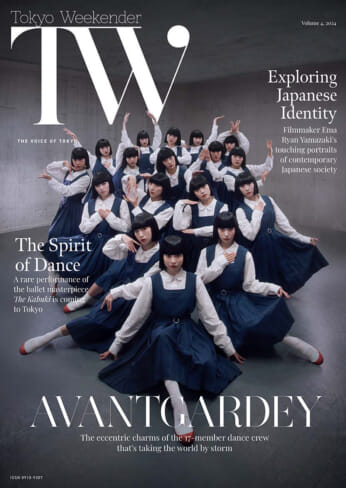
Japan in November: The Best Things To Do and Places To Visit
Make the most of Japan's fall foliage
September 4, 2024
November Travel Overview
- November is peak sweater weather in much of Japan — the weather gets chilly, and you’ll want to make sure you have a warm jacket when heading out.
- Koyo , Japan’s beautiful foliage, is a must-see in November. See our autumn leaves forecast guide for the best times to catch the leaves.
- You can also catch early illuminations, autumn festivals or a sumo tournament.
- Many gardens, temples and shrines attract large crowds in November, when the fall foliage is at its peak. Kyoto also garners even more visitors than usual during this time of year.
Japan prides itself on its four seasons, and one of the most vibrant months of the year is November, when many of Japan’s trees turn a rich crimson. The climate in November is pleasant, as long as you don’t mind a little chill, especially towards the end of the month; November in Japan sees crisp, bright blue skies, enhancing the joys of biting into a roasted sweet potato or sipping a hot cup of green tea.
Because the autumn leaves are so stunning, chronicled in historical poems to modern pop songs, fall does attract a lot of visitors to Japan, especially in already popular areas like Kyoto. Though not as busy as Japan’s sakura season, make sure to plan in advance, and consider visiting smaller parks and temples if you want to see more leaves than people.
Popular Activities and Things To Do in November
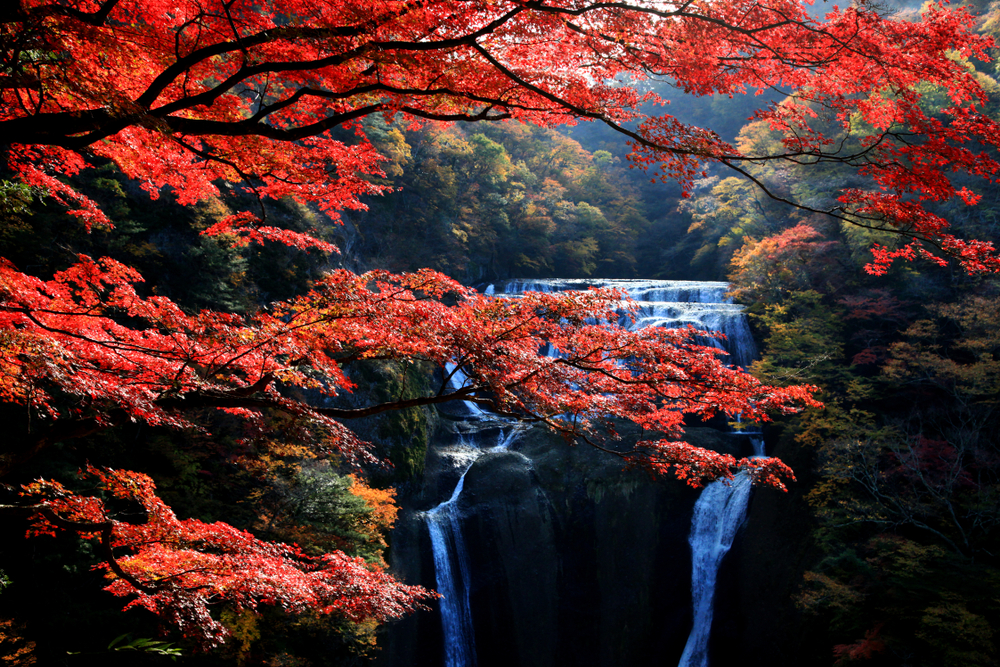
View Japan’s Autumn Leaves
The bright red and yellow autumnal trees are the absolute scene-stealer for activities in Japan during the fall. Momijigari , or maple leaves hunting, is one of the main reasons visitors come to Japan in November, and should definitely be taken advantage of, even if it’s just a stroll through your nearest park.
The dates for peak foliage vary depending on the weather and the region. In Hokkaido, red leaves are often visible from as early as late October, whereas southern areas like Fukuoka or Kagoshima don’t usually see red leaves until the middle of December. In Tokyo and Kyoto , koyo season is often late November or early December.
There are plenty of spots to enjoy the autumn leaves in Tokyo, from your local park to famous gardens like Shinjuku Gyoen National Garden. Consult our full guide for enjoying the fall foliage in and near Tokyo. We also have the best hikes across Japan for viewing koyo.
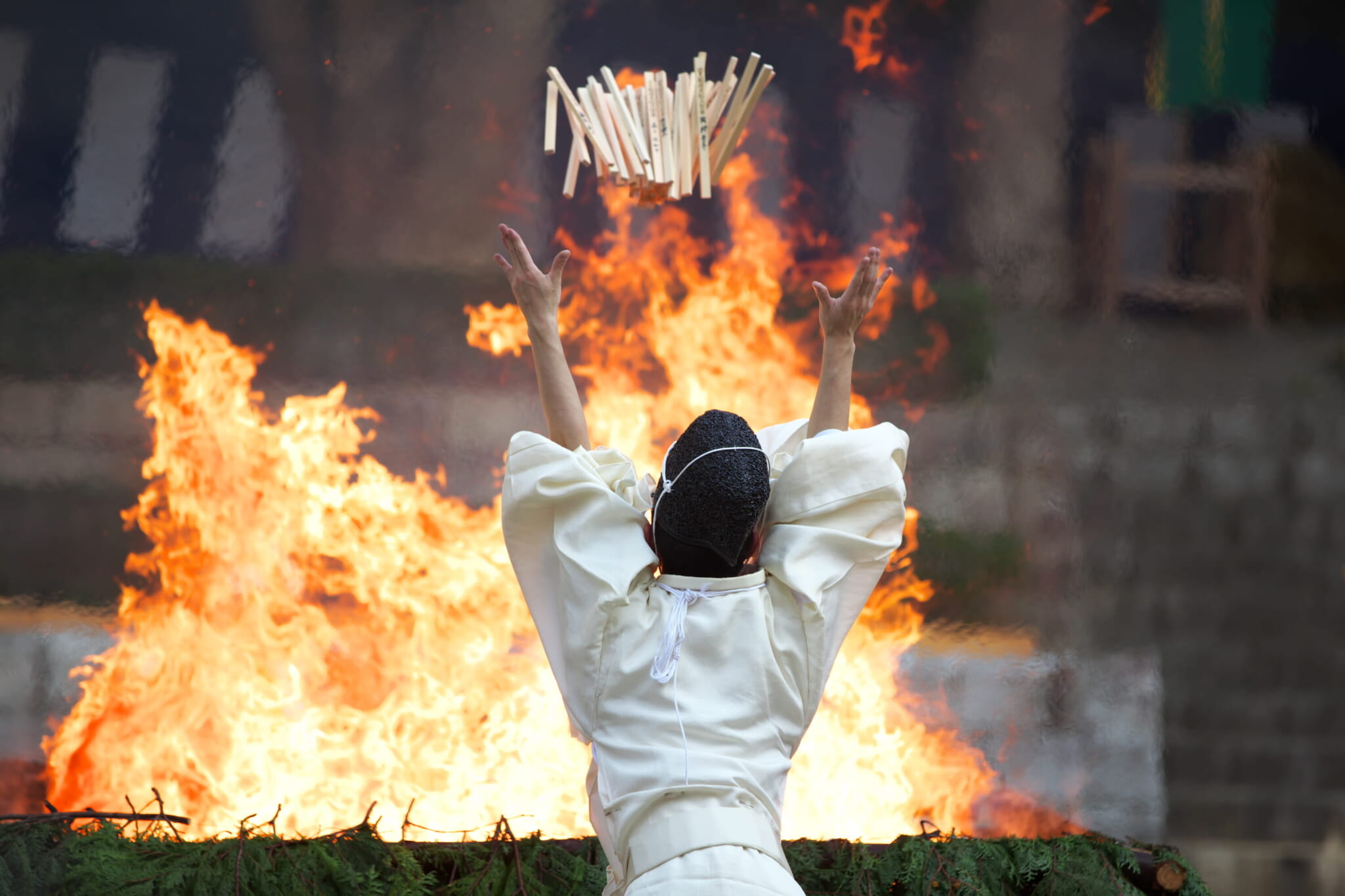
Fushimi Inari Shrine Ōhitaki Fire Festival
Attend autumn festivals.
Autumnal festivals happen across Japan throughout November, celebrating and praying for a good harvest, a safe winter and good fortune for children. Many of these festivals take place at shrines, as well as natural landmarks. There are plenty of festivals to choose from, but major events include the following:
Fushimi Inari Taisha is the most famous shrine honoring Fushimi Inari, the god of rice and prosperity. It’s also host to one of the most awe-inspiring fire festivals in Japan, which takes place annually on November 8. Highlights of the festival include priestesses performing the kagura dance and a bonfire in the main courtyard of the shrine.
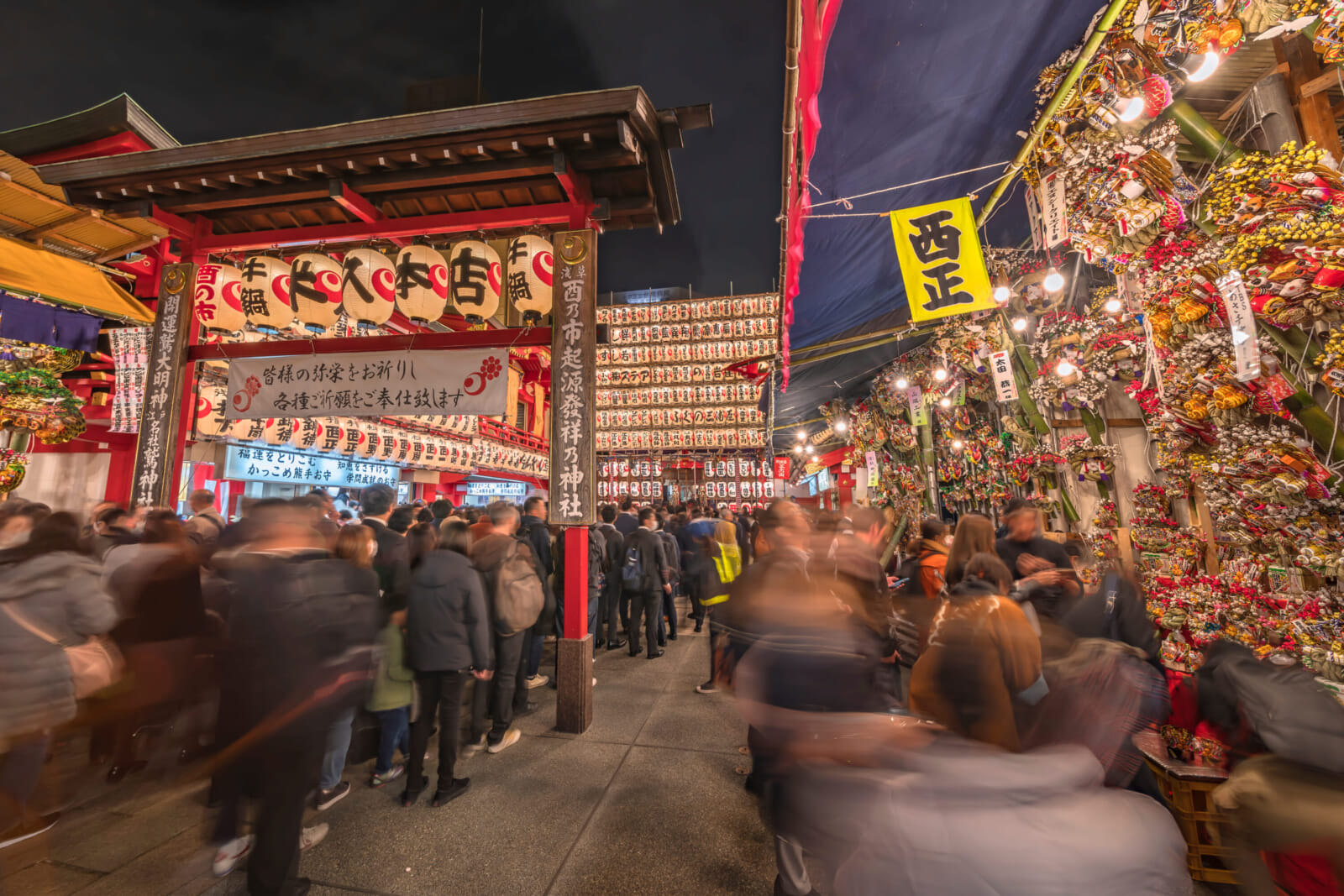
Tori-no-Ichi
This is a festival held over several days in November on days designated on the lunar calendar as days of the rooster. To pray for good business and fortune, kumade charms can be bought at a tori-no-ichi festival. The most famous of these festivals is held in Asakusa’s Otori Shrine, but it is celebrated in many shrines and temples throughout the country.
Shichigosan
Across the nation, families celebrate shichigosan, a rite of passage tradition for 3, 5 and 7-year-olds. In November, you are likely to spot adorable children in elaborate kimono at shrines to celebrate another safe year of growth.
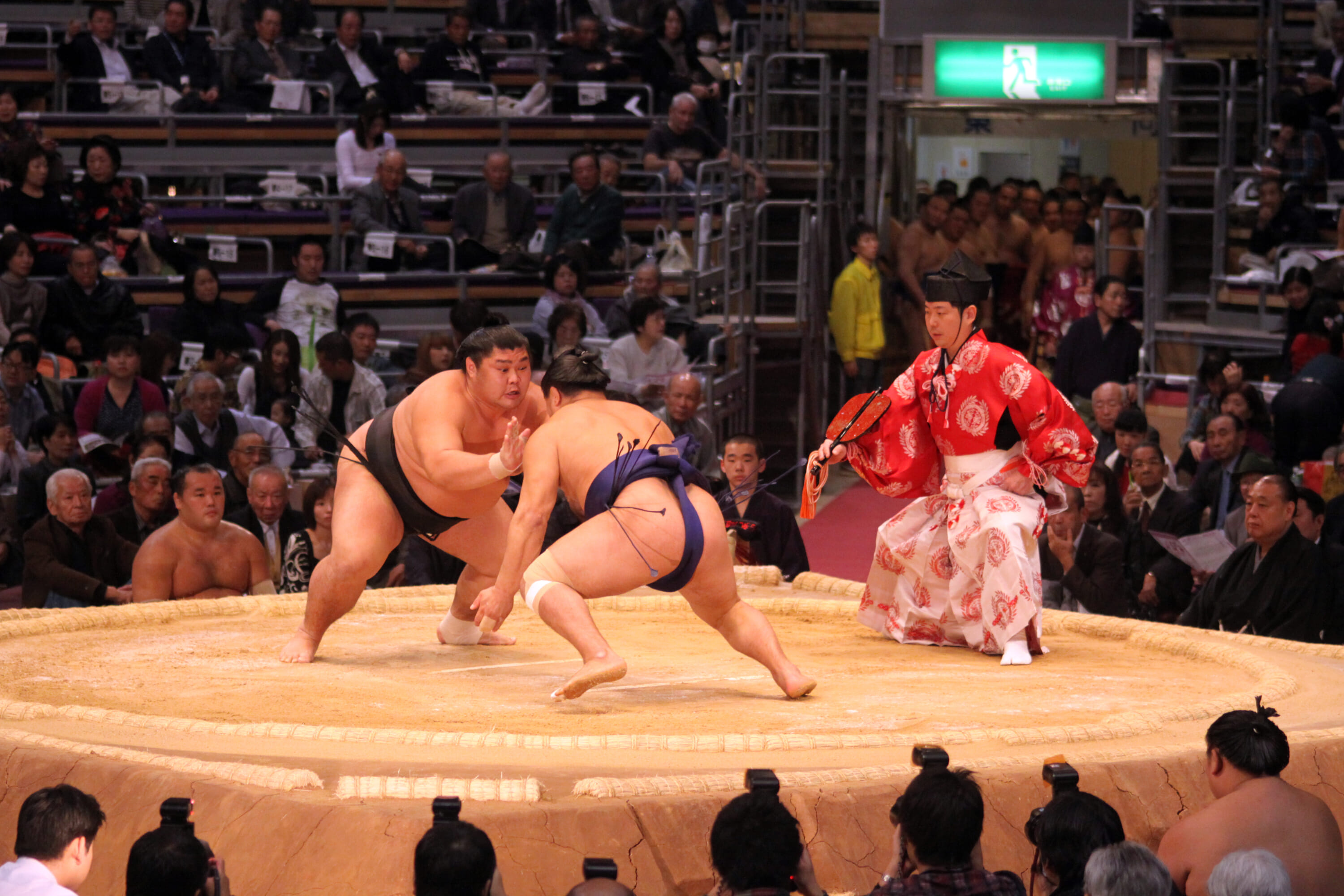
Visit a Sumo Tournament
If going to watch sumo is on your Japan itinerary, you can take a trip to Fukuoka to catch the November Grand Tournament. Taking place from the second to the fourth Sunday of the month, the tickets go on sale about two months in advance.
The November Grand Sumo Tournament is held in Fukuoka Kokusai Center, which is accessible from Fukuoka Airport by subway or bus. There are also buses available from Tenjin and Hakata. If you come from Tokyo, you’ll have to fly to Fukuoka. Consider exploring the area and the larger Kyushu region during your stay.
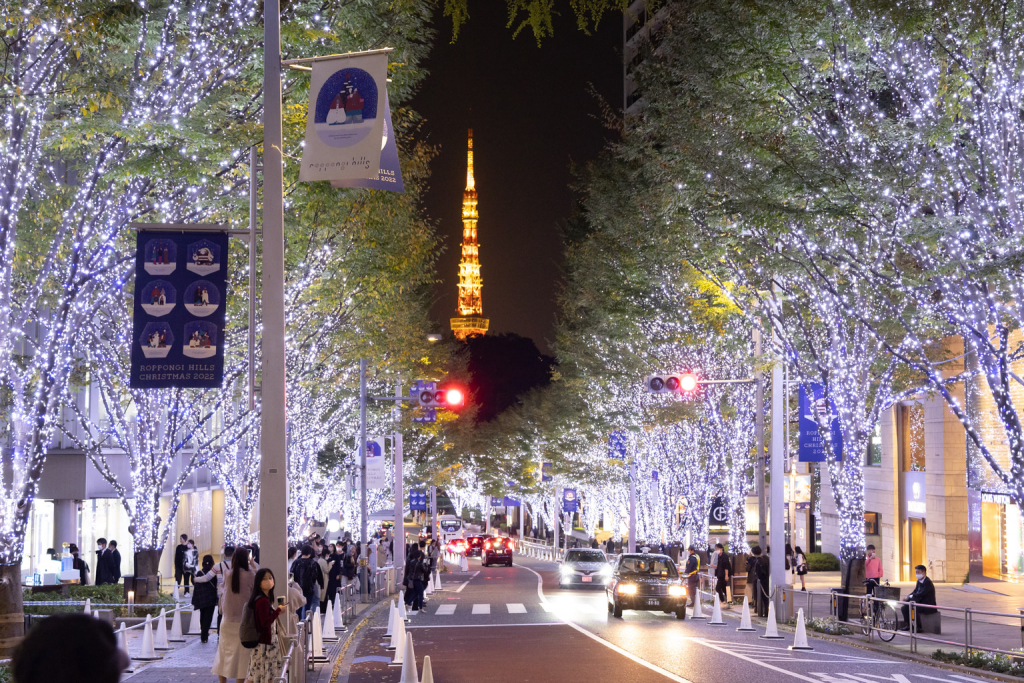
Check Out Winter Illuminations
Although November may not feel like winter, let alone Christmas, Japan hops on the winter illuminations very early each year. It often feels like they wait until the clock strikes midnight on November 1 to take down the Halloween decorations to put up the Christmas lights. Whether you think it’s too early or not, Japan’s winter illuminations are very pretty.
From the Christmas tree at Ebisu Garden Place to the Tokyo Midtown illuminations, there are plenty of iconic glimmering lights to stroll along in November.
Top Destinations To Visit in November
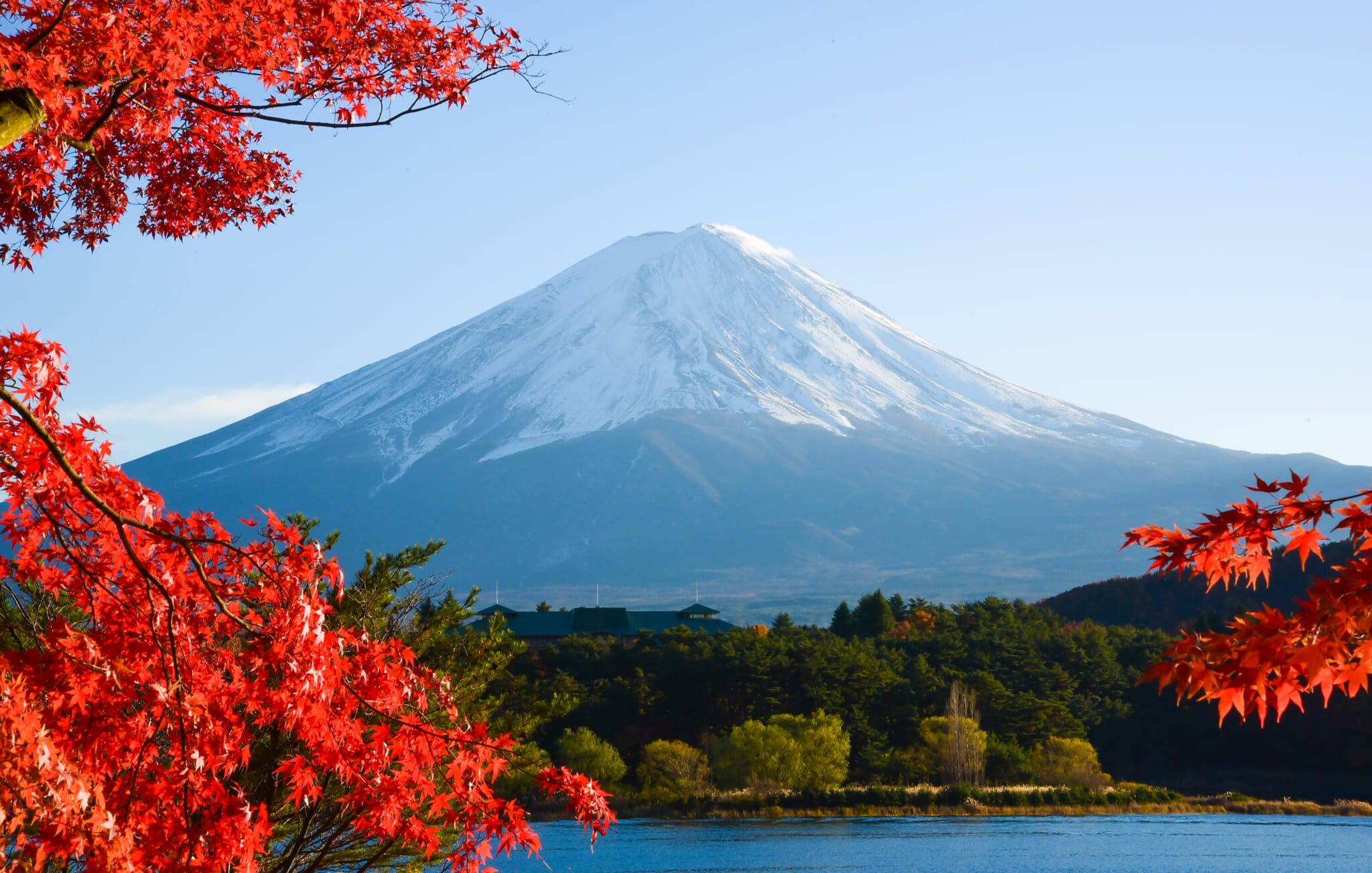
Lake Kawaguchi
With a stunning view of Mount Fuji reflected in the lake, Lake Kawaguchi is a popular destination year-round, but is particularly alluring when surrounded by crimson leaves in November.
Not to miss is the Fuji Kawaguchiko Autumn Leaves Festival, which takes place throughout much of the month. To accompany the spectacular view, there are food stalls, performances and lights.
Also popular is the famous Momiji Tunnel, just 3 kilometers away from the lake. It turns a bright red, which glows under the lights from sundown until 10p.m.
Lake Kawaguchi is about two hours away from central Tokyo, and is accessible by train or highway bus. The weather near the lake is cooler than in Tokyo. Make sure to pack warm sweaters and jackets, especially if you plan to stick around the festival at nighttime.
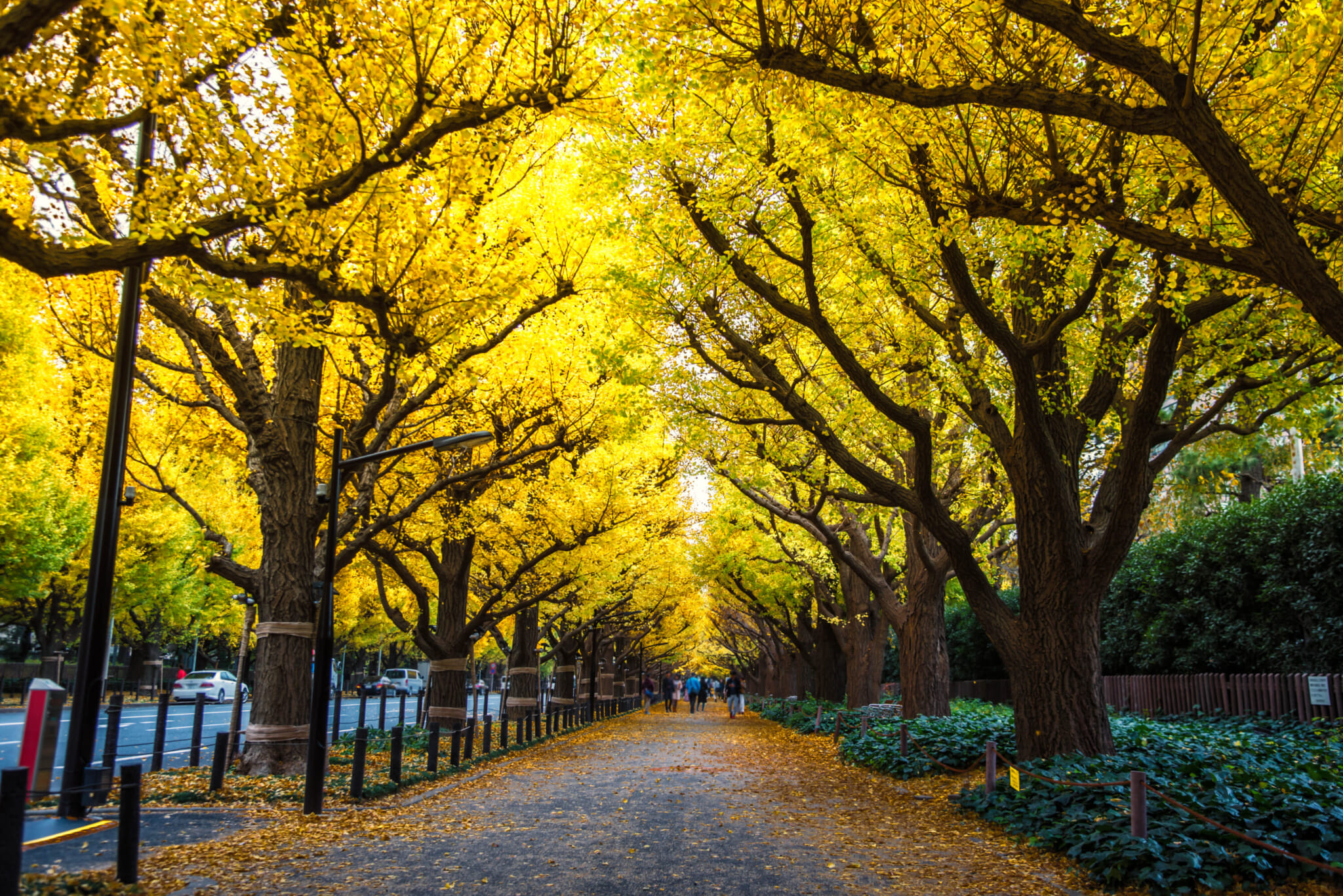
Meiji Jingu Shrine
Meiji Jingu Shrine in Harajuku is particularly lively in early November, when the Meiji Shrine Autumn Grand Festival takes place. The week-long festivities include traditional performing arts on the central stage in front of the main shrine. One of the highlights is the yabusame (Japanese horseback archery) performance that takes place on November 3.
Meiji Jingu Gaien is also famous for its Icho Namiki (Ginkgo) Avenue in the fall, when the street becomes a cloud and carpet of yellow leaves.
Meiji Jingu is easily accessible from JR’s Harajuku Station or Tokyo Metro’s Meiji-jingumae Station.
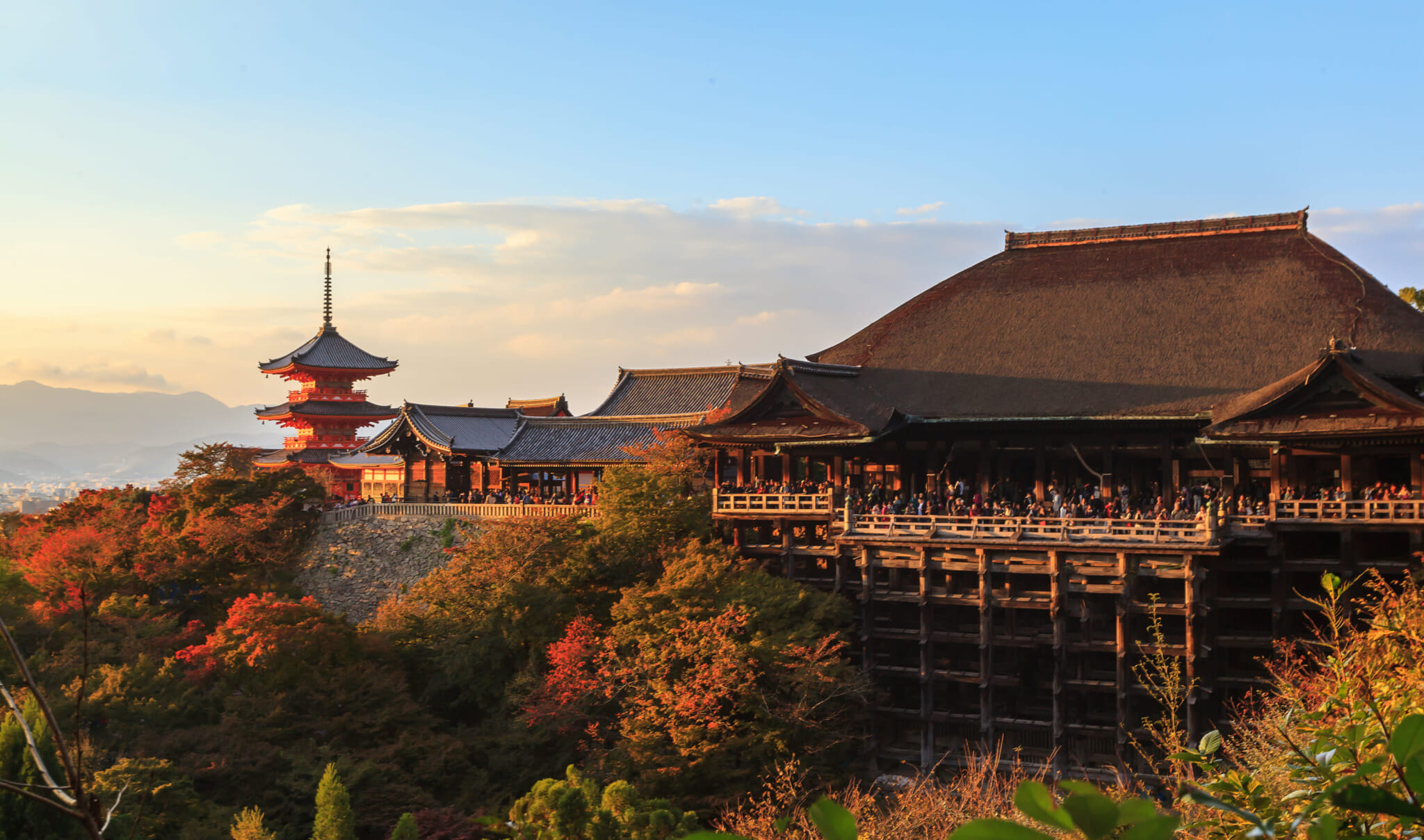
Kiyomizu-dera Temple, Kyoto
November is arguably one of the best times to visit Kyoto due to the pleasant weather and bright red and yellow leaves. One of the most famous spots in Kyoto for viewing the autumn foliage is at Kiyomizu-dera Temple. The reds and oranges of the leaves look even more vibrant next to the temple’s iconic three-story pagoda, and there is even a special light-up event in the latter half of November, during which the leaves glow. The ticket for entry is ¥400.
While visiting Kiyomizu-dera Temple, it is also worth doing some shopping in Higashiyama. Be aware, however, that it will be very crowded. This temple is always very popular, but even more so during the koyo season, and especially around sunset when the illumination begins. If you’re not a fan of large crowds, there are plenty of other temples in Kyoto to visit that won’t be so packed.
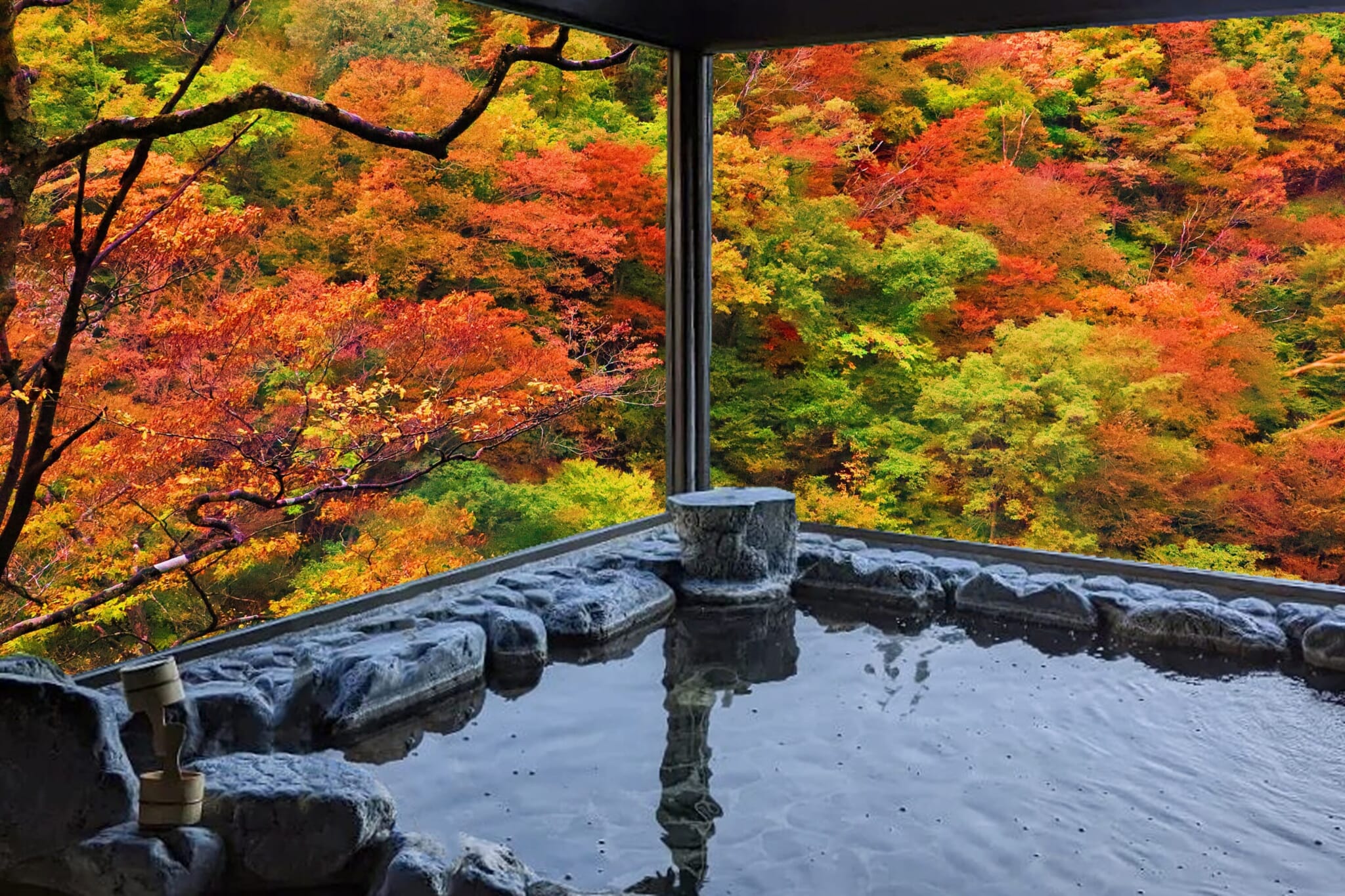
Travel Tips and Recommendations
Packing tips.
Overall, November is a gorgeous time to visit Japan. The weather isn’t too cold yet, and the drop in humidity brings bright blue skies and a crisp climate. However, that isn’t to say you won’t need warm clothes. You may need to pack sweaters, jackets and gloves, especially if you plan to visit northern Japan.
Transportation
Public transportation runs as usual in November. Just after typhoon season and before the snow, trains and buses are quite reliable, but make sure to check for any irregular weather if you have any long trips.
Accommodation Recommendations
There are plenty of accommodation options in Japan in November, though as it is a popular time of year to visit, make sure to reserve early. A traditional ryokan is always a great choice if you want an authentic hospitality experience. Consider staying in an onsen town as well, to warm up after a long day of exploring in the chilly outdoors.
Related Posts
- All About Autumn Leaves: Japan’s Fall Pursuit
- 13 Best Places to See Autumn Foliage in Kanagawa Prefecture
- The Ultimate Guide to Autumn Foliage In and Near Tokyo
- The Hills of Southern Kyoto are Alive with the Sights of Autumn
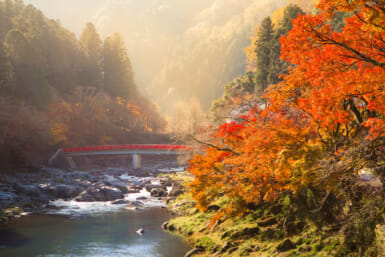
Japan Autumn Leaves Forecast 2024: Best Times To View Fall Foliage

Where To Get an Incredible Coffee in Kumamoto
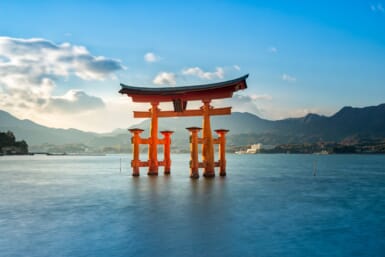
Japan in September: The Best Things To Do and Places To Visit

Fukuoka Fall Travel Guide: Must-See Foliage Spots & Cultural Experiences

Tokyo Ballet's "The Kabuki": East Meets West in a Powerful Ballet Experience
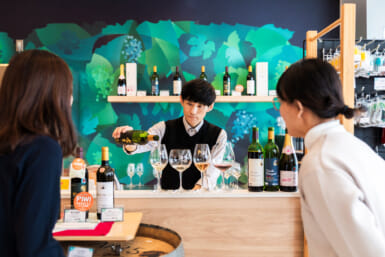
Hokkaido Wine Tour: Get Spirited Away in Japan’s Wine Country

A Gourmet Experience in the Heart of the Forest
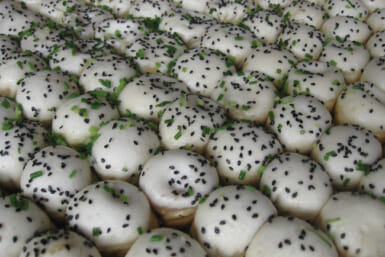
Enjoy a Shanghai Summer With These 7 Delicious Dishes

9 Tips for Japan Travel You Can't Afford To Miss
I f you’re planning a trip to Japan, know that the process is a commitment . We’ve gone all over the world and back again, even traveling full-time for two years with our young children.
Even so, planning a trip to Japan sometimes felt like a Herculean task. There are so many moving parts, rules and barriers that it was easy to be overwhelmed at times. After putting together what I’d deem a very successful first visit, I’ve put together some of my best Japan travel tips to help you plan the trip of a lifetime!
I promise, you won’t want to miss these tips for traveling to Japan – they’ll help you make the most of your time with the fewest hassles.
1. Plan as far in advance as you can
As frequent readers of this website know, we’re avid travelers and have been all over the world – sometimes hopping countries on just a few days’ notice.
Japan isn’t a place where I’d want to do that. Ever.
The most important of my tips for Japan travel is to give yourself as much lead time as possible.
We were shocked at just how important it is to plan a trip to Japan well in advance. In my experience particularly if you plan to visit during a peak time (roughly March through May and, to a lesser extent, September and October) you’ll be happiest if you start arranging your hotels 4-6 months in advance. Even 4 months before our March trip, a few small or specialty hotels were already sold out. When I looked to shift our itinerary 3 months in advance, our hotel in Tokyo was double the price I had paid.
But it isn’t just about booking your flights and hotels. There are so many cool attractions in Japan that require booking at least a month in advance. It’s not just the obvious ones! Everything from TeamLab Tokyo (which we got) to Pokemon Cafe (which we didn’t) sells out. Heck, even the wonderful onsen we visited had limited availability for private rooms a month in advance.
Unfortunately the need to lock down times and places so far in advance can make Japan travel planning very tricky. Give yourself plenty of time and try not to get overwhelmed – take it one area at a time and don’t be too disappointed if you can’t get into one specific attraction or hotel. Know that you’ll still have an incredible trip and you’ll be starting to consider a return visit while you’re still there!
Pro tip: When you’re planning, don’t be afraid to book through Klook ! It’s one of the most popular sites for booking activities throughout Asia. It’s easy to use and has a great reputation. We used it many, many times without a hitch.
2. Consider the overall structure of your itinerary
Obviously the first thing to nail down when you’re planning a trip to Japan is the basic framework of your trip: your flights and roughly which regions you’ll visit when. There are a few ways to do it, which I’ll go over here. Here are some ideas for family-friendly Japan itineraries .
If you’re coming from North America, chances are you’ll fly into one of Japan’s three main international airports: Narita (NRT), Haneda (HND) or Kansai (KIX). West coasters may have the luxury of choosing where they’ll go, while travelers coming from the midwest and east coast will probably have to take what they can get based on how their connections work out.
Both Narita and Haneda are in greater Tokyo, but Haneda is much much more convenient: our taxi ride was an easy 20 minutes, which we appreciated after spending most of a day traveling. Narita would have taken over an hour and been more expensive for our family of four.
The other airport option is Kansai, which is about an hour from downtown Osaka by train. A west coast family member recently chose an open-jaw itinerary that arrived in Osaka and departed from Haneda. That was a great option as it avoided an extra few hours of train travel – and depending on your itinerary it could allow you to choose a shorter duration Japan Rail Pass (but more on that later). When we considered a similar itinerary, unfortunately the connections weren’t as favorable and the price was a lot higher but be sure to evaluate options for your airport and dates.
The second half of structuring your itinerary is figuring out the order in which you want to visit Japan’s wonderful and diverse regions. On a first visit, most tourists split their time between Tokyo , Kyoto /Osaka and Hiroshima . It’s worth considering the order of your trip, especially if you end up with a roundtrip ticket to Tokyo (as most visitors do). If you’re lucky enough to have a KIX flight on one leg, your itinerary will mostly build itself.
There are two schools of thought on how to structure your Japan itinerary . This excellent book recommends exchanging your Japan Rail Pass voucher at the airport when you arrive and immediately hopping on a bullet train for Hiroshima as one of the top tips for travelling in Japan. In theory you could also take a short domestic flight to Hiroshima, as it’s less than 2 hours and sometimes only $50 per ticket. You’ll then slowly make your way back up to Tokyo to finish out your trip. The benefits of this option are that you’ll be able to sleep for much of the 6 hour travel time (since most visitors are exhausted after crossing so many time zones) and you’ll also start off in the quieter parts of the country before tackling the hustle and bustle of Tokyo.
We took a different approach and it worked out fine as well. Our trip started with 5 nights in Tokyo, which was just a busy as advertised but allowed us to settle in and feel as rested as possible when we were clocking 10 miles on foot each day. Then once we had our bearings we went all the way to Hiroshima and Miyajima Island. Our final stay was in Kyoto , halfway between Tokyo and Hiroshima. With only 10 nights in Japan, our stays in Miyajima and Kyoto was shorter and might have been harder with the kids right when we’d gotten off the plane.
I’d probably avoid closing out your trip in Hiroshima. The security line when we returned to Haneda was one of the longest I’ve ever waited in and you would likely have to build in three hours to check in and get through security, whether you’re taking the 5-6 hour train ride or the 2 hour domestic flight (remembering to allow 60 minutes to get to the Hiroshima airport from downtown or 2.5 hours from Miyajima Island and 2 hours for domestic check in). Going through all of that followed by an incredibly long international flight is just too brutal.
3. Always factor transportation into your advance planning
Speaking of transportation, there’s a lot of it in Japan and it should factor into your planning from the beginning in terms of both time and money.
Japan is famous for its shinkansen bullet trains, but in reality the nation’s transportation network is far more vast than most people realize until they visit. Japan has more than 30,000 km of rail, which would get your 3/4 of the way around the globe if it was all laid end-to-end. Those rails are part of everything from the bullet train lines that travel at 200 mph to regional railways to local subways.
Even within a single municipality, there can be multiple overlapping transit lines run by the government, private companies or public-private partnerships. As a visitor, it can sometimes be confusing or even frustrating.
You’ll want to download the excellent JapanTravel app by NAVITIME to your phone. You can also use it on your computer though I found that it didn’t work as well. Where this app is a standout is that it allows you to select which transit passes you have (or are considering purchasing) and shows you which routes are included and which ones aren’t.
Before we talk about money, passes and more I’ll just share a quick note about the time aspect of taking trains in Japan. Overall they’re extremely efficient and get you from A to B. But Japan is home to 46 of the 50 busiest train stations in the world, and when you first arrive prepare to be a little lost. When you’re taking local trains, I recommend allowing plenty of buffer time to what the directions tell you. A “20 minute trip” could easily take you 30 minutes if you struggle to find the platform for your connection or figure out which exit the walking portion of your directions indicate. It’s not your fault, but plan accordingly if you have time-specific activities.
The first piece to figure out – at least a month before your trip but not more than 90 days – is whether or not a Japan Rail Pass is right for you. This pass gives you access to nearly every Japan Rail operated line in the country for a specific number of consecutive days. If you’ll be flitting around to different regions in a fairly short period of time it can be a great savings! You won’t typically need it for your entire itinerary. For example, we made sure that we only needed ours for 7 of our 10 days.
To give you a sense of our our calculations worked, on the second day of our JR Pass we traveled from Tokyo to Hiroshima. On the final day of our pass we traveled from Kyoto to Tokyo. Those two legs alone would have cost us more than the 7 day pass, and of course we used it many times in between.
The very fastest bullet trains – which cut an hour off of the transit between Tokyo and Hiroshima – aren’t currently included with the Japan Rail Pass but they will be when the rail pass price increases in early 2024. That price increase is going to hurt and you’ll really have to evaluate whether or not the pass makes sense for you if you’re visiting beyond 3/31/2024 (the initial announcement indicated October 2023, but it seems to have been pushed back). Of course it’s also possible that fares for individual tickets will rise as well.
Fortunately there’s no need to worry about spending for the fancy “Green Car” service. The regular class is plenty comfortable and very spacious, with reclining seats and tray tables for your bento box. And families rejoice: children 6-11 can get half-price rail passes! Each adult can also take up to two children ages 1-5 on their laps (though only one is realistic) and babies travel free.
Things get much more complicated when you’re talking about local and regional transportation.
If you’re traveling kid-free or your kids are 0-5, your simplest option is to buy an IC card . These are essentially reloadable debit cards that can be used on nearly every transportation system in areas where tourists go in Japan, plus you’ll use them for cashless payment at lots of businesses and kiosks in the country. To make your life easy, once you get your IC card add it to your Apple Wallet or Google Pay app. You can even top up your IC card directly from your phone, and Apple Watch users can scan into trains with their wrists. With an IC card you won’t have to buy individual tickets for train rides, though if you’re taking lots of trains you may end up spending more than if you purchased a train pass – more details on those below.
Unfortunately for families with kids over 6, an IC card isn’t quite so simple. First, for your children to receive discounted child fares when they tap in to a train they have to be on a child IC card. You’ll need to bring the kid and their passport to the JR East office to get it (this is the same place where you’ll exchange your JR Pass voucher for actual tickets). Second, unless they have their own cell phone they won’t be able to use the digital option and will need to carry the physical card and top it up at an actual kiosk.
Given the different fares, shopping opportunities and different reloading options, you may wind up with times when most of the family is topped up and ready to go but a kiddo’s card needs money unexpectedly at the turnstile. The upside is the most of the time you can board basically any train in the country with a simple tap and no worrying about which train line you’re taking. Some families even load their kids’ souvenir shopping money on to the IC card and empower them to stay within their budgets. That’s a great hack for family travel in Japan!
If dealing with IC cards sounds like a headache or you think you’ll ride local trains a lot, there are some additional train passes worth considering. Our family got excellent value out of the 72 hour Tokyo subway pass . It covered nearly every non-JR train we needed to take around the city, including the one conveniently located underneath our hotel . The cost of that pass just can’t be beat!
As you go in the Kansai region (encompassing Kyoto, Osaka, Nara and more) you can consider the Kansai Thru Pass for 2 or 3 days (and kids at half price). It covers nearly all non-JR rail lines plus bus lines and can be used on non-consecutive days. If you have an active Japan Rail pass you can use that for select rides in the city as well, but JR lines aren’t as ubiquitous as elsewhere.
Whether or not a pass makes sense for you will depend on how much you plan to use public transportation versus taxis and Ubers. That said, there’s also the convenience factor of nearly every trip being covered without having to stop at a ticket machine every time you want to board. You could also consider separate passes for Keihan , Hankyu and buses.
There were a few times when we felt like a taxi was the best option, for instance when we were heading to the train station with all of our luggage in the pouring rain on our last morning in Japan. I was so glad that we brought folding car seats for our kids to ride safely – I consider them a “must” to travel Japan with a family!
Want to organize your plans?
Grab our fully-customizable Japan digital travel planner!
4. Get comfortable with Google Translate
The most useful app for Japan is definitely Google Translate. Unless you’re fluent in Japanese (reading and speaking) you’ll use it all day, every day. If you only take away two traveling in Japan tips, it should be this one along with planning as early as possible.
We encountered so many people in Japan who were eager to help us in our travels but virtually none of them spoke English. And that’s understandable, because it’s their country and Japanese is the local language. Thankfully Google Translate was there to bridge the divide. We had plenty of “conversations” that consisted of us typing a few sentences into our app and a Japanese person typing their reply into their own Google Translate.
The other piece of Google Translate that’s indispensable is translating text in images, whether it’s a sign on a storefront or a Japanese-only menu. Particularly if you have any dietary restrictions, you’ll want to take advantage of this.
I recommend that you download the Japanese dictionary within your Google app before you go. When you go to the translation module, click “Detect language” and find Japanese on the list. Then click the download icon to the right. Your translations will be faster when you’re on the ground and you won’t have to worry about using mobile data.
5. Bring power backups for your phone
If you’re anything like us, you’ll use your phone all day long in Japan. Directions, photos, translations and more… it all takes a toll.
We love this portable charger because it plugs directly into our iPhones without a cord and still fits in our pockets. There’s an Android-friendly version as well. We brought one with us, but only because I forgot the second one charging at home when I packed! There were plenty of days we wished we had the second battery pack. It tops my list of what to bring to Japan.
On our smarter days, we brought a USB charging cable and wall plug with us. Plenty of restaurants in Japan have outlets near the tables so we were able to charge while we ate.
Speaking of plugs, Japan uses the same style outlets as the USA. Even so, I ended up bringing this gadget because it saved tons of space and energy on USB wall adapters!
Other things to put in your day pack for Japan: a plastic bag to carry around your trash, a small travel washcloth and hand sanitizer.
6. Pack strategically
I have plenty more to say about what to pack for Japan specifically, but as you’re planning your trip it’s helpful to have an overall strategy that takes your itinerary into account.
First, packing light is always a good thing. I love the travel capsule wardrobe strategy for maximizing my outfits while minimizing my luggage.
Second, if you plan to take trains around the country (which nearly everyone does) know that there’s limited space for huge suitcases in each compartment. Carry-on suitcases and travel backpacks will fit on the overhead racks without issue.
For our family of four, we traveled with two carry-on suitcases, one 35L travel backpack (which I’m wearing above) and our kids backpacks. We also tucked this awesome packable daypack into our luggage to use on the ground. Since we were sharing luggage, we made liberal use of packing cubes to organize everyone’s stuff. Japan isn’t a country that requires a lot of specialized equipment and we made sure to book one hotel with laundry , so packing light was easy!
Now for the strategy part… our itinerary included a very busy 48 hour stretch that saw us taking trains, buses, boats and taxis as we went all the way down to Miyajima Island and doubled back to Kyoto with a half-day stop in Osaka. It was a whirlwind!
But thanks to the excellent Ta-Q-Bin luggage forwarding service run by Yamato, we didn’t have to lug all of our stuff with us. Ta-Q-Bin is beloved by locals and visitors alike, as it reliably and affordably moves your items around the country. The service is available via 7-11 and many hotels. We arranged it the night before with the concierge at our Tokyo hotel . For just $50 we sent both of our suitcases and a supplied cardboard box containing the kids’ backpacks to Kyoto, and we just brought our 35L backpack and daypack for two nights on Miyajima Island. Without a hitch, our items were waiting in our hotel room in Kyoto when we got there!
Having the freedom to move through busy parts of your itinerary unencumbered is amazing. Sure there are luggage lockers in many places (the one time I tried to snag one they were full) but we didn’t always go and come back the same way.
Some visitors also use Ta-Q-Bin on the day they arrive in Japan. While the service generally calls for about 48 hours of lead time, Yamato offers same-day service within Tokyo from the airports if your flight comes in early enough. That means you can drop off your luggage when you arrive and immediately go sightseeing without stopping at your hotel first!
7. Engage with Japanese people
While it’s true that Japanese people are generally quiet and respectful in public, don’t let that scare you from interacting. Overall we found warmth, generosity and an overwhelming desire to help us as tourists – all of this despite the understandable language barrier.
We encountered kindnesses of all sizes, from the businessman who went ten minutes out of his way to help us find a hidden train station to the young people who saw us picnicking and offered us a spare tarp to sit on. Even though there are differences in how we approach public life, plenty of Japanese people we met were happy to chat about their favorite restaurants, the sports teams they support and all of the other normal aspects of daily life.
Private or small-group tours are a great way to forge those connections, even for the DIY traveler. You’ll have an opportunity to ask all of your burning questions about life in Japan and hear an insider’s perspective from someone who is eager to be a bridge.
8. Don’t be afraid of unfamiliar (or inexpensive!) foods
I’m not afraid to say that Japan’s food scene is incredible. Whether you’re craving fresh, creative, comforting or affordable you’ll find it in spades. But the most important thing to bring when you dine (other than perhaps a reservation) is an open mind.
You’ll undoubtedly encounter plenty of foods in Japan that you never imagined, from cabbage-laden okonomiyaki to octopus-filled takoyakio to sakura mochi wrapped in salt-pickled leaves for dessert. As long as they’re within any particular dietary restrictions you have, give it all a shot!
On the note of dietary restrictions, be sure to have your Google Translate app ready at restaurants if you’re particular about what you’re eating. It can be tough.
Pro tip: If you’re looking for pork-free ramen or vegan ramen in Tokyo, don’t miss the rainbow ramen at Afuri. There are locations throughout the city.
By the same token, don’t discriminate against affordable food in Japan. There are plenty of solid options where you can get yakitori , sushi or fried chicken for just a few dollars and they’re absolutely delicious. Many Japanese people grab sandwiches or other simple lunch foods at convenience stores like 7-11 or Lawson’s – these are perfect to bring along for a lunch picnic in one of the thousands of beautiful parks you’ll stumble across.
I’ll be honest and say that we had one of our most filling and satisfying breakfasts at Denny’s of all places – but it was delicious chicken and rice porridge for the adults and broiled salmon with rice for the kids. You could eat for $15-20 per day and really enjoy a huge range of Japanese food!
9. Plan some unique activities
With the ever-increasing costs of flights and hotels, it’s tempting to try to save on other parts of your trip to Japan. There are plenty of free things to do in Japan, from visiting all of the unique temples and shrines to searching out your favorite garden.
But it would be a shame to miss out on some of the more unique things to do in Japan that you have to pay for. Check out some of these great only-in-Japan experiences that we loved:
- Take an in-home cooking class
- Dress in a kimono and participate in a traditional tea ceremony
- Attend a sumo tournament
- Stay in a traditional ryokan where you can enjoy everything from sleeping on futons to soaking in an onsen to dining on a local gourmet breakfast
Of course there are a million other things you can do in Japan! One fact is certain: no matter where you go or what you, you’ll walk away anticipating your next visit.
Planning your trip to Japan
I hope these travel tips for Japan have give you the confidence to plan your own adventure!
Ready to dive in? Don’t miss these helpful resources for planning your own Japan trip!
- Buy your Japan Rail Pass
- Best Things to do in Japan With Kids: A Kid’s Take
- Essential Japan Itinerary: 10 Days of Family-Friendly Travel
- What to Pack for Japan in Spring (and What to Leave at Home)
- Things to do in Tokyo With Kids: Itinerary for 4 Days of Old and New
- The Best Hotels in Tokyo for Families (and How to Choose Yours)
- Visiting Kyoto With Kids: 2+ Day Itinerary + Must-Read Travel Tips
- Best Family Hotels in Kyoto
- Awesome Pokémon Things to do in Japan
- Visiting the A-Bomb Sites in Hiroshima with Kids
- 10 Japan Cultural Activities & Attractions For Your Bucket List
The post 9 Tips for Japan Travel You Can’t Afford To Miss appeared first on The Family Voyage .
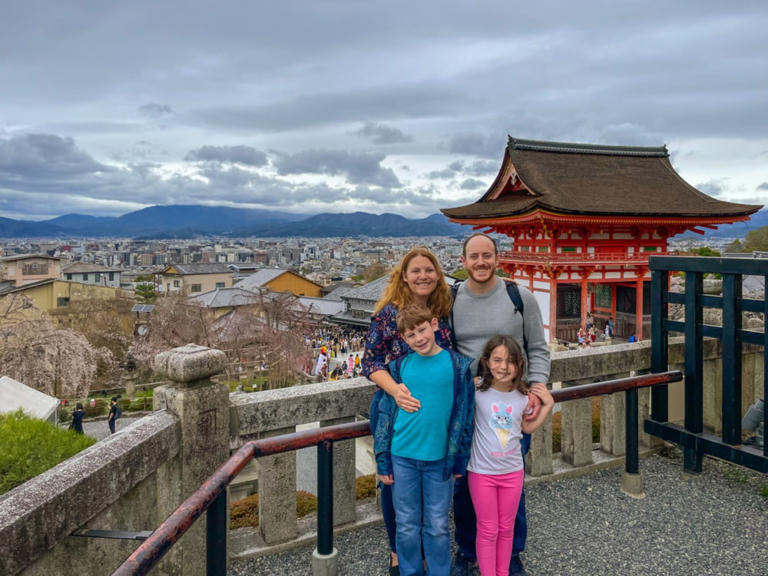
- Destinations
Here are the best places to visit in Japan for each season
By Jemima Skelley | 16 hours ago
Japan is one of the most popular tourist destinations for Aussies heading overseas in 2024.
One of the things that makes it so appealing is that it's full of things to do, see, eat, and explore for the whole year – different parts of the country shine during each season.
But where to go? And when?
Experts at Japan Rail Pass have handpicked the top must-visit spots in Japan for every season to help you make the most of your trip.
READ MORE: Planning a trip to Japan? Everything to know before you go
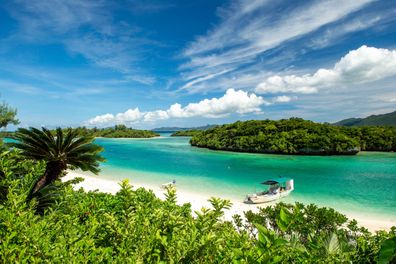
Summer locations to visit in Japan
Okinawa Prefecture
Japan's southernmost region, Okinawa Prefecture, offers a tropical paradise with islands like Miyako-jima and Ishigaki, known for their beautiful beaches and crystal-clear waters.
This summer hotspot offers everything from snorkelling in vibrant coral reefs to relaxing on pristine white sands.
The 10,000 Eisa Dancers Parade in Naha is a highlight of Okinawa's summer festivals, showcasing traditional dance and music. For a classic summer holiday vibe, Okinawa is the place to go.
Hokkaido, Japan's northernmost island, is a place to escape the summer heat, with cooler temperatures that offer a refreshing change. Known for its volcanoes, natural hot springs (onsen), and seafood, it provides a perfect blend of relaxation and adventure. This season is ideal for exploring Daisetsuzan National Park to hike and cycle amidst stunning landscapes.
READ MORE: These are the best beaches in Australia, as voted by our readers
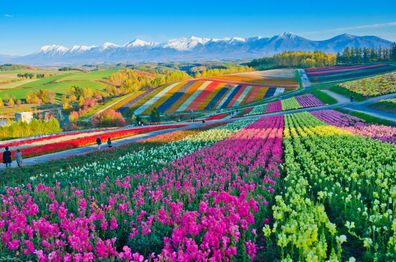
Furano and Biei flower fields on the island offer a vibrant display throughout the summer. In early summer, the lavender fields in Furano are particularly striking. Later in the season, fields of poppies, cosmos, and sunflowers create a colourful mosaic across the landscape of Biei.
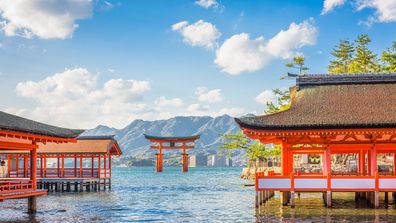
Autumn locations to visit in Japan
Lake Kawaguchiko, Yamanashi
Lake Kawaguchiko, one of the Fuji Five Lakes, is a top spot for autumn leaf viewing in Japan. The Momiji Corridor and Tunnel offer breathtaking views of Mount Fuji framed by vivid red maple leaves. Peak colours appear from mid-November to early December, making this the perfect time to visit.
For a unique perspective, take a boat ride on the lake to see Mount Fuji and the autumn foliage reflected on the water.
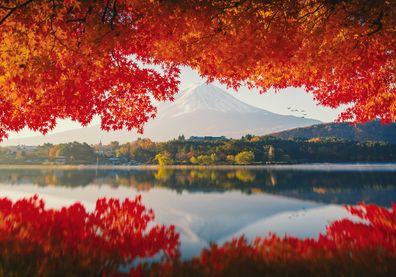
Naruko Gorge, Miyagi
Naruko Gorge in Miyagi Prefecture is also a must-see during autumn, with its 100-meter-deep gorge blanketed in vibrant reds, oranges, and yellows from mid-October to early November.
The best views are from the observation deck at the Narukokyo Resthouse, where the iconic Ofukazawa Bridge stands out against the leaves. A stroll along the Naruko Gorge Walking has the best views of the foliage, rock formations, and the Daiya River below.
READ MORE: Grocery store tourism: Why travellers are flocking to supermarkets on holiday

Winter locations to visit in Japan
Shirakawago, Gifu
Shirakawago is a perfect winter destination, offering a glimpse into Japan's past with its snow-covered gassho-zukuri farmhouses. These steep-roofed structures are designed to endure the heavy snowfall that blankets the village, turning it into a serene and picturesque scene.
Jigokudani Monkey Park, Nagano
Humans aren't the only ones seeking warmth in Japan's winter—at Jigokudani Monkey Park in Nagano, Japanese macaques, or snow monkeys, take full advantage of the natural hot springs.
READ MORE: Liquid hand luggage rules return in the EU this weekend - here's what that means

Tucked away in the snow-covered mountains, this park offers a unique winter experience as you watch these wild monkeys lounge in the steamy onsen. Visiting between January and February is ideal for seeing them surrounded by snow, creating a striking contrast between the frosty landscape and the warm waters.
Spring locations to visit in Japan
Mount Yoshinoyama, Nara Prefecture
No spring trip to Japan is complete without experiencing the cherry blossoms, and Yoshinoyama in Nara Prefecture is one of the best places to do so. This mountain is renowned for its breathtaking cherry blossom display, featuring around 30,000 trees that bloom from late March to mid-April. The cherry trees, planted over 1,300 years ago, cover the mountain in a stunning array of pink and white blossoms.
Hike up the mountain or take the ropeway to the popular Hanayagura observation point for spectacular views.
READ MORE: What to know about Japan's famous cherry blossom season
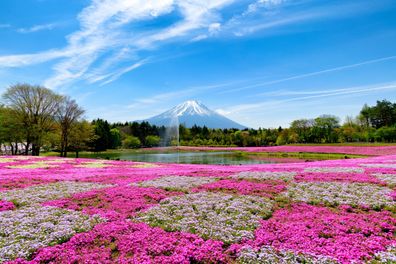
Mount Fuji Area, Fuji Shibazakura Festival
While Mount Fuji is a year-round attraction, spring elevates its beauty to a whole new level. The snow-capped peak stands majestic against a backdrop of blooming flowers and clear skies.
One of the best spots to experience this is at the Fuji Shibazakura Festival in Yamanashi Prefecture. From mid-April to late May, vibrant fields of pink moss phlox, or shibazakura, carpet the landscape, creating a stunning contrast with the iconic mountain in the background.
Auto news: Best electric cars coming to Australia in 2025.

Sydney wins big as the local 2024 World Travel Awards are revealed

The incredible experience you 'must add to your bucket list'

Here's everything to know before a solo trip to Vietnam
- Today's deals
- Search travel guides

The Ultimate Guide to Major Airports in Japan: Navigating Your Way Through Japan’s Gateways
Welcome to Japan, a land of rich history, vibrant culture, and bustling urban landscapes. Whether you’re visiting for business or pleasure, navigating through Japan’s major airports can be a seamless experience with the right information at your fingertips. This guide will walk you through the essential details of Japan’s key airports including Narita International Airport, Haneda International Airport, Kansai International Airport, and more. From facilities and transportation options to travel tips and local insights, we’ve got you covered.
Narita International Airport (NRT)
Located approximately 60 kilometers east of central Tokyo, Narita International Airport is one of the primary gateways to Japan. Handling the majority of international flights, Narita features a vast array of facilities designed to make your journey comfortable and convenient.
Narita is equipped with numerous amenities including shopping centers, dining options, and relaxation areas. Travelers can enjoy duty-free shops, luxury brands, souvenir stores, and a variety of restaurants offering local and international cuisine.
Transportation
Getting to and from Narita is straightforward with several options available:
- Rail: The Narita Express (N’EX) and Keisei Skyliner provide swift access to Tokyo and other major cities.
- Bus: Limousine buses connect Narita with many hotels and destinations across Tokyo.
- Taxi: Taxis are available but can be expensive.

Haneda International Airport (HND)
Closer to Tokyo’s city center, Haneda International Airport is a popular choice for both domestic and international travelers. Known for its efficiency and cleanliness, Haneda offers a smooth transit experience.
Haneda boasts excellent facilities, from high-end shops to delicious eateries. The Edo Market in Terminal 3 recreates a traditional Edo-period streetscape and is a must-visit.
Accessing Haneda Airport is convenient by:
- Monorail: The Tokyo Monorail connects the airport directly to Hamamatsucho Station.
- Train: Keikyu Railways provide services to various parts of Tokyo and beyond.
- Bus: Multiple bus lines run between Haneda and major locations in Tokyo.
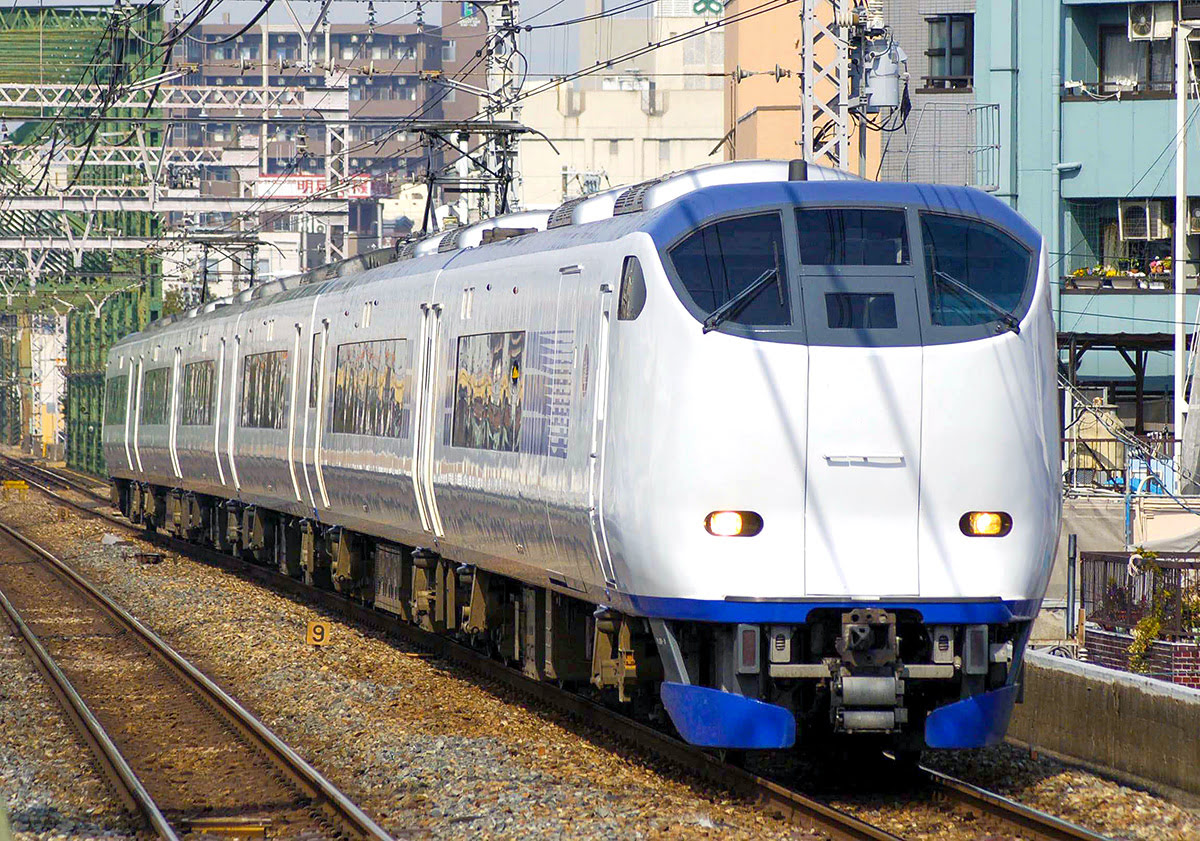
Kansai International Airport (KIX)
Situated on an artificial island in Osaka Bay, Kansai International Airport serves the Kansai region including Osaka, Kyoto, and Kobe. It’s renowned for its cutting-edge design and efficient services.
Kansai offers a plethora of facilities including duty-free shops, unique eateries, and comfort amenities. The Sky View Observation Hall provides stunning panoramic views of the airport and Osaka Bay.
Transportation options at Kansai include:
- Train: The JR Haruka Express and Nankai Airport Line offer direct services to Osaka, Kyoto, and beyond.
- Bus: Airport Limousine buses provide connections to major hotels and city centers.
- Ferry: High-speed ferry services are available to Kobe Airport.
Chubu Centrair International Airport (NGO)
Located on an artificial island in Ise Bay near Nagoya, Chubu Centrair International Airport serves as the main gateway to the Chubu region. Known for its efficiency and high level of service, Chubu Centrair offers a delightful travel experience.
Chubu Centrair is home to the Sky Town Shopping Center, featuring a variety of shops and restaurants. The airport also boasts unique amenities such as a public bathhouse with views of the runway and Ise Bay.
Travelers can reach Chubu Centrair conveniently by:
- Train: The Meitetsu Airport Line provides direct access to Nagoya Station in about 30 minutes.
- Bus: Numerous bus routes connect the airport with various destinations in the Chubu region.
- Ferry: High-speed ferries are available to Tsu Airport Line.

Fukuoka Airport (FUK)
Fukuoka Airport is a major international airport located in the Hakata-ku area of Fukuoka city on Kyushu island. It is renowned for its proximity to the city center and easy accessibility.
Fukuoka Airport offers a range of facilities including duty-free shops, cafes, restaurants, and lounges. The domestic terminal is particularly well-equipped, catering to the busy traffic of domestic travelers.
Getting to and from Fukuoka Airport is highly convenient:
- Subway: The Fukuoka City Subway connects the airport directly to Hakata Station and Tenjin, the city’s downtown area, in about 10 minutes.
- Bus: A comprehensive bus network operates services to key locations around Fukuoka city and beyond.
- Taxi: Taxis are readily available and provide a quick option for reaching the city center.
Osaka Itami Airport (ITM)
Also known as Itami Airport, Osaka International Airport primarily handles domestic flights. Located in the Itami and Toyonaka regions, it offers convenient access to Osaka, Kobe, and Kyoto.
Osaka Itami boasts a range of facilities including shopping options, eateries, and passenger services. The rooftop observation deck is a popular spot for plane enthusiasts and offers stunning views.
Access to Osaka Itami Airport is easy via:
- Monorail: The Osaka Monorail makes stops at various points in the Osaka region.
- Bus: Limousine buses connect the airport with major areas in Osaka, Kobe, and Kyoto.
- Taxi: Taxis are available but can be pricey compared to other transport options.
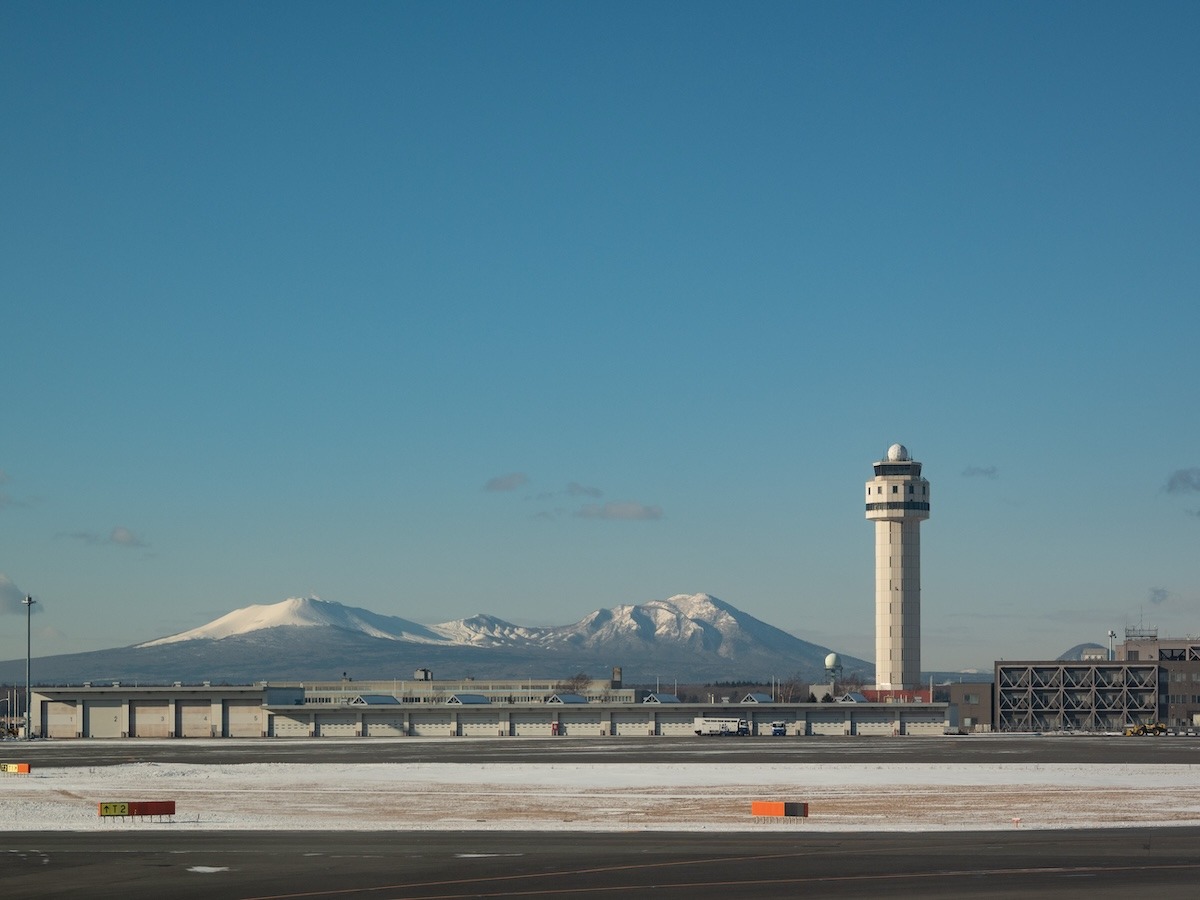
New Chitose Airport (CTS)
Serving the island of Hokkaido, New Chitose Airport is located southeast of Sapporo. It is the largest airport in Hokkaido and handles both domestic and international flights.
New Chitose is well-equipped with shopping centers, gourmet dining options, and various entertainment facilities. Highlights include a Royce’ Chocolate World and the Doraemon Waku Waku Sky Park.
Transportation options at New Chitose include:
- Train: The JR Rapid Airport Line connects the airport to Sapporo Station in about 40 minutes.
- Bus: Airport buses provide access to key destinations in Hokkaido.
- Car Rental: Multiple car rental services are available at the airport for those who wish to explore Hokkaido by car.
You may also like

Unveiling the Magic of Club Bali: Your Ultimate Guide to an Exquisite Balinese Escape

Discover the Best Japanese Souvenirs in Osaka: A Shopper's Guide

Ultimate Odaiba Date: A Perfect Itinerary for Romantic Adventures in Tokyo’s Futuristic Oasis

Uncovering India: The Ultimate Guide to Unique Souvenirs and Where to Find Them

Discover the Best Souvenirs in Ho Chi Minh City: What to Buy and Where

Top Must-See Attractions on the Gold Coast: Your Ultimate Travel Guide

Discover the Best Art Museums in Tokyo: A Guide to Unmissable Attractions

Unveiling Honolulu: Top Things to Do in Hawaii's Vibrant Capital

Unveiling Budapest: A Guide to the Best Things to Do in Hungary's Enchanting Capital
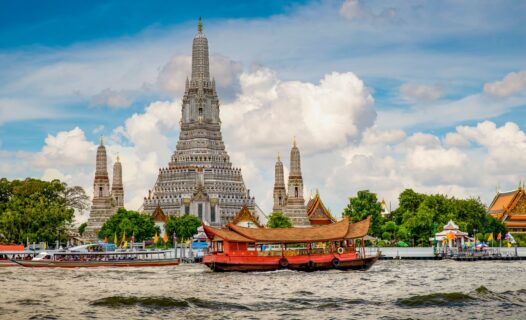
Discover Thailand: Top Must-Visit Destinations for an Unforgettable Journey

Kaohsiung on a Shoestring: Unveiling Travel Costs for Every Budget

Discover Seoul's Heart: A Complete Guide to Summit Hotel Dongdaemun and Surroundings

Unwind and Relax: Top 8 Best Hot Spring Hotels in Taitung for a Perfect Soak

Discover the Charm of Geoje Island: Top Attractions in Geoje-si for Your Ultimate Island Getaway
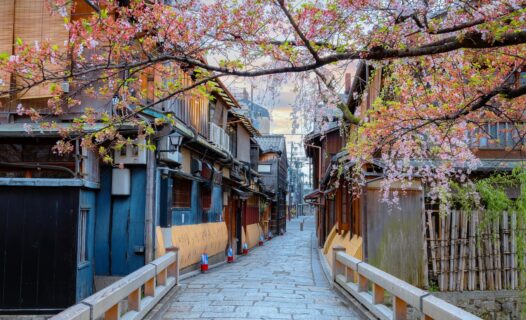
Discover Kyoto's Hidden Gems: Unveiling Secret Spots for an Unforgettable Journey

Top Things to Do in Pyeongchang-gun: A Nature Lover's Paradise

Exploring Noboribetsu Onsen: Uncover the Best Attractions in Japan's Hot Spring Haven

The Ultimate Guide to Visiting Auckland, New Zealand: Best Times, Top Attractions, and Essential Tourist Tips
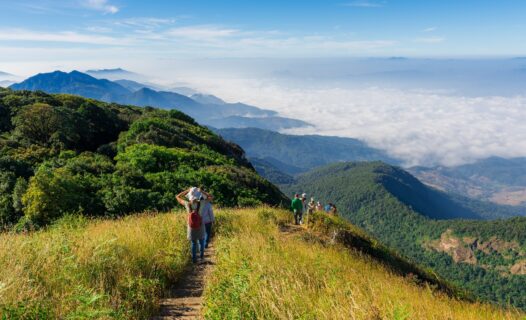
Unveiling Chiang Mai's Hidden Gems: Top Tourist Spots You Can't Miss

Rejuvenate in Taipei: Discover the City’s Best Massage and Wellness Spots

Explore the charm of Club Bali with our detailed travel guide. From stunning resorts to cultural experiences, we've got everything you need for an unforgettable holiday!

Discover the Best Japanese Souvenirs in Osaka: A Shopper's Guide
Discover the best Japanese souvenirs in Osaka. From traditional crafts to unique delights, find out where to shop for the perfect memento of your Osaka trip.

Discover the ultimate Odaiba date itinerary in Tokyo. From dazzling attractions to romantic dining spots, plan the perfect day with our comprehensive travel guide.

Explore the best Indian souvenirs, from traditional handicrafts to local markets, and learn where to find unique gifts to bring home.

Explore the ultimate shopping guide for Ho Chi Minh City with local treasures and must-buy souvenirs, including top shopping spots and cultural tips.

Discover the top must-see attractions on the Gold Coast with our ultimate travel guide. Explore iconic landmarks, stunning beaches, thrilling theme parks, and much more.

Explore the best art museums in Tokyo with our comprehensive guide. Discover top attractions, must-see exhibits, and insider tips for art lovers.

Unveiling Honolulu: Top Things to Do in Hawaii's Vibrant Capital
Discover the best things to do in Honolulu, from iconic landmarks and historical sites to outdoor adventures and culinary delights. Plan your perfect itinerary with our comprehensive guide.

Unveiling Budapest: A Guide to the Best Things to Do in Hungary's Enchanting Capital
Discover the best things to do in Budapest with our comprehensive guide. From historic landmarks to thermal baths, exploring the vibrant nightlife, and more. Your ultimate travel guide to Hungary's enchanting capital.

Explore the best places to visit in Thailand with our travel guide. Discover top destinations, hidden gems, and everything you need for a perfect trip to Thailand.

Discover how to explore Kaohsiung affordably with this comprehensive guide that breaks down travel costs for accommodation, food, transportation, and attractions.

Discover Seoul's Heart: A Complete Guide to Summit Hotel Dongdaemun and Surroundings
Explore the ultimate travel guide to Summit Hotel Dongdaemun in Seoul. Learn about top attractions, nearby dining options, cultural experiences, and the best amenities offered by this hotel.

Discover the best hot spring hotels in Taitung for a perfect soak. Find the top accommodations, amenities, and experiences for a relaxing retreat in Taiwan.

Unveil the top attractions in Geoje-si, from scenic beaches and historical sites to adventure activities and cultural spots. Your ultimate Geoje travel guide.

Discover Kyoto's Hidden Gems: Unveiling Secret Spots for an Unforgettable Journey
Explore Kyoto like never before. Discover hidden gems, secret spots, and non-touristy places with our ultimate travel guide for an unforgettable adventure.

Top Things to Do in Pyeongchang-gun: A Nature Lover's Paradise
Discover the best things to do in Pyeongchang-gun, including winter sports, cultural sites, nature exploration, and local cuisine. Plan your perfect trip to this beautiful South Korean destination.

Exploring Noboribetsu Onsen: Uncover the Best Attractions in Japan's Hot Spring Haven
Discover the best attractions in Noboribetsu Onsen, Japan's renowned hot spring town. From Hell Valley to Bear Park, explore all the must-see sites with our travel guide.

Discover the best time to visit Auckland, New Zealand, and explore top attractions, dining options, and travel tips. Plan your perfect Auckland adventure!

Unveiling Chiang Mai's Hidden Gems: Top Tourist Spots You Can't Miss
Explore the best tourist spots in Chiang Mai! Our comprehensive guide unveils hidden gems, top attractions, and must-see places for an unforgettable adventure.

Explore the best massage and wellness spots in Taipei with our ultimate guide. Find the top-rated spas and massage centers for a perfect relaxation journey.
Last Updated: September 03, 2024
Current language
All languages.
- Cocept・About Quality
- Custom Tours
- Entertainment
- Training for Multinational Corporate Staff
- Global Teambuilding
- Experiencing Japan on Incentive Trips
- Private Lesson
- VIP Exclusive Planning & Production
- Medical tourism
- Helicopter Service
- Beach Wedding
- Japanese Corporate Tours and Training Programs
- The Fascinating Elements Behind the Kabuki Stage
- Samurai Sword Fighting Experience: Savor the Soul and Skills of the Samurai
- Exploring the Delicate Blends of Japanese Whiskey Experience
- Tea Ceremony Experience: The Spirit of Japanese Tradition and Hospitality
- Superb Esthetic Experience Healing Time
- Cooking Class
- Experience the Art of Traditional Cuisine
- Experience traditional Japanese techniques
- The world’s number one subculture powerhouse!
- Testimonial
- How to apply/Q&A
- Hospitality for foreigners
- International entertainment
- Achievements
- Japanese traditional
- News&Information

- Japan Travel Packing Checklist: What to Bring for a Stress-Free Trip

Planning a trip to Japan is an exciting adventure, but packing can feel overwhelming with so much to consider. From navigating cultural customs to preparing for diverse climates, having the right items in your suitcase can make all the difference. Whether you’re visiting bustling cities or serene countryside, this comprehensive packing checklist will ensure you’re fully prepared for every experience. Say goodbye to packing stress and hello to a seamless, enjoyable journey through Japan!
Why Proper Packing for Japan is Crucial for a Smooth Trip

Packing correctly for your Japan trip is essential to ensure a hassle-free experience. With Japan’s unique climate, cultural norms, and efficient but sometimes crowded public transportation, bringing the right items can make your journey much smoother. A well-planned packing list will help you avoid unnecessary purchases, stay comfortable in varying weather conditions, and respect local customs. By preparing properly, you can focus on enjoying your trip without the stress of missing essential items or overpacking.
Must-Have Items for Your Japan Travel Packing List
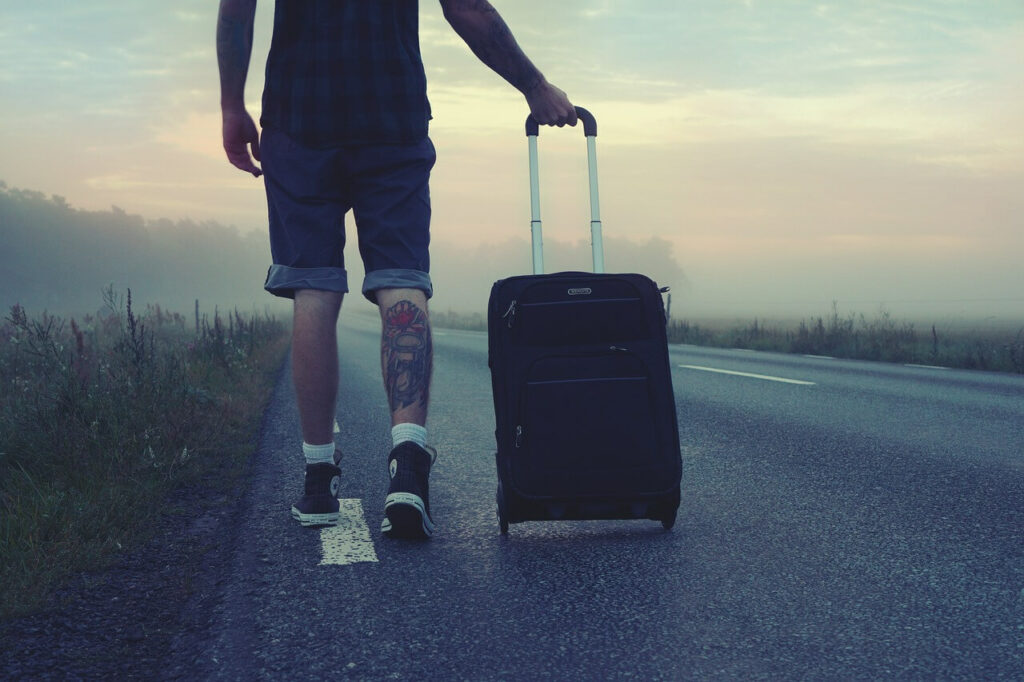
The Ultimate Japan Travel Packing Checklist
Creating the ultimate Japan travel packing checklist ensures you’re fully prepared for your adventure. Begin with essential documents like your passport, visa, and travel insurance. Next, consider Japan’s unique climate; pack layers for varying weather and comfortable shoes for exploring. Don’t forget cultural items like modest clothing for temple visits. Electronics are also vital, so bring a universal adapter and portable charger. Finally, pack toiletries and medications, as certain items might be hard to find in Japan. This checklist will help you travel with confidence, ensuring nothing important is left behind.
Essential Items You Can’t Forget for Japan
When packing for Japan, certain items are indispensable for a comfortable and enjoyable trip. A reliable travel adapter is crucial since Japan uses Type A and B plugs. Comfortable walking shoes are a must, as exploring Japan often involves lots of walking. Pack a small, portable Wi-Fi router to stay connected, especially in remote areas. Also, include a reusable water bottle; Japan has clean drinking water available everywhere. Lastly, carry a phrasebook or download a translation app to help with communication. These essentials will help ensure your trip goes smoothly.
Packing Light for Japan: How to Do It Right
Packing light for Japan is crucial, especially if you plan to travel between cities or use public transportation. Start by selecting versatile clothing that can be layered, adapting to Japan’s varying climates. Opt for lightweight, wrinkle-resistant fabrics that are easy to wash and quick to dry. Minimize toiletries by taking advantage of Japan’s well-stocked convenience stores for essentials. Limit your luggage to a carry-on-sized bag to make navigating through busy train stations easier. Remember, packing light not only simplifies your journey but also enhances your travel experience in Japan.
Seasonal Packing Tips for Japan
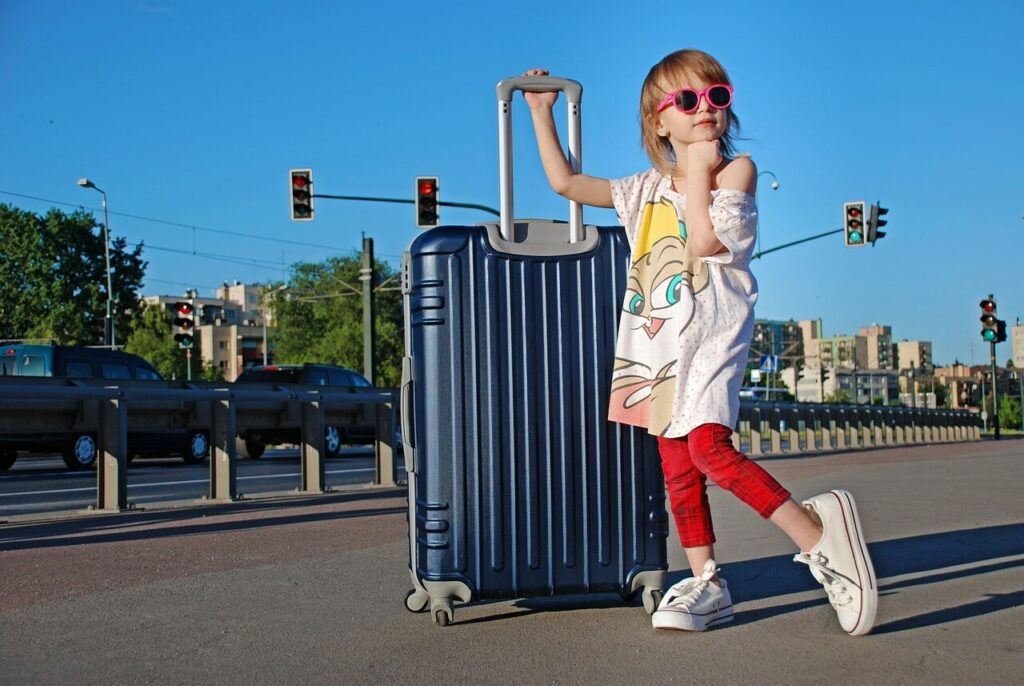
What to Pack for Japan in Winter: Stay Warm and Comfortable
When traveling to Japan in winter, it’s essential to pack wisely to stay warm and comfortable. Start with a good thermal base layer, as temperatures can drop significantly, especially in northern regions like Hokkaido. A warm, waterproof jacket is also a must, along with insulated gloves and a scarf for added protection against the cold. Don’t forget to pack thermal socks and comfortable boots for long walks in snowy or icy conditions. Layering is key, so bring sweaters or fleeces that you can easily adjust depending on indoor or outdoor conditions.
Summer Packing for Japan: Be Prepared for the Heat
When traveling to Japan in the summer, it’s crucial to prepare for high temperatures and humidity. Light, breathable clothing made from natural fabrics like cotton or linen will keep you cool and comfortable. A wide-brimmed hat and sunglasses are essential for sun protection, while a portable fan or cooling towel can help you beat the heat. Don’t forget to pack sunscreen with a high SPF, as well as insect repellent to protect against mosquitoes. Comfortable sandals or lightweight shoes are ideal for walking, and a reusable water bottle will help you stay hydrated throughout the day.
Packing for Japan in Spring and Fall: Versatile Outfits for Changing Weather
Spring and fall in Japan can bring a mix of cool and warm days, so packing versatile outfits is essential. Start with lightweight layers, such as long-sleeve shirts and light sweaters, which can be easily added or removed as temperatures fluctuate. A waterproof jacket is also crucial, as sudden rain showers are common during these seasons. Comfortable walking shoes are a must, along with a scarf or shawl for added warmth during cooler evenings. Packing a mix of casual and slightly dressier items will keep you prepared for both city exploration and visits to cultural sites.
Travel Accessories You Need for Japan
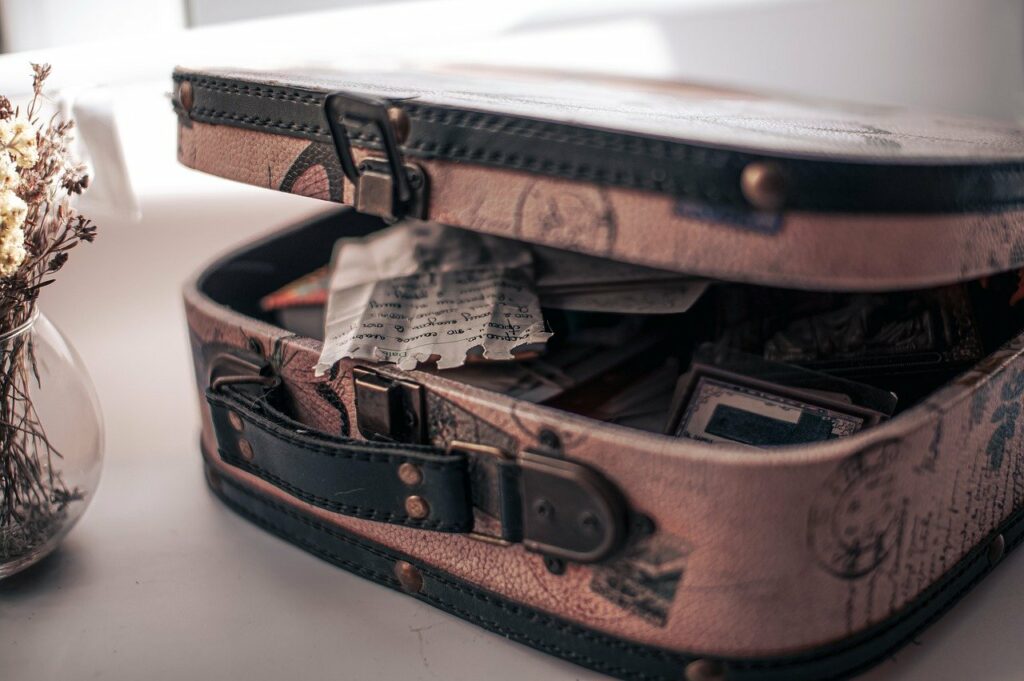
Best Luggage for a Japan Trip: What Works Best
Choosing the right luggage for your Japan trip is crucial for a hassle-free experience. Opt for a lightweight, durable suitcase with spinner wheels for easy maneuverability through Japan’s busy train stations and airports. A carry-on-sized suitcase is ideal for short trips, allowing you to navigate narrow streets and public transportation with ease. For longer stays, consider a medium-sized checked bag that offers ample space without being cumbersome. Ensure your luggage has secure locks, as Japan is known for its safety, but it’s always best to take precautions. A sturdy, compact backpack is also essential for day trips and storing travel essentials.
Travel Gadgets to Enhance Your Japan Experience
To maximize your enjoyment and convenience while traveling in Japan, consider packing some essential travel gadgets. A portable Wi-Fi hotspot is indispensable for staying connected, especially in areas where public Wi-Fi is limited. Noise-canceling headphones can make your long train rides and flights more comfortable by blocking out background noise. A portable charger is a must-have to keep your devices powered throughout the day. Additionally, a universal travel adapter is essential for charging your electronics, as Japan uses Type A and B plugs. These gadgets will enhance your overall travel experience in Japan.
Cultural Considerations: What to Pack to Respect Local Customs
When traveling to Japan, it’s important to pack items that show respect for the local culture. Modest clothing is essential, especially when visiting temples or shrines; pack outfits that cover your shoulders and knees. Slip-on shoes are practical, as you’ll need to remove them frequently when entering homes, traditional inns, and some restaurants. A small gift, known as *omiyage*, is a thoughtful gesture if you plan to stay with someone or visit friends. Additionally, bring a reusable shopping bag, as Japan encourages reducing plastic waste. These considerations will help you blend in and show respect for Japan’s customs.
How to Pack Efficiently for Japan
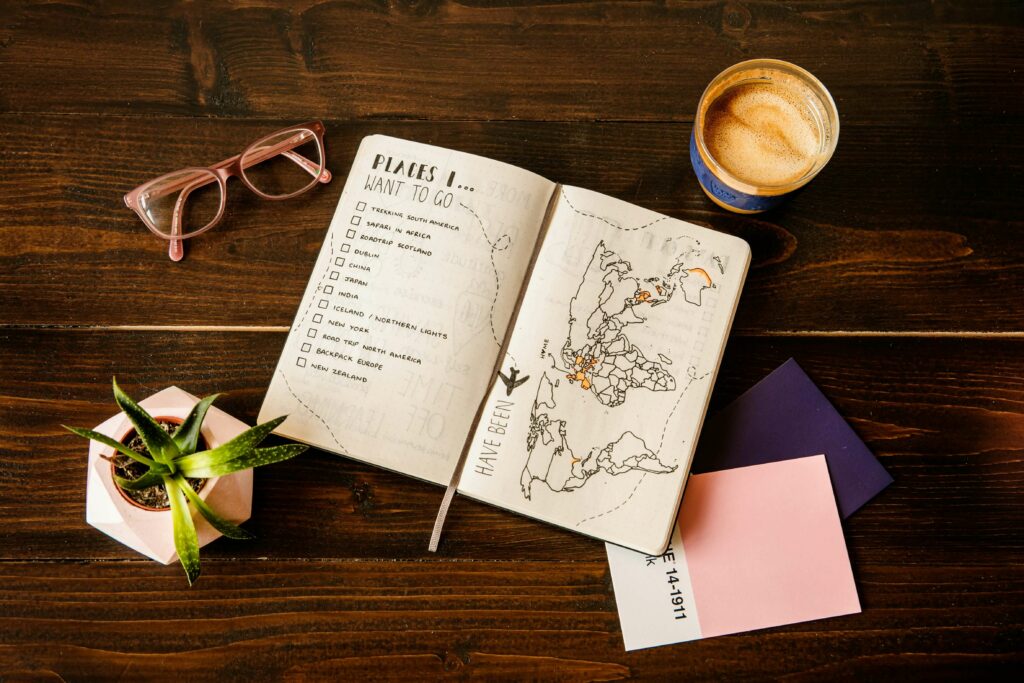
Space-Saving Packing Strategies for Japan Travel
When traveling to Japan, efficient packing is key to making the most of your luggage space. Start by rolling your clothes instead of folding them to minimize wrinkles and save space. Utilize packing cubes to organize your items and compress them further. Opt for multipurpose clothing, like a jacket that doubles as a raincoat, to reduce the number of items you need to pack. Consider bringing travel-sized toiletries or purchasing them in Japan to save space. Lastly, wear your bulkiest items, such as a jacket or boots, during travel to free up room in your luggage.
Must-Pack Travel Outfits for Japan: Stylish and Practical
When traveling to Japan, packing outfits that are both stylish and practical is essential. Choose versatile pieces that can be mixed and matched, such as neutral-colored tops and bottoms that work well together. Lightweight layers are key, allowing you to adapt to Japan’s varied climates, from cooler mornings to warmer afternoons. Comfortable shoes are a must for walking through cities and exploring cultural sites. Consider bringing a few smart-casual items for dining out or visiting temples, where modesty is appreciated. Finally, pack a compact, weather-resistant jacket to stay prepared for unexpected rain or cooler temperatures.
Packing Hacks for Japan: Maximize Your Luggage Space
Maximizing your luggage space is crucial for a stress-free trip to Japan. Start by using vacuum-sealed bags to compress bulky items like jackets and sweaters, making more room for other essentials. Opt for multi-use items, such as a scarf that doubles as a blanket or a dress that can be dressed up or down. Rolling your clothes instead of folding them can save significant space and reduce wrinkles. Consider packing travel-sized toiletries or purchasing them upon arrival. Finally, make use of the empty spaces within your shoes for small items like socks or chargers, ensuring every inch of your luggage is utilized efficiently.
Final Checklist: Double-Check Before You Leave
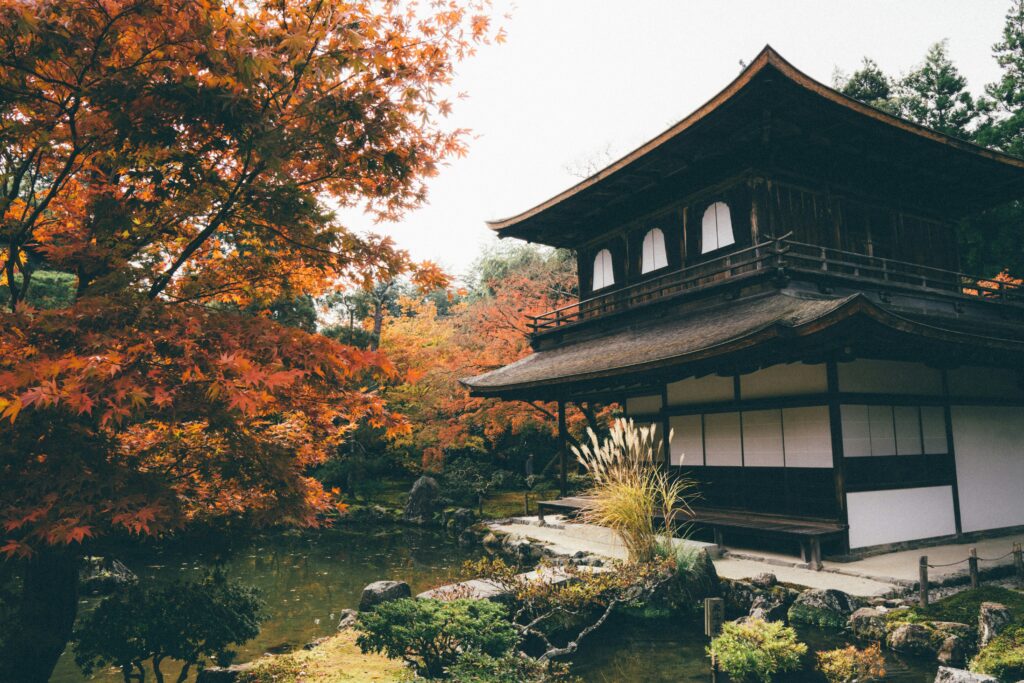
Japan Travel Preparation: Last-Minute Packing Tips
As your Japan trip approaches, there are a few last-minute packing tips to ensure you’re fully prepared. Double-check that you have all essential documents, including your passport, visa, and travel insurance. Ensure your electronics are charged and pack a portable charger for convenience. Revisit your packing list to confirm you haven’t forgotten any crucial items like medications or toiletries. Pack a small, easily accessible bag for your travel day essentials, such as snacks, a water bottle, and entertainment. Lastly, check the weather forecast to make any necessary adjustments to your clothing choices, ensuring you’re ready for any unexpected conditions.
How to Ensure You Have Everything for Your Japan Trip
Before heading out on your Japan trip, it’s crucial to make sure you have everything you need. Start by reviewing your packing list, checking off items as you place them in your luggage. Ensure that all essential documents, such as your passport, visa, and travel insurance, are easily accessible. Double-check that you’ve packed the appropriate clothing for Japan’s climate during your visit, including any necessary layers or rain gear. Make sure your electronics, including chargers and adapters, are packed and ready. Finally, confirm that you have packed any medications or specific items that might be difficult to find in Japan, ensuring you’re fully prepared for a smooth and stress-free trip.
The Ultimate Travel Checklist for a Stress-Free Japan Vacation
To ensure a stress-free Japan vacation, follow this ultimate travel checklist. Start by confirming all your travel documents, including passport, visa, and itinerary, are in order. Pack your essentials first—clothing appropriate for Japan’s climate, comfortable shoes, and necessary toiletries. Don’t forget travel-sized toiletries, a portable charger, and a universal adapter for your electronics. Make sure your luggage meets airline size and weight restrictions. Pack a day bag with important items like medications, a water bottle, and any necessary travel guides or maps. Finally, ensure you have a small first-aid kit and some local currency for immediate expenses upon arrival.

30s male writer. He has worked in a hotel for 16 years and is involved in the travel industry. Through his work at travel agencies and hotels, he developed an interest in travel and often goes on trips. His favorite cities are Sendai and Hakata. He conveys the knowledge he has gained through his travels and the charms of Japan with care.
Central Building 2nd Floor 1-1-5 Kyobashi, Chuo-ku, Tokyo 104-0031, Japan
- Destinations
Major change for tourists visiting Japan
Japan has revealed it will introduce a new travel requirement for anyone - including Aussies - who plan to visit the popular country.

China’s big move as Qantas pulls out
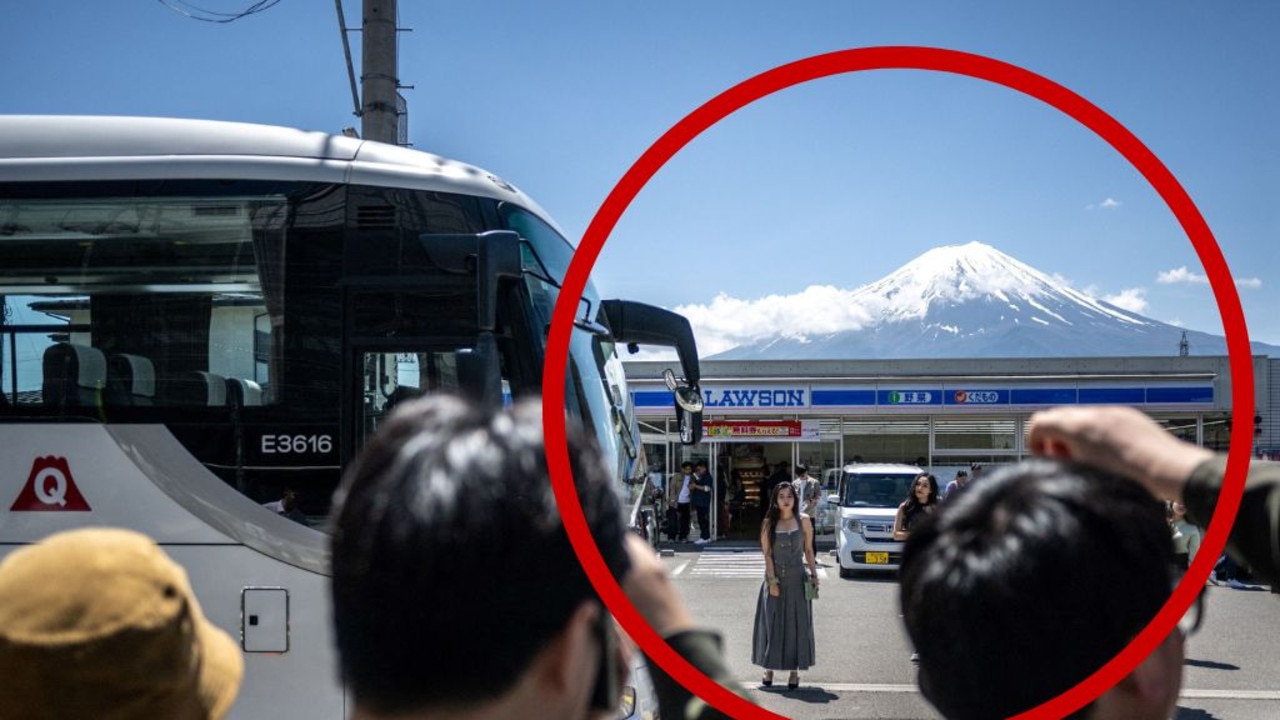
‘No more’: Simple act deters tourists

‘Incredible’: Another Simpsons prediction
Japan is set to launch a new system that requires international travellers, including Aussies, to fill out an online form, similar to the ESTA visa before entry to the United States.
The Japanese government is set to introduce the new travel requirement, tentatively named JESTA, in 2030.
It will operate similarly to the US’ Electronic System for Travel Authorisation (ESTA), which aims to reduce the number of illegal immigrants who come to Japan from visa-exempt countries and regions.
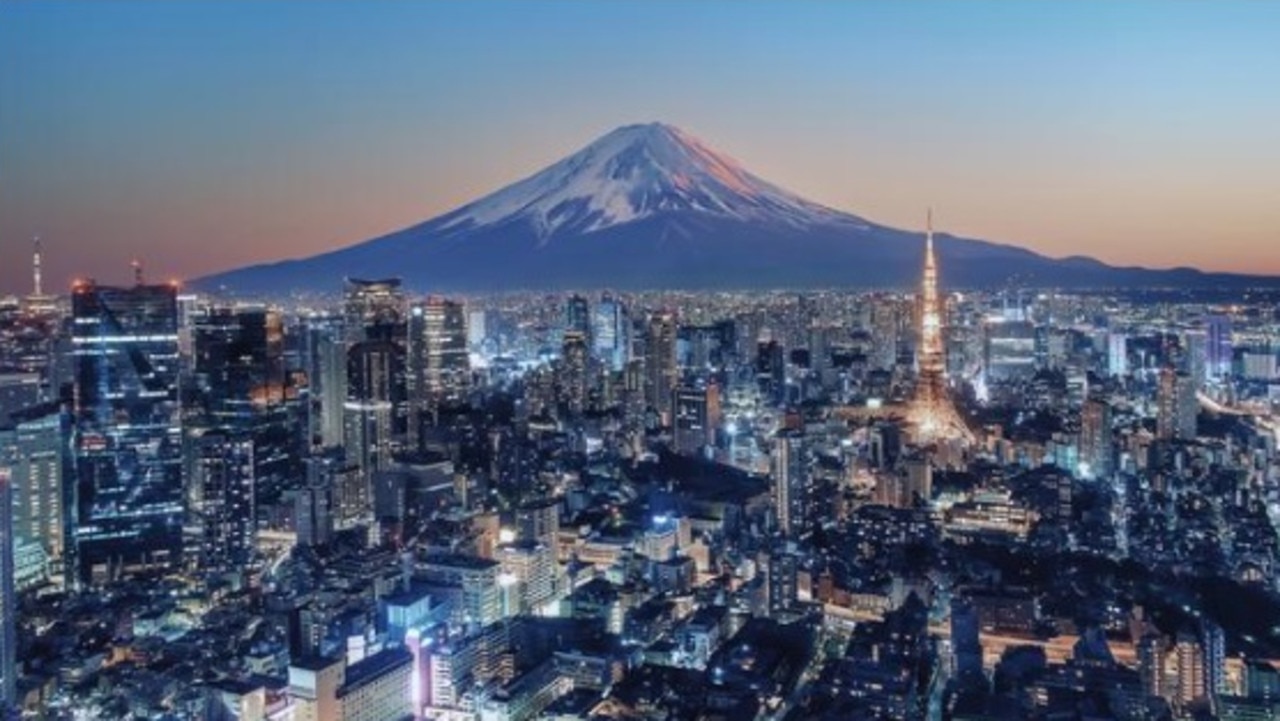
Australia and New Zealand are among the 71 visa-exempt countries that will need to declare their personal details using JESTA — once it is launched.
While ESTA was originally introduced to combat possible security threats to the US, Japan’s new process aims to curb the number of visitors from visa-exempt nations who stay longer than they are permitted, which ranges from 14-90 days, the Sankei Shinbun reported.
The Japanese government says tourists will need to declare their purpose of entry and place of stay before travelling. If they are then flagged as a risk, they may be denied entry and required to obtain a formal visa.
The cost of the JESTA is yet to be disclosed.

New data released by Japan National Tourism Organisation (JNTO) shows the number of Aussies visiting Japan between January to March this year increased by 46.3 per cent compared to the same period in 2019, with visitors in March alone up a staggering 87.4 per cent compared to March 2019.
A key reason has been the historic low Japanese yen.
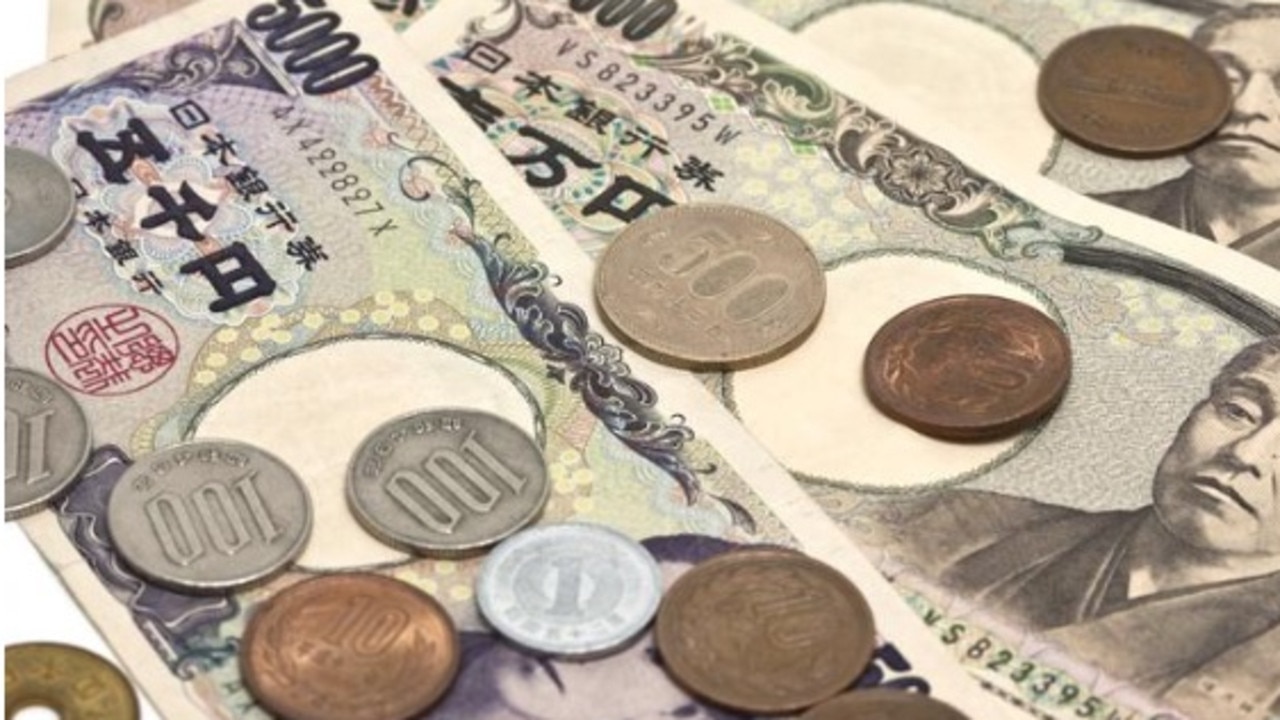
“The AUD is purchasing much more JPY now compared to the lows we saw in the years leading up to the pandemic pause, and this favourable exchange rate makes Japan more affordable and accessible for Australian travellers,” JNTO Sydney Office executive director Naoki Kitazawa said ion April.
According to Flight Centre, travel bookings for March were up 56 per cent on last year, February bookings were up 54 per cent and January bookings were up 65 per cent.
More Coverage

The company’s global managing director Andrew Stark described it as a “seasonal boom” as more Aussies head to the country amid a drop in airfares.
“The interest follows considerable reductions in airfares to many international destinations, with tickets from Australia to Japan sold through Flight Centre in February and March up to 21 per cent cheaper this year than last,” he said.
JNTO expects the positive trend to continue in 2024, with more Aussies looking to travel outside of the peak seasons and seeking lesser-known destinations across the country.
Chinese airlines are making a big move in Australia as part of a “long term game” after Qantas scrapped a specific route amid low demand.
A Japanese town’s move to deter tourists made international headlines earlier this year, but less than three months later it’s gone.
A futuristic city in Bali has to be seen to be believed, and could be straight out of a Simpsons episode.

IMAGES
VIDEO
COMMENTS
Japan is a cash society and not every restaurant, bus, or subway station will take credit card. One of our most essential Japan travel tips is to always have Japanese Yen on you when you are out and about. Some places where a credit card is typically accepted are convenience stores like 7-11, Lawsons, and Family Mart.
5. Learn how to use a bidet toilet. Called "washlets," Japan's high-tech, electronic bidet toilets will wash and dry your delicate parts with the touch of a button. (Don't worry about any language barrier; the pictograms on the buttons are easy to understand). Other toilet customs in Japan might throw you for a loop.
22. It's difficult to be gluten-free in Japan. While the abundance of rice may make you think Japan would be an easy country for gluten-free travelers, that's simply not the case. Soy sauce and other wheat-based seasonings are an integral part of Japanese cuisine, making it hard to avoid gluten.
This guide for planning a trip to Japan will cover: How to prepare for a trip to Japan in 2024. 20+ crucial Japan travel tips to know before you go. Hire a pocket wifi or buy a 4G SIM card for your phone when visiting Japan. Don't blindly buy a JR Pass thinking all tourists need it. Take time to read these Japan travel guide books.
More Japan Tips; 2024 Update: No Japan Travel Restrictions . Japan reopened to independent international tourists on 11 October 2022. Remaining restrictions were dropped on 29 April 2023, so visitors no longer need to show proof of vaccination or a negative Covid test. The government also dropped the indoor masking recommendation.
11. Bring cash. 12.Make use of Konbinis. 13. Prepare to come back. It's also a very traditional place with a strict etiquette; if you're visiting for the first time, follow our tips to make sure you don't get caught out, with more insights in our round-up of fascinating facts about Japan.
Japan Travel Tips: Eating and drinking . Japan really is a foodie's paradise. From Michelin-standard delights to authentic local cuisine, it more than deserves its reputation as a top culinary mecca. Here are some tips to ensure you make the most of Japan's edible delights during your trip: 34. Try All the Food!
Japan travel planning tip: This article breaks down the exact cost of a trip to Japan. Based on our own experiences traveling in Japan, we share the costs associated with each portion of our Japan trip — from transportation to food to accommodation to entertainment. ... We have an article with our top Japan travel tips and advice. This ...
One of the first things to consider when heading to Japan is where you'll be flying into. Many first timers opt to head to Tokyo, which is served by two international airports - Haneda (HND) and Narita (NRT). Something that visitors aren't often aware of is the difference in distance between them. Haneda is located under 20 kilometers from ...
Learn a little more about Japan's customs, culture and Wi-Fi connectivity, as well as its seasonal weather, geography and luggage delivery options. Many of the questions first-time travelers might have are answered here, along with insider tips and practical advice to help you navigate the country with confidence.
We'll help you save some money along the way, too. 1. Safety in Japan is high. One of the best things about Japan is that it is safe. Repeatedly shining on the top ten lists of the world's safest countries, Japan is also a great place for solo female travelers. That doesn't mean you can throw caution to the wind.
Japan Travel Guide. Last Updated: August 8, 2024. Japan is one of the most amazing, beautiful, interesting, and friendly countries in the world. From bustling Tokyo and Zen-like Kyoto all the way to laid-back Okinawa and wintery Hokkaido, Japan rocks. It boasts mouthwatering food, majestic temples and shrines, serene gardens, lush national ...
How to move around efficiently. And many other practicalities of the modern traveler to Nippon. These are 34 Japan travel tips to help you make the best out of your stay! Use 7-Bank. Public transportation is super efficient. A JR Pass can be a great buy. Pick the best areas to stay in cities strategically.
Japan Itinerary: One Week. Day 1 & 2: Tokyo. Chances are you'll be starting your trip in Tokyo, since it's home to the country's biggest international airport. If your trip is seven days long, activate your JR Pass right away, so that you can take advantage of the free JR trains that run through the city.
What To Expect. Language: The national language of Japan is Japanese. English is widely spoken, especially in the tourism industry. Currency: The official currency is the Japanese Yen (JPY). Credit Cards & ATMs: In big cities like Tokyo and Osaka, you can pay for pretty much everything with your card.However, you'll need cash for entrance fees, local markets and if you're planning to ...
Japan Travel Tips: If lack of trash cans are a concern, bring a small bag, like this, with you for any immediate trash. #6. Public restrooms are plenty (and free!) Toilets in Japan are incredibly advanced. We're talking heated seats, noise settings for privacy, auto-sensor flushers, bidets and the whole thing.
MORE TRAVEL AROUND JAPAN. We hope you enjoyed these Japan travel tips! For more travel around Japan, see the links below: 3 week Classic Japan Itinerary in Photos: Tokyo, Kyoto, Snow Monkeys & More; Get off the Beaten Path in Hokkaido: Rishiri & Rebun Islands; The Best Food in Japan That You MUST Try!
These Japan travel tips will help you get over any culture shock and be prepared to fully enjoy your Japan vacation. 75+ Japan Travel Tips for 1st Time Visitors from the USA (2024) These Japan travel tips will help you navigate transport, enjoy local cuisine, know what to pack, and understand Japanese cultural norms.
Firstly, it's cheaper if you purchase the JR Pass online with an overseas partner like Klook. Really. It is stated on the official JR Pass website that the price of the Whole Japan 7 Day JR Pass will go for ¥33,610 (~S$337.80) over the counter in Japan. However, you can get it at only ¥29,650 (~$298.60) on Klook.
To give you an idea of how much a bit of research can save you: When I travelled to Japan I purchased a Yamaguchi wide area pass for 13,500 yen. This covered my travel from Hiroshima to Kyoto.From Kyoto I then took a night bus to Tokyo for 6,500 yen. At 20,000 yen this was much cheaper than a 1-week JR pass.
4. Download the Hyperdia app. Cabs are extremely expensive in Japan - the price is hiked up even higher at night from 10 p.m. to 5 a.m. - so it's good to have a firm handle on the public ...
Japan travel tips for first time visitors . Japan can be a culture shock to the senses for first time visitors. There's a lot of things to know before traveling to Japan, so today's blog post shares a few useful Japan travel trips. Japan is easily one of our favourite travel destinations in the world. It's unlike anywhere else.
Handy to Know Japan Travel Tips. These tips about carrying cash and using ATMs are possibly the most important Japan travle tips to take onboard. 21. Carry Cash "Japan is a cash-based society, so make sure you have local currency on you at all times. You'll be surprised by the number of places that won't take your credit card."
Travel Tips and Recommendations Packing Tips. Overall, November is a gorgeous time to visit Japan. The weather isn't too cold yet, and the drop in humidity brings bright blue skies and a crisp climate. However, that isn't to say you won't need warm clothes.
This excellent book recommends exchanging your Japan Rail Pass voucher at the airport when you arrive and immediately hopping on a bullet train for Hiroshima as one of the top tips for travelling ...
READ MORE: What to know about Japan's famous cherry blossom season Japan comes alive in spring. (Shutterstock) Mount Fuji Area, Fuji Shibazakura Festival While Mount Fuji is a year-round attraction, spring elevates its beauty to a whole new level. The snow-capped peak stands majestic against a backdrop of blooming flowers and clear skies.
This guide will walk you through the essential details of Japan's key airports including Narita International Airport, Haneda International Airport, Kansai International Airport, and more. From facilities and transportation options to travel tips and local insights, we've got you covered.
Japan Travel Preparation: Last-Minute Packing Tips. As your Japan trip approaches, there are a few last-minute packing tips to ensure you're fully prepared. Double-check that you have all essential documents, including your passport, visa, and travel insurance. Ensure your electronics are charged and pack a portable charger for convenience.
Japan will join a growing global push towards mandatory travel authorisations for foreign visitors, with the rollout of a digital visa-waiver program similar to the USA's ESTA (Electronic System for Travel Authorisation) and the forthcoming European and UK equivalents. Tentatively named JESTA, the program will apply to over 70 countries which currently enjoy hassle-free entry to Japan ...
Japan is set to launch a new system that requires international travellers, including Aussies, to fill out an online form, similar to the ESTA visa before entry to the United States.